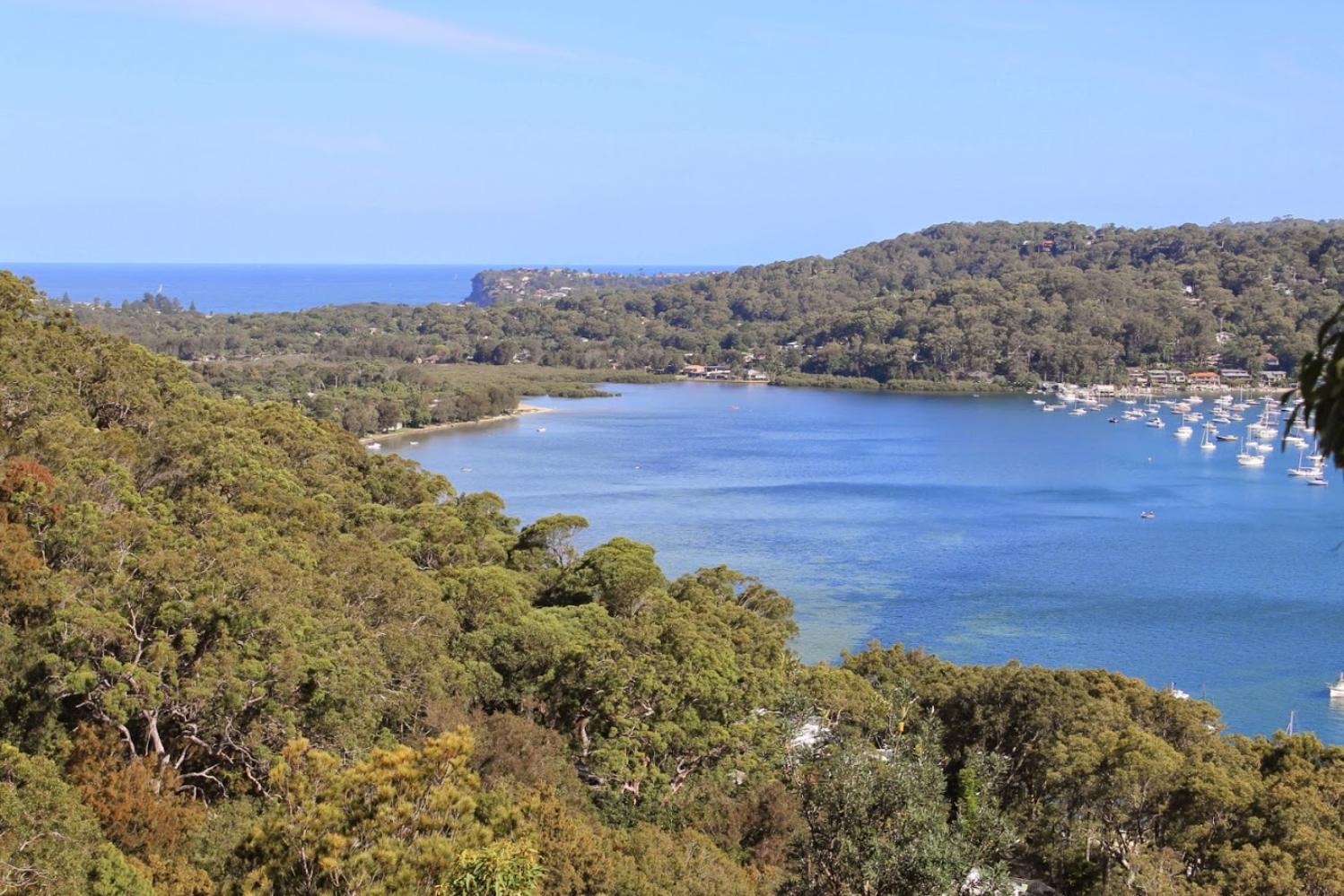Pittwater Roads II: Where The Streets Have Your Name - Careel Bay

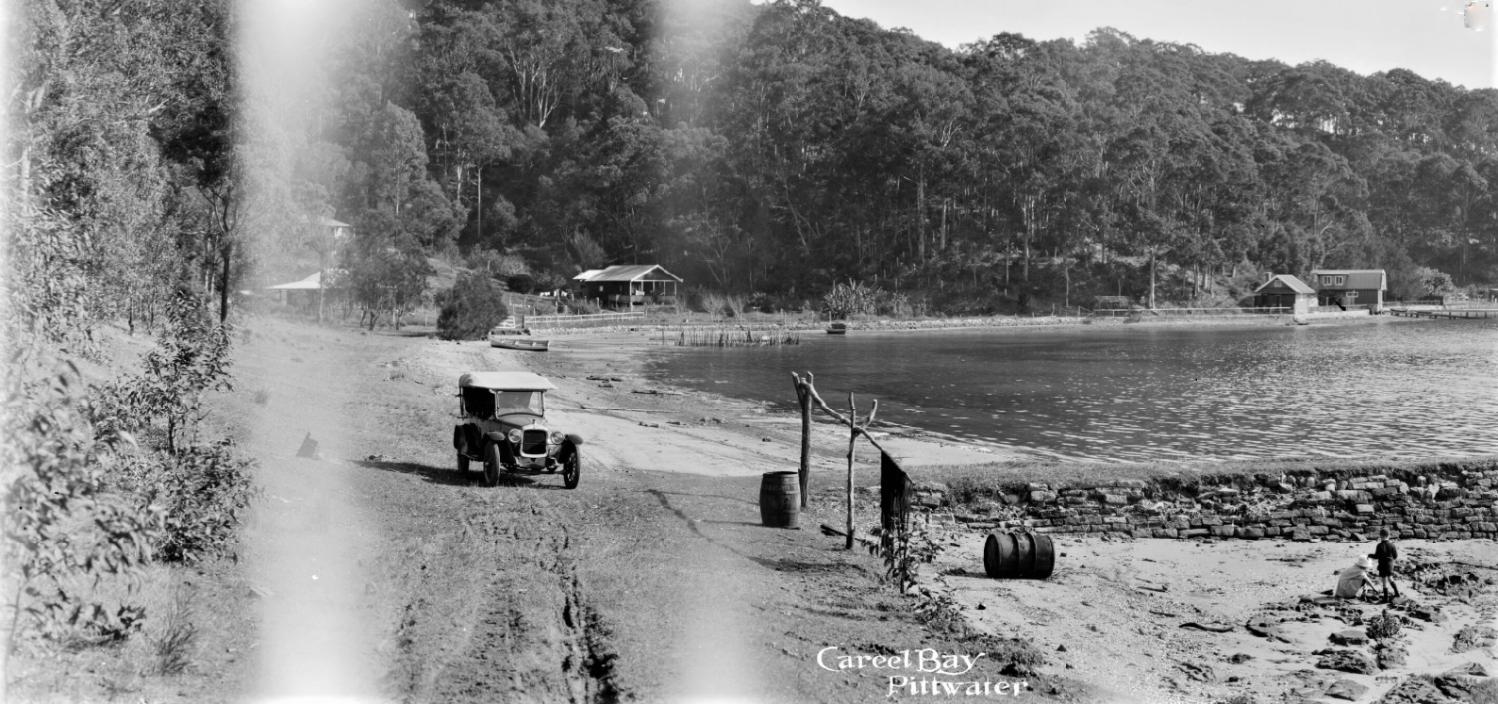
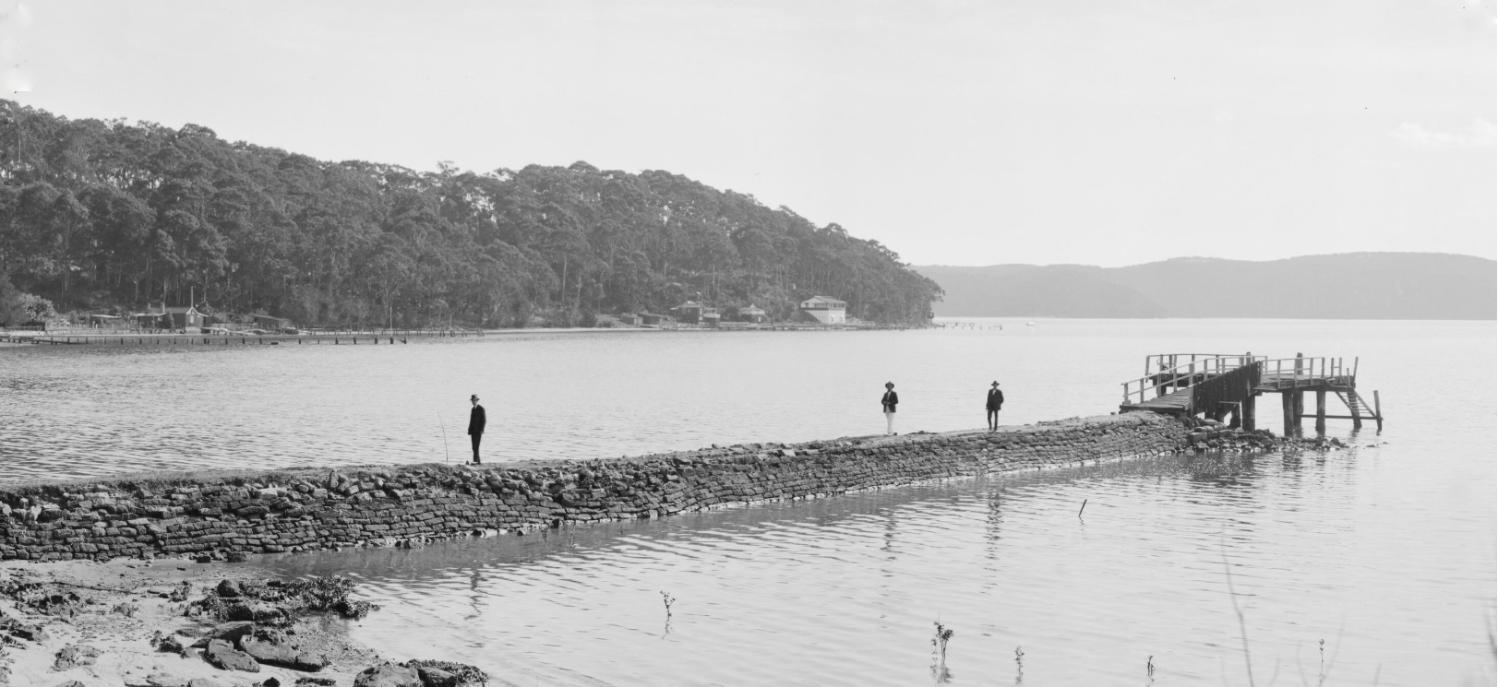
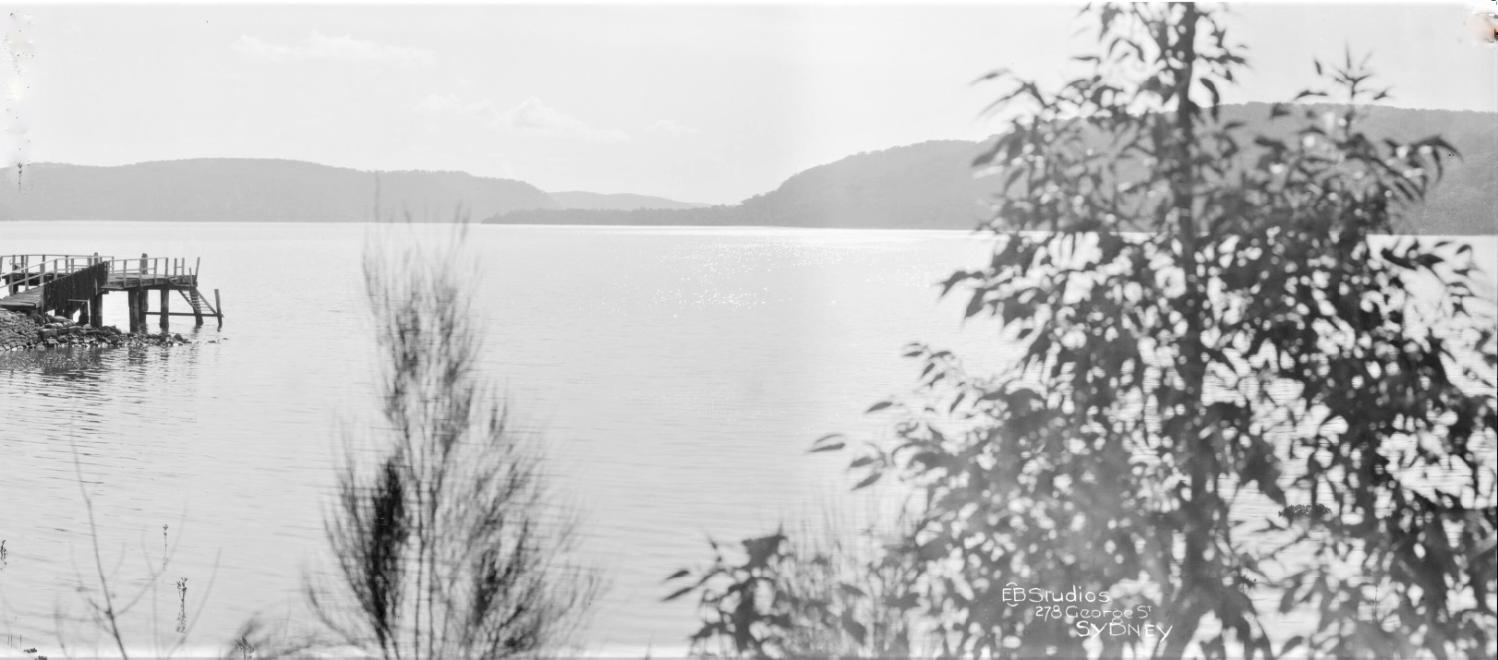
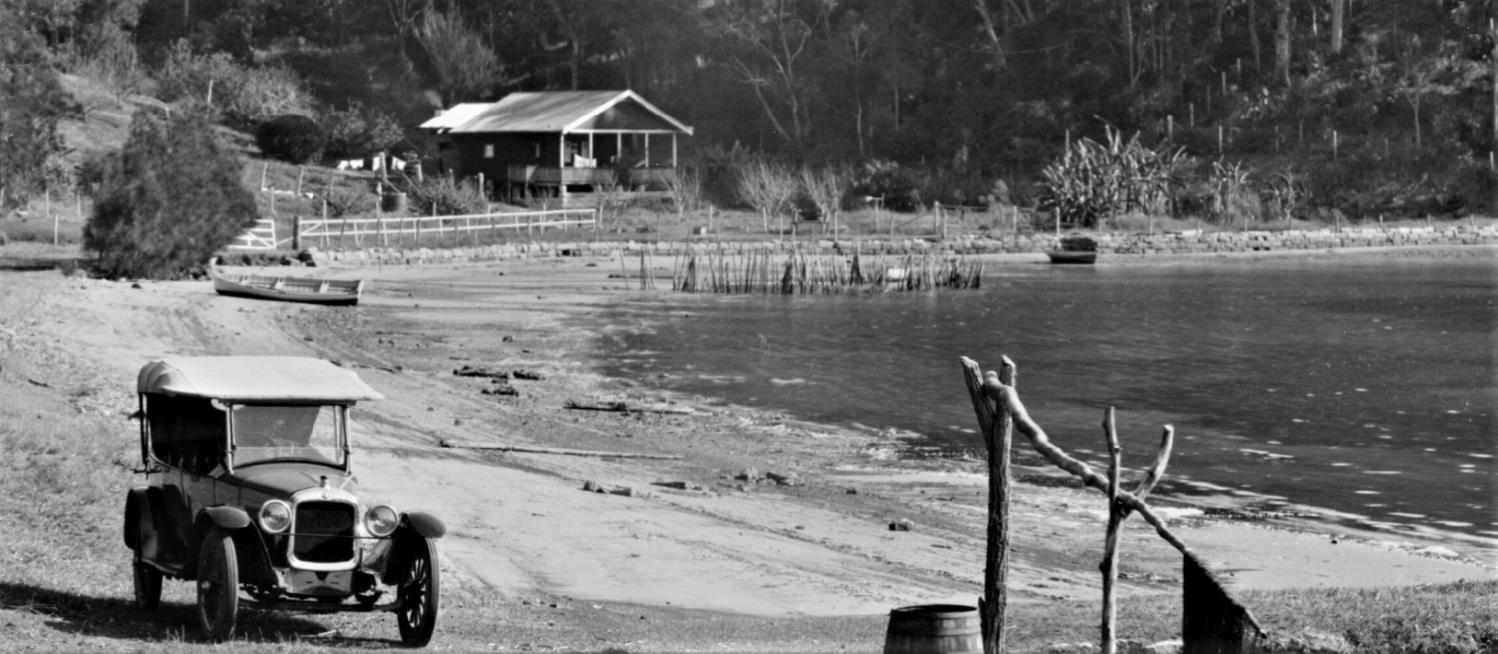
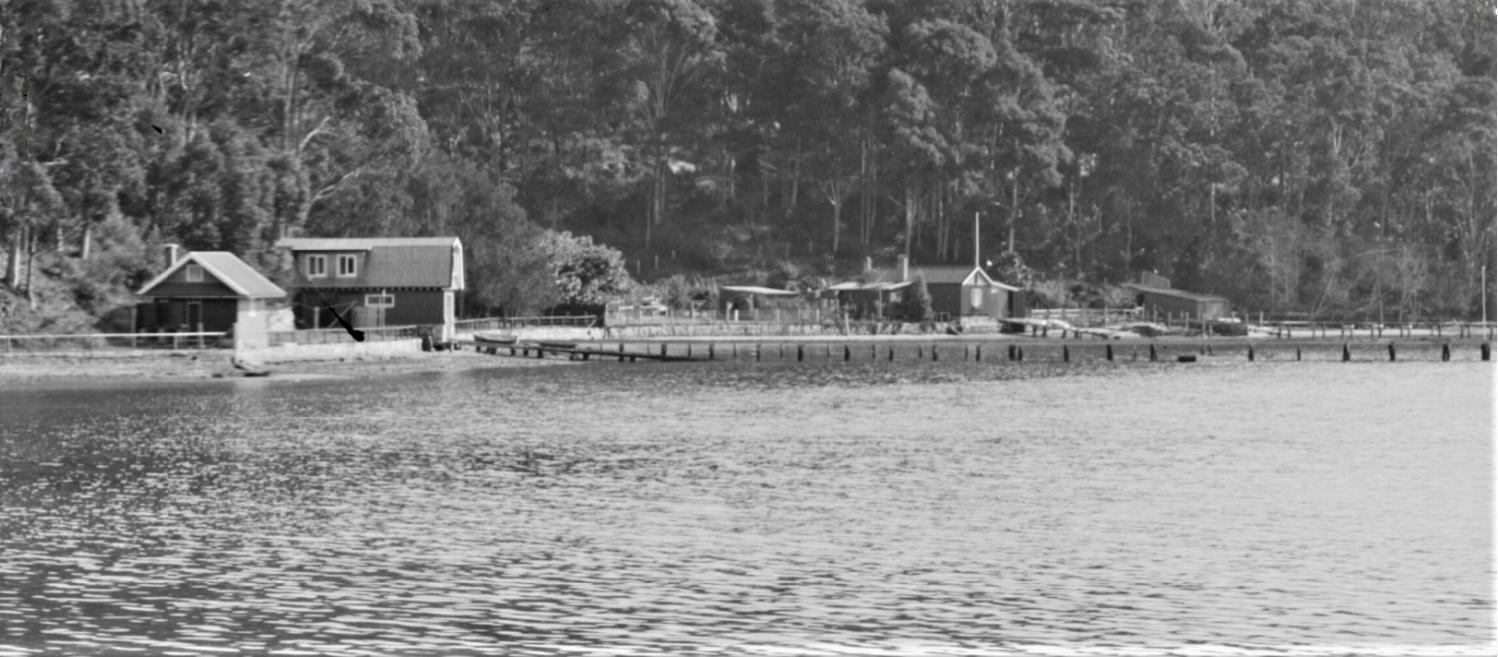
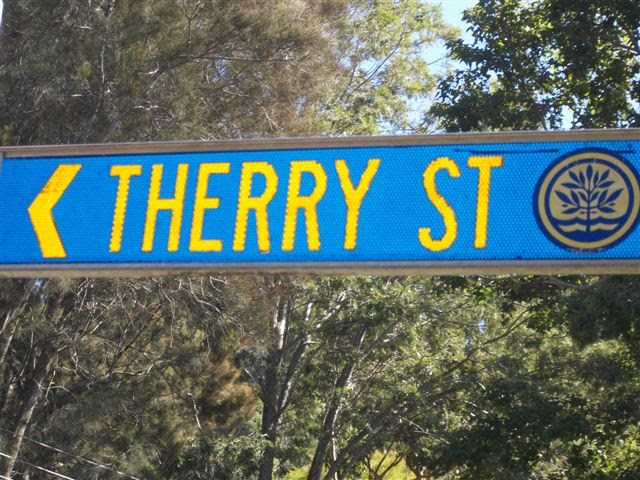 Born in Cork and educated at St Patrick’s, Carlow, Therry was ordained in 1815 and did parochial work in Dublin and Cork before sailing to Sydney in May of 1820 aboard the Janus, a transportation ship carrying over 100 Irish men and women convicts. He had seen these fellow Hibernians being dragged to the docks in chains for transportation, and hearing they had no priest, applied for and was accepted as a missionary. The voyage took four months. Prior to his arrival in Australia Catholic convicts and freemen’ were to attend the Anglican services or be deprived of meat or flogged, 20 lashes increased to 25 lashes for a second refusal to attend what they considered ‘heretic’ services. The Catholic priests who were here had been transported for their involvement in the Irish Rebellion and were not allowed to conduct services as they too were convicts. Many of those transported had been associated with the Rebellion so attending Anglican services, those conducted by the ruling elite, was anathema to them.
Born in Cork and educated at St Patrick’s, Carlow, Therry was ordained in 1815 and did parochial work in Dublin and Cork before sailing to Sydney in May of 1820 aboard the Janus, a transportation ship carrying over 100 Irish men and women convicts. He had seen these fellow Hibernians being dragged to the docks in chains for transportation, and hearing they had no priest, applied for and was accepted as a missionary. The voyage took four months. Prior to his arrival in Australia Catholic convicts and freemen’ were to attend the Anglican services or be deprived of meat or flogged, 20 lashes increased to 25 lashes for a second refusal to attend what they considered ‘heretic’ services. The Catholic priests who were here had been transported for their involvement in the Irish Rebellion and were not allowed to conduct services as they too were convicts. Many of those transported had been associated with the Rebellion so attending Anglican services, those conducted by the ruling elite, was anathema to them.
From the outset Father Therry endeavoured to better the lot of his congregation and frequently incurred the ire of those who feared another uprising from those they governed in the fledgling colony. One third of those living here then were Irish Catholics. He may have spoke his mind, saying out loud what many were thinking but afraid to voice, and a sharp wit may have pricked some egos, but he professes a wish not to offend and a sense of surety of his work and his authority to perform it;
“Lest any zeal which I may occasionally manifest for the preservation in this Colony of the holy religion of which I am but a very humble minister should excite in your mind a suspicion that I dislike persons of the other persuasions, I now distinctly declare that it is my desire, as far as it is possible, that is, as far as it is consistent with paramount duties, to be in peace with all and to give offence to none ; that I dislike no man on account of his Religion; that I respect a moral man whatever religion he may belong to” (Letter. July, 1826.)
His association with Pittwater came through a land Grant in 1833. Some sources state he was given 1200 acres, others cite 1400. Either way this area ran from Newport to Careel Bay and encompassed most of Avalon. Published in the Government Gazette lists:
113. Thomas Warner, 50, Fifty Acres, Parish of Narrabeen, commencing at the Northeast corner, and bounded on the East by a side Hue of twenty-five chains; on the South by a West line of twenty-five chains to Pitt Water; and on the West and North by the waters of Pitt Water to the commencing corner.
Promised by Governor Macquarie on 31st March, 1821. Quit-rent 1s. sterling per annum, commencing 1st January, 1827.
114. Henry Gaskin, 50, Fifty Acres, Parish of Narrabeen, commencing at the North-east corner of Warner's fifty acres, and bounded on the West by a South line of twenty-nine chains; on the South by an East line of twenty chains ; on the East by a North line of twenty four chains to Pitt Water ; and on the North by the waters of Pitt Water to the commencing corner. Promised by Governor Macquarie on 31st March, 1821. Quit-rent Is. sterling per annum, commencing 1st January, 1827.
115. John Joseph Therry, 1200, One thousand two hundred Acres, Parish of Narrabeen, commencing at the South-east comer of the Government Reserve of two hundred and eighty acres, and bounded on the North by that Reserve by a line West twenty-five chains to a Stream ; on the North by that Stream and Careel Bay to the North-east Gorner of Henry Gaskin's fifty acres; on the West by Gaskin's by a line South twenty-four chains ; on the South by a line West twenty chains, and again by a line North four chains to the South-east corner of. Warner's fifty acres; on the North by Warner by a line West twenty-five chains to Pitt Water; on the West by the waters of Pitt Water to the North-west coiner of John William's sixty acres ; on the South by that farm by a line South fifty degrees East 38 chains ; on the West by a line South forty decrees West sixteen chains ; on the North by a line North fifty degrees West thirty-nine chains to the North corner of John Taylor's thirty acres ; on the West by Taylor by a line South twenty three chains to Pitt Water ; on the West by the waters of Pitt Water to the North-west corner of James M'Donald's thirty acres ; on the South by that farm by a line East eleven chains ; on the West by a line South twenty-three chains to Robert Melvyn's sixty acres; on the South by part of Melvyn's farm, and by Porter's and Anderson's farms by a line East fifty chains to Martin Burke's fifty acres; on the East by that farm by a line North six chains to a Stream ; on the East by that Stream, which is the Western boundary of John Farrell's sixty acres; on the South by that farm by a line East twenty-eight chains to the Village Reserve of one hundred acres ; on the East by part of the Village Reserve by a line North seven chains to a Stream ; on the South by that Stream, which is the North boundary of the Village Reserve to the Sea; and on the East by
the Sea to the commencing comer. Promised by Sir Thomas Brisbane, 200 acres,on 23d July, 1824 ; 500 acres on 1st September,1824; and 500 acres on the 19th December,1825. Quit-rent £9 8s. 4d. sterling per annum, commencing 1st January, 1829. Classified Advertising. (1832, November 1). The Sydney Gazette and New South Wales Advertiser (NSW : 1803 - 1842), p. 1. Retrieved from http://nla.gov.au/nla.news-article2209217
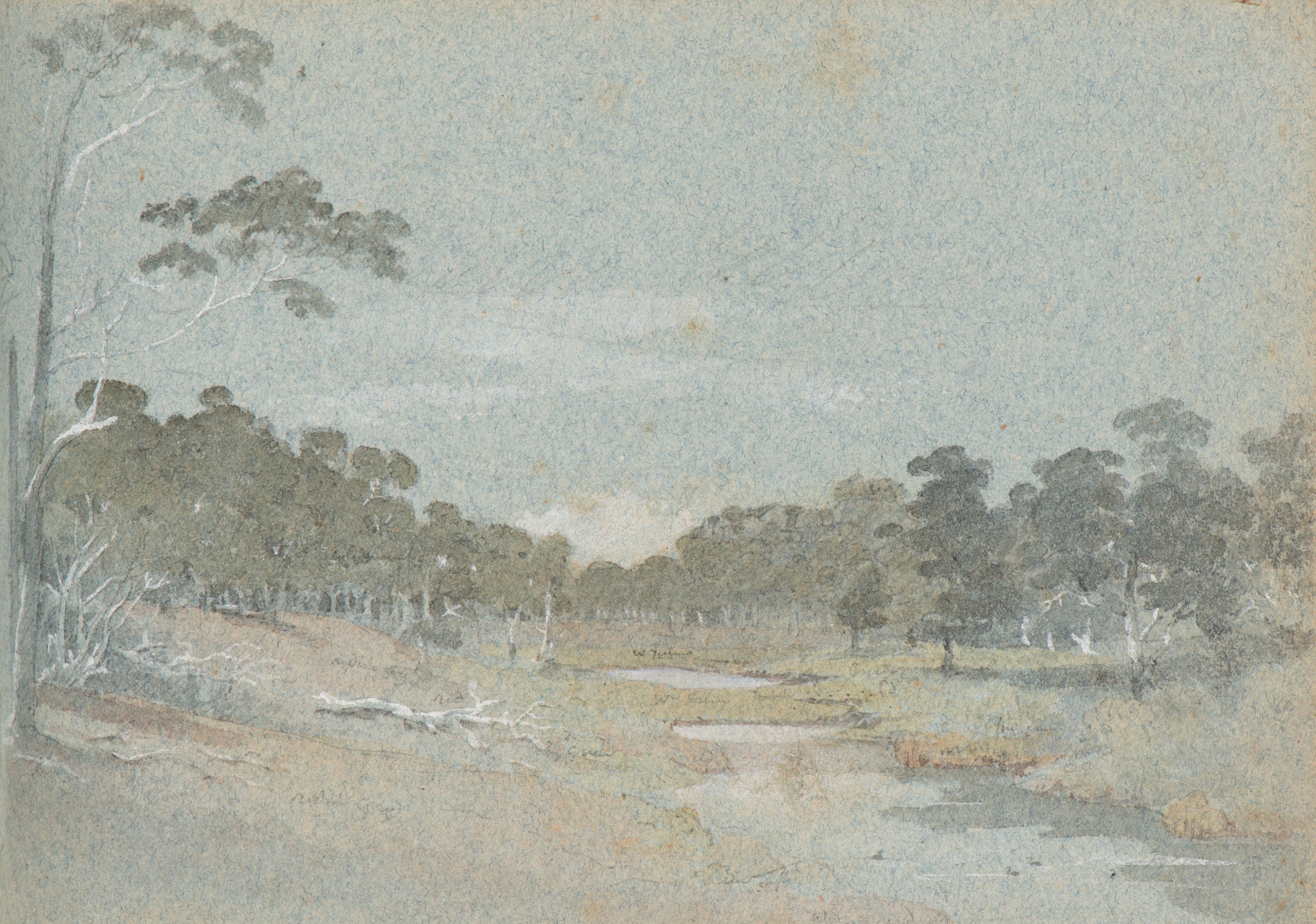
Sir Thomas Mitchell sketchbook - Careel Bay 1828 (flat area leading north towards; where present day Careel Creek is) - Item c03082_0024_m, courtesy State Library of NSW
Charles de Boos in his 1861 published series 'My Holiday' described the landscape leading from Bilgola to Careel Bay as;
'Once through this jungle of a gully, and we had a gently rising road, creeping steadily up the face of the range, by easy graduation until at last it had gained the crest. Then we had a monotonous walk along the top of the ridge, in full view of the vast Pacific to our right, whose waves were now beating almost lazily along the beach at our feet and whose waters had barely swell enough on them to keel over the tiny fleet of coasters that had put out from different ports of shelter on the coast with the first slant of the favouring wind, and were now lying almost motionless, with scarce wind enough to lift their sails. To the left, the hills, covered with the low close scrub common to our coast ranges, bounded our view, the inland ridges, with their heavily timbered sides being hidden from our sight.Suddenly, however, the road took a curve round to the left, crossed a knoll of the range, and then swept down, in some fifty different tracks, on to a broad swampy plain, or flat, which seemed to us to be inundated, for we could see the water sparkling and glistening in the sun over its whole face. I pulled up short here.
" It won't do to go down there, Tom," said I.
"Oh, but we must," he replied. "This is the Priest's Flat, and there, where you see those shears erected, with the two tents alongside of them, is where they are boring for coal. We must go and report progress."
I looked ruefully at Nat, who made no reply, but, grinning viciously, bent down and turned up his trousers to the knees.
“Do you think there are any leeches there ?” I asked. Nat's trousers were instantly turned down again, and this time he didn't grin,
"Oh, no," Tom answered, "there's too much water there for them, and not enough shelter.
I was easier in my mind, though I had my misgivings; but as these Antipodean leeches seemed to be ruled by laws, and to have amongst themselves habits and customs totally at variance with those of leeches in civilised communities, possibly Tom might be correct; so, tucking up my trousers, I prepared to descend. And, after all, when we got down to the flat it was not so bad as it had appeared to us from the hill. The ground was somewhat honeycombed and the water lay in pools, between which however, we managed to find sufficient footing without actually walking in water.
Arrived at the tents, warning of our approach was given by a solitary dejected bark, ending in a melancholy and prolonged howl, from some unseen dog, that was evidently too broken down and low-spirited to repeat the challenge and it was only after we had approached the shears, and had commenced our examination of the boring, which, to tell truth, none of us could make head or tail of, that a tall sailor looking man, who appeared as if he had but just that instant been uncoiled full-rigged from between the blankets, came out to the entrance of one of the tents, and regarded us with an air of blank and sleepy astonishment. Just after him followed his watchful canine guardian, whose short bark and long ululation had effected his master's awakening, but so far behind as not to be within kicking distance; his cowering watchful look, and his tail hard down between his legs, evidently saying as plain as could be said, " I don't know whether I have done right, so I must stand by for squalls."
It took a good deal to waken up our friend to a full sense of the information we required from him, and it was only by the casual mention of Farrell's name that he was brought to his full mental perceptions. A grin spread over his countenance when we said where we had just come from.
“Did you go candling with him ?" he asked. We explained how it was that we had not done so.'
“Oh, isn't it prime fun !" He was fast getting lively.
He had been of the party the night before our arrival, had got wet through, had disported himself like a grampus in the pool, and had got home with an exulted notion of the sport. Of course we did not undeceive him; but having now got him up to the proper communicative pitch, we proceeded to worm out of him, by dint of much questioning, and much labour in bringing him back to the subject in hand for he would insist upon darting off from it at a tangent to give us collateral evidence upon matters in which we had not the slightest interest-all that he knew of the boring.
From the information thus acquired, as well as from enquiries subsequently made, I learnt that the spot now being bored was about the centre of a very fine property of some 1200 acres in area, granted many years ago to the Rev. Father Therry, and extending across the Barranjuee peninsula from the shores of the Atlantic to those of Creel Bay; the one being its eastern, the other its western boundary. Hence the plain had been christened the Priest's Flat. It had been for some time surmised, taking into account the dip of the coal basin, which crops up to the north at Newcastle, and to the south at Wollongong, that at this spot, which lies so near the northern cropping point, the coal seam might be struck at such a medium depth as would allow of payable working. Somewhere about twelve months ago, the reverend proprietor determined upon trying the experiment, and he has continued perseveringly at the work in spite of every discouragement that has beset him; and certainly he has had in this matter to bear up against contrarieties sufficient to have wearied out the majority of ordinary persons.
At no time have the men employed ever injured themselves by hard work, for the testimony of the natives goes to show that they hung it on most amazingly, and when obliged to do something for their money, rather than sink deeper they would break the auger. On another, occasion, an overseer that was employed bolted with the month's pay of the men, and, not satisfied with that, took also the reverend father's horse, though this was subsequently recovered, but only after paying a pretty Bullish sum for stabling expenses. Just as we visited the spot the 'works were again at a stand-still by the breakage of the apparatus, and the newly-appointed overseer was away in Sydney getting it repaired, whilst the hands were scattered hither and thither. They had at that time got to a depth of 186 feet, but had come upon no indications of coal, if we except the passage of the auger through a 6-inch pipe of coal at a depth of 123 feet. (Since these articles were commenced, I have learnt that the boring has reached a depth of 220 feet), when the work was suddenly brought to a close by the breaking of the auger, and, what was worse, by the cutting portion of it being left firmly embedded in the rock that was then being pierced.
Whilst upon this subject, it may-not be out of place to mention that I visited, though somewhat subsequently to the time now alluded to, the bluff headland almost in an easterly line with the boring, and named by the reverend proprietor St. Michael's Head; and there, at about eight feet above high water mark, and quite open to view, is a thin seam, or, as miners term it, pipe of coal, scarcely an inch in thickness. On examination I found also that very much of the shale, both above and below the seam, bore carboniferous indications-leaves, ferns, &c, being distinctly traceable on the face of the cleavages. Another great discouragement that must have operated very strongly upon the rev. owner has been the expense that the work has entailed on him, in consequence of the bungling inexperience and roguery of the persons who have, until lately, been entrusted with it. On this point I speak only on hearsay, and my information is consequently liable to correction ; but I was told with an air of authority that the cost of sinking had, up to that time, reached very nearly £800, being at the rate of rather more than £4 per foot, whilst the time occupied in sinking had been over nine months, or about twenty feet per month not a foot per diem ! If this was not enough to put an extinguisher upon ordinary enterprise, I can't conceive anything that would be. Under the present management I am informed that the work promises to progress more favourably.
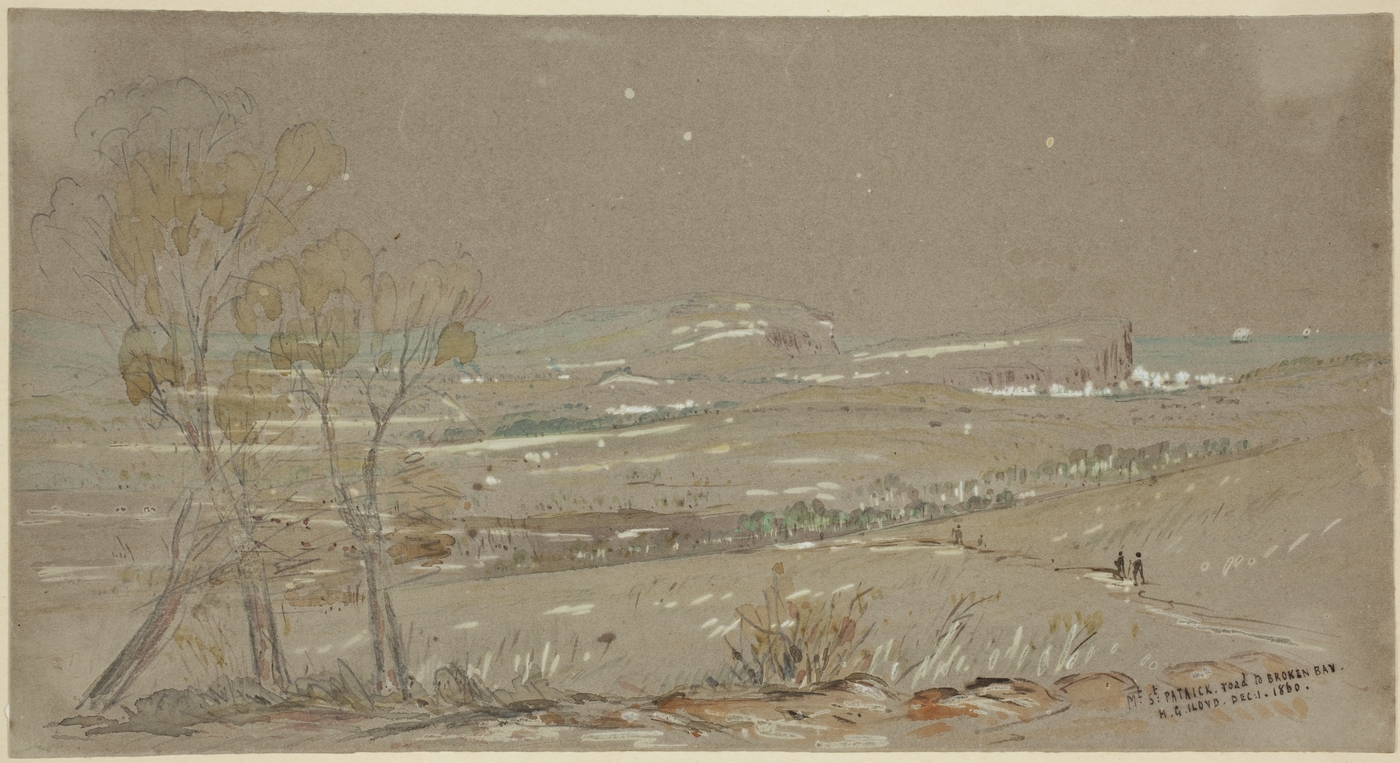
We were not very long in pumping perfectly dry the maritime-looking individual who had charge of the works pro tem ; and, by the way, I would here ask how it is that nearly all the males we have encountered in our tracks have so decidedly nautical an appearance? Can it be that, like the islands in the Pacific have been said to have been, this particular portion of the territory of New South Wales has been peopled by the sole survivors of awful wrecks, by men supposed by anxious friends to have been drowned years ago, and who now turn up mysteriously in this unknown land? or, are the inhabitants of the Peninsula like the Arabs on the African coast, and do they seize and treat as slaves the shipwrecked mariners that are cast amongst them by the Pacific, in its un-pacific moods? or have they fled to these wilds to escape the too fond and anxious enquiries, through the water police, of disappointed shipmasters or deluded agents ? The question is one that perhaps some future Australian physiologist may be tempted to solve.
We parted with our friend with but scant ceremony, he turning on his heel and walking into his tent when we told him, "that was all;" whilst we shouldered our loads and walked ahead. Pushing along the edge of the flat, we crossed the foot of the hill we had not long previously descended, and, passing along an inner one of well-grassed sandbanks, that formed the landmost barrier against any encroachment of the waves, we came after a walk of half a mile to a paddock fence, through a slip panel of which the road evidently ran. Entering the paddock we found the upper part overgrown with young timber, principally wattles, that had sprang up since the cultivation of the toil had been discontinued, whilst about half-way across it we encountered a beautiful stream of running water, bright and clear as crystal, and crossed by a very rustic, and at the same time, very dilapidated-looking bridge. Nat was in the van at the moment, and I was astonished to see him, when he reached the brook, throw down his load and descend the bank to the water. Arrived there, he began hastily selecting some of the darkest leaves of a plant which I now observed grew very thickly on the margin of, and even in the water.
"What's the row ?" said I.
" Watercresses," replied he. "Stunning!"
" I'm there," cried Tom; whilst I made no answer, but slipped my shoulders out of my load, and commenced an attack upon this favourite pungent water plant. We amused ourselves for some five minutes over them, and then, filling our billy with the choicest stems we could find, once more made tracks.
After crossing the creek, we came in sight of a homestead, small but neat, having evidently been only recently whitewashed. The paddock was now clear of all undergrowth, and, as a goodly cluster of large trees, the remnants of the former occupants of the soil, had been left standing round the house, it had an exceedingly pretty and picturesque appearance, its white sides gleaming out markedly from amongst the bright green of the shrubs around it, and the dark and sombre verdure of the forest monarchs that overshadowed it.
"This," said Tom, "is Tom Collins, and he's the man that will show us the cave."
“The cave ?" asked I. "What cave ?".
" You'll see," he answered, "a rum 'un; such a one as you won't find anywhere else within a day's ride of Sydney, I can tell you."
Here was a surprise indeed. I had never, during the whole of my lengthened sojourn in Sydney, heard of this cave, and I don't believe that fifty persons in the metropolis are to this day cognisant of its existence; thus, with a feeling something near akin to that of a first discoverer, I hastened up to Collins domicile.
(To be continued.)
MY HOLIDAY. (1861, August 26). The Sydney Morning Herald (NSW : 1842 - 1954), p. 3. Retrieved from http://nla.gov.au/nla.news-article13059581
MY HOLIDAY
[CONTINUED.]
(From the Sydney Mail, August 31.)
A tap at the door brought out the mistress of the house, accompanied by her brood of little ones, all fat, chubby, and rosy faced, bearing on their countenances the imprimatur of good health. Having mentioned our errand, we were invited to enter, and we found the interior of the domicile even more neat, and white, and bright, than the exterior, for it was the very beau ideal of cleanliness, and care. The tin-ware which hung from the shelves was polished till it shone like silver, whilst the shelves themselves being of deal, were scoured almost to whiteness. The floor, though an earthern one, was swept so clean that it more resembled a single large slab of stone than what it really was; and the fire in the huge bush fireplace was nicely kept in the centre, each side being swept as carefully as the floor itself had been. The hut had been recently whitewashed throughout, and the whole had such a light and cleanly air as strongly to remind me of some of the farmhouses it has been my lot to visit in the mother country, where, perchance, some notable housewife would take such a pride in polishing that even to the iron hoops of the churn, the piggins or the milk coolers would be burnished up till they resembled steel.
Unfortunately our man, Tom Collins, who knew all about the cave, and who was, in fact, its first discoverer, was absent from home; his brother, however, would very willingly guide us to the spot, so said Mrs. Collins, and waiting the arrival of her brother-in-law, she brought forth a huge jug of milk, from which she desired us to help ourselves; and if Tom and Nat didn't do so to a pretty considerable extent, they made a very good attempt at it, that's all. I verily believe that they would have had impudence enough to have asked for another quart, had not the arrival of Collins frer turned their attention to another quarter. He at once expressed his willingness to conduct us, and furnished himself with a piece of candle, the interior part of the cave being so dark as to require a light for guidance amongst the fallen rocks that encumber it.
He led us off in a straight line from the front of the house to the sea, to a spot where the high wall of rock which is here presented to the waves sinks rather slightly, and a little to the north of the well-known rock, "The Hole in the Wall." Bringing us to the edge of the cliff, he pointed to a bit of a track, down which there had evidently been some slipping and shuffling. This went down for about five feet, and then we could see no more. All beyond that appeared to us, from where we stood, to be blank space; and I had a kind of faint idea that, like Farrell's candleing, this was some more of the peninsularies' fun, and that they let themselves slip down here, shot out into space, and chanced the rest. Tom looked at the track and turned pale. Nat inspected it, and turned up the bottoms of his trousers, a sure sign with him of determination, and about equivalent to the turning up of the coat cuffs by the school boy when he has made up his mind to dare some bigger boy to combat. I have already said what my feelings were, but in the position I occupied, as leader and originator of the expedition, it was necessary that I should set an example of decision, if not of courage. There was a small ledge or platform about three feet down on which the whole four of us could have stood easily ; so down on to this I leaped, with something of the same kind of feeling as Marcus Curtius must have had when he took his leap that everybody has heard so much about. Nat followed very readily, but Tom still hung fire.
"It's only just a little bit that's awkward," said Collins, "after that there's as good walking as there is up above."
But Tom was not to be tempted, and that "little bit" struck terror even to my heart, though I was determined upon prosecuting my discovery to the utmost. From the ledge on which we stood, we could only see just two or three feet' of downright slippery descent, and beyond that nothing but the black rocks two hundred feet below, and the crested waves breaking on them in white foam.
"Follow me," said Collins, as griping a projecting point of rock, he slid down the track, dislodging the stones and pebbles, and sending them rattling down upon the rocks below in a regular shower. In another second he had disappeared, and I heard no smash, no cry of torture, so taking heart of grace, I laid hold of the point of rock - oh, if I didn't hold it tight - slipped down the path, shot round a corner, almost breaking my spine with the twist, found my feet laid hold of by somebody, who placed them firmly upon a stone, and then, looking round, perceived that the worst was really over, and that now there was a good plain track running down to the rocks.' ....
Having thanked Collins for his kindness and attention, we once more pushed ahead, the road now leading us across a long level piece of country that intervened between the sea and the waters of Creel Bay, until it brought us down to the margin of the latter. Arrived here, we had before us as pretty a marine picture as ever painter sketched, and as directly opposite to the one we had but so recently left as could be well conceived. The flat level land had here narrowed to some sixty rods in width, being backed by a heavily wooded range, the base of which was here and there encumbered by large masses of rock, from which the incumbent soil had been washed, and which now protruded in huge boulders, or lay out bare and detached from their native beds. On the margin of the bay were three little whitewashed slab huts with bark roofs, the passion- ate squalling of an infant that proceeded from one of them would have given evidence of their being inhabited, even if we had not seen two or three barelegged and barefooted children peering at us round the corner of the house.
Through the narrow belt of low swamp oaks that edged the margin of the bay, the clear smooth waters of Creel glistened in the sun, as the gentle breeze swept over its face and slightly ruffled its surface. On the sands, midway between the shore and the retreating water, for it was nearly low tide, two boys were busied collecting shells, by filling an old basket with the sand, and then agitating it in a water-hole, made for the purpose, until the sand was washed away, and nothing was left but the shells that had been mingled with it. These, when washed clean, were thrown into a boat that lay down helplessly on its side close to them. Out on the waters of the bay, floated a smart little cutter, which, though probably only a shell boat, looked from the clear atmosphere, and perhaps also from the fact that she was the only vessel in view, smart and dapper as a yacht, the red shirt and striped cap of the one man on board, adding still farther to the picturesque appearance of the vessel. Behind her again stretched out the waters of the bay, until they encountered the ranges of the other side, which coming down in many a ridge and gully, and forming many a deep indentation or projecting point, gave a gorgeous variety of tints and lights to a background that under a less brilliant sun or less pure atmosphere would have been sombre and monotonous.
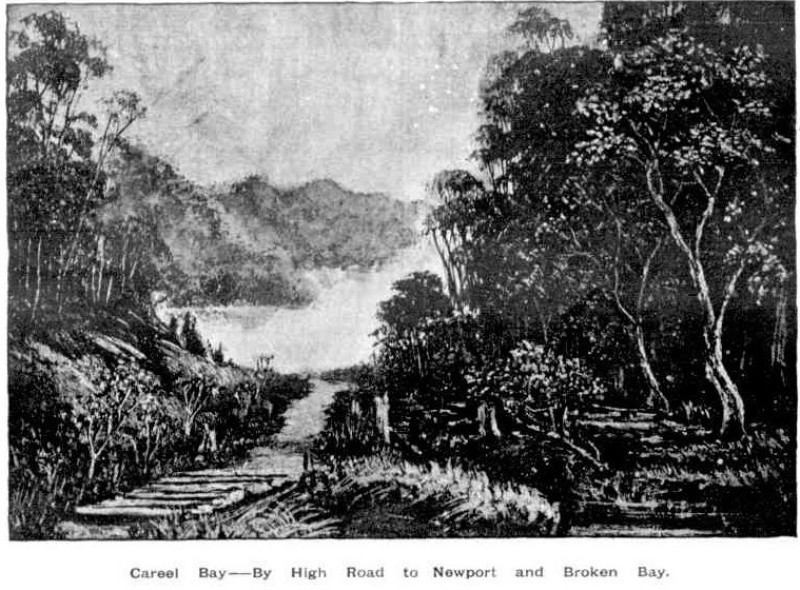
Manly to Broken Bay. (1893, November 11). Australian Town and Country Journal (NSW : 1870 - 1907), p. 19. Retrieved from http://nla.gov.au/nla.news-article71191632
We halted here just long enough to admire the scene, and to have a shot at one of a number of blue cranes, that were stalking about most consequentially and at the same time most warily upon the sands. It was only by dint of a good deal of manoeuvring and dodging that Nat was enabled to get even within possible shooting distance of the rearmost of the lot; and after all, when he fired, he didn't kill his bird. He however succeeded in frightening it, and not only it but all its companions, for they one and all took to flight with a wild cry. But if he had in one quarter caused a fright and a cry he had in another caused a fright and quietness for the report of the gun had stilled the squalling in the hut so effectually that it was not resumed, so long at least as we remained within hearing.
The track, a mere bridle path, now led along the flat, then across a dank luxuriant gully, down which a little stream roared and brattled and foamed with as much fuss and bother as would have been sufficient for a volume of water twenty times its quantity; afterwards,up a wet sloppy hill from which the water exuded in every direction, round the point of the range, down a correspondingly wet and sloppy descent on the other side; and then on to another flat the very counterpart of the one we had just quitted. Another luxuriant and overgrown gully, another wet hill teeming with springs, and then we come down, upon a somewhat broader flat, at the extremity of which we see two tents a short distance apart that we at once recognise, from the description we had received of them, as being the Chinamen's place.
(To be continued.)
MY HOLIDAY. (1861, September 2). The Sydney Morning Herald (NSW : 1842 - 1954), p. 3. Retrieved from http://nla.gov.au/nla.news-article13057913
The cave referred to is what we today call St. Michael's cave and was spoken of as being designated as being used as a possible church by John Joseph Therry, although this never seemed to occur. Pittwater’s first church at Careel Bay, St Josephs, a small one room wooden church with a shingle roof, built in early 1870, was a Memorial to John Joseph Therry and stood near the present corner of Joseph (or George) and Therry Streets with farm lands around it that went back to bush. Catholic settlers of the area were fortunate if the church was opened once a year for Mass. The little church, known as the Barrenjoey Church of St Joseph’s, (the Catholic patron saint for workers) even though it was known as Father Therry’s, was not actually built until after his death.
Called by many in the early rural district of Pitt Water the 'Patriarch of Pittwater', John Collins was the eldest son born to Jeremiah and Catherine Collins (Nee Roche) at Annakissy, Killavullen Parish, Ireland. Shelagh Champion OAM and George Champion OAM, in their Profiles of the Pioneers (2013 - Warringah Shire Library) state Jeremiah and Catherine had four known sons, John, Francis (Frank), William and Æneas and two daughters, Mary and Catherine. A US relative who has been researching this branch of his family also lists two of the Collins sisters, Margaret, who married Jeremiah Hartnett (also from Cork) in Sydney in 1846, and Ellen immigrating to San Francisco at the height of the California Gold Rush in 1849. There are four other daughters listed in Church records, Bridget and Hanora, and two Mary's (one born in 1811 and the other in 1828). Of the 17 children the couple had baptised, only 12 were known to still be living when they embarked for New South Wales.
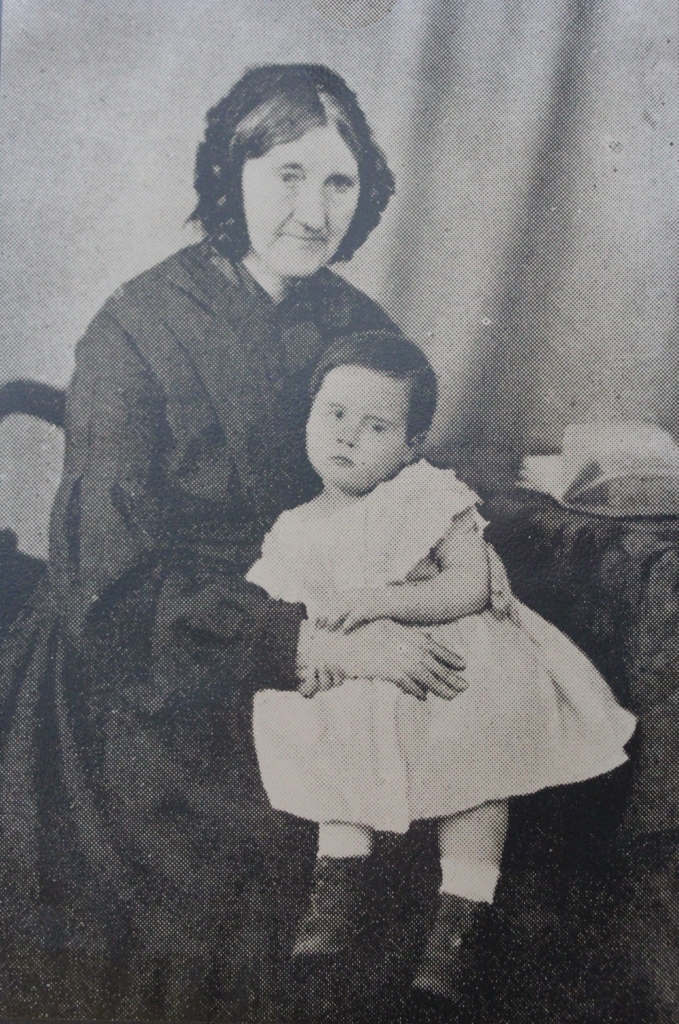
Catherine Collins - photo courtesy Avalon Beach Historical Society
Phil Michelson of California on Jeremiah and Catherine: Jeremiah immigrated to Sydney, NSW with 12 of his children aboard the Elphinstone in 1840. He had been evicted from the Pierce Nagle Estate at Clenor even though he had paid his rent on time.
Many other tenants were evicted from the same estate during these years. The Elphinstone sailed into Sydney in October of 1840 - a check of the ships records shows only three of the sons aboard - John, Aenas and William. The Champion's research points to Jeremiah and Catherine arriving later:
Shipping Intelligence. ARRIVALS-YESTERDAY. ELPHINSTONE, barque, Friendlen, master, from London and Plymouth the 3rd of June, Gore and Co., Agents. Cargo-Merchandise. Passengers - Cabin - Mr. Capper, Captain Edinborough and Lady. Mr. Arthur Edinborough. Mr. Thomas Boyed. Intermediate - Mr. and Mrs. Levy,Mr. Forsyth, Mr. Hynd, Mr. Cullender, Mr. Gibbes, Miss Roach, andtwo hundred and forty-eight Emigrants, under the command of D.M. Salter, Esq., Surgeon. Shipping Intelligence. (1840, October 9). The Sydney Monitor and Commercial Advertiser (NSW : 1838 - 1841), p. 3 Edition: MORNING. Retrieved fromhttp://nla.gov.au/nla.news-article32185727
Ship News. By the Elphinstone from London, we have received 248 emigrants, who appear to be a most respectable set of people, and principally agriculturists. They have arrived in a healthy condition, notwithstanding that during the passage out, a slight case of fever was witnessed, which occasioned the death of four adults and six infants. This is the second vessel arrived from the firm of Carter and Bonus, and are sent out in addition to Marshall's emigrants. They consist of 158 adults, 28 children, between the age of seven and fourteen years, and fifty-five infants. The Himalaya, from London, bound to Port Phillip, with emigrants, was spoken by the Elphinstone, on the 11th September in lat. 38 ° 40' S , long. 90 ° 30' E., out 80 days, all well. The Mary Dugdale from Liverpool, bound to Adelaide with emigrants, and out 19 days, was spoken by the Elphinstone on the 29th of June, in lat. 8 ° N. Ship News. (1840, October 10). The Sydney Gazette and New South Wales Advertiser (NSW : 1803 - 1842), p. 2. Retrieved, from http://nla.gov.au/nla.news-article2539219
John Doyle, a relative of the Collin's had been transported for insurrection in 1823 according to family letters held by Mr. Michelson. The Irish Insurrection Act (1822) saw around 30,000 men and 9,000 women transported directly from Ireland. Apart from those from the cities of Dublin and Cork, the majority were from rural areas and were first offenders. Many were nationalists fighting British domination, or social rebels protesting against a harsh and unjust law which condemned them to poverty and starvation. [A G L Shaw]
Mr. Doyle, once he gained his Ticket of Leave here, became a Pitt Water tenant of Rev. J J Therry, who also hailed from Cork and was very keen to help those he saw as being harshly treated at home and just as harshly targeted here.
From the Champion's Profiles of the Pioneers:
John Doyle, whose native place was County Cork, had been sentenced to seven years transportation on 14 September 1822, arriving in New South Wales by the Earl St. Vincent in 1823. His year of birth was 1798. He was 5 feet 7 inches tall, with a ruddy complexion, brown curly hair and chestnut eyes. John Doyle of Pittwater was granted his Ticket of Leave on 29 December 1827. [AO TL 27/938] He was employed as David Foley’s ploughman in 1828.
On 22 December 1837 David Foley wrote to Father Therry: “Revd. Sir, I have to inform you that I have seen Doyle and Culhane as you requested, they told me they intend to remain another year and that they will pay their rent as soon as they can get their Produce to Sydney.” Again, on 14 February 1839 Foley wrote Father Therry’s agent, John O’Sullivan, “J. Doyle I saw several times, respecting his rent, he promised to pay but as yet has neglected to do so. He is in partnership with another Man on the Farm.” As they treated Foley and his authority as “useless”, he suggested the execution of a distress warrant against them to obtain the rent. [ML MSS 1810/18 p.199; 1810/55 p.137a-b]
John Doyle and Thomas Culhane wrote to John O’Sullivan from Pittwater on 12 August 1839:
“Sir, Having seen the Revd. J.J. Therry’s overseer some few days since and being informed that he was empowered to rent the farm which I now occupy, my lease being out, I beg leave to state to you that I should be willing to hold possession of the farm as usual at a fair rent (namely) 30£ per annum which is as much as it ever realised - you being aware that none of the Revd. Mr Therry’s tenants ever paid him any rent at least but a small trifle - and me being a tenant under the above Gentleman so long, I consider I should have the first preference. I am willing to find security for the rent if required. I am a very old resident in that District and my Cattle being Bred here it will put me to an ill convenience which I flatter myself you will take into consideration.
...I am rather surprised to find that Mr Foley should be appointed to fix a rent on the farm after all the improvements I have made on it.” The rent was £16 per annum. “...There is one year’s Rent due but I beg leave to state that there is some accounts between me and Mr Therry which was to be allowed me for some improvements made on the Farm, (namely) Ploughing the Ground in the first instance together with fencing some of the said Ground, Doors for the House, and some Wheat & Maize that was given to some of the Men by Mr Therry’s orders, the whole amounting to about 9£ which still leaves the balance of about 7£ which I will settle when I receive your answer.” A note at the top of the letter states: “He took a new piece of ground & fenced for his own use & advantage.” Another note at the end of the letter states, “Rent £45 from 1 Septr. Mr Hurly Security.” [ML MSS 1810/55, p.193-5]
On 29 February 1840 Doyle and Culhane wrote again, to know whether they should pay the rent to Mr Hurley or into the bank, “if it is in the Bank mention to us the name of the Bank it is to be paid in two as it will be Due next month.” A reply to their letter was to be sent to David Jordan at the Bird in Hand, Gloucester Street, Sydney, to be forwarded to Thomas Culhane. [ML MSS 1810/55, p.325-8]
John Doyle drowned in Pittwater on January 20th, 1841:
INQUEST.-An inquest was held on Tuesday morning at the house of Mr. Murphy, the Sign of the Bard's Legacy, Queen's Wharf on the body of John Doyle, who was accidentally drowned by the upsetting of a boat at Pitt Water, on Wednesday, the 20th instant. The body was found at Broken Bay on Monday last by some fishermen,who brought it to Sydney. It appeared from the evidence that the persons who were in the boat along with deceased at the time the accident occurred, as well as deceased himself, were perfectly sober, and the jury returned a verdict of accidental death. THE REGATTA. (1841, January 28). Australasian Chronicle(Sydney, NSW : 1839 - 1843), p. 3. Retrieved from http://nla.gov.au/nla.news-article31730651
Records indicate that Mr. Doyle was not the only man to lose his life in small boats on Broken Bay that year:
James M'Quillan. Pilot, Brisbane Water, was unfortunately drowned while crossing from Pitt Water to Brisbane Town, by his boat being caught in a squall and capsizing. Mr. M'Quillan is much regretted Summary of Public Intelligence. (1841, July 31). The Sydney Gazette and New South Wales Advertiser (NSW : 1803 - 1842), p. 2. Retrieved from http://nla.gov.au/nla.news-article2554037
A few days ago, as Mr. James M'Quillen, the pilot at Brisbane Water, was crossing in his own boat from Pitt Water to Brisbane a squall upset the boat, and Mr. M’Quillen and a man named George Ford, who was with him at the time, were both unfortunately drowned. The body of Mr. M’Quillen was found lying upon the beach, but the body of Ford has not since been heard of. Insolvent Debtors' Court. (1841, July 31). Australasian Chronicle (Sydney, NSW : 1839 - 1843), p. 2. Retrieved from http://nla.gov.au/nla.news-article31732459
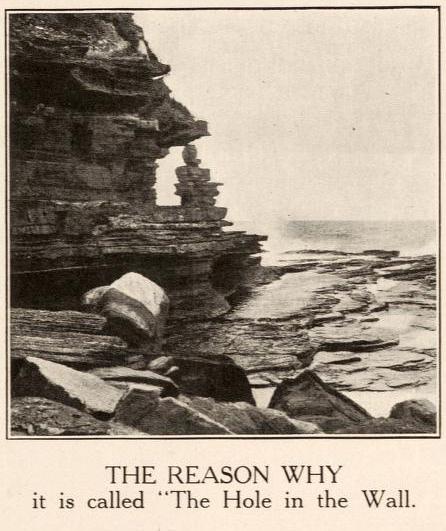 COLLINS, Jeremiah: Hole in the Wall, Parish Broken Bay, County Cumberland, District Sydney.
COLLINS, Jeremiah: Hole in the Wall, Parish Broken Bay, County Cumberland, District Sydney.
The Collins family engaged in farming, with John Collins running the farm when his father Jeremiah passed away soon after the son named for him did:
FUNERAL. — The friends of Mr. Jeremiah Collins, Pitt Water, are requested to attend the funeral of his deceased son, Jeremiah, to move from the Ferry Wharf, Windmill - street, Tomorrow, Wednesday afternoon, at half-past three o'clock. JAMES CURTIS, Undertaker. Hunter-street, October 5. Family Notices. (1852, October 5). The Sydney Morning Herald(NSW : 1842 - 1954), p. 3. Retrieved from http://nla.gov.au/nla.news-article12940492
FUNERAL.—The friends of the late Mr. JEREMIAH COLLINS, Pitt Water, are requested to attend his Funeral, to move from the Ferry Wharf, Windmill-street, this (Wednesday) afternoon, at five o'clock. JAMES CURTIS, Undertaker. Hunter-street, November 10. Family Notices. (1852, November 10). The Sydney Morning Herald (NSW : 1842 - 1954), p. 3. Retrieved from http://nla.gov.au/nla.news-article12941451
Jeremiah's wife Catherine went to live with her daughter Catherine, now wife of Bernard Daly. She passed away in 1872. Bernard Daly, prior to his passing, transferred the licence of the Union Inn to his brother in law, John Connolly, also of Cork, and his sister-in-law, Mary (nee Collins), who some may recall from our history page on the Broken Bay Customs Station under the tenure of Albert Thomas Black:
By special license, on the 17th April, at the Roman Catholic Chapel, North Shore, by the Rev. Peter Powell, Mr. Bernard Daly, Union Inn, North Shore, to Miss Catherine Collins, daughter of the late Jeremiah Collins, Pitt Water. Family Notices. (1856, April 18). The Sydney Morning Herald(NSW : 1842 - 1954), p. 1. Retrieved from http://nla.gov.au/nla.news-article12981900
Albert Thomas Black, Collector of Customs at Barranjuie, deposed to starting with his crew to the rescue of some men in a boat which he heard had upset; he rescued George Williams, John Walker, and deceased (whom he believed to be dead),and seeing that a boat was making for Francis Smith, and considering him safe to be picked up, he made for home; he tried for a couple of hours to restore life in Tucker, but failed; he desired to mention the heroic conduct of a lad named Jeremiah Connolly, who, of his own accord, put off in a small boat to save these drowning men. John Connolly, one of Mr. Black's crew, gave evidence as to the up-setting of the boat, which he witnessed from the shore. From the evidence adduced, Mr, Smith, gave it as his opinion that death had resulted from drowning. FATAL OCCURRENCE AT BARRANJUIE, BROKEN BAY. (1871, December 29). The Sydney Morning Herald (NSW : 1842 - 1954), p. 9. Retrieved from http://nla.gov.au/nla.news-article13250096
COLLINS—April 13, at the residence of her son-in-law, Mr. Bernard Daly, Union Inn, North Shore, Mrs. Catherine Collins, relict of the late Jeremiah Collins, of Pitt Water, aged 81 years. Family Notices. (1872, April 20). The Sydney Morning Herald(NSW : 1842 - 1954), p. 7. Retrieved from http://nla.gov.au/nla.news-article13256066
The license of the Union Inn, St. Leonards, from Bernard Daly to John Connolly. WATER POLICE COURT. (1877, March 28). The Sydney Morning Herald (NSW : 1842 - 1954), p. 7. Retrieved from http://nla.gov.au/nla.news-article13387885
A very old resident of the Shore, Mr. Bernard Daly, late of the Union Inn, was buried last week. He was a civil, obliging, honest man, whose house was always open to weary travelers, some of whom would remain days without paying him a penny. He and his late wife were those ideal innkeepers so highly spoken of by that great saint Francis De Sales, who said 'that he saw no condition in life which furnished greater means of serving God in our neighbour, and advancing heavenward, because it keeps a man continually engaged in works of mercy, although like the physician he receives his salary.' Mr. Daly was instrumental in procuring from the Government the unrivalled site upon which the Catholic Church stands. In his last days his spiritual wants were constantly attended to by Dean Kenny; and Mrs. Connolly, his sister-in-law, Mrs. Boyd, and Mr. John Collins of Pittwater, his brother-in-law, left nothing undone that would conduce to his comfort. He has left four grown-up children, who are well provided for. ST. LEONARDS. (1877, October 13).Freeman's Journal(Sydney, NSW : 1850 - 1932), p. 10. Retrieved from http://nla.gov.au/nla.news-article115375940
John married Honorah (nee Stanton) in 1847. Their children were Ellen (b.1848), Patrick John, Margaret (b.1850), Jeremiah Joseph (b.1851), Katherine Mary (b.1853), Francis Edmund (b.1855) and twins John and Matthew Æneas (b.1859).
In the Life and Letters of Rev JJ Therry, reference is made to a Dr. Bergin being in charge of the Pittwater properties given in Land Grants to the Archpriest - John O'Sullivan, who had earlier worked with the J J Therry on behalf of newly landed Catholics, and still looked after his interests even after he had died, had become a Manager of the Commercial Bank at Goulburn, where he would remain for 31 years until retirement in 1867. This may be Dr. Bergin's 'strayed' equine:
A REWARD.-Stolen or Strayed, from Mr. John Collins paddock, Pittwater, one HORSE COLT, two years old, brownish colour, small white star in forehead, branded on near shoulder B. Any person bringing me information to his recovery two pounds reward, if stolen, ten pounds reward, on conviction of the thief. Advertising. (1857, October 21). The Sydney Morning Herald(NSW : 1842 - 1954), p. 1. Retrieved from http://nla.gov.au/nla.news-article13001858
This would not be the only time someone was reaching into the pocket of John Collins:
Christopher Coyle was brought, before the Court by police-sergeant Smith, charged with stealing a silver watch, value £4. John Collins, farmer, of Pitt Water, stated that he was in Sydney on Friday, the 29th ultimo, and had the watch in his trousers' pocket. He did not know how he lost it, but he missed it about 8 o'clock. He did not recollect having seen prisoner before. Sergeant Smith happened to call at Sly's pawn office, just us the prisoner was offering the watch in pledge. Committed for trial at next Quarter Sessions.WATER POLICE COURT. (1866, July 5). The Sydney Morning Herald (NSW : 1842 - 1954), p. 5. Retrieved from h ttp://nla.gov.au/nla.news-article28612209
John and his brother Frank ran the farm, essentially a dairy.
A stylised painting of the 'Hole in the Wall' from 1860:
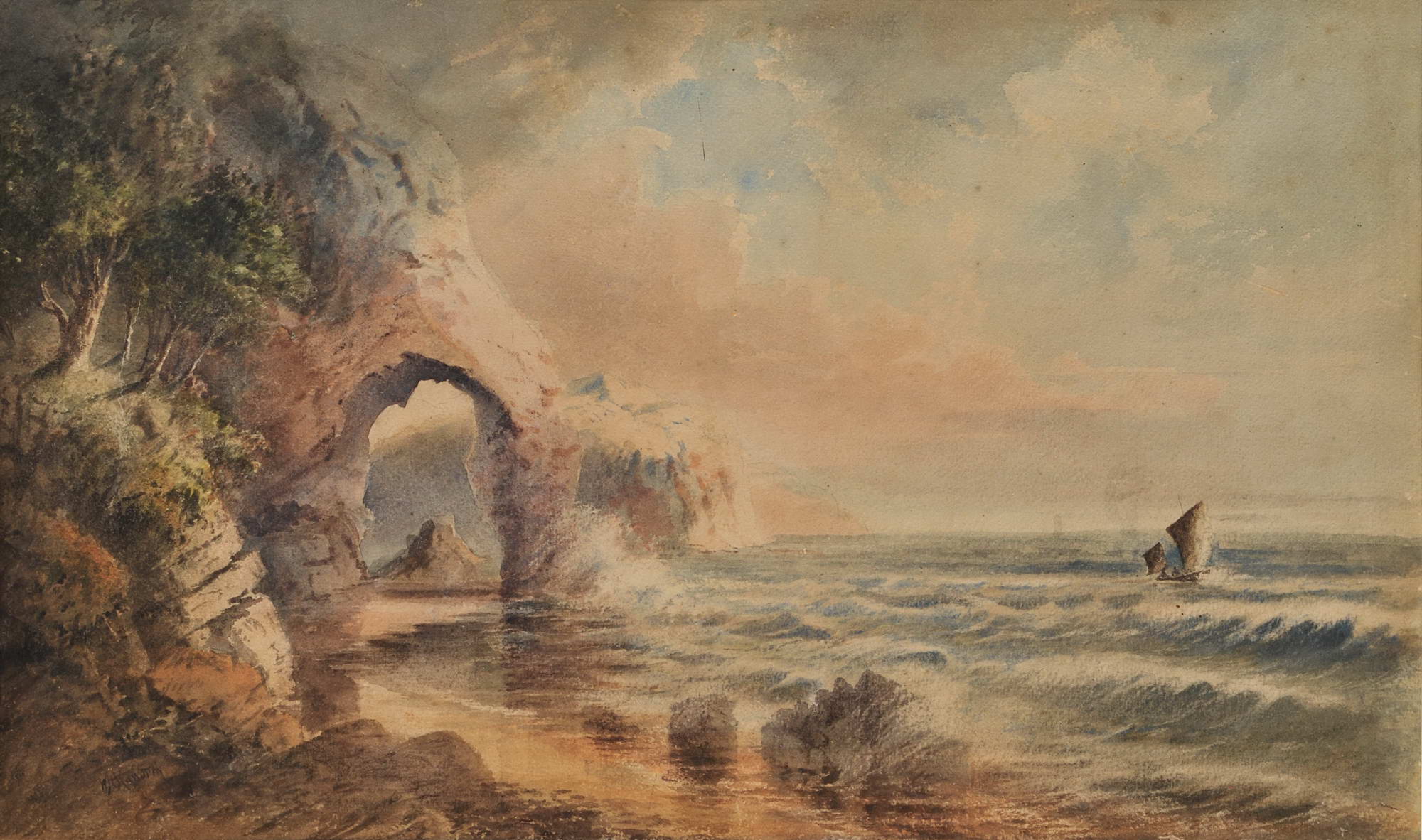
W.H. Raworth (Brit./Aust./NZ, c1821-1904). St Michael’s Arch, NSW [Avalon] c1860s. Watercolour, signed lower left, obscured title in colour pencil verso, 34.2 x 56.5cm. Tear to left portion of image, slight scuffs and foxing to upper portion. Price (AUD): $2,900.00 at:https://www.joseflebovicgallery.com/pages/books/CL181-53/w-h-raworth-c-brit-aust-nz/st-michaels-arch-nsw-avalon
The 'Hole in the Wall' or St. Michael's Arch fell in 1867 - The storm that turned an arch into a pedestal:
BROKEN BAY.
[FROM OUR CORRESPONDENT]
June 24 – We have had tremendous weather, but, as far as Pitt Water is concerned, no damage has been done with the exception to one of our picturesque curiosities, St. Michael’s Arch. It has at length to the too mighty elements and the destroying influence of time, that which was the admiration of all who have beheld it is now almost baseless fabric-there is only about one half of the outer support left, looking at it at a distance it has the resemblance of a coloured pillar. In its fall it carried a large portion of the overhanging rock with it, a thousand tons of gigantic boulders, and in such masses that I think it will stop the ingress from that part to the cave, but at yet we have had no close inspection for the rollers are dashing to the height of the stupendous rocks. The only idea I can give of the gale is that the froth of (not spray) the sea came over Mount St. Joseph, opposite the house, half a foot in size, and spread itself down to the dam, at times shading the heights of the mountain,-its resemblance was that of an overwhelming snow storm.
The sea at Barranjoey washed away the flower garden in front of the Chinamen's huts, taking soil and all, so that the beach comes close up to their door. There must have been awful havoc in the Hawkesbury, for all the beaches from Barranjoey to the Long Beach are strewn with fragments of houses, boxes, chairs, door frames, dead pigs, hay, wheat, broken bedsteads, weather-board sides of houses, oranges with large branches, pumpkins, melons, corn cobs, and other debris, that scarcely any portion of the beaches can be seen. Mr. Conolly picked up a workbox, in which was contained a number of receipts and letters directed to Mr. Moss, Windsor. The beaches on which are the debris is Barrenjoey, Whale Beach, Collins's Beach, Mick's Hollow Beach, Farrell's Beach, Mona Beach, and Long Beach, so it may be imagined the great extent of destruction. BROKEN BAY. (1867, June 27). The Sydney Morning Herald (NSW : 1842 - 1954), p. 2. Retrieved from http://nla.gov.au/nla.news-article13144304
BROKEN BAY. [From the Herald's Correspondents.]
June 24. — We have had tremendous weather, but, as far as Pitt Water is concerned, no damage has been done, with the exception to one of our picturesque curiosities, St. Michael's Arch. It has at length yielded to the too mighty elements and the destroying influence of time,— that which, was the admiration of all who have beheld it is now almost a baseless fabric,— there is only about one half of the outer support left, looking at it at a distance it has the resemblance of a colossal pillar. In its fall it carried a large portion of the overhanging rock with it, a thousand tons of gigantic boulders, and in such masses that I think it will stop the ingress from that part to the cave, but as yet we have had no close inspection, for the rollers are dashing to the height of the stupendous rocks. The only idea I can give of the gale is, that the froth of (not spray) the sea came over Mount St. Joseph, opposite the house, half a foot in size, and spread itself down to the dam, at times shading the heights of the mountain, — its resemblance was that of an overwhelming snow storm. The sea at Barranjoey washed away the flower garden in front of the Chinamen's huts, taking soil and all, so that the beach comes close up to their door. There must have been awful havoc in the Hawkesbury, for all the beaches from Barrenjoey to the Long Reach are strewed with fragments of houses, boxes, chairs, doorframes, dead pigs, hay, wheat, broken bedsteads, weatherboard sides of houses, oranges with large branches, pumpkins, melons, corn cobs, and other debris, that scarcely any portion of the beaches can be seen. Mr. Conolly picked up a workbox, in which was contained a number of receipts and letters directed to Mr. Moss, Windsor. The beaches on which are the debris is Barrenjoey, Whale Beach, Collins's Beach, Mick's Hollow Beach, Farrell's Beach, Mona Beach, and Long Reach, so it may be imagined the great extent of destruction. BROKEN BAY. (1867, June 29). Sydney Mail (NSW : 1860 - 1871), p. 11. Retrieved from http://nla.gov.au/nla.news-article166799304
Many resident historians are fairly certain that the above was written by then resident in this region John Collins, or his brother Frank, who worked occasionally at the Broken Bay Customs Station, Barrenjoey headland during these years. Mr. Conolly, who is also mentioned, became a relative by marrying one of the Collin's ladies.
John Joseph Therry had a dream of establishing 'Josephton' on the shores of Careel Bay for his workers. Those who sought coal at Avalon Golf Course, farmed or collected shells from the middens of the original inhabitants for the manufacture of lime were already here - as were the Collins family. One of many wills he wrote illustrates his plans for his farm here:
"I desire that my farm of eighty acres, formerly known as Peter Petitta’s farm at Pitt Water, which is beautifully and most advantageously situated, should be divided into four equal parts of twenty acres each which are intended as the sites for educational establishments for the Benedictines, Jesuits, Franciscans, and the French Mission of the Propaganda respectively.”
Also “to the land property with which I have been blessed, namely to establish five villages which are likely to become respectable towns the principal one at Pitt Water to be called Josephton” (Life and Letters. 1922). Other documents state he planned to call the whole district Josephton and Avalon was to be named 'Brighton'.
What is certain is that Careel Bay, with its creek and sheltered cove, must have seemed ideal to his eyes, a place to dwell in quietly as respite from all his endeavours through the colony and elsewhere in Australia. Therry’s plans to build a church at St Michael’s cave illustrate the openness and beauty here kindled a rapport with the natural landscape and a sense of its innate sacredness in his self.
A description of one of his visits here:
PITT WATER.
Yesterday, being Easter Monday, a pleasant steam excursion took place in connection with the St Benedict's Young Men's Society. The commodious steamer the Collaroy, under the command of Captain Mulhall, had been chartered for the occasion, and left the Australasian Steam Navigation Company's Wharf, Sussex-street North, with about 260 persons on board, at ten o' clock a.m. Part of the band of H. M. S. 12th Regiment were in attendance, their cheerful and untiring efforts contributing not a little towards making the day pass harmoniously and agreeably away.
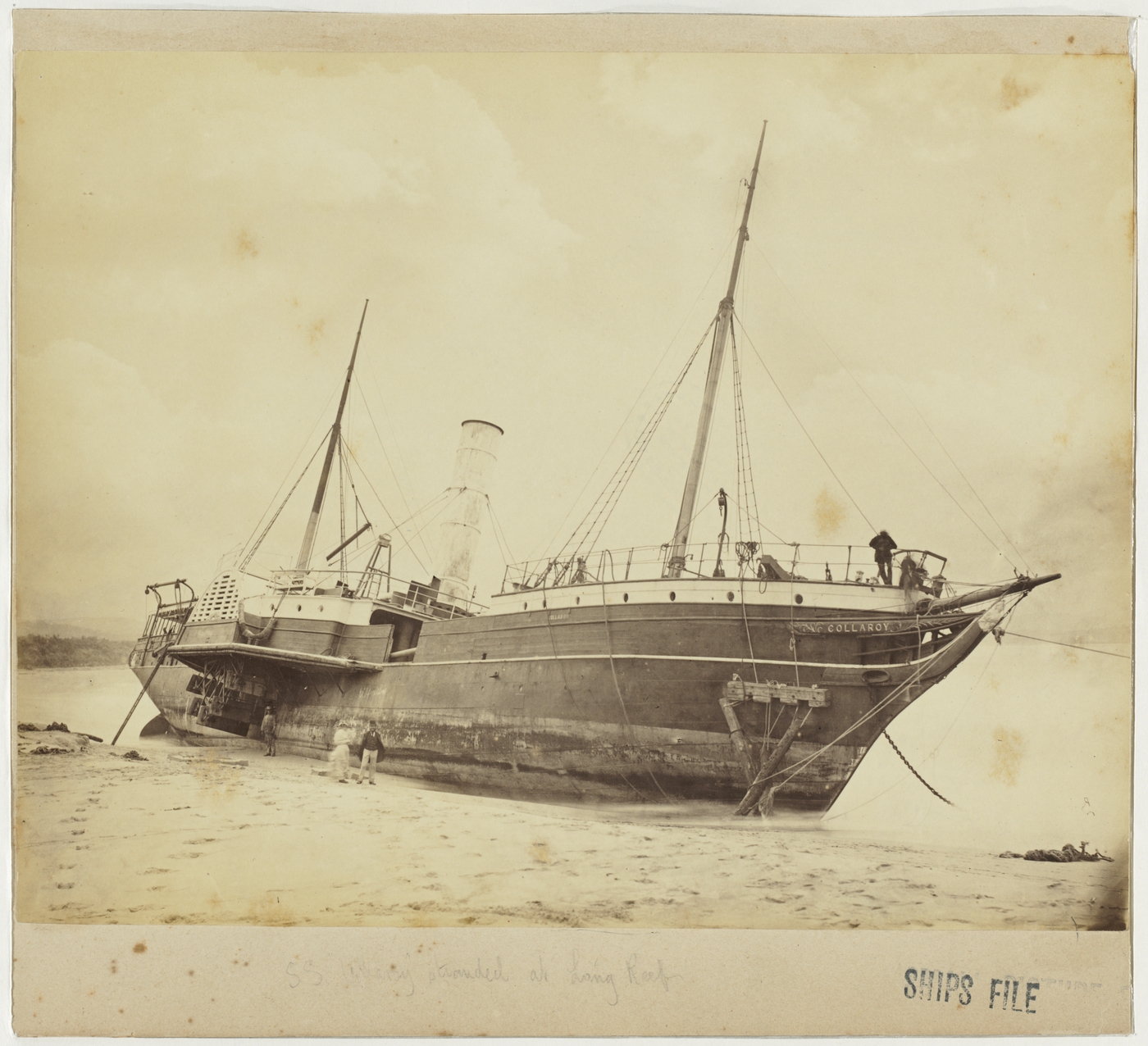
Wreck of the S.S. Collaroy, 1881 / photographer unknown. State Library of NSW Image No: a1528938: A passenger steamer owned by the Australian Steam Navigation Company, built in 1853, went ashore on Collaroy Beach in 1881 and remained there for almost 3 years, giving her name to the stretch of sand and ocean. When refloated she went back into service plying between Sydney and the Hunter River. She was withdrawn from duty in 1886, converted to a schooner, sailed to San Francisco, where she again ran ashore and broke her back on the Californian Coast in 1889.
Working along through the ever changing scenery displayed on the shores of our harbour, the Collaroy at length rounded the Heads, and, taking a northerly course, rushed past that enormous barrier presented by the weather-worn cliffs which face the ocean between the Great North Head and the seaward aspect of Manly Beach. Following on the interesting coast line of Curl Curl, Dee why, Long Reef, and Narrabeen, &c, - varied succession of wooded eminences, long sandy reaches, towering precipices, and grassy park-like slopes, - the pleasure-seekers were at length abreast of the singular headland of Barrenjoey, forming the extreme south-eastern limit of the estuary which serves as a common outlet for the River Hawkesbury and the Pitt Water. Shortly after passing the Custom House station the course of the Collaroy then took a southerly direction, and so brought the holiday folks into the lake-like solitudes of Pitt Water, until wooded hills seemed to be rising on every side of the vessel.
The passengers were landed at a small, but commodious wharf, erected on the property of the Venerable J. J Therry, under whose especial patronage the excursion had been got up. Most of the visitors set off in quest of St. Michael's Cave, determined not to lose the opportunity of seeing so great a natural curiosity. The walk, it was found, lay through woods, a long flat, and a hilly scrub, until, facing to the east at the head of the inlet, the merry party, in a straggling Indian file, at length arrived in the vicinity of the cave, cautiously descending the rocks, and creeping carefully along a narrow path specially made for their convenience on the face of the cliffs, they were thus finally rewarded for their perseverance. Almost every body managed to scramble up into the cave, and not a few of the more adventurous explored its inmost recesses by candle-light. The effect of the gloomy inner arch looked down upon from the top of the second angle of the cave, was much admired; and so also was the wider arch at the entrance, as contemplated from the spot where the bright daylight again began to stream down upon the faces of the returning explorers. There was, for some time, a pleasant buzz of conversation and a discussion of food at the mouth of St Michael's Cave, and then the party set out on their way back to the steamer, where dinner had been prepared.
Some with sharpened appetites posted thither at once, but many remained with the band near the house on the flat, and amused themselves with dancing, playing cricket, and so on. There was some dancing also at the steamer after dinner was over. The Kembla steamer visited the wharf at an early hour, landed some passengers, and afterwards returned for them. The Collaroy left the wharf for Sydney at about five o'clock, and arrived safe at Sydney soon after eight. The Right Worshipful the Mayor of Sydney, the Mayoress, and other members of the family were on board. We also observed the Rev. Fathers Corish, Curtis, Hanson, and Powell, besides the Venerable J. J. Therry. The trip appeared to give general satisfaction, although a slight shower, soon after the arrival of the Collaroy at Pitt Water, interfered with some of the arrangements.
PITT WATER. (1862, April 22). The Sydney Morning Herald (NSW : 1842 - 1954), p. 4. Retrieved from http://nla.gov.au/nla.news-article13227471
Another account shows others using the steamer wharf without permission:
Pittwater.
It is not without reason that we boast of the many beauties that almost every nook and corner of the shores of Sydney Harbour offer to our view; the numbers of our citizens who, upon occasions of public rejoicing, flock to the principal points of interest are a sufficient proof of the thorough appreciation of them by the inhabitants of our fair city; but, great as are the attractions which we are accustomed to look upon with so much pleasure, there are others which possess the additional recommendations of novelty. We are not about to insinuate that the attractions of the numerous favourite localities in the harbour are by any means exhausted — 'rather, we should say, that the increase of appetite for the charms of Nature which lie at, we may say, our very doors grows by what it feeds on, if we may judge of the public taste by the greatly increasing number of visitors to the most celebrated localities in the harbour; but still, it is a matter of some surprise that the Heads should so long remain the Ultima Thule of our excursionists, and that the numerous beautiful spots on the shores of the Pacific, within easy distance of Sydney, should be comparatively, Terra Incognita to its inhabitants.
We heard, therefore, with great pleasure that, on Easter Monday, the ordinary rule of excursions was about to be broken through by the members of St. Benedict's Young Men’s Society and their friends, and that the 'Collaroy' had been engaged to land them on Father Therry's property at Pittwater, in Broken Bay, whence they could proceed to view St. Michael's Cave, that celebrated natural curiosity, to which we have already called attention in the Freeman's Journal. The day, fortunately, was most propitious for a sea trip, there being scarcely any wind to raise the fears of those to whom a voyage outside the Heads is looked upon as rather an adventurous enterprise — the long, majestic roll of the mighty ocean tending rather to add a zest to the pleasures of the voyage to those who are not affected by the vial de mer, so distressing to its victims, but which; unfortunately, meets with so little sympathy from those who have the good fortune to escape it.We were, however, very much pleased to see that there were very few who suffered in the slightest degree from this unwelcome concomitant to the pleasures of a sea voyage, and that those who underwent the ordeal of a slight attack recovered themselves long before our destination was reached.
The 'Collaroy,' under the command of Captain Mulhall, left the A. S. N. Co.'s Wharf shortly after ten o'clock; and as she is known to be one of the fastest boats sailing from the port of Sydney, she steamed gallantly down the harbour and along the coast to her place of destination. As we proceeded along the coast, the constant succession of beautiful scenery excited the admiration of every one onboard — many points on the coast, by their calm and placid beauty, calling to mind the parks and woodlands same of us have been accustomed to see at Home, than those spots untouched by the hand of man, and where Nature still reigns supreme.
Passing Burraujuee Head, which spreads out East and West like the head or a hammer at the end of along, narrow isthmus, which may not inaptly he compared to the handle, we steamed up Pittwater, and entered tint arm on its Eastern side upon which Father Therry's property is situated. As we proceeded up the Bay, the beautiful scenery on every side — so similar in its general character to that of our own harbour, and yet so different in its arrangement and general effect — excited the unqualified admiration of everyone on board. The situation of Pittwater and the beautiful country which surrounds it on every side renders it particularly available for the foundation of a watering place, which it will probably be at no distant period, when it becomes fashionable, for our citizens and their families to seek for change of air and scene during the heats of summer.
The steamer having landed its freight at the wharf constructed by Father Therry for the convenience of persons residing in the locality, and for those excursionists to whom he might give permission to land upon his property, they proceeded to walk towards the Cave, one of the chief attractions of the day's excursion. The path lay across a pleasant, undulating country to the rocks fronting the ocean, on the face of which the Cave is situated. A path has been constructed on the ledges of rock jutting out from the face of the cliff, and presenting in some places difficulties of approach to it which might have deterred many from venturing on the expedition had they been aware of them. The steps were frequently so steep and narrow that the slightest slip might have subjected a person to serious injury by precipitating him from a height of thirty or forty feet on to the rocks below, very similar to those at the base of the Gap, and against which the waves dashed with violence as great as we see at that spot, with which so much melancholy interest is associated. After what we had heard of the Cave itself, we certainly were rather disappointed on gaining the entrance: it is only by scrambling over the rooks, taking up a position at the extreme end and looking back towards the entrance that the full solemnity of the scene can be realised. The dim unearthly light streaming through the entrance and broken up by the projections of the roof and sides left an impression upon the mind not easily to be effaced; it was a fitting scene for all the horrors of the incantation scene in per Freischutz, its resemblance to which was rendered more striking by numbers of bats which flitted to and fro through the gloom;or to that scene in Macbeth where the Weird Sisters' Round about the cauldron go.'
The cave is certainly a very curious and interesting object, and but for its distance from Sydney would, without doubt, be a source of' great attraction to our pleasure seekers. Unfortunately a shower of rain, which fell between two and three o'clock, caused a slight interruption to the pleasures of the day by preventing the anticipated pleasure of a dance upon the green sward, but this little contretemps caused a great degree of attention to be paid to the creature comforts, the steward of the steamer being kept constantly employed in providing for the numbers of persons visiting the cabin to partake of the excellent lunch be had provided, and for which, be it remembered, he did not fail to charge a price considerably higher than we have been accustomed to see paid on similar occasions.
It was intended that Father Therry should have delivered the inaugural lecture of the season of St. Benedict's Society in St. Michael’s cave, but he was compelled, with great reluctance, to turn back without having reached it, having found the journey too fatiguing for him.
A great number of the excursionists scattered themselves in the bush and on the shores which skirt the beautiful bay, and several employed themselves in shooting and fishing. The Collaroy left Pitt Water about six o'clock in the evening and arrived in Sydney a little after eight no accident having occurred to mar the pleasures of a most agreeable day. Among the guests onboard we noticed the Very Rev. J. J. Therry Archpriest, Rev. Dr. Powell and Fathers Anselm, Corish, Donovan, McGirr, the Mayor of Sydney, with Mrs Oatley and family, &c. &c. The Band of the 12th Regiment had been engaged by the committee and played a selection of drama and other music which tended greatly to increase the pleasures of the day.
We must not omit to mention the extremely discreditable conduct of those who without asking any permission of Father Therry, on whose property St. Michael's cave is situated, very coolly advertised the Kembla to proceed there on another occasion at a less rate than the Collaroy, to the great annoyance and discomfort of those who had asked and obtained permission of Father Therry to make use of his ground. We are informed that an exorbitant price, no less than £70, was asked for the use of the Kembla for Easter Monday, her proprietors no doubt imagining that no other vessel suitable for the excursion was to be obtained, but finding afterwards that the Collaroy had been engaged, they immediately advertised the Kembla to go to the same place at a cheaper rate, thereby preventing many persons from going by the Collaroy who would in all probability have done so. There cannot be the slightest doubt that making use of a private landing place and with the greatest coolness taking possession of a gentleman's land to picnic upon and walk about is just as much a trespass as walking unbidden into his drawing room, and we are certainly surprised that a gentleman bearing the high character of Messrs. Manning should have in any way lent themselves to so mean and discreditable an act. We hope, however, that this hint will be sufficient to prevent a recurrence of a similar proceeding and that the first excursion of St. Benedict' s Young Men's Society having proved so agreeable to all who attended it we may have the pleasure of attending others as agreeable when a like opportunity is offered us. PITTWATER. (1862, April 23). Freeman's Journal (Sydney, NSW : 1850 - 1932), p. 6. Retrieved from http://nla.gov.au/nla.news-article115761495
The above report of this excursion record J J Therry was ill during the trip and unable to make the walk to St Michael's cave. A few years later he passed away, seemingly from overwork:
DEATH of the REV J.J. THERRY
{From Thursday's Herald.)
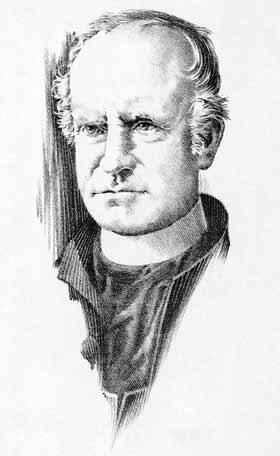 The announcement of the decease of this venerable clergy man will, notwithstanding his advanced age, be received with surprise, the more particularly when it is stated that he appeared in perfect health up to within two hours of the illness which carried him to his grave.
The announcement of the decease of this venerable clergy man will, notwithstanding his advanced age, be received with surprise, the more particularly when it is stated that he appeared in perfect health up to within two hours of the illness which carried him to his grave.TUESDAY, 18.
(Before Mr. Justice Dowiisa.)
Michael Toole was indicted for a burglary and robbery in the dwelling-house of Henry Gaskin, a settler, at Kreele Bay, in the district of Pittwater, on the 4th of February last.
From the evidence adduced in this case, it appeared, that on the night of the day laid in the in-formation, some time after the prosecutor, his wife, and a man named Woodford, who had lived in the house, had retired to rest, the outer door was forced open with considerable violence, and the prisoner rushed in, armed with a musket, calling out "now for your onions!" Gaskin and his wife, being an aged couple, were very much alarmed, particularly as the robber, presenting the musket at Gaskin as he lay in bed, swore that he would blow his brains out if ho stirred. He then compelled the man, Woodford, to rise and light a lamp, with which he commenced a search through the room, and obliged Woodford to open a chest, containing a variety of property, which he immediately commenced pillaging. While he was thus employed, he placed the musket on the ground, and Gaskin, upon a signal made to him, suddenly got out of bed and seized it unobserved. A dreadful struggle then ensued between Gaskin and the robber for the musket, in the course of which, Gaskin, still retaining his grasp, however, was thrown on the ground, and while in that position received a severe cut across the face with a knife which the robber drew upon him. Woodford came to the assistance of Gaskin, and struck the robber several severe blows on the head with a stick ; when finding, having lost possession of the musket, that the odds were against him, he made a precipitate retreat from the house. Gaskin endeavoured to fire after him, but found that the gun flint had been lost in the scuffle, and that the pan was full of his own blood which flowed from the cut received by him in the face. The witnesses underwent a most minute examination by the learned Judge, as to the prisoner’s identity, but they all swore positively to him ; the prosecutor and his wife stating that they recollected his person at once, as he had committed another felony in their house on the night of the 30th of the preceding November.
About a month after the commission of the offence for which the prisoner was tried he was apprehended by the district constable of Broken Bay, who, from information he received, traced him, with the assistance of two native blacks, to a house in that neighbourhood, where he was discovered concealed among some corn, and attempted to make his escape through the window, but was brought back, after he had proceeded a very short distance* from the house, by one of the blacks, who fired at, and wounded
Shot him in the elbow as he ran. The Jury found the prisoner Guilty, and the learned Judge immediately passed sentence of Death upon him, to be executed on such day as His Excellency the Governor should think proper to appoint. Supreme Court. (1830, May 20). The Sydney Gazette and New South Wales Advertiser (NSW : 1803 - 1842), p. 3. Retrieved from http://nla.gov.au/nla.news-article2195160
Gaskin married Margaret Evans in 1804 and is listed under subscribers for the then 'gazette' at Windsor in 1816:
Subscribers at Windsor. Names of Rank or £ s d.
Henry Gaskin... 0 9 0 Classified Advertising. (1816, March 16). The Sydney Gazette and New South Wales Advertiser (NSW : 1803 - 1842), p. 2. Retrieved from http://nla.gov.au/nla.news-article2176586
Henry Gaskin was listed in the September 1822 Land and Stock Muster with a wife, Margaret Evans, and a daughter, Ann Gaskin, aged 8. In the 1828 census he was listed as Andrew Gascon, aged 62. His grant was shown as 60 acres, of which 20 acres were cleared and 10 cultivated. Gaskin’s wife, Margaret, aged 63, and a five-year-old boy, Thomas Godard, lived with him. He also had a tenant, Andrew Woodsworth, 42, who had cleared and cultivated 5 acres. Henry Gaskin sold his 50 acre grant at Careel Bay to George Coy on 29 November 1834 for five shillings. [2.]
TO LET, FOR a term of three or five years, a FARM of Fifty Acres, acknowledged to be the best Ground in the vicinity of Pitt Water. Lately occupied by Mr. Henry Gaskin; Five and Twenty Acres of which are under cultivation. On the Farm there is a Dwelling-house, Barn, and Out-houses, as well as every requisite for Agricultural and Domestic purposes, which are to betaken by the Purchaser at a valuation. There is also a Wharf on this Farm, from which the Boats to and from Sydney, arrive and take their departure. For further particulars, apply (if by letter, post paid) to the Proprietor, Mr. G. Coy, Shoemaker, Cambridge-street, near the Saracen's Head. Classified Advertising. (1840, January 21). The Sydney Gazette and New South Wales Advertiser (NSW : 1803 - 1842), p. 2. Retrieved from http://nla.gov.au/nla.news-article2551318
The first tenant appears to be Robert McIntosh but the property was re-advertised in 1844.
Thomas Warner was sentenced to 7 years at Middlesex on 21 February 1787. He arrived in the Colony on the Third Fleet ship Albemarle, in October 1791. He was the master of two Hawkesbury trading vessels, the Union, during the years 1817 to 1819, and the Tiveot in 1821. In his memorial to Governor Macquarie in July 1820, requesting a grant of land, he stated that he had been free for 27 years and had resided at Broken Bay for seven years.
Warner had built a house and cleared and cultivated two acres of land. He was listed as “Settler, Broken Bay” in the 1822 General Muster. His grant of fifty acres was surveyed by Meehan, and also by George Boyle White in 1827. Seventy years old at the time of the 1828 census, he then had 25 acres, of which he had cleared 10 acres and had 5 under cultivation. He had sold 25 acres of the original 50 to James Stokes for £15. Warner transferred his 25 acres to Elizabeth Watson by deed of gift on 10 March 1830. [LTO Book C No. 396] She sold it to William Charles on 29 July 1835 for £12 [LTO Book K No. 239]; she then married William Charles. The 50 acres was conveyed to George Green of North Shore on 2 March 1854 [2.]
Their other close and notable neighbours were the Collins family on the J. J. Therry grant.
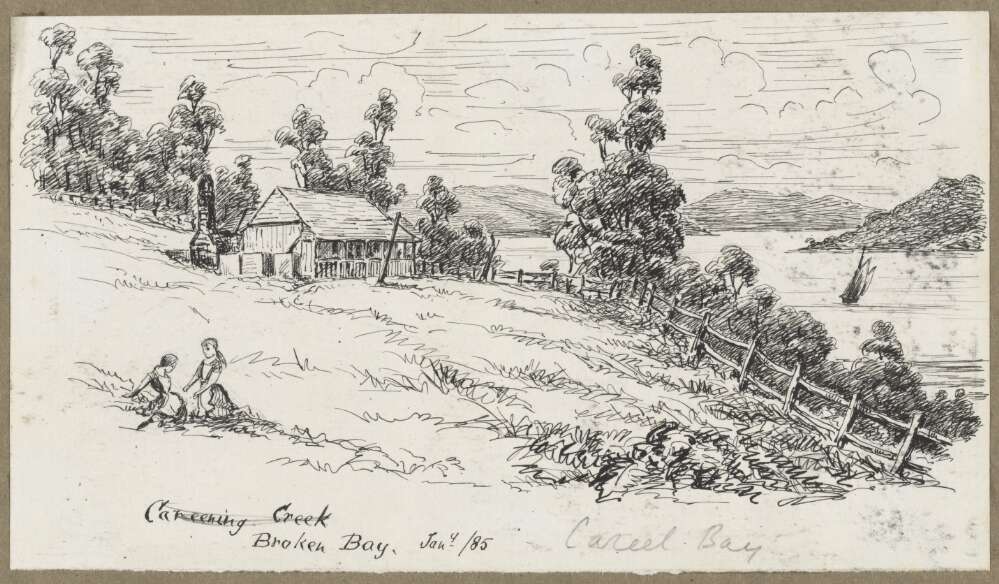
Careening Creek, Broken Bay January, 1885, by Harold John Graham (1858-1929), Image No: 2432858, courtesy National Library of Australia. Below shows 'Mount Patrick and Dam constructed by Collins.
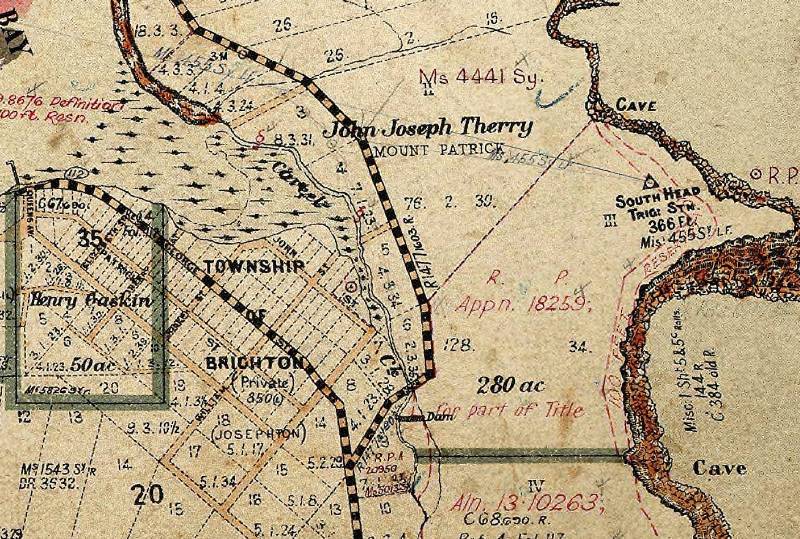
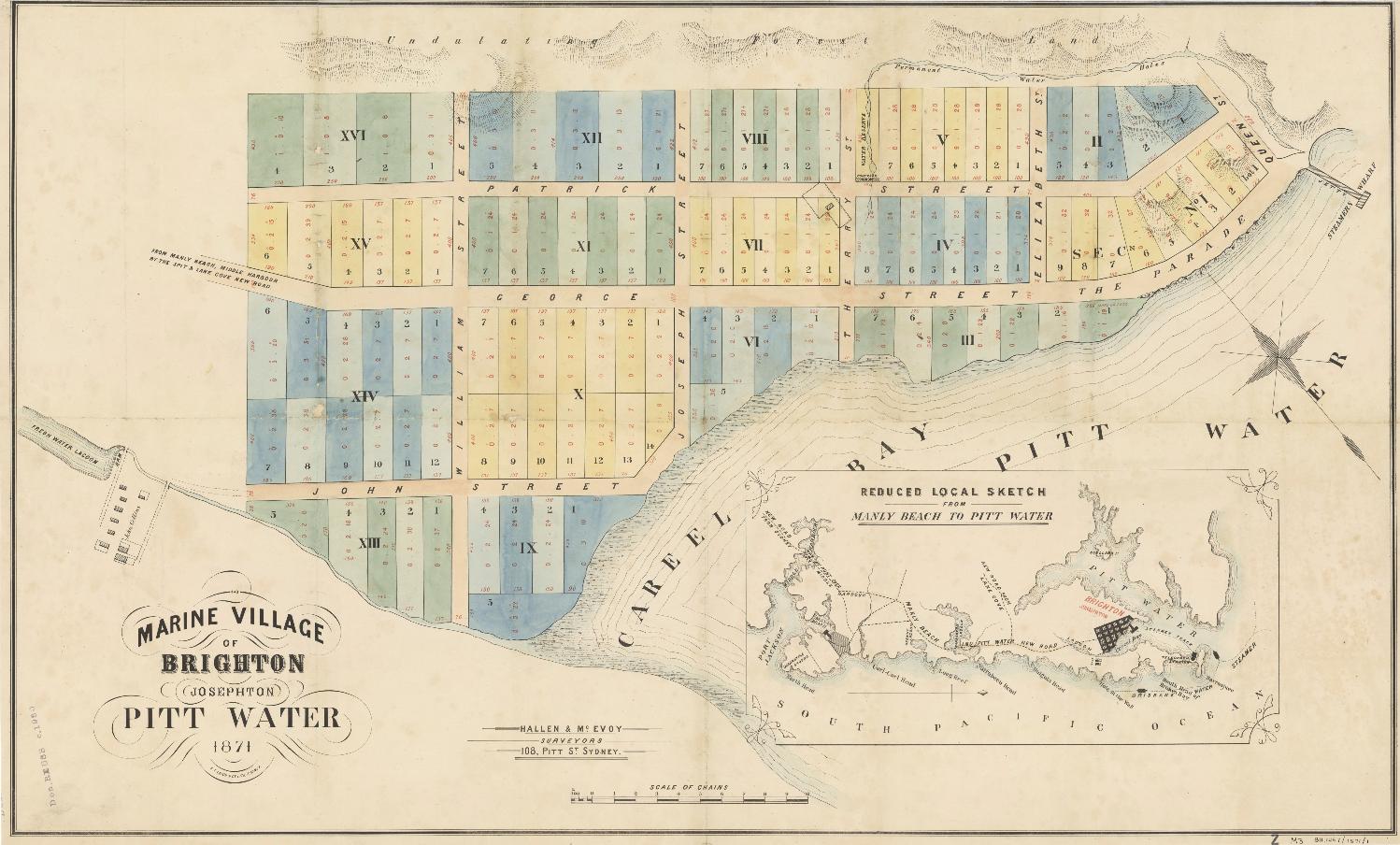
1871 pre sales map shows placement of Collins cottage. Item: e30116_0001_c from Subdivisions folder - courtesy State Library of NSW - and enlarged section from to show placement/structures at Collins Farm as marked on this map - and enlarged section near Lot V to show details on map - NB; the end of 'George' street was named ' The Parade':
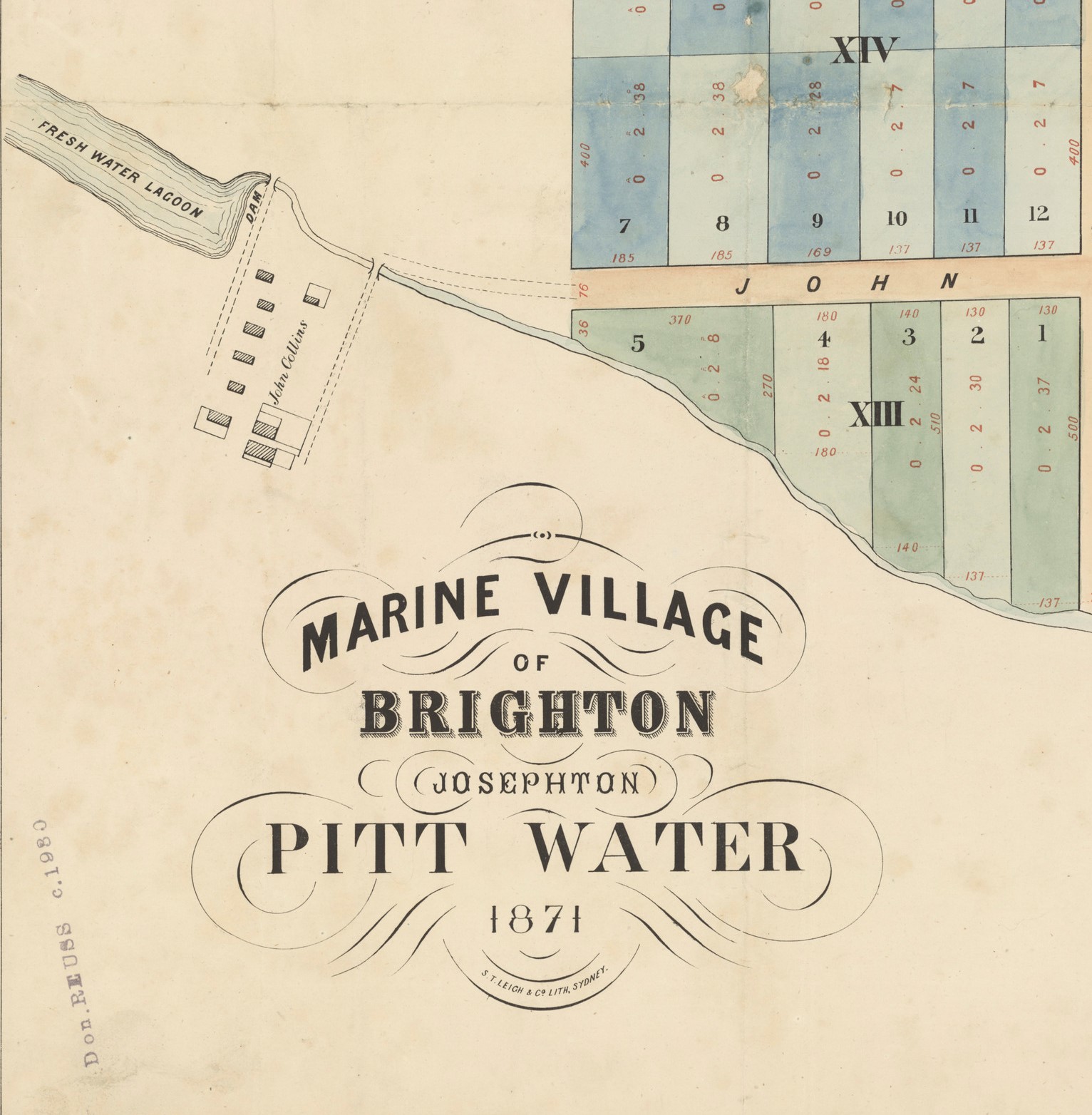
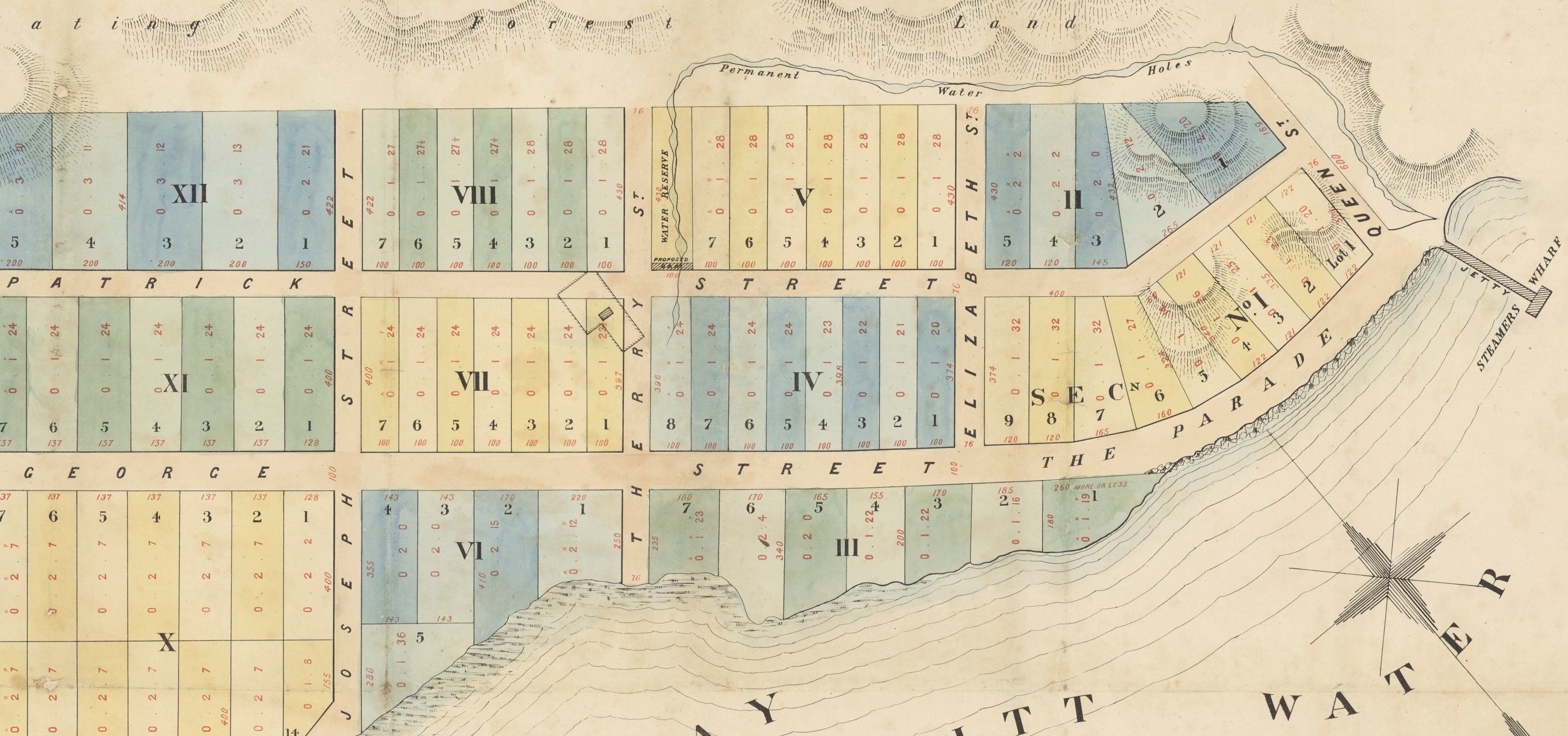
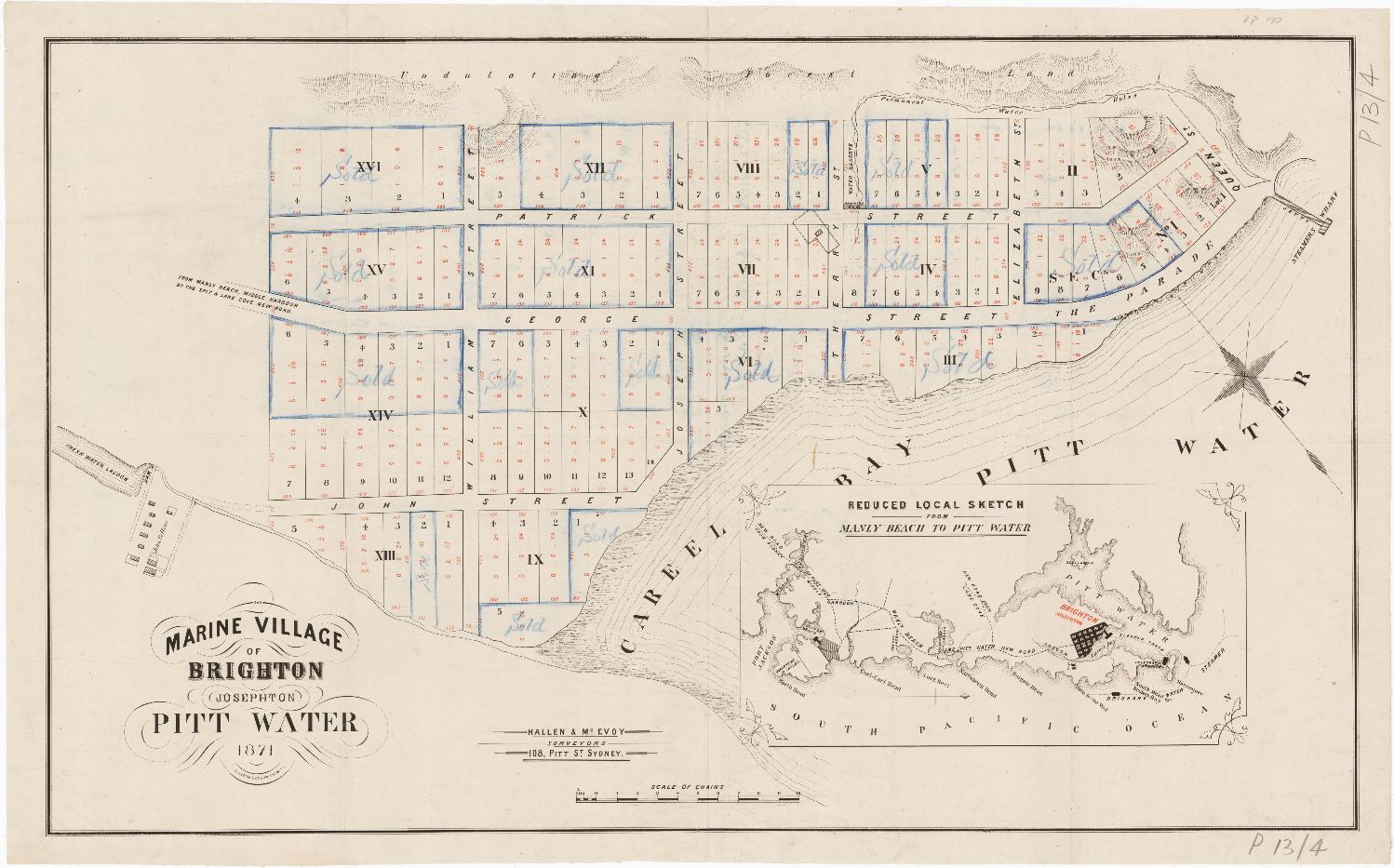
Marine Village of Brighton -Josephton Pitt Water 1871, sections shown Collins Lagoon too - Item c053460004, from Subdivisions folder - courtesy State Library of NSW
BELOW; Sections from (showing sales/owners) Marine Village of Brighton - John St, William St, George St (the Parade), Joseph St, Therry St, Patrick St, Elizabeth St, Queen St, [1871]. Item No: c053460043, courtesy State Library of NSW. Map 2 - among these you can see people such as John Collins of Avalon as well as Albert Black, then Coast Waiter at Broken Bay Customs Station at Barrenjoey, as well as his boatmen, John Connolly and Michael Madden.
Albert Thomas Black and wife Kate had several children while he was Coast waiter in charge of the Broken Bay Customs Station at Barrenjoey. The Mullhulls also were blessed prodigiously with children, while those employed as keepers or as Boatmen for the Customs Station, to 'man' the lifeboats during emergencies, were not opposed to the sound of little feet and joyous laughter either.
To educate their six children, four of whom were born at Barrenjoey (two sons and two daughters) Albert and Kate Black employed a tutor, Patrick Hynes. In Tales from Barrenjoey. Jervis Sparks. 1992, pages 91 - 109 Jervis relates that Patrick Hynes was sixty-one years old when he started working for the Blacks. Irish born and a widower, he was later appointed as a teacher, after Mr Black and his boatmen, John Connolly and Michael Madden, wrote to the authorities requesting aid to set up a school.
Michael and his wife had several children - a Thomas, Patrick, Michael, John and James are listed in the Funeral Notice when he passes away, at Manly, in February 1897. A devout Catholic family, one daughter joined the sisterhood - see the Obituary for this gentleman below.
The residents submitted Hynes' name as a teacher, and proposed to one of the boatmen's cottages, a few hundred metres south on the dunes, as the school.
John Connolly and Michael Madden, and even John's son Michael's son Jeremiah, were in the business of saving lives. There also seems to be a lot of itinerants going on and off the shores around the station and lightship - a few insights into the life and times just before and after Mr. Hynes became teacher/tutor:
SUPPOSED INCENDIARISM AT BARRENJOEY.-Information was brought yesterday morning to the police, that a night or two since a person named Connolly, residing close to the Custom-house station at Barrenjoey, was alarmed by hearing crackling noise apparently on the roof of his house, and on going outside found the building in flames. Connolly had, during a series of years, got together a large and valuable collection of shells, valued some time back by a skilled conchologist at L200, and these were totally destroyed, as well as the main part of the house. An assumption that the fire was the work of an incendiary, is strengthened by the fact that some persons at a distance saw some small flashes of flame before the fire broke out, and thinking the family had not gone to bed, made for the house, which was all in a blaze before they reached it. We believe that Mr. George Smith, J. P., of Manly, who usually attends to such matters, will be despatched by the Government to hold a magisterial inquiry into this very suspicious affair. GOVERNMENT GAZETTE. (1871, April 15).Empire (Sydney, NSW : 1850 - 1875), p. 3. Retrieved from http://nla.gov.au/nla.news-article60871107
We further desire to express our admiration of the heroic conduct of Master JEREMIAH CONNELLY, who nobly ventured out in a small boat with the object of rendering assistance, thereby showing his willingness, and incurring a great risk, to save life, if possible.
P.S.-We enclose a small remittance, which please divide among your crew as you think fit. '
Signed, FRANCIS SMITH, Peacock Point, Balmain. J. C. WALKER, Balmain. GEORGE A. WILLIAMS, Richmond Villa, Domain. THE LATE FATAL ACCIDENT IN BROKEN BAY. (1871, December 29). The Sydney Morning Herald (NSW : 1842 - 1954), p. 10. Retrieved from http://nla.gov.au/nla.news-article13249989
TEMPORARY LIGHTS, BARRENJOEY (BROKEN BAY). The Screens have been removed from these lights. They will now be seen from the southward when Barrenjoey is open, off the South Head of Broken Bay. FRANCIS HIXSON, Superintendent.NOTICE TO MARINERS. (1872, January 20).Empire (Sydney, NSW : 1850 - 1875), , p. 2. Retrieved from http://nla.gov.au/nla.news-article60880257
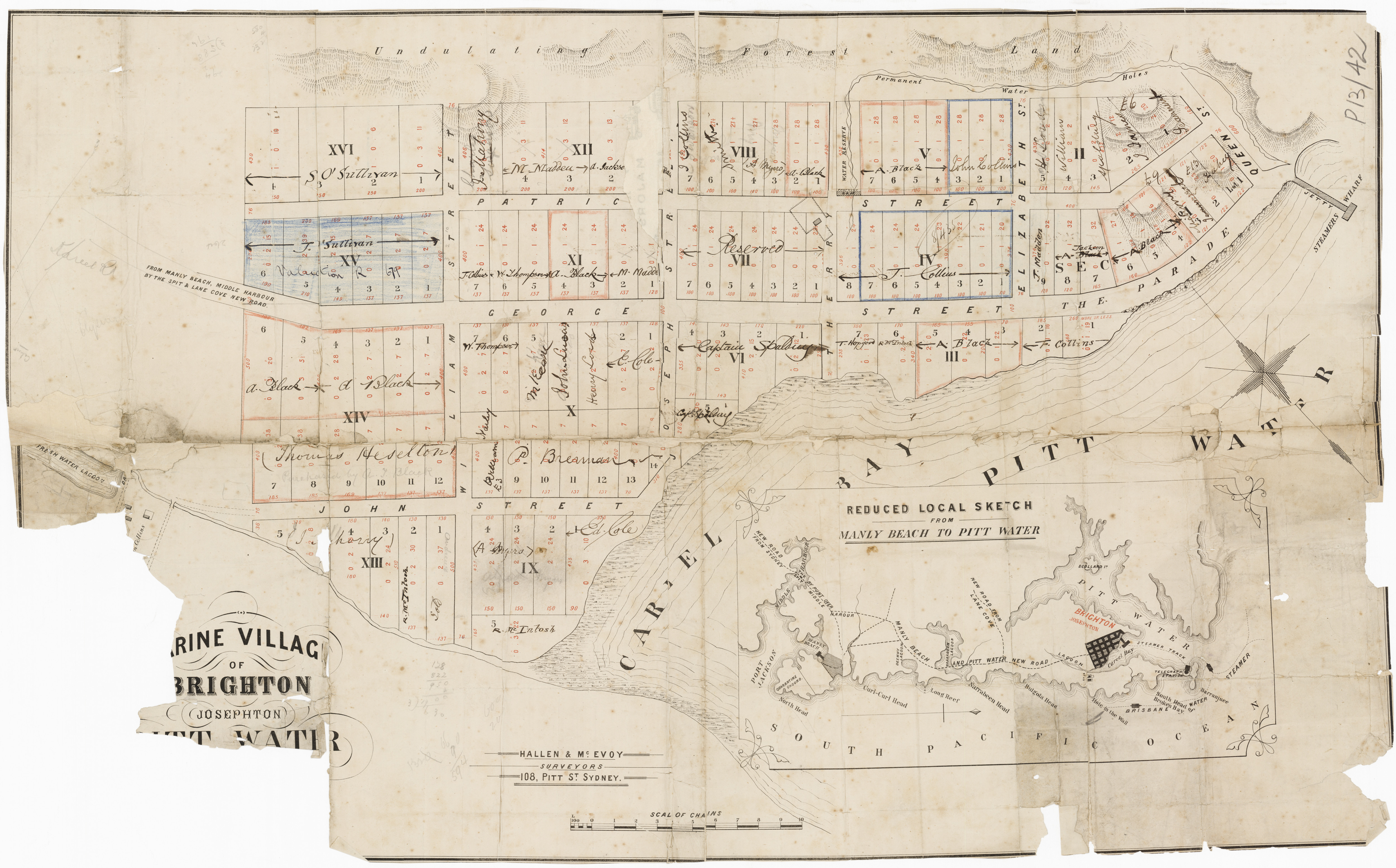
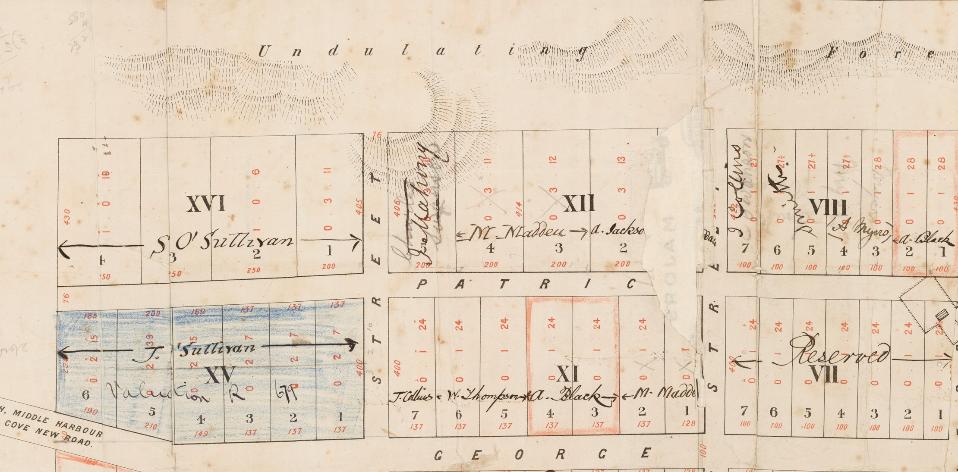
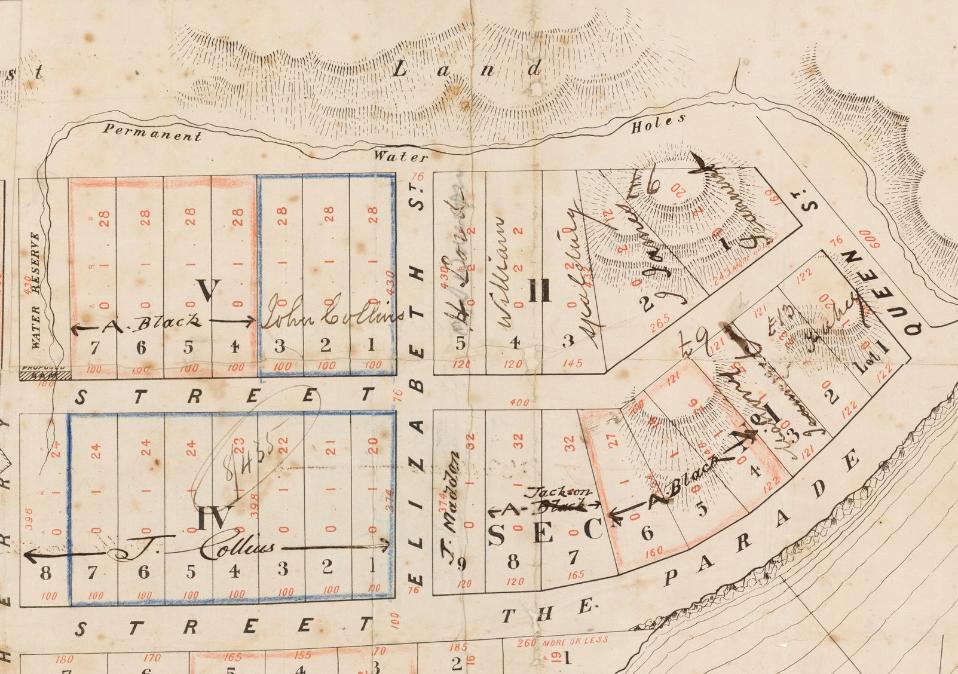
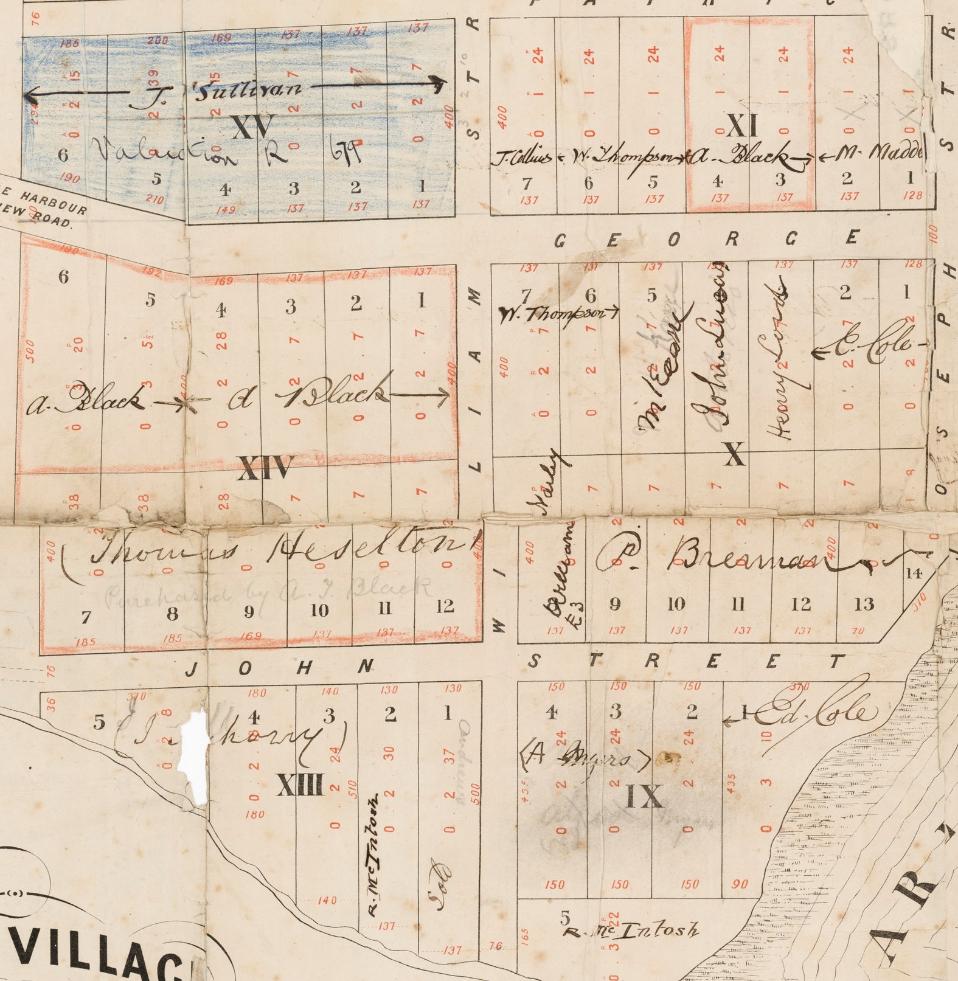
.jpg?timestamp=1591729318905)
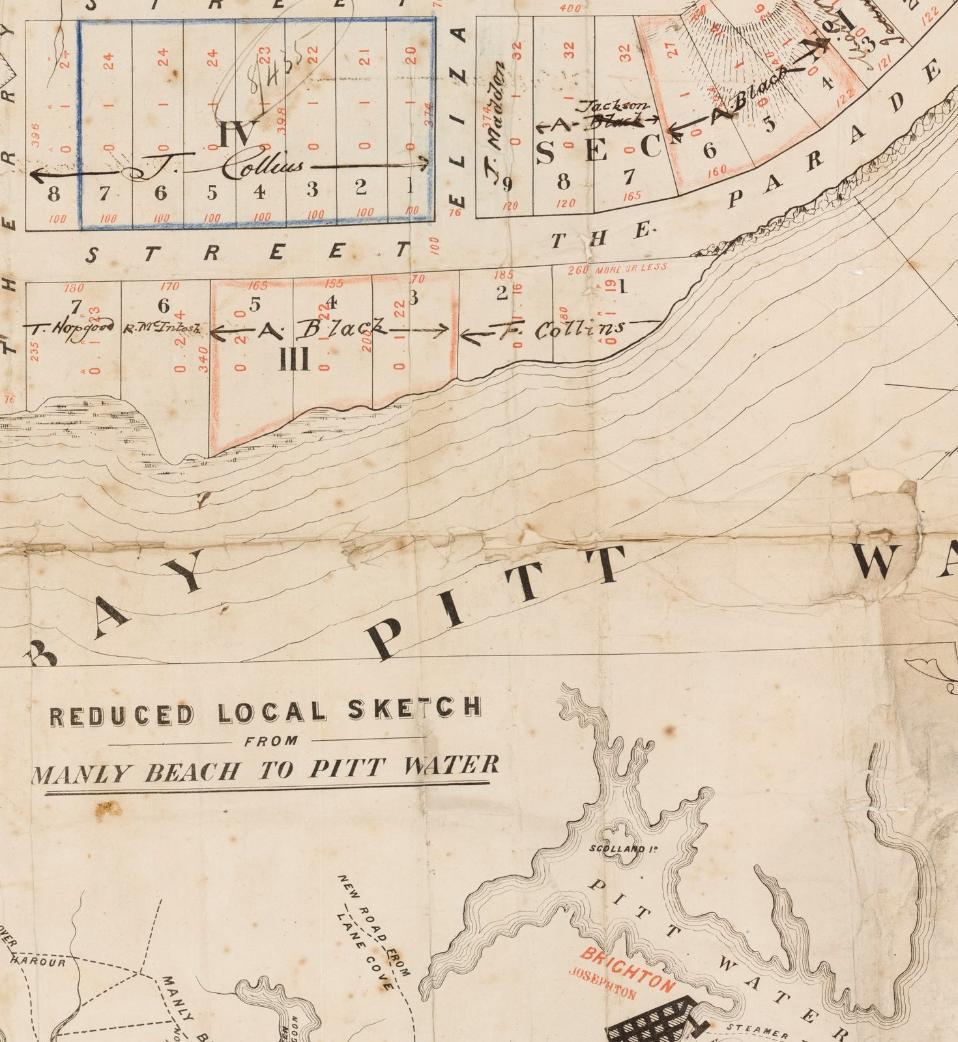
The first sale appears to have been to John Collins on 10 October 1872. [LTO Book 132 No. 924] Collins had built a cottage on Lot 1 of section XIII, which lot was bounded by John Street on the south, William Street on the west, and the creek on the north. He paid the trustees £5, but the value of the lot with its improvements was £40. The lot was to be conveyed to Hannah Andrews, the wife of John Andrews, in exchange for the Andrews’ 50 acres at the Basin, on the opposite side of Pittwater. [LTO Book 132 Nos. 923 & 924] Later, John Collins’ widow Honorah conveyed this land to her son, Patrick John Collins, on 28 September 1887. [LTO Book 372 No.284].
John Collins purchased Thomas Warner’s 50 acre grant at Stokes’ Point from George Green on 21 October 1870 for £70. On the same day he sold it to the Revd. Joseph Dalton, one of the trustees of Therry’s will, for £100. [LTO Book 121 Nos.729, 730].
John Collins also purchased twelve lots in the Brighton (Josephton) subdivision, totalling approximately 4¾ acres, for £12 on 2 December 1880. [LTO Book 212 No. 345] On the same day his brother Frank purchased three lots for £9. [LTO Book 212 No. 346].
Sales may have been slow, for a further advertisement appeared in the Herald on 9 and 12 May 1881 advertising a sale by auction. At this auction, on Monday 16 May 1881, Collins’ farm, consisting of Block III (128acres 1r.34p.) and Block IV (65 acres 0r. 32p.) of the North Division of the estate, were sold to Gustave Adolphe Lix, farmer, for £1018 10s 8d. [LTO Book 313 No. 217].
Lix offered Collins’ homestead buildings for use as a school in June 1882. In January 1885 Lix appointed an attorney, and went overseas. By 16 May 1885 he had paid £250 of the purchase money, the balance owing to the trustees being £866 6s. 0d. On 29 June 1885 Lix’s attorney sold the farm to Josef Kretschmann, Professor of Music, for £1162. [LTO Book 313 No. 216]
Robert McIntosh junior bought three lots at Brighton (Josephton), Careel Bay, for £9 on August 18th, 1873. Robert also held grants of land on Foley’s Hill, on each side of present Mona Vale Road. His grant of 100 acres now contains Katandra Bushland Sanctuary. [LTO Vol. 87 Fol. 63] On the other side of the main road he had 26 acres. [LTO Vol. 232 Fol. 239] - [2.]
In April 1880 land sales and unsold portions are listed as:
PITTWATER. VALUABLE AGRICULTURAL & GRAZING' ESTATE. in area about 2000 ACRES. Subdivided, into FARMS, SUBURBAN BLOCKS, and VILLA SITES, as per Lithographs. It is bounded on the east by the PACIFIC OCEAN, on the west by the BEAUTIFUL Bay of PITT WATER, on the SOUTH partly by a GOVERNMENT RESERVE and FARRELL'S FARM, and on the north by the BASSETT DARLEY PROPERTY. The Estate, as regards quality of soil, it is equal to any other in this rapidly improving and truly attractive district. It is 14 miles distant by a good road from the PIER at MANLY BEACH, and only 2 1/2 miles from Custom-house Station at BARRENJOEY. Also, THE UNSOLD PORTIONS OF THE TOWN OF BRIGHTON.
RICHARDSON and WRENCH have received instructions to sell by public auction, at the rooms, Pitt- street, Sydney, on MONDAY, 3rd May, at 11 o'clock, THE PITTWATER ESTATE, subdivided as follows:
NORTH DIVISION. FIVE CHOICE FARMS. No. I., area 104a. Ir. 22p. II., ditto 76a. 2r. 30p. III., ditto 128a. lV. 34p. IV., ditto 6oa. Or. 32p. Each of these have frontages to the Pacific Ocean and the main road to Barrenjoey. On Lot III. is the Homestead and Residence now in the occupation JOHN COLLINS, Esq., and also the Celebrated Cave. No. V., area 61a, 3 v. 32p., has frontage to the Central Road which passes from the coast-line to Pittwater, crossing the main road at the' Recreation Reserve.
Nos. 1 to 21 are SUBURBAN BLOCKS and VILLA SITES, surrounding the TOWNSHIP of BRIGHTON, in areas from 2 ACRES 3 ROODS 35 PERCHES, to 18 ACRES 3 ROODS 3 PERCHES, having frontages to MAIN PITTWATER ROAD and other ROADS and STREETS, all one chain wide 22, a Farm of 38a. 3r. 37p. on the CENTRAL ROAD, about midway between PITTWATER and the OCEAN.
SOUTH DIVISION. No. I., area 63a 3r. 12p. fronting the coast and the main road. On this lot is the COAL BORE, 400 FEET DEEP. Nos. II., III., IV., and V.— 4 FARMS, areas from 63 ACRES 3 ROODS 38 PERCHES to 101 ACRES 3 ROODS 37 PERCHES, having frontages to the MAIN PITTWATER ROAD, the CENTRAL ROAD, and OTHER ROADS.
Nos, 1 to 8, and Nos. 1 A to 8a.— 16 CHOICE VILLA SITES in PITTWATER fronting LONG BEACH ; areas from 4 ACRES 3 ROODS 8 PERCHES to 17 ACRES 27 PERCHES.
Nos. 9 to 15. — 7 Small FARMS in REFUGE COVE, SOUTH BEACH and SALT-PAN COVE, PITTWATER ; areas, from 9 ACRES 2 ROODS 2 PERCHES to 25 ACRES 1 ROOD 6 PERCHES.
16 to 25.— 10 Small FARMS in CABBAGE-TREE VALE, on BILGOLA BEACH. Areas from 5 ACRES 2 ROODS 36 PERCHES to 21 ACRES 1 ROOD.
No. 26. — A Small FARM fronting the RECREATION RESERVE on OCEAN BEACH. Area, 12 ACRES 3 ROODS 8 PERCHES. TOWN OF BRIGHTON. THE WHOLE of the UNSOLD LOTS of this TOWNSHIP. Areas from 1 ROOD to 1 ACRE, in CAREEL BAY, at the STEAMERS' WHARF.
This subdivision is. well worthy of attention, as there is not the shadow of a doubt that PITTWATER ; will become an important, and attractive resort; for our BUSINESS MEN requiring CHANGE, QUIET, and REST from the busy turmoil of the CITY. THE COMMUNICATION between the city and Pittwater is now more frequent than formerly. Besides having the COACH DAILY from MANLY BEACH, there are now COMMODIOUS STEAMERS PLYING REGULARLY throe days per week, via,, TUESDAY, THURSDAY, and SATURDAY, FROM THE CIRCULAR QUAY, at a quarter-past 7 a.m. NOTE THE LIBERAL TERMS: ONE QUARTER CASH DEPOSIT, and the residue in 3 years from day of sale, interest, 6 per cent, per annum, payable quarterly. A large auction plan of the subdivision is now in course of completion, and will be for inspection in a few days, at the rooms, Pitt-street, and LITHOGRAPHS are now ready for distribution.
Messrs. ELLIS and MAKINSON, Elizabeth- street, are solicitors of the vendors. A large sum of money has been voted by the Government to complete the main road, which passes through the above estate, from Manly to Careel Bay, at the town of Brighton, Pittwater. Advertising (1880, April 24). Freeman's Journal (Sydney, NSW : 1850 - 1932), p. 11. Retrieved from http://nla.gov.au/nla.news-article133487003
On May 3rd 1880, Richardson and Wrench offered the Therry estate, as they did again the following year:
PITTWATER and CAREEL COVE.
The whole of the residue of
THE PITTWATER ESTATE.
Also,
STOKES POINT, which is now subdivided into VILLA SITES, fronting CAREEL COVE
and PITTWATER.
adjoining the Township of BRIGHTON, PITTWATER.
RICHARDSON and WRENCH have received instructions to sell by public auction, at the Rooms, Pitt-street, on MONDAY, 16th May, at 11 o'clock, The whole of the unsold lots of
THE PITTWATER ESTATE, as follows :
NORTH DIVISION.
TWO CHOICE FARMS.
No. III. Area. 128 ACRES 1 ROOD .14 PERCHES, having frontages to the PACIFIC OCEAN and the MAIN ROAD to BARRENJOEY, on which is the HOMESTEAD and, RESIDENCE now in the occupation of JOHN COLLINS, Esq.. and also the CELEBRATED CAVE.
No. IV. Area, 65 ACRES and 32 PRRCHES, adjoining the above, and which are the WELL-KNOWN SPRINGS.
SUBURBAN SITES.
Nos. 8 to 16 and 10 and 20, surrounding the TOWNSHIP OF BRIGHTON, in areas from 2 ACRES 3 ROODS 35 PERCHES to 9 ACRES 3 ROODS 10 PERCHES, having frontages to the MAIN PITTAVATER ROAD and other roads and streets, all 1 chain wide.
Nos. 1A and 2A. Areas. 5 ACRES 3 ROODS 21 PERCHES and 7 ACRES 34 PERCHES respectively, overlooking PITTWATER.
SOUTH DIVISION.
Nos. IV. and V. TWO FINE FARMS, areas 97 ACRES 3 ROODS 17 PERCHES, and 91 ACRES 2 ROODS 9 PERCHES respectively.
No. VI. A FARM of 127 ACRES 3 ROODS 29 PERCHES, near SALTPAN COVE and the TOWNSHIP of NEWPORT.
Lots 5 to 8 and 5A to 8A. EIGHT CHOICE VILLA SITES in PITTWATER, fronting LONG BEACH ; areas from 4 ACRES 2 ROODS 10 PERCHES to 17 ACRES 27 PERCHES.
Lots 9 and 11. TWO SMALL FARMS in REFUGE BAY; areas. 25 ACRES 1 ROOD 6 PERCHES, and 11 ACRES 1 ROOD 24 PERCHES.
Lots 16 to 21, and 24 and 25. S GRAND BLOCKS of RICH SOIL in CABBAGE-TREE VALE, on BILGOLA BEACH : areas, from 5 ACRES 2 ROODS 36 PERCHES to 21 ACRES 1 ROOD.
Lot 26. A SMALL FARM, fronting the RECREATION RESERVE on OCEAN BEACH ; area, 12 ACRES 3 ROODS 8 PERCHES.
STOKES' POINT, PITTWATER.
ADJOINING THE TOWN OF BRIGHTON, AT THE STEAMERS WHARF.
The whole of this Magnificent Point will be submitted in lots, as per lithograph, now published, viz..
Section A. 15 VILLA SITES; areas. 3 ROODS 17 PERCHES to 2 ACRES 20 PERCHES.
Section B. 14 VILLA SITES : areas. 1 ACRE 10 PERCHES to 6 ACRES 3 ROODS 32 PERCHES
Section C. 9 VILLA SITES. CAREEL BAY ; areas. 1 ACRE 3 ROODS 34 PERCHER to 4 ACRES 21, PERCHES
Section D. WATER FRONTAGE SITES; areas. 2 ACRES to 4 ACRES 21 PERCHFS. PITTWATER HARBOUR
Section E. 10 VILLA SITES, adjoining the TOWN OF BRIGHTON : areas. 1 ACRE 11 PERCHES to 4 ACRES 1 ROOD 23 PERCHES.
This subdivision is well worthy of attention, as there is no doubt that PITTWATER will become an important and attractive resort for our BUSINESS MEN requiring CHANGE OF AIR, QUIET, and REST from the busy turmoil of the city.
The communication between the city and Pittwater is now more frequent than formerly, besides having the coaches daily from MANLY BEACH, there are now commodious fast steamers plying regularly from the city.
The NORTHERN RAILWAY will pass within 7 miles of CAREEL COVE at Pittwater.
TERMS EXCEEDINGLY LIBERAL AT SALE.
LITHOGRAPHS are now READY FOR DISTRIBUTION.
Messrs. ELLIS and MAKINSON, Elizabeth-street, are Solicitors of the vendors. Day of Sale, MONDAY NEXT. Advertising (1881, May 12). The Sydney Morning Herald (NSW : 1842 - 1954), p. 9. Retrieved from http://nla.gov.au/nla.news-article13479502
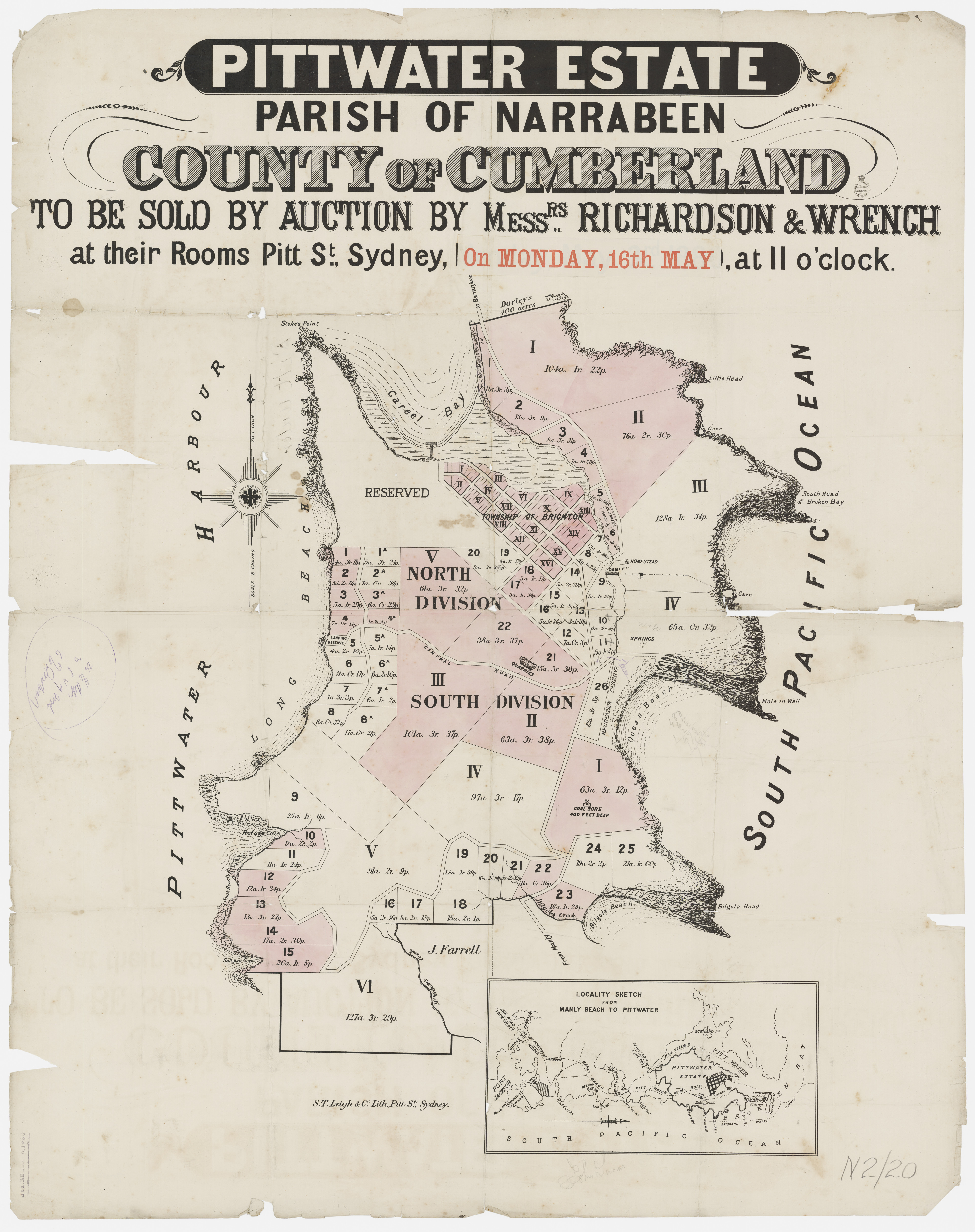
Pittwater Estate Monday May 16th, 1881 - Richardson and Wrench - Item c050370020, courtesy State Library of New South Wales.
A few more insights regarding the above advertisement:
In the recently published biography of the late Archpriest Therry, the founder of the Roman Catholic Church in Australia, reference is made to the early history of the Hunter River, with which the noted cleric was very familiar. The book is the work of the Rev. B. M. O'Brien, Professor of Australian History in St. Patrick's Ecclesiastical College, Manly, and from this the following' extracts are taken:
"But for the Pittwater settlement he had greater ambitions than mere agriculture. The coal seams that were being worked with success at Newcastle were supposed to continue through to the Illawarra, and it was possible that Pittwater might be n 'the route.' Accordingly he set about coal-mining. His nephew recalls with some indignation that although there were many good Irishmen unemployed In Sydney, his uncle employed Germans and Italians. at the mine. Many men were engaged and the expenses mounted high, whilst the existence of coal still remained problematical. After Father Therry's death the trustees continued the work, in the hopes of finding a rich seam. Father Dalton, one of the trustees, wrote to his solicitor on October 8, 1877: 'We care fully perused the coal mine lease, and have signd it also. We have perfect confidence in your judgment.'
'In the next month he asks: 'How is the coal mine getting on? Any royalties yet?'
In 1880 the advertisement for the sale of the estate states that on one subdivision there is 'The Coal Bore, which Is 400 feet deep.' The coal mine proved a failure. At the end of 1862 Father Therry contemplated selling the Pittwater Estate, The scheme of sub division was again ambitious. Mr. Elyard, the Surveyor, recommended that 'a sufficient portion may be reserved near the water, and possessing the sea breeze, for public gardens and games, and also sites for a school of arts, library, courts of justice, and Christian churches .. .
" The plan of subdivision was to be called Josephton, and the township Brighton. The land was sold in May, 1880. The city of Brighton and diocese of Josephton may come In the future. EARLY HUNTER HISTORY. (1922, April 29). Newcastle Morning Herald and Miners' Advocate (NSW : 1876 - 1954), p. 5. Retrieved from http://nla.gov.au/nla.news-article140991124
An insight from one who visited the area following an a friend purchasing land in that 1880 land sale:
A TRIP TO PITTWATER.
Some friends of mine having purchased part of the Pittwater estate recently offered for sale, were anxious to see the land, and they invited me to accompany them. Saturday last was fixed for the trip. On that morning we were all up betimes. The night before we agreed that whoever rose earliest should call the others. Being known to rise on the first sound of the ' cock's shrill clarion,' I was expected to rouse my friends. At 5 o'clock when I went to do so I found that one of them had been up two hours, the others even longer. They had evidently worried themselves into wakefulness all night, for which there was no necessity, as a late sleeper might catch the first Manly boat, by which we were to leave Sydney. Saturday morning broke in smiling silence on the city and suburbs: it was one of those mornings which call forth praise and prayer to heaven for the blessing of such a climate as we enjoy in this Southern land. The waters of the harbour from our point of view (the heights of North Shore)looked like several lakes which were as calm as millponds. Our unrivalled harbour, it appears to me, presents scenes at, daybreak and by moonlight that cannot be viewed at any other time.
In summer mornings, before the sun rises, you may see creeping over the waters of its various nooks and bays gauze-like exhalations, which magnify the ships and boats in the stream. On the appearance of the great, vaporizer the mist is dispelled and the grand picture we all admire is unveiled. The nocturnal beauty of Port Jackson one never ceases to admire. Music only is wanted to make a moonlight view of it one of the most pleasurable sensations. Another harbour, pre-eminent for its capacity and safety,' and no mean rival of our own is more blessed in this respect, for the melody of the Shandon Chimes supplies the void felt here. On this I ponder,
Where'er I wander,
And thus grow fonder,
Sweet Cork, of thee ;
Why thy bells of Shandon,
That sound so grand on
The pleasant waters
Of the river Leo.
On board the Royal Alfred we were joined by a young gentleman who was also a guest. There were not more than half-a-dozen other passengers besides our party. Some of them looked sleepy and sullen, and appeared as if they had parted on bad terms with Morpheus. One of them who was late had to jump on board. The unamiable mood in which he appeared soon gave way to perfect equanimity, the effect, as one observed, of the soothing influence of the incense from the North Shore gums.
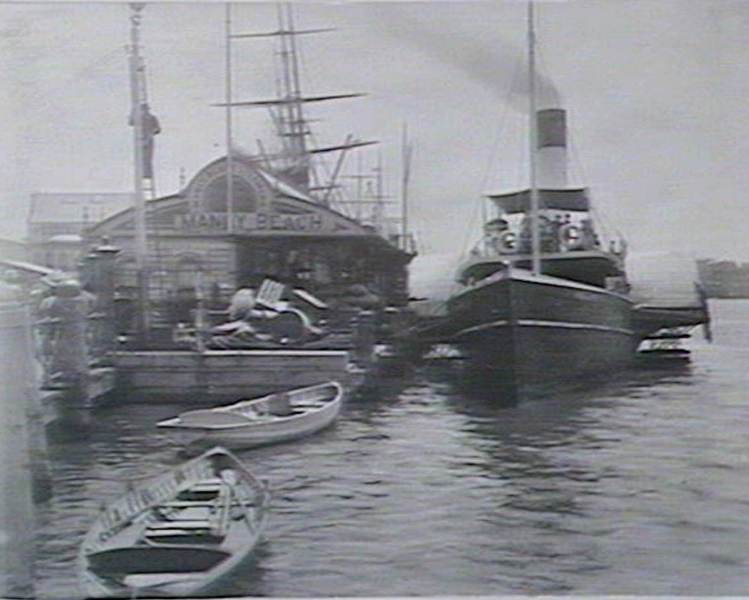
"Royal Alfred" at wharf Circular Quay, date; 9/1935 (?!), Image. No: d1_20453, courtesy State Library of NSW.
Arrived at Manly, we had an appetite for breakfast which many might, envy. This watering place reminds one of Passage, which Father Prout describes as situated
Upon the say;
'Tis nate and dacent,
And quite adjacent
To come from Cork,
On a summer's day.
The 'trap' which was awaiting us at, the hotel door, and which had been bespoken, was certainly not one of Kearey Brothers'. It had the appearance of a disused milk-cart., or a superannuated costermonger's conveyance. Our young companion did not like the look of it, but on being told there was no other available for our journey, he had sufficient of the Stoic in him to sink his personal feelings. Needs must when a Manly coach proprietor commands the drive to Pittwater. There is nothing very charming in the neighbourhood of the Pittwater road from Manly. Ducks and water fowl might find it a suitable abiding locality, but Manly-ites, if they have any regard for the future repute of their rising suburb, will extend it on the higher ground Spitwards.
Some four or five miles out of the township we overtook the 'royal mail coach' with its convoy conveying the mails and passengers to Boulton's or Newport at the head of the navigation of the Pittwater harbour. We sailed alone in this company until we crossed the Narrabeen Lagoon. As we emerged there from we descried a church, which appeared to be as well supported as the Smithy described in one of Swift's anecdotes. Seeing no residents around, we inquired where the congregation came from, but our Jehu was not a Matt Ryan. Indeed he was the most taciturn ' whip ' I ever travelled with.
Shortly after we entered upon the estate at Bilgola beach, where there is a deep leafy glen well adapted for the growth of bananas. On ascending to Bilgola Head a splendid view of the coast from Cabbage Tree Head to Barranjoee is obtained. The broad Pacific lay on our right at that moment as placid as Farm Cove. A splendid valley lay before us with the homestead of the patriarch of Pittwater, Mr. John Collins, in the distance; on the left, undulating land, well timbered.
Descending to the valley, we crossed the farm purchased by Mr. Canty, which is believed to be carboniferous. Some years ago competent judges gave it as their opinion that coal existed there. A bore of four hundred feet, made in the ground many years ago, when an attempt was made to test it, passed through strata that indicated the immediate vicinity of the black diamond. Mr. Coghlan's diamond drill would soon settle the question whether coal could be struck there. Mr. Collins's farm is situated in the valley, being flanked on the east by St. Michael's Cave and the South Head of Broken Bay, and on the West by Mount St. Mary. After doing full justice to Mr. Collins's hospitality, we sallied forth under his guidance to survey that part of the estate in which we were interested. We directed our steps towards Long Beach, nearly opposite Scotland Island, Pittwater Harbour. The land improved as we receded from the valley. Indeed we were agreeably surprised at finding soil and slope not excelled by any locality we had seen on the coast, except Irishtown, Lane Cove. My friends were delighted with their investment, and were only sorry they had not purchased more of the land.
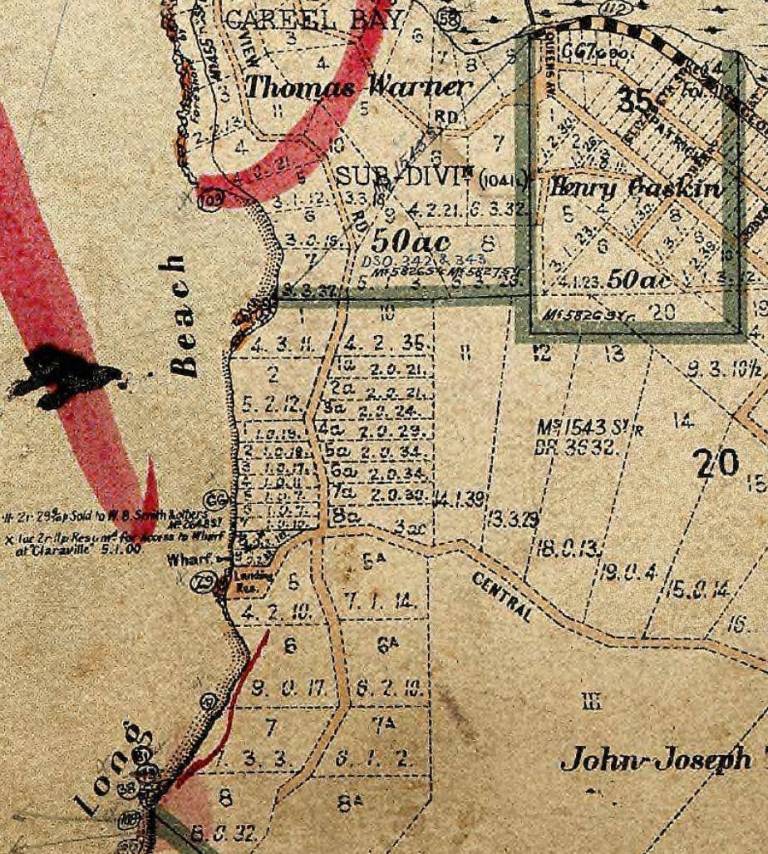
Pre- 1905 Land Titles Map - Showing 'Claraville' and 'Long Beach'. Courtesy Land Titles Office Historic records of NSW.
Pittwater estate belonged to the late Very Rev. Archpriest Therry, who bequeathed it to the Society of Jesus. It is surrounded on all sides save one by water; and it has been highly praised for its salubrity. It has a Catholic church, at which the Rev. Dr. Hallinan officiates once a month; it has also a Provisional school, attended by some twenty children. There is an incipient town called Brighton at Careel Bay, north-west of Barranjoee. The site is eminently unsuited for a township, and the sooner it is abandoned the better. A low swampy beach from which the water recedes at ebb tide, is not well adapted for settling on. A better site is that on the harbour higher up at Long Beach, where there is ‘ample room and verge ' enough, besides a moderately elevated coast and deep water. West Carbery, as we christened the place, is the site for a township.
A large block of land at Stokes's Point is reserved for a College. The scenery at Pittwater and on the greater part of the way thither is simply grand. When the road is better— (Mr. Collins informed us there is money on the estimates to form it all the way), and when a better style of conveyance is available, I know of no place or drive that will present so many attractions to the invalid, the pleasure or holiday-seeker. Everything conspires to quiet the anxieties of the mind and invigorate the body. Wooded slopes and deep ravines, picturesque views of ocean, beach, and headland, are features that would dissipate the megrims of a miser or restore peace to the mind of a rejected swain. Notwithstanding the discomforts we laboured under from the vile vehicle we had, we enjoyed the trip to and fro uncommonly well, and arrived at 7 in the evening at Manly without any mishap beyond that which a little application of Australian Ointment will remedy, as our young friend of bills and briefs said. CRUIG BARRY.11th May, 1880. A TRIP TO PITTWATER. (1880, May 22). Freeman's Journal(Sydney, NSW : 1850 - 1932), p. 19. Retrieved from http://nla.gov.au/nla.news-article133488037
The land sale of another large section, listed for auction on May 16th, 1881:
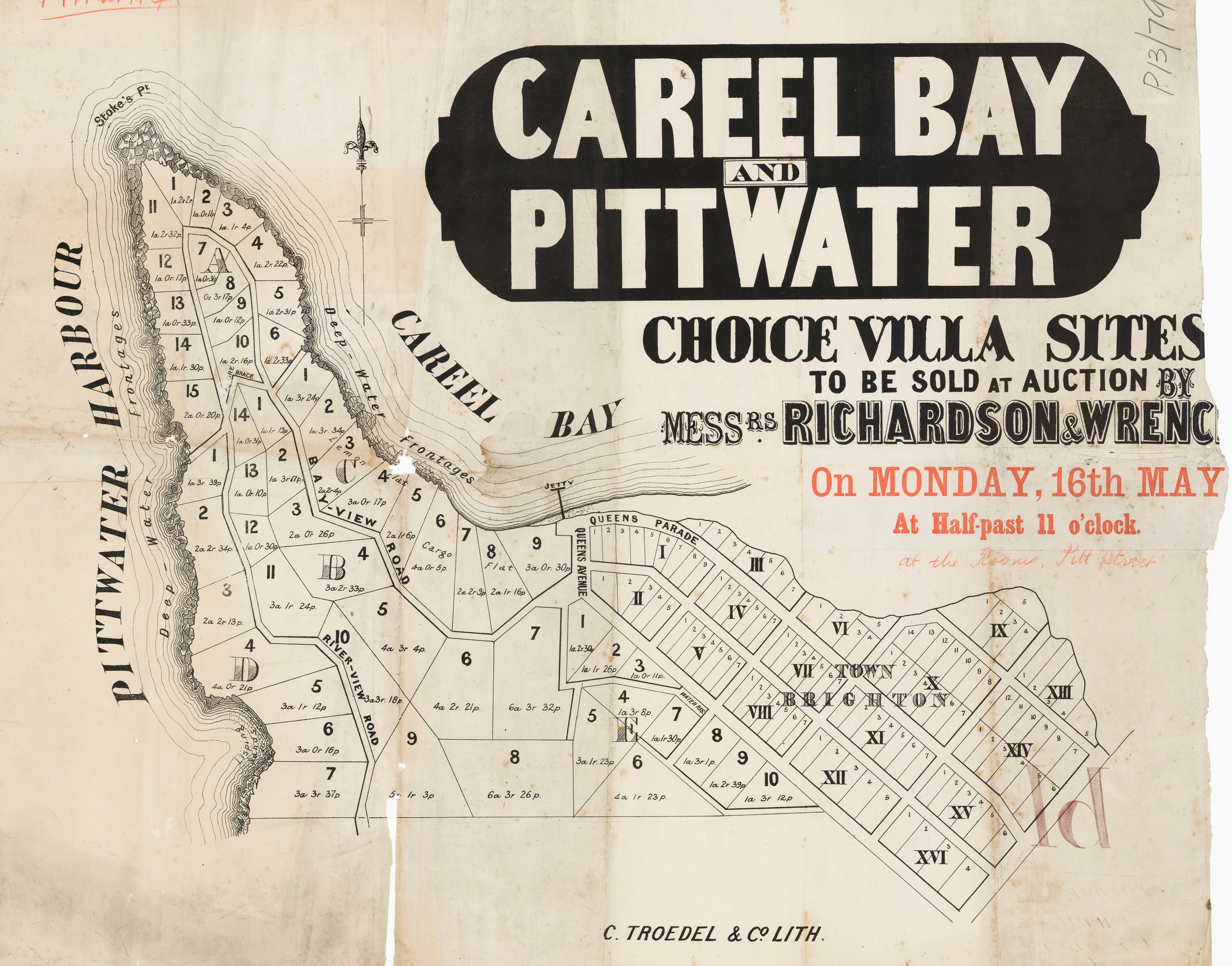
Careel Bay, May 16th, 1881. Land Sale - Item c053460085, from Pittwater Subdivisions folder, courtesy State Library of NSW
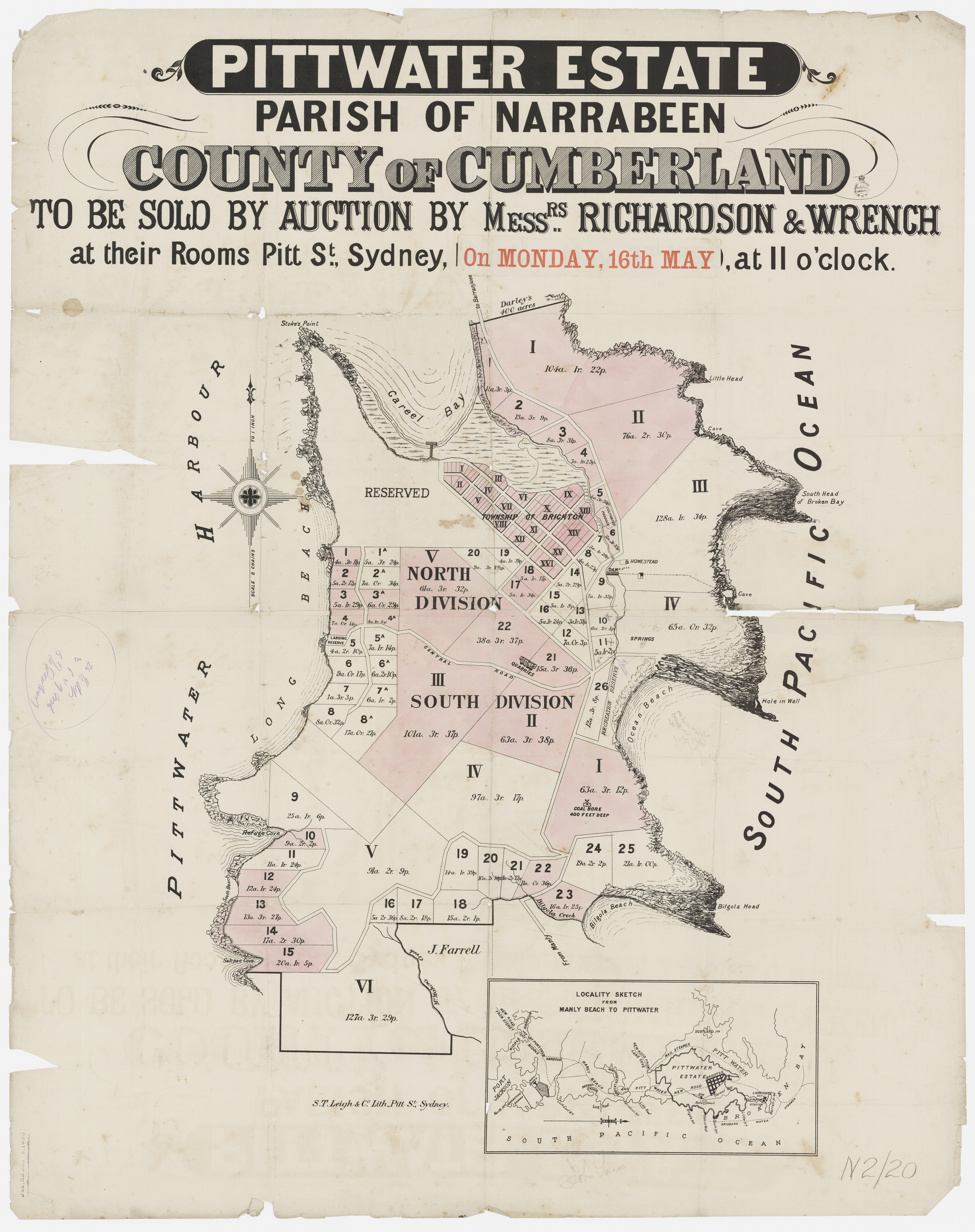
Pittwater Estate, Parish of Narrabeen, County of Cumberland - no boundaries shown, Item c050370020, courtesy State Library of NSW
Those who bought land, by May 1881, are listed as:
Pittwater estate, subdivision of Father Therry's grant, as follow., viz.:— Stokes Point: Lots 1 and 11, section A, in area 3 acres 0 roods 34 perches, L40 3s Id — Mr. I. J. Josephson, purchaser ; lot 15, section A, 2 acre 0 roods 20 perches, L24I 8s 9d ; lots 3 and 4, section A, 2 acres 3 roods 36 perches, L30 11s 7d — Mr. Francis ; lot 13. section A, 1 acre 0 roods 33 perches, L12 13 3d — Mr. S. Swain ; lot 14, section A, 1 acre 1 rood 30 perches, L15 Is 10d ; lot 12. section A, 1 acre 0 roods. 17 perches, LI1 12-5 4d — Mr. H. Solomon : lot 2. section A, I acre 0 rood 11 perches. Ll l It's 3d — Mr. I. J. Josephson ; lot 10, section A. 1 acre 2 roods Ifi perches, 1/22 S;— Mr. J. Cunningham ; lots 7 to 9, section A, 3 acres b roods 23 perches, L10 12s fid — Mr. F. Smith ; lots 5 and 6, section A, 3 acres I rood 21 perches, L10 Ills— Mr. .J. Cunningham.
Section B, lot 1 and 14, 2 acres 2 roods 4 perches, L22 Ms fid — Mr. R Symons ; lots 2 and 13, 2 acres 3 roods 27 perches, J/23 7s — Mr. J. Hodgson; lots 3 and 12, 3 acres 1 rood Ifi perches, LIS 8s fid— Mr. W. Waterhouse ; lot 4 and 1 1, 7 acres 0 roods 17 perches, L35 Km 7d — Mr. G. Harrison ; lots 5 and 10, 8 acres 2 roods 22 perches, L43 3s 3d — Mr. M. Bayley ; lot 7, 6 acres 3 roods 22 perches, L41 14s — Hon. J. Lucas ; lot 6,4 acres 2 rood 21 perches, L23 3 Id — Mr. A. Myers ; lots 8 and 9, 12 acres 29 perches. L48 14s 6d - Mr Francis
Section C : Lot 1, 1 acre 3 roods, 24 perches L57 19s; Lot 9 3 acres 0 roods 30 perches, l108 7s 6d - Mr. R. Symons; lot 2,1 acre 3 roods 34 perches, L37 5s 9d; lot 3 2 acres 2 roods 4 perches L44 3s 9d - Dr. Milford; lots 4 and 5, 5 acres 1 rood 23 perches, L80 18s 1d - Mr. W. Waterhouse; lot 8, 2 acres 1 rood 16 perches, L50 10s 6d; lot 6, 4 acres 0 roods 5 perches, L66 10s 4d - Mr. Francis, lot 7 , 2 acres 2 roods 9 perches L43 9s 1d - Mr. J. Blannie.
Section D: lots 5 to 7, 10 acres 1 rood 25 perches, L156 1s 10d — Mr. M. Bayley; lot 1. 1 acre 3 roods 33 perches, L2fi 1 8s .Jd ; lot 4, I acre 0 roods 21 perches, L5 1 12s 10d — Mr. Francis; lot 3, 2 acres 2 roods 13 perches, L25 lfis 3d — Mr. G. A. Shipley; lot 2, 2 acres 2 roods 31 perches. LSI 3s lOd — Mr. J. Blannie.
Section E, lots 4 and 7, 3 acres 0 roods 38 perches, L12 Is 8d — Mr. F. Grishrook; lot 8, 1 acre 3 roods 1 perch, Lll Is — Mr. F. Collins lots 3 and 10, U acres 2 roads 11 perches, L28 Ms ; lots 5 and fi, 7 acres 3 roods G perches, LIG Ms Gd — Mr, J. Waudels ; lot 1, J acre 2 roods 30 perches, L20 5s — Mr. J. Hodgson ; lots 2 and 3, 2 acres 1 rood 37 perches, L21 Ifis 3d— Mr. E. Fisher.
North Division : Lots 19 and 20, 14 acres 0 roods 14 perches, L66 18s 6d; lots 12, 13, 15, 16, 21 acres 0 roods 26 perches L53 3s Md— Mr. Francis; lot 14, 5 acres 2 roods 23 perches. L2211s 6d — Mr. H. E. Castle ; lot 8, 4 acre 1 rood 23 perches, L48 1 Is ; lot 7, 3 acres 1 rood 28 perches, L13 0 3d — Mr.R. Symons; lot 9, 7 acres 1 rood 35 perches, 1,21 fin' 5d — Mr. R. M'lntosh; lots 10 and 11,11 acres 3 roods perches, L35 7.s 3d — Hon. J. Lucas; lots 1a and 2a, 13 acres O roods 18 perches, L45 17s 10d — Messrs. Kearey Brothers.
Farms : Lot 3, 128 acres 1 rood 31 perches, with homestead thereon, L770 15s Gd — Mr. G. Lix ; lot 4, 65 acres 0 roods 32 perches, L247 15s 2d — Mr. F. Smith.
South Division ; Lot 5, 4 acres, 2 roods 10 perches, L3fi 10s; lots fi to 8, 27 acres 0 roods 12 perches, LI 50 3s — Mr. Jones; lots 5a to 8a, 37 acres 1 rood 13 perches, LMO fis fid — Mr. Francis; lot 11, 11 acres 1 rood 21 perches, L57 — Mr. J. W. Warren ; lot 9, 25 acres 1 rood 6 perches, L57 17s 11d— Dr. Milford; lot 26, 12 acres 3 roods 8 perches, L64 — Mr. C. E. Jeannerett; lots 16 to 21, 21 and 25, 103 acres 1 rood 17 perches, 1,310 Is 4d ; farm, L44 3s 3d— Mr. Francis; lot 22, 11 acres 0 roods 34 perches, L14 18s — Mr. Renwick. SALES OF PROPERTY. (1881, May 24). The Sydney Daily Telegraph (NSW : 1879 -1883), p. 2. Retrieved from http://nla.gov.au/nla.news-article238300369
‘In the midst of life we are in death' was sadly illustrated in the case of Mr. John Collins, of Pittwater, on Friday night, the 20th inst. Mr. Collins came up the Sunday before to attend the sale of the Pittwater estate, which took place on the 16th inst., his 66th birthday. From Monday to Friday he was making arrangements with a contractor for the erection of a cottage on one of his farms. Returning from Sydney on Friday evening by the half past 5 boat he fell overboard at Lavender Bay wharf, through, it is supposed, the bumping of the steamer against the piles. Owing to the noise of the engine the accident was not observed on the instant, and some short time had elapsed before Captain Butler, who has saved scores of lives from drowning, plunged in to the rescue. He soon brought Mr. Collins on board and proceeded with his steamer to Milson's Point, when he placed him in a cab which conveyed him to his brother-in-law's (Mr. Connolly), the Union Inn. Father Kennedy, S.J., and Dr. V. Browne were immediately in attendance, and both had strong hopes of his recovery until about 1 o'clock at night, when capillary bronchitis supervened. The deceased gentleman was an old colonist, having emigrated from Cork with his parents about 50 years ago. He was well known and widely respected, not only in Pittwater, where he was regarded as a patriarch, and where he resided for upwards of forty years, but also in the North Shore and in Sydney. He was a man of sterling principle, so fond of the right that he would not do wrong deliberately for a kingdom. He had a great contempt for the worldliness, avarice, and selfishness so characteristic of the present times, his own character being the very antipodes of these. On Monday morning a Requiem Mass for the repose of his soul was celebrated by Father Kennedy in the church of St. Mary Star of the Sea. The respect in which Mr. Collins was held was testified by the numbers of all classes who attended his funeral, which was the largest of any private funeral that has taken place here for the last twenty years. He leaves a widow, four sons, and a daughter, all, except one of the sons, living in Pittwater. May his soul rest in peace. ST. LEONARDS. (1881, May 28). Freeman's Journal (Sydney, NSW : 1850 - 1932), p. 10. Retrieved from http://nla.gov.au/nla.news-article115457523
The Collins stayed in Pittwater, now land-owners - Honorah moving to live with daughter Katherine at Bay View, who married another Irishman in Australia:
ROCHE—COLLINS.—April 18, at the residence of the bride's mother, Rockvale, by the Rev. Dean Hanly, James Joseph, youngest son of John Roche, Esq., County Cork, Ireland, to Katherine M., youngest daughter of the late John Collins, Esq., of Pittwater. Family Notices. (1883, May 24). The Sydney Morning Herald(NSW : 1842 - 1954), p. 1. Retrieved from http://nla.gov.au/nla.news-article13535436
E.F. asks-What the letters of the registered horse-brand are of J. Collins, of Josephton, Pittwater. How are they placed?-J over 4 for horses. £ over g for cattle. Answers to Correspondents. (1883, June 2). Australian Town and Country Journal (NSW : 1870 - 1907), p. 18. Retrieved from http://nla.gov.au/nla.news-article71000007
IRISH NATIONAL LEAGUE. A committee meeting of the Central Executive Irish National League was held at the Rooms, Kidman's Buildings, on Tuesday evening. There was a good attendance of members. Mr. Charles O'Neill, vice-president, occupied the chair. The secretary read correspondence received since last meeting, which included a letter from Goulburn, enclosing £50 for the Evicted Tenant Fund, and a letter from Buckley's Crossing, containing £18 17s,from Rev. P. Byrne, Hurstville, enclosing £1 Is, and from Mrs. H. Collins, Pittwater, £1. IRISH NATIONAL LEAGUE. (1888, December 1). Freeman's Journal (Sydney, NSW : 1850 - 1932), p. 9. Retrieved from http://nla.gov.au/nla.news-article115459904
See John Collins of Avalon and Katherine Mary Roche - Pittwater Matriarchs:
DEATH OF MRS. COLLINS.
Full of years spent worthily, Mrs. Honora Collins relict of the late John Collins, died on the 20th instant the residence of her son-in-law, Mr. J. J. Roche, Bay View, Pittwater. For more than half a century she had lived at Pittwater, and no family was better known or more highly respected than the Collins family of Careel Bay. Mr. and Mrs. Collins were natives of the County Cork, whence they emigrated 60 years ago. Soon after their arrival in the colony they settled on Father Therry's grant at Pittwater, where Mr. Collins engaged in grazing and farming. The district has always been a great health resort. Many an invalid from Sydney recruited his health at the hospitable homestead of the Collins family. The cottage was flanked by two hills, named Mount St. Joseph and Mount St. Mary by Mr. Collins. It is told of him that he would allow none of his sick guests to leave until he saw that they were completely 'on their legs,' his test for which was a given time to ascend and descend these hills before breakfast. The remains of the deceased lady were brought on the 21st from Bay View to St. Mary's, North Sydney, where Masses were said for the repose of her soul. The funeral took place at Chatswood Cemetery, the family burial-place, the same day. The chief mourners were Mr. J. Collins, of the Harbours and Rivers Department ; Mr. P. Collins (sons) ; Mr. J. J. Roche, son in-law; Messrs. J. T. and E. P. Swanson, nephews. Among others present were Mrs. Black, of Barrenjoey Customs Station ; Mrs. Midden, Mrs. Roche, Mrs. Earl, Mrs. Robertson, Mrs. F. Collins, Mrs. P. Collins, Messrs. D. J. Glacken, M'Teague, J.Wall, J. Crowley, H. Coyle, J. Macintosh, and Boulton. The Rev. Father Dowling, of St. Patrick's College, Manly, attended Mrs. Collins during her last illness, and officiated at the grave. May her soul rest in peace. DEATH OF MRS. COLLINS. (1897, October 30). Freeman's Journal (Sydney, NSW : 1850 - 1932), p. 16. Retrieved from http://nla.gov.au/nla.news-article115471628
In August of the same year another larger parcel, and a 4 acre lot are placed on the market:
Careel Bay
Grand subdivision Block of Land containing waterfrontage to the PACIFIC OCEAN, CAREEL BAY, PITTTWATER, And MAIN ROAD to BARRANJUIE.
W. PRITCHARD have received instructions to sell by auction, at his Rooms, 289 George-street, NEXT THURSDAY August 25, at 11 o clock, ALL THAT BLOCK of LAND, containing about 230 acres, being a portion of the PITTWATER ESTATE ~ This splendid block of Land is admirably situated for a subdivision on account of its numerous advantages, having the MAIN ROAD from Manly to Barranjuie running through it, and commanding water frontages to the PACIFIC OCEAN and CAREEL BAY. Plan at the Rooms. Title freehold. Terms at sale.
CAREEL BAY, PITTWATER.
4 Acres of LAND, fronting the main road leading to STOKES POINT, a short distance from the Jetty, having deep water frontage, and next to Mr. Renwick's property, being lot 6, section C, as per plan at the Rooms.
HARDIE and GORMAN will sell by public auction, at their Rooms, Pitt-street, at 11.00 o'clock, WEDNESDAY, 21st August, 4 ACRES, CAREEL BAY, PITTWATER, POSITIVE SALE. Advertising. (1881, August 18). The Sydney Morning Herald (NSW : 1842 - 1954), p. 10. Retrieved from http://nla.gov.au/nla.news-article13492770
Lot 6, section C on the 'Cargo Flat' was sold on the 1871 subdivision map to a ''Captain Spalding''. Mr. Renwick, who also bought land in the 1881 Land Sale, may have been Arthur Renwick, investing in land to realise future increases in value - as he was elsewhere in Sydney at that time and was known to be quite wealthy through lands investments and subdivisions of these, until he lost all his money investing in mines. As there is no 'Renwick' among the names listed as buyers on the first section of blocks sold in 1871, an indication of some parcels changing hands quickly is indicated - a little about the most prominent 'Mr. Renwick' of those years (NB: he was actually born in Glasgow, Scotland on May 30th, 1837 and arrived in Sydney in July 1841 with parents as bounty immigrants), followed by the most well-known Captain Spalding of that era, who was also investing in land and possibly allowing access to Careel Bay via the steamer wharf through his lands eventual on-selling to head off the same 'trespassing' sentiment expressed in the Freeman's Journal article of 1862 - :
Dr. Renwick, the New Minister for Mines.
In this week's issue (page 785) sf the .TOWN AND COUNTRY JOURNAL we have a portrait of Dr. Arthur Renwick, the new Minister for Mines, who on Wednesday last was returned unopposed for East Sydney, having vacated the seat through taking office. A brief sketch of his life and doings will, therefore be interesting. He is a native of this colony, and received his primacy education in some of the best Sydney private schools, after which, at the age of 15, he entered the Sydney University. Here he specially distinguished himself in the mathematical and natural science classes, ranking first in class in both in 1855, and taking the professors' special prize in chemistry. In 1857 he.graduated B.A., a special meeting of the Senate being held to confer it in order that he might at once pursue his studies in the science of medicine in the old country. He studied for five years in the best schools of medicine in Glasgow, Edinburgh, London, and Paris, obtaining many honours and prizes. Two days after obtaining his majority he was admitted M.R.C.S., Edin., and subsequently graduated M.D. in the Edinburgh University. He passed honourably all the tests, and was admitted F.R.C.S. just before leaving for Australia.
Since his return he has achieved success in public life. He occupies the positions of president 'of the Sydney Infirmary, president of the Benevolent Asylum, and vice-president of the Deaf and Dumb Institution. Dr. Renwick is a Fellow of the Sydney University, and gave £1000 to endow a "Renwick Scholarship'' of £50 per annum. He also gave the University £125 to enable it to purchase Leipsises' works on Egyptian Antiquities.
When Mr. Windeyer was made a temporary judge of the Supreme' Court, Dr. Renwick offered himself, and was returned by an immense majority. He gained general approbation for his energy and tact as Executive Commissioner for New South Wales at the Melbourne Exhibition. At the last general election Dr. Renwick was again returned, and has sat as one of the four members for East Sydney till the present time. He has been a constant supporter of the present Administration, and has considerable debating power. He has during the present Parliament introduced the Sydney Hospital Bill, the Schools of Anatomy Bill, and the Ad Sundem Degrees Bill, by means of the last-named of which there was a large accession of members at the last annual commemoration. Last week the Premier announced that the portfolio of Mines vacant by the resignation of Mr. Baker had been accepted by Dr. Renwick, and thus rendering his seat vacant, he offered himself for re-election, and on Wednesday last, as stated, was returned unopposed. The same evening he took the oaths and his seat in the Legislative Assembly, having entered on the active duties of his office some days previously.
Dr. Renwick was on Wednesday re-elected for East Sydney unopposed.
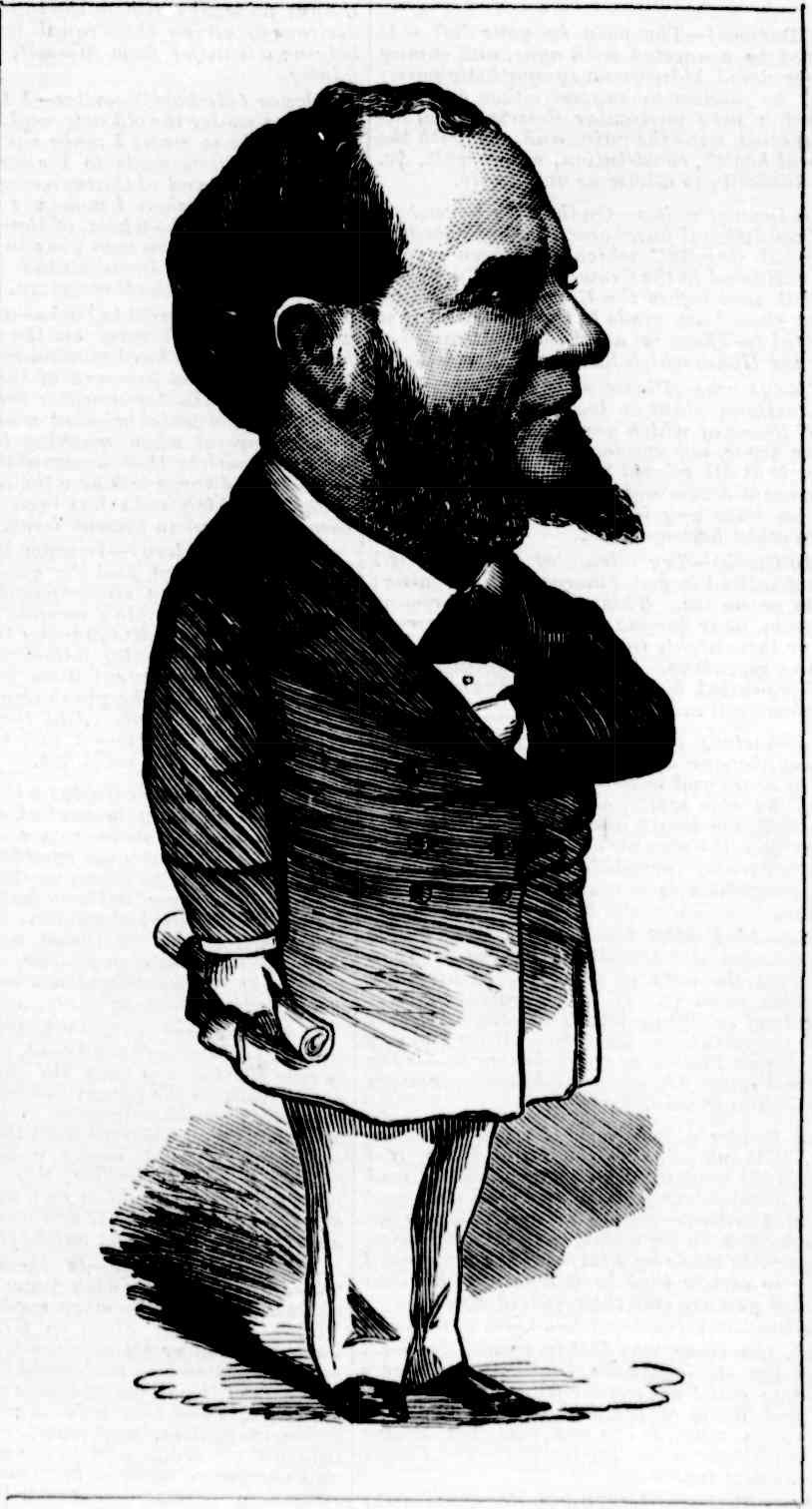
Dr. Renwick, the New Minister for Mines. (1881, October 22). Australian Town and Country Journal (Sydney, NSW : 1870 - 1907), p. 16. Retrieved from http://nla.gov.au/nla.news-article70961322
POPULAR COMMANDERS CAPTAIN F. SPALDING.
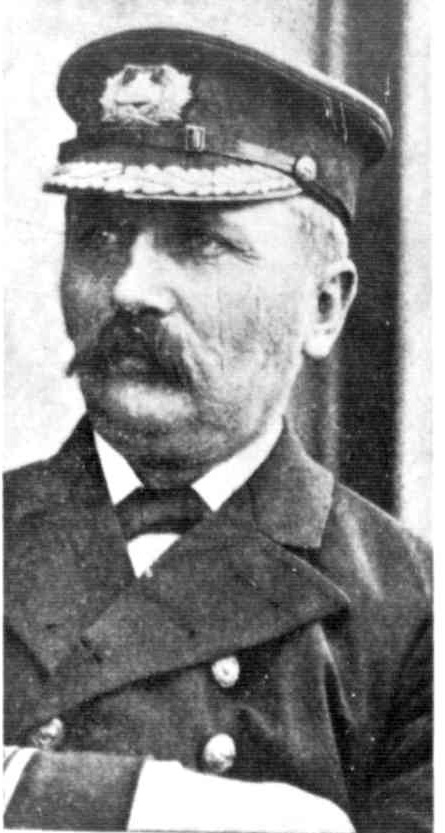
Popular Commanders : CAPTAIN T. F. SPALDING.
Thomas Fiddes Spalding, of the steamship Australasian, is one of many shipmasters who during their entire sea-going career hare been associated with the firm of George Thompson and Co., owners of the Aberdeen White Star fleet. Captain Spalding was born in Aberdeen. In 1867 he joined the Queen of Nations, in which Captain Simpson, of the new steamer Moravian, was then an apprentice. Spalding remained in the Queen of Nations for five years, during which time she was engaged in the trade between London and Sydney. Thence he went to the Ascalon, as second officer, and he afterwards tilled a like position on the barque Wave of Life, the Ascalon being sold to foreigners. Spalding became second officer of the Stratkdon, sold to Russian buyers some time since, and ultimately wrecked. He next spent three years as chief officer of the Smyrna, leaving her to take up a similar post on the Sophocles, on which he remained two years. Then, after serving six months as chief of the Patriarch, he was selected for command. The Samuel Plimsoll, Miltiades, Smyrna, and Aristides were in his charge, all these vessels being well known in the London and Australian trade, finally Captain Spalding succeeded Captain Simpson as master of the Australasian, with which steamship he has been identified for some years. He is of an exceedingly genial disposition, and a great favourite with passengers.POPULAR COMMANDERS (1899, September 16). The Australasian (Melbourne, Vic. : 1864 - 1946), p. 27. Retrieved from http://nla.gov.au/nla.news-article138607533
In July 1882 larger lots, including those along the Careel Bay frontage and current Whale Beach overlaps were advertised for sale:
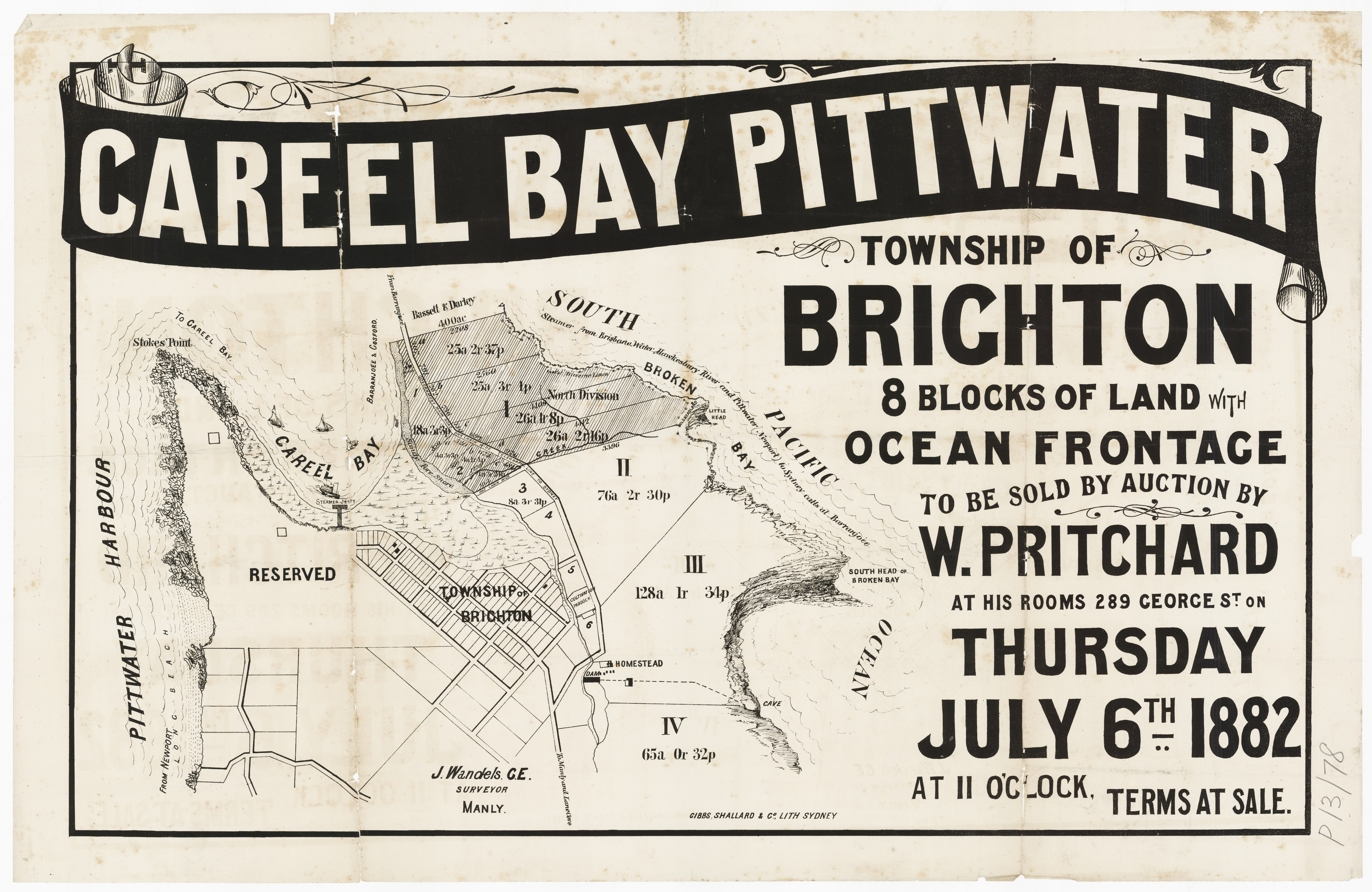
Careel Bay Pittwater [cartographic material] : township of Brighton, 8 blocks of land with ocean frontage 1882. MAP Folder 135, LFSP 2160 by Pritchard, W., courtesy National Library of Australia.
The Township of Newport, which had just been subdivided for sale around the hotel and school, is used as an association location in this advertisement - and all spruiked through that:
8 Magnificent Blocks of Land, NEAR NEWPORT.
THE PITTWATER ESTATE. IMPERATIVELY UNRESERVED SALE.
W PRITCHARD has the pleasure of announcing that he will, on THURSDAY, July 6 at 11 o'clock, offer for positive unreserved sale, at his Rooms, 280, George-street, The subdivision of about 250 acres of choice land, adjoining the TOWNSHIP OF BRIGHTON, and commanding grand frontages to CAREEL (or EVENING) BAY, from LITTLE HEAD to STOKES POINT and SOUTH PACIFIC OCEAN.
The land of rich soil, possesses DAILY STEAM COMMUNICATION and is on the MAIN TELEGRAPH ROAD, along which A COACH RUNS DAILY. Lithographic Plans have been prepared, and may be obtained at the Rooms of the Auctioneer. 289 George-street. Advertising. (1882, June 17). The Sydney Morning Herald (NSW : 1842 - 1954), p. 18. Retrieved from http://nla.gov.au/nla.news-article13513609
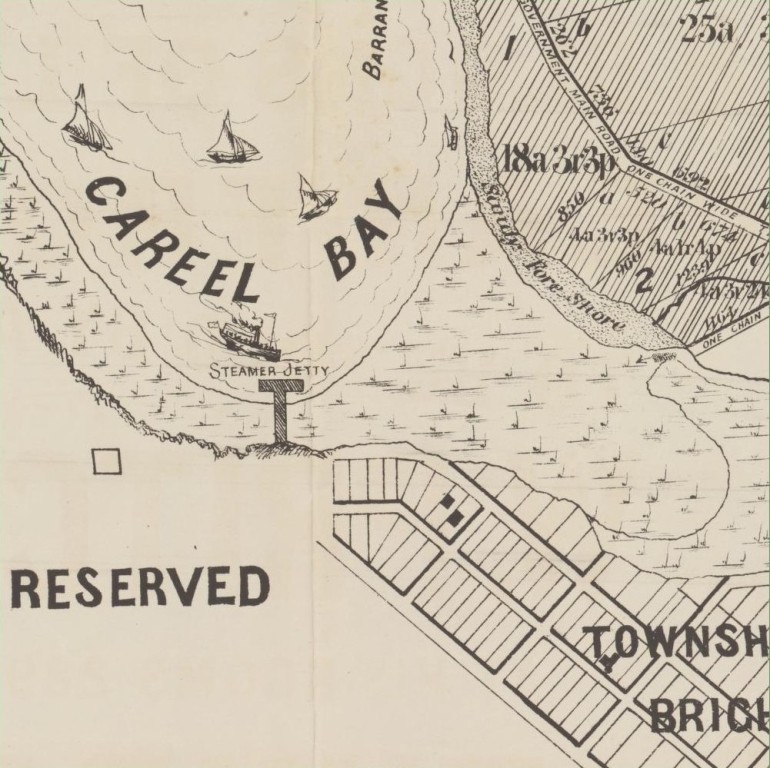
Enlargement from 1882 Lithograph showing placement of Steamer wharf access to land holdings
In 1894 a new wharf appears among the records and regular 'excursionists' trips to Careel Bay are taking place, although the inlet remained ostensibly a fishing hamlet with a handful of residents. The small 'sell' snippets recording these trips and the steamers who brought people here, also provide descriptions of the landscapes:
The Newcastle and Hunter- River Steamship Company’s report for the half-year ended 31st December shows … for depreciation there was a credit balance of £3082, including £76 brought forward. … Heavy necessary expenditure for repairs had had to be met. For the accommodation of excursionists two new wharfs had been erected at Cowan Creek and Careel Bay on the Hawkesbury and tributaries. MONETARY AND COMMERCIAL. (1894, January 25). The Sydney Morning Herald (NSW : 1842 - 1954), p. 7. Retrieved from http://nla.gov.au/nla.news-article13938624
BROKEN BAY.
A more perfect day than yesterday for an ocean excursion could not well be imagined, and consequently there was a large crowd of holiday-makers on each of the steamers making the ' outside ' trip. The Hunter 'River Company sent the well known paddle steamers Newcastle and Maitland to Careel Bay and to Newport respectively. The journey up the coast was in every sense an enjoyable one, and, strange though it may seem, not one case of mal-de-mer was reported on the outward journey, at least as far as the Newcastle's passengers were concerned ; and, as the Maitland followed close in her wake, there is no reason to believe that she made any 'bad weather.' Broken Bay was reached in good time for luncheon, and those of the excursionists who preferred picnicking to partaking of the excellent repasts provided by the caterers on the different boats, had no difficulty in finding shady places in which to unpack the sandwiches and boil the billy. About three hours ashore was allowed before the steamers' whistles shrieked out the warning signal for 'all aboard,' and shortly after 4 o'clock both steamers rounded Barrenjoey, the Maitland on this occasion having the lead, in consequence of the Newcastle having touched the mud in getting away from, the new wharf at Careel Bay. Sydney was reached shortly after 6 o'clock, the excursions having proved a complete success in every way. BROKEN BAY. (1894, January 2). Evening News (Sydney, NSW : 1869 - 1931), p. 3. Retrieved from http://nla.gov.au/nla.news-article114070810
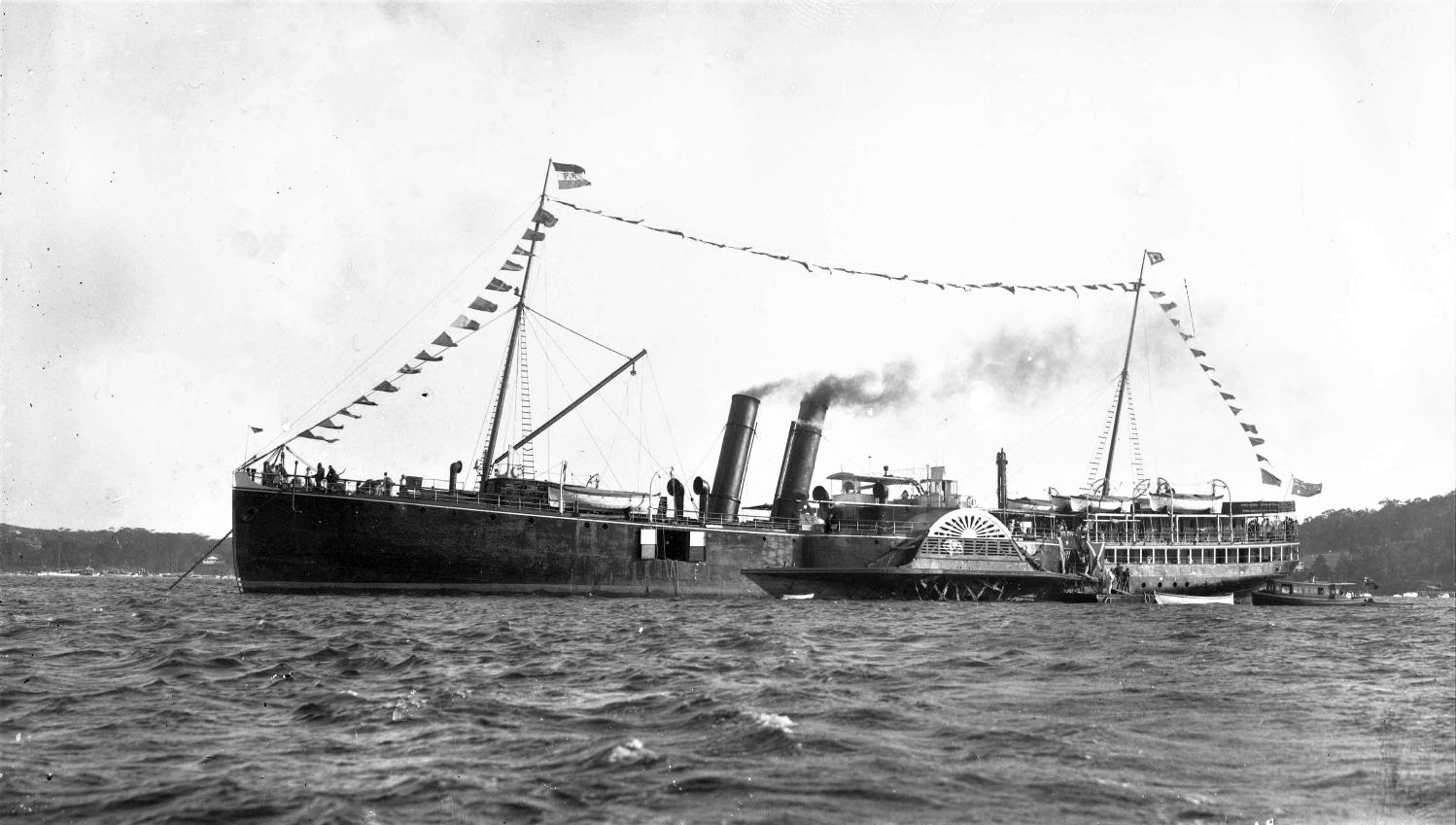
OCEAN EXCURSION.
The SS Namoi will leave the wharf foot of Market-street at 2o'clock tomorrow an will land excursionist at the new wharf at Careel Bay for about an hour. This spot has only just been opened up by the company but has already become a favourite resort on account of the scenery and as the weather appears favourable the Namoi will no doubt have her full complement of passengers. OCEAN EXCURSION. (1894, February 16). The Sydney Morning Herald (NSW : 1842 - 1954), p. 4. Retrieved from http://nla.gov.au/nla.news-article13940880
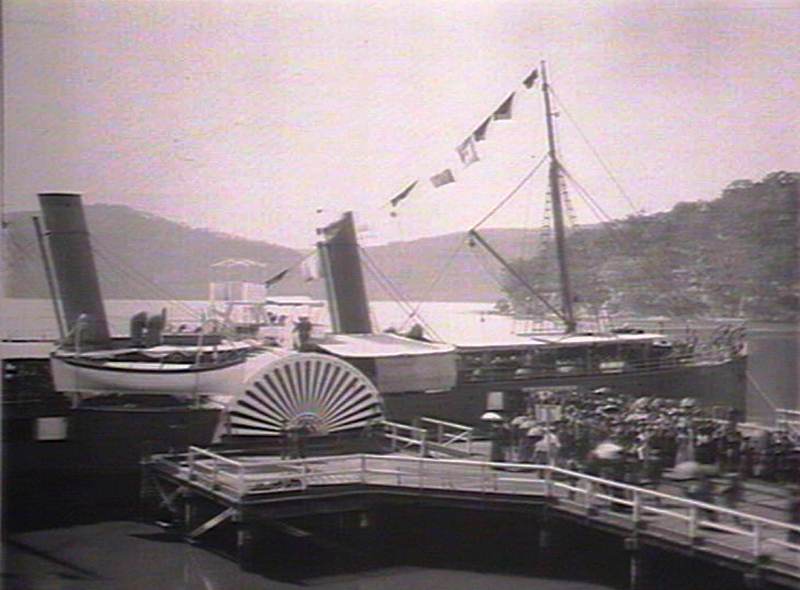
Federal Convention Picnic 1897.: "Namoi" at Hawkesbury River, Government Printing Office 1 – 09197, Courtesy State Library of NS
OCEAN EXCURSION TO CAREEL BAY.
The express excursion s.s. Namoi started on her well-known fortnightly excursion trip on Saturday afternoon to Careel Bay, Hawkesbury River, and had a favorable, run, during which time from the decks of the steamer could be seen the ocean yacht race in progress, and the views of the many changes in landscape, as point after point was reached.
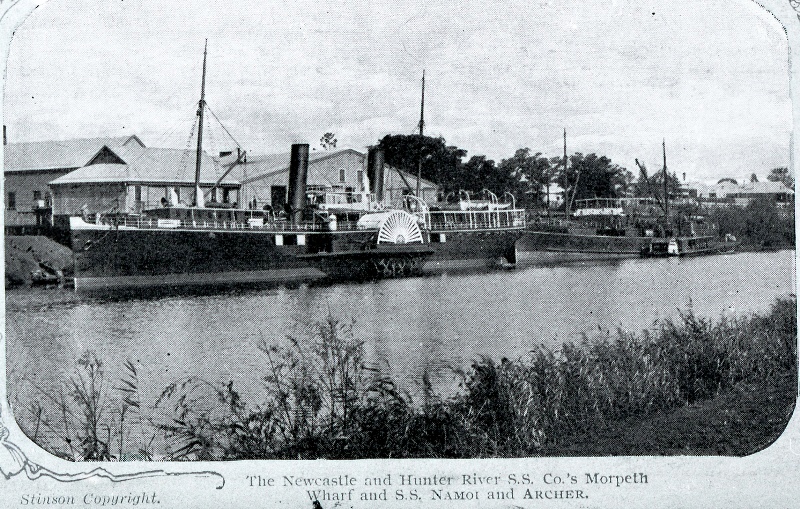
On arrival at Careel Bay an opportunity was afforded for an hour's ramble on shore, which was taken advantage of by a great number, who thoroughly enjoyed their stroll among the flora, ferns, palms and maiden hair, which were seen to grow in abundance on the hillside and grounds shelving to the water's edge. Others, again, went for oysters, which were in profusion, whilst some ancient fishers remained on board to ply the lino from the vessel's side, resulting in many of the finny tribes being lured from the ocean's depths to the fishermen's baskets. Careel Bay is essentially a fishing hamlet, if we can judge by the surroundings. The vessel was well found in every respect, and the creature comforts of her patrons were not in the slightest respect overlooked. The catering, as usual, was first-class. Awnings wore run up fore and aft, and seating accommodation amply provided for. Selections of music by the band at intervals enlivened the journey. The adverse weather of the last few days, bringing with it sundry squalls of rain, could not be otherwise than expected, but, despite this, the trip well repaid those who patronised it. OCEAN EXCURSION TO CAREEL BAY. (1894, February 19). The Australian Star (Sydney, NSW : 1887 - 1909), p. 3. Retrieved from http://nla.gov.au/nla.news-article227219125
It should come as no surprise with the volume of passengers being brought to this wharf that it needed some repairs:
Harbour and River Works -Repairs to wharf and approach at Careel, Pittwater, George Lawson, Balmain, schedule works. PUBLIC WORKS TENDERS. (1899, April 18). The Sydney Morning Herald (NSW : 1842 - 1954), p. 3. Retrieved from http://nla.gov.au/nla.news-article14209738
George Lawson was a Macleay River resident and third son of Christopher Lawson. Both are listed as shipwrights at Frederickton, Murwillumbah. George Lawson, who married Emily Ann Cheers in 1871, went on to have 11 children. He was renowned as a wharf and bridge builder from at least 1895 and many of the major and minor wharves on our eastern coast were built by him, as a contractor, during the years from 1895-1904. Soon after winning the contract to build a public wharf at Newport where the pier had once been, he moved his family to Ewenton, the rambling historical residence in Balmain and is recorded as living there until 1905. One of his daughter's had her wedding reception here: SOCIAL. (1902, May 17). The Sydney Morning Herald (NSW : 1842 - 1954), p. 7. Retrieved from http://nla.gov.au/nla.news-article14461102
The Newcastle and Hunter River Steamship Company's excursions to the Hawkesbury River, Careel Bay, Pittwater, and Port Hacking receive a liberal patronage, and during the holidays increased arrangements will be made for the conveyance of intending excursionists. This afternoon the steamer Newcastle will be dispatched to the Hawkesbury from the wharf at the foot of Market-street. There will be a band to enliven matters on the journey, and refreshments may be had on board. The steamer will proceed to Cowan Bay, which is considered one of the most picturesque spots on the river. Here the company have made several improvements for the convenience of their patrons, who will have an opportunity of enjoying the natural beauties of this attractive site. Before entering the bay a view of Lion Island, Hawkesbury Bridge, Dangar Island, and Refuge Bay is obtainable. On Boxing Day there will be excursions to the Hawkesbury, Careel Bay, and Port Hacking, three of the most charming resorts to be had within a convenient distance from Sydney. Careel Bay is unquestionably the most picturesque part of Pittwater, and here the company have erected a substantial jetty, where excursionists will be landed for about three hours. AMUSEMENTS. (1899, December 23). Evening News (Sydney, NSW : 1869 - 1931), p. 3. Retrieved from http://nla.gov.au/nla.news-article113695241
Apart from these investors in land and excursionists Careel Bay remained a fishing hamlet with a small population with relatives through marriages at Church Point, Bayview and Little Mackerel or what we today call Currawong Beach. There were a large amount of shell middens still in the bay, so many in fact that they were still being dredged for in the 1930's, indicating this was a food place for the original inhabitants - as some of the marking on still present trees also indicate, and some species being known as 'food trees' that would flower or fruit in season annually, calling the eye of those who would feats on them on the tracks between the bush hills.
Careel Bay was also known as a safe sheltered harbour when and as a destination for those who have gone sailing:
Wreck of the Lena and Lilian. NARROW ESCAPE OF THE CREW.
A wire from Barranjoey states that the schooner Lena and Lilian, with a cargo of sawn hardwood, from Port Stephens to Sydney, put in Broken Bay at 2 o'clock on Sunday morning in a sinking condition. The vessel left Port Stephens on Saturday morning at 6 o'clock, with the wind southerly and sea moderate. During the day the wind set m from north-east, and at 10.30 p.m., when off Terrigal, the ship sprang a leak so bad that the pumps could not keep her free. She then ran for Broken Bay, and just reached Careel Bay when the vessel sank. She now lies on the beach with her deck awash. The schooner is owned by Mr. Wm. J. Bowles, and was built at Brisbane Water in 1885, and is of the following dimensions : Length, 58ft ; beam, 17ft 8in ;depth, 5ft 6in ; tonnage, 38 net. Wreck of the Lena and Lilian. (1893, December 18). Evening News (Sydney, NSW : 1869 - 1931), p. 7. Retrieved from http://nla.gov.au/nla.news-article112931747
The Lena and Lilian was a Rock Davis (Blackwell and Patonga) built schooner.
A deputation of net fishermen, not foreigners, but some of the steady men of Sydney Harbor, waited upon the Fisheries Commissioners last week to ask 'for the removal of the ban against certain kinds of netting on the Heads side of a line across from Grotto Point to Shark Reef in Sydney Harbor. They desire to secure a portion of the shoals of school fish which 'come into the harbor every year, and materially, strengthened their case by urging the non-allowance of sunk and mesh nets.- The latter are the nets which sportsmen have been so set against. They are immensely destructive of small fish and breeding grounds, and can he used anywhere— along rocks, round piers, &c. The men want to be 'able to catch some of the mullet, garfish, kingfish, and jewfish which come into the harbor, and they ask for the beaches at Manly, Watson's Bay, Parsley Bay, and Vaucluse for that purpose for part of the year. '.. As. the law now stands, the Commissioners, who would doubtless like to comply with the requests of these men, who are as far above dago netters as one can imagine, are 'In a bit of a fog’, but when the new Bill drafted by Mr. J; Want, . M.L.C., comes : into force, and the mesh and sunk nets are vetoed, there is every likelihood of their request being granted. One of the deputation pointed out that he had seen 500 small red bream taken in a sunk net in Careel Bay. The deputation asked what benefit had accrued to Port Hacking by its prolonged closure, and no one could answer them, for the fact remains, that the Port has been singularly scarcely supplied. FISHING NOTES. (1899, November 29). Referee (Sydney, NSW : 1886 - 1939), p. 9. Retrieved from http://nla.gov.au/nla.news-article121793281
YACHTING. CHRISTMAS CRUISE.
A number of the yachting fleet got underway last evening for the usual cruise to Broken Bay It is the intention of the Idina, Aoteana, and probably others to remain until the New Year. The Jess left her moorings yesterday afternoon. Excepting perhaps Thelma, Archina, and Meteor the majority will bring up in the lower reaches of the Hawkesbury, Refuge Bay and numerous other sung corners on Cowan Creek, will be visited, the Basin, Careel Bay, and Newport will each claim a few of the yachts. Yachtsmen should find a fairly good supply off fresh water in the creeks, fish are reported to be fairly plentiful, and with fine weather the visitors ought to have a pleasant time. Most of the smaller craft will be in evidence inside the harbour, where a few days may he pleasantly spent, with a certainty of getting back to town on the expiration of the holidays, no matter where the wind is from. YACHTING. (1899, December 23). The Sydney Morning Herald(NSW : 1842 - 1954), p. 12. Retrieved from http://nla.gov.au/nla.news-article14226263
A simple investigation of the owners of these yachts brings the Royal Sydney Yacht Squadron and the then owner of the Meteor, Dr. James Frederick Elliott of Elliott Brothers, Limited, was rear-commodore of the Royal Sydney Yacht Squadron in 1893-94 and 1900-02 and vice-commodore in 1902-04, and a director of the private company formed to buy the club's premises, Carabella, Milsons Point, in 1904. J F Elliott passed away in 1928 but two years prior to then purchased land at Careel Bay:
Primary Application - James Frederick Elliott 29 acres 11 roods 35 1/4 perches in Bay View & River View Roads & on Careel Bay & Pittwater in Parish Narrabeen County Cumberland Shire Warringah Volume 3952 Folio 98 Date range: 13/04/1926 to 23/12/1926 (From State Records of NSW).
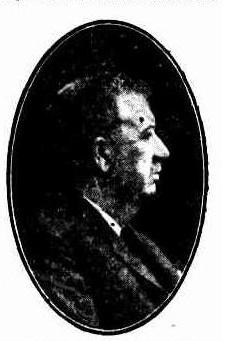 DR. J. F. ELLIOTT. DEATH IN SYDNEY. After an illness of a few months the death took place in Sydney on Sunday morning last of Dr. James Frederick Elliott, for many years chairman of directors and general manager of Elliott Brothers, Limited, Sydney and Brisbane. Dr. Elliott was a son of Dr. F. W. Elliott, one of the founders of the business, which has come to be one of the largest of its kind in the British Empire. After the death of the original Elliott Brothers the business was conducted by Mr. George C. Elliott, and the late Dr. J.F. Elliott, D.Sc, the former for many years being chairman of directors, during which time Dr. J. F. Elliott was managing director at the large chemical works and manufacturing laboratories at Balmain, Sydney. On the death of Mr. George C. Elliott, Dr. J. F. Elliott accepted the chairmanship of the company, and during the period of his control the business made very rapid strides. The doctor was one of the leading figures of the drug trade in the Commonwealth. His wide knowledge and versatility were generally recognised, and his business sagacity was availed of by many companies outside the drug trade, which he served in the capacity of director. His outside interests were many, and various. Of a naturally kind-hearted, sympathetic, and genial disposition, Dr. Elliott will long be remembered by a large body of loyal employees.
DR. J. F. ELLIOTT. DEATH IN SYDNEY. After an illness of a few months the death took place in Sydney on Sunday morning last of Dr. James Frederick Elliott, for many years chairman of directors and general manager of Elliott Brothers, Limited, Sydney and Brisbane. Dr. Elliott was a son of Dr. F. W. Elliott, one of the founders of the business, which has come to be one of the largest of its kind in the British Empire. After the death of the original Elliott Brothers the business was conducted by Mr. George C. Elliott, and the late Dr. J.F. Elliott, D.Sc, the former for many years being chairman of directors, during which time Dr. J. F. Elliott was managing director at the large chemical works and manufacturing laboratories at Balmain, Sydney. On the death of Mr. George C. Elliott, Dr. J. F. Elliott accepted the chairmanship of the company, and during the period of his control the business made very rapid strides. The doctor was one of the leading figures of the drug trade in the Commonwealth. His wide knowledge and versatility were generally recognised, and his business sagacity was availed of by many companies outside the drug trade, which he served in the capacity of director. His outside interests were many, and various. Of a naturally kind-hearted, sympathetic, and genial disposition, Dr. Elliott will long be remembered by a large body of loyal employees.
Until recent years Dr. Elliott made frequent and regular trips to Brisbane, but in consequence of the amalgamation of the Brisbane branch of Elliott Brothers, Limited, with Taylor and Colledge, Limited, which took place in 1924, his visits became less frequent. He still retained his connection, however, as a director of Taylors and Elliotts, Limit-ed, and also T. and E (Surgical),Limited. His widespread business interests left him with little leisure time, and this time he usually spent in boating, fishing, and other pleasures of an aquatic nature.
For many years his motor yacht, Ena, was prominent amongst the motor craft of Sydney Harbour. As chairman of Elliott Brothers, Limited, he will be succeeded by Mr. Victor G. Elliott, son of the late G. C. Elliott. Yesterday, from noon to 2 p. m., the Brisbane offices of Taylors and Elliotts were closed as a mark of respect to the memory of the late Dr. Elliott. The funeral took place yesterday. THE LATE DR. J. F. ELLIOTT. DR. J. F. ELLIOTT. (1928, September 11). The Brisbane Courier (Qld. : 1864 - 1933), p. 12. Retrieved from http://nla.gov.au/nla.news-article21355389
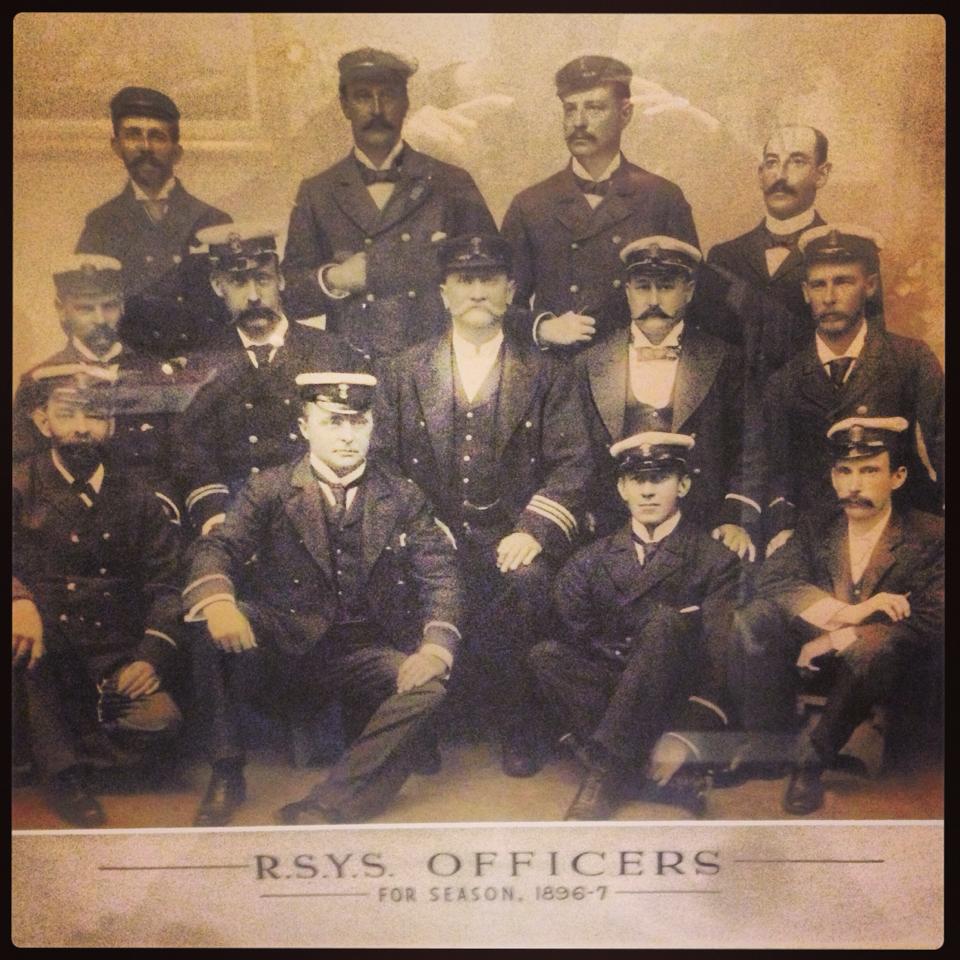
J F Elliott appears in the above image in back row, second from left (courtesy RSYS archives). The RSYS members, alike the foundation members of Pittwater's RPAYC and RMYC - Broken Bay, were captains of industry or at the top of their field. Sailing races to Pittwater, Pitt Water as a holiday destination were a clear and obvious choice - their Basin Regattas of the 1890's were popular among the local residents as they were included in them and there were good £ to be made if one won. Having a Pitt Water base was part of RSYS plans and moorings and the boatshed itself, once built, were theirs up until quite recently in terms of how long Careel Bay has attracted the yachting fraternity:
Pictorial: Yachtsmen took their wives, their children, and in some cases their dogs on the one-week 1970 Squadron Cruise arranged by the Royal Sydney Yacht Squadron. Boats sailed from Kirribilli to the RSYS base in Careel Bay, Pittwater, and during the week raced on Pittwater and on Lake Macquarie. Family outings included barbecues, which were held in the evenings after the racing. SQUADRON CRUISE. (1970, May 27). The Australian Women's Weekly (1933 - 1982), p. 11. Retrieved from http://nla.gov.au/nla.news-article48211884
Around 1917/1918 Dr. Elliot built 'Marara' - a property and house still in existence on Careel Bay.
Tenders called for... Hawkesbury River — Residence, Careel Bay Undated — E. R. Orchard. 684 Pitt Street. Advertising. (1918, June 10). Construction and Local Government Journal (Sydney, NSW : 1913 - 1930), p. 3. Retrieved from http://nla.gov.au/nla.news-article109675648
Dr. Elliott installed a caretaker. An unfortunate incident names this caretaker and some others who resided in Careel Bay in 1917:
'DOG WAS MURDERED' Caretaker Claims Damages APOLOGY ACCEPTED
SYDNEY. Tuesday. 'Buster' was an Australian terrier and was the pet of the family of Addison Parker, of Careel Bay, Newport. 'Buster' was .found dead between his home and the local wharf. Parker examined the tracks with a magnifying glass, measured foot-prints, and came to the conclusion that 'Buster' had been strangled. Today, before Judge Cohen and a Jury in the District Court, George Moule, caretaker for Dr. Elliott, of Careel Bay, sued Parker for £400 for alleged libel. According to Moule, Parker wrote a letter to Elliott, in which he said that about 2 a.m. on August 28, a commotion was heard at the back fence of Elliott's residence. 'Buster' had not been poisoned, but strangled, and the body carried a few yards up the track 'leading from the public wharf to Parker's place.' There the culprit cut the tie from the dog's neck.' said the letter.' A powerful magnifying glass discloses that the dog had been laid down and the tie cut at that spot, but the clumsy criminal left evidence and the article that he used for the purpose' The tracks of the man Indicated that he was a tall man. The only men that slept In Careel Bay that night were Hastie, Wilson, Moule, and myself. Neither Hastie nor Wilson would do such a thing as this, the act is traceable to a clumsy, unintelligent, heartless and common man. It was cold-blooded murder. I have been frequently annoyed by your caretaker. That our dog was murdered at your back fence at 2 a.m. is without a doubt.' Some men would have rushed to the police , straight away without employing Sherlock Holmes: I believe I have acted honorably in writing to you,' the letter added. The case for Moule was, that the letter meant that Moule had killed the dog and was a person of low character and of a vicious nature. Parker denied the libel alleged. After the case for Moule had been outlined, Parker offered an apology and offered to pay the costs of the suit. This was accepted, and the case lapsed. "DOG WAS MURDERED". (1926, April 27). The Newcastle Sun(NSW : 1918 - 1954), p. 5. Retrieved from http://nla.gov.au/nla.news-article163391382
A description of Marara from 1929 sale Notice:
Under Instruction from THE EXECUTORS OF ESTATE OF THE LATE
Dr. JAMES FREDERICK ELLIOTT, "MARARA." CAREEL BAY. near PALM BEACH. OCCUPYING a sheltered position, commanding a wide range of enchanting views if the picturesque Inlets of Pittwater, its shores, and headlands. An ideal Waterside Bungalow of attractive design, built of specially selected mahogany weatherboards on massive stone foundation, WITH DOUBLE ROOF and shingles over iron, to ENSURE A LOW TEMPERATURE.
It contains: Living-room, 25 x 10, with inglenook. In addition large plate glass observation window, and is fitted with built-in bullet and cabinets, four bedrooms, each with lavatory basin fitted therein, supplied with running water, modern bathroom, with lavatory, kitchen with stove and sink, hot and cold water service, etc. Verandah in front. 33 x 12. Verandah at rear. All windows and doors fitted with copper wire flyscreens. Delco Electric Light Installed throughout, Telephone. The water supply Is a special feature, having a storeage capacity of '60.000 gallons, with special Reserve supply for household purposes, connected to bedrooms, bathroom, and kitchen.
DETACHED LAUNDRY, fitted with up-to date appointments, storeroom.
ON THE WATERFRONT Is a BOATSHED. with man's quarters over, comprising living-room, large bedroom, kitchen (stone), separate water supply. SHARK-PROOF SWIMMING BATH. 130ft, x 40ft. Substantial Hardwood Wharf, Other improvements comprise: Motor Garage, Cow Shed. Fodder Bins, Poultry Run, Septic Tank. THE LAND COMPRISES AN AREA OF 28 ACRES 8 ROODS 6 PERCHES. TITLE TORRENS. HAVING FRONTAGES to CAREEL BAY. BAYVIEW ROAD AND RIVERVIEW-ROAD, about 4500 FEET t o EXISTING ROAD?.
.jpg?timestamp=1591354015225)
PHOTOS. ON VIEW. RICHARDSON and WRENCH. LTD. in conjunction with JOHN W. ILFORD. 82 PITT STREET, will submit the above GENTLEMAN'S SEASIDE HOME (FURNISHED. AND BOATS, GEAR, FISHING NETS, ETC. ETC.) to PUBLIC AUCTION.IN THE ROOMS. on PITT-STREET. on FRIDAY 15th of MARCH. AT 11 A.M. INSPECTION BY CARD ONLY MAY BE MADE BETWEEN THE HOURS 0F 9AM AND 5PM (INCLUDING WEEKENDS). Advertising. (1929, March 2). The Sydney Morning Herald(NSW : 1842 - 1954), p. 24. Retrieved from http://nla.gov.au/nla.news-article16535201
Found Drowned. A fisherman named Albert Turner, living at Stockpoint Careel Bay, was found drowned in Broken Bay near Hazeldon on May 8. He had been out in his sailing boat, which was found on the rocks with the sails set, and had visited his brother-in-law, Thomas Wilson, at Bayview during the day. Deceased leaves a wife and seven children. Found Drowned. (1892, May 14). Australian Town and Country Journal (NSW : 1870 - 1907), p. 46. Retrieved from http://nla.gov.au/nla.news-article71237819
Charlie Hastie, a well-known fisherman of Pittwater, says that black bream, flathead, and flounder are now fairly plentiful about Careel Bay and the mouth of Pittwater, and advises anglers to give the place a trial. FISHING NOTES. (1906, February 3). Evening News (Sydney, NSW : 1869 - 1931), p. 5. Retrieved from http://nla.gov.au/nla.news-article114224127
Charles Hastie married Isabella Harris in 1890, they had two sons and two daughters, one of whom was Jessie Hastie (born 1896). In 1914 Jessie Isobell married Frederick James Wilson (born 1889). Frederick was the son of Thomas and Frances (nee Oliver) Wilson. His grandfather was the Thomas Wilson who first came to Pitt Water in 1841 as the lessee of “Mona Vale” farm. The above mentioned Albert Turner was married to his aunt, Nancy (b.1852, married Albert H. Turner 1872).
Primary Application - Charles John Hastie 2 acres on Bay View Road & Careel Bay, Pittwater in Parish Narrabeen County Cumberland Shire Warringah Volume 3946 Folio 207 Date range: 01/05/1926 to 11/12/1926 (from State Records, NSW).
Ted Allan, whom we spoke to when researching, and who knew both Hasties and Wilsons, sheds some light on activities of then:
Ted Allan:
I grew up with Colin Wilson, and I fished with them. Colin, the Wilsons, lived in the corner here. I’d walk across the bay here when young and Colin and I would muck about with nets. After I finished my apprenticeship as a carpenter I went commercial fishing with them for four years. I fished with Charlie Wilson and old Jackie. The land in the corner that is Careel Bay Close now, that was the Wilson’s place.
There was another bloke by the name of “Hastie’ and old grandmother Hastie lived in the bottom house there which is in that old photograph – it had a mandarin tree. They were yum. Old Jackie Wilson, in between fishing, he had a very good garden on the hill there.
The man who had the Newport Hotel, as I remember it, bought the land from the Wilson family – I think his surname was Seibert. There were four boys and four girls in the Wilson family. Of the four Wilson family girls some are still alive – Jean lives down in Canberra, she’s the youngest, Mercia lived in Mona Vale, Joan used to live in Joseph street but is in a nursing home now, her surname is Hillier, and there is also Betty.
Late in 2014 we were contacted by a relative of the Wilson family, who shared this insight on the Wilson ladies and their sequence of birth:
The youngest is JEAN (my mother) and she resides in Queanbeyan near Canberra; the next oldest is Betty who has lived in Newport Beach for almost 30 years; Joan Hillier does in fact live in a Mona Vale nursing home. The eldest Mercia (known as Bid), who had also moved to the same nursing home, has unfortunately now passed away. - WENDY LOYD.
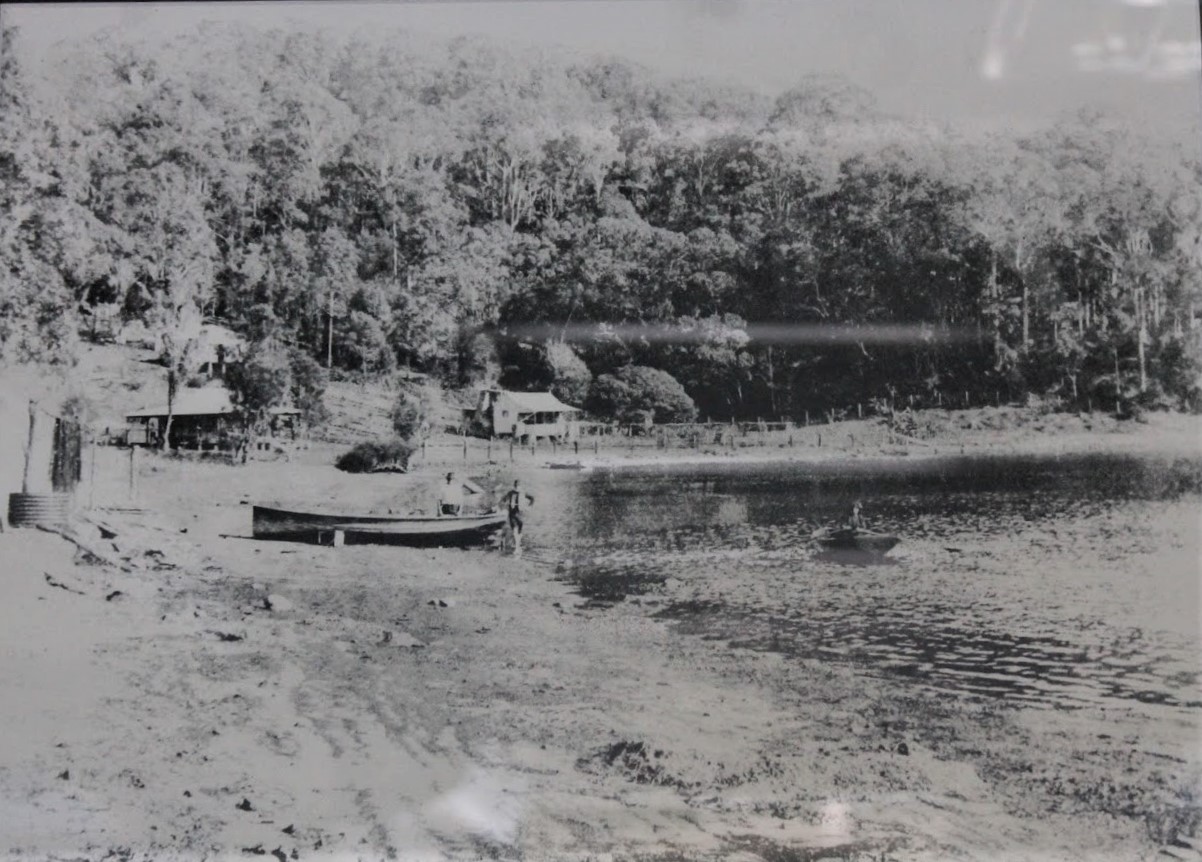
The nets you see in that old photograph – old Jackie had a net pole along here and they used to dry their nets on these. In the photograph you can see a big tub. In those days they used to boil the ironbark up to dye the nets as these were cotton, or they were when I first started. There was no nylon then. You would pick an ironbark tree that had a lot of sap coming out of it and chop the bark up finely to use as a dye. - Information courtesy PETER VERRILLS, photo courtesy Verrills family.
At the north end of Avalon Beach's valley, at Careel Bay, one of the first landowners to bring their acreage under the Real Property Act in order to subdivide is a lady - Margaret Allan of Mosman:
No. 13,259. County of Cumberland, parish of Narrabeen, 101 acres 1 rood 381 perches, situated on Clareville Wharf Road, Clareville,—is Block No. 3, South Subdivision, Pittwater Estate, and is part of 1,200 acres (portion No. 20 of parish) granted to John Joseph Therry; adjoining the properties of F. Burne, J. Robertson, S. Smith, and G. A. Smith, Trustees of Mrs. Evans, or J. G. Cousins, G. Holland, The London Bank of Australia, and J. H. Parry. – Applicant: Margaret Allan, Mosman. Day until which Caveats may be lodged: 17th February, 1905. NOTICE UNDER REAL PROPERTY ACT. (1904, December 30). Government Gazette of the State of New South Wales (Sydney, NSW : 1901 - 2001), p. 9437. Retrieved from http://nla.gov.au/nla.news-article226488010
PITTWATER
3 VACANT BLOCKS overlooking Careel Bay being LOTS 2 and 13 SECTION B STOKES POINT ESTATE area 3 acres 27 perches
LOT 1 SECTION 1 STOKES POINT ESTATE area 1 acre 2 roods 30 perches
TITLE FREEHOLD
H W HORNING AND CO, Auctioneers will sell as above by Public Auction in the Rooms 131 PITT STREET THIS DAY THURSDAY 25th OCTOBER at 11.30am. Advertising. (1909, October 28). The Sydney Morning Herald (NSW : 1842 - 1954), p. 3. Retrieved from http://nla.gov.au/nla.news-article15098719
As with sales at Narrabeen and Newport, the tram-line to the Narrabeen terminus sparked sales further north. The 'Villa Estates' sales of 1881 begin coming to the market:
No. 18.843. APPLICANTS:—Louisa Little, Wallendbeen, Henry John Little, and William Augustus Little, both Sydney. LAND:—County Cumberland, parish Narrabeen, shire Warringah, 27 acres 3 perches, at Pittwater.—lots 5, 6, 7, and 8, villa sites, in the Pittwater Estate, and part 1200 acres (portion 20, parish), granted to John Joseph Therry; adjoining properties of P. A. Temple, A. Robinson, W. Robinson. J.D. Fletcher, J. Smith, and J. Gregg. NOTICE UNDER REAL PROPERTY ACT. (1914, May 27). Government Gazette of the State of New South Wales (Sydney, NSW : 1901 - 2001), p. 3104. Retrieved from http://nla.gov.au/nla.news-article226768146
No. 19,362. APPLICANT: —John Henry Parry, London. LAND:—County Cumberland, parish Narrabeen, shire Warringah. 2 acres 1 rood 15 1/2 perches, 3 roods perches, 2 roods 24 perches, and 14 acres 1 rood 29 perches, in William, John, and Patrick streets and Central-road.—lots 3, 4, and 5, section 13. lot 5, section 12, lot 2, section 9, Marine village of Brighton "Josephton," Pittwater, and lots 5a and 6a, villa sites in Pittwater Estate, and parts 1,200 acres (portion 20, parish), granted to John Joseph Therry; adjoining properties of estate late R. Mcintosh, Mrs. Madden, E. Cole, J. T. Taylor. London Bank of Australia Ltd., G. Crowley, J. M. Taylor, and A. J. Small. NOTICE UNDER REAL PROPERTY ACT. (1914, September 9). Government Gazette of the State of New South Wales (Sydney, NSW : 1901 - 2001), p. 5456. Retrieved from http://nla.gov.au/nla.news-article228098990
MESSRS Hugh Duff and Co (A. T. Carpenter) had a good attendance at their sale on Thursday when there was bidding for nearly every lot. A block of land it Stokes Point, Newport 2 1/2 acres, was sold at £155 and £400 was offered for a cottage at Newport. REAL ESTATE. (1919, September 13). The Sydney Morning Herald (NSW : 1842 - 1954), p. 9. Retrieved from http://nla.gov.au/nla.news-article28097091
No. 22,830. APPLICANT:—Samuel Jamieson, Manly. LAND:—Shire Warringah, 20 acres 32 perches, lots 12, 13, 15, and 16 North Division Pittwater Estate, fronting Barrenjoey-road. NOTICE UNDER REAL PROPERTY ACT. (1921, March 18). Government Gazette of the State of New South Wales (Sydney, NSW : 1901 - 2001), p. 1786. Retrieved from http://nla.gov.au/nla.news-article220083436
No. 36,092. Louis Forster, 2 a. 2 r. 20 p., lots 1 to 5 incl., sec. VI, village of Brighton, in George, Joseph and Therry sts., and on Careel Bay, Pittwater. NOTICE UNDER REAL PROPERTY ACT. (1947, May 16). Government Gazette of the State of New South Wales (Sydney, NSW : 1901 - 2001), p. 1152. Retrieved from http://nla.gov.au/nla.news-article224768760
No. 29636 Katherine Mary Roche 6 a. 38 ½ p. pts. secs. 4 and 5 and lot 7 sec. 8 Brighton Village Est. and lot 8 sec. E. Stokers Point Est. George, Therry, Patrick, Elizabeth, Queen's and Joseph Sts. Pittwater. REAL PROPERTY ACT NOTICES. (1949, July 1). Government Gazette of the State of New South Wales (Sydney, NSW : 1901 - 2001), p. 1851. Retrieved from http://nla.gov.au/nla.news-article224754756
The earliest larger scale subdivisions were those at the north end of Avalon Beach under the Careel Ocean Beach estate subdivisions, commecning in 1914:
Sale of Ocean Water Frontages.
One of the attractions of the New Year with big advantages attached by reason of the rarity of the opportunity is the auction sale, January 26, of ocean water frontages on a beautiful surf beach at Careel Bay, Pittwater, just above. Manly.No better way to spend Anniversary Day could be found than to visit the spot, for which every provision will be made, as may be gathered from the advertisements. The land for sale is the Careel Ocean Beach Estate, which is only three-quarters of a mile from Clareville Wharf at Pittwater. There are hundreds of splendid deep blocks fronting a beautiful ocean beach and intersected by a fine wide marine parade. Only £3 deposit is required for each £50 purchase, and the balance, in easy installments over a term of seven years. The auctioneers are Messrs. Stanton and Son, Pitt-street, and Messrs. Hanson, Strong and Robey, Manly. The solicitors to the Estate are Messrs. Bowman and Mackenzie, George-street, Sydney. Sale of Ocean Water Frontages. (1914, January 17). The Newsletter: an Australian Paper for Australian People (Sydney, NSW : 1900 - 1918), p. 4. Retrieved from http://nla.gov.au/nla.news-article116942799
Stanton and Son, Ltd, report, 15 lots in the Careel Ocean Beach Estate, with frontages of in all of 752 feet to Marine Parade for a total of £6781. REAL ESTATE. (1919, January 11). The Sydney Morning Herald (NSW : 1842 - 1954), p. 9. Retrieved fromhttp://nla.gov.au/nla.news-article15819701
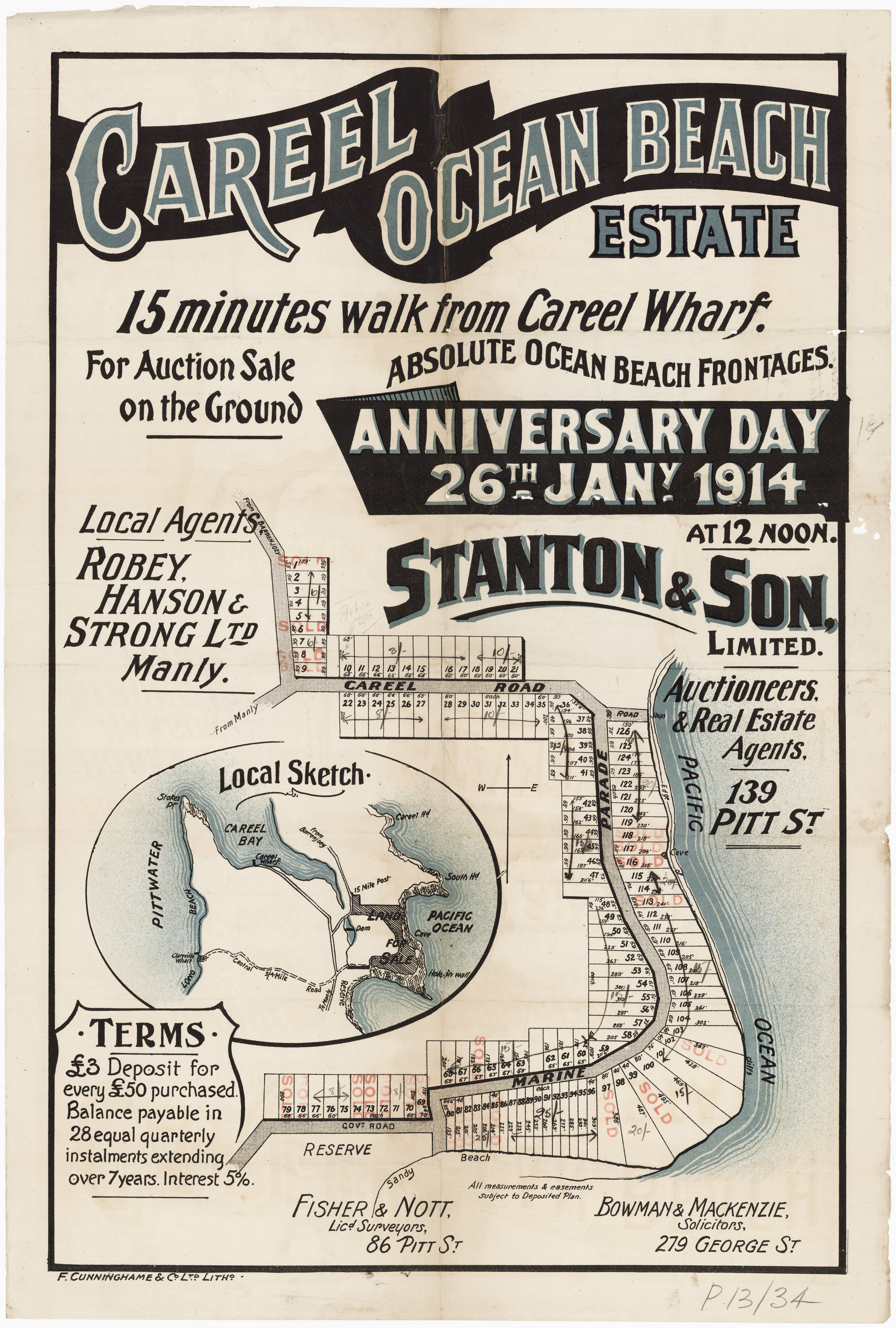
Avalon Subdivisions, Careel Ocean Estate 1914, Marine Road, Careel Road (now called 'North Avalon Road') Item No.: c027560006h, courtesy State Library of NSW - Litho showing those that sold.
No. 18,259. APPLICANTS:—Harley Usill Mackenzie and John George Cousins, both of Sydney. LAND:—County Cumberland, parish Narrabeen, shire Warringah, 161 acres 1 rood 16 perches, on road from Manly to Barren joey and Careel Creek, at South Head of Broken Bay and Hole-in-Wall on South Pacific Ocean,—lots 3 and 4, North Division, Pittwater Estate, also part 280 acres (portion 49, parish), and 1,200 acres (portion 20, parish), granted to Reverend John Joseph Therry; adjoining properties of H. R. Nolan, E. Darvall, F. M. Callaghan, estate late J. Lucas, Warringah Shire Council, and applicants. NOTICE UNDER REAL PROPERTY ACT. (1914, December 16). Government Gazette of the State of New South Wales (Sydney, NSW : 1901 - 2001), p. 7405. Retrieved from http://nla.gov.au/nla.news-article227425339
Harley Usill Mackenzie was the eldest of five sons of Walter and Frances Mackenzie (nee Usill).
MARRIAGE.
MACKENZIE —USILL. —On the 24th instant, at St. Michael's Church, Wollongong, by the Rev. T. C. Ewing, Walter Fawkes Mackenzie, Esq., M.R.C.S. and L.S.A., England, and Licentiate of the Royal College of Physicians, Edinburgh, of West Maitland, to Frances, second daughter of the late Harley Matthew Usill, Esq., of Wisbeach, Cambridgeshire, England. No cards. 720 Family Notices (1865, January 31). The Maitland Mercury and Hunter River General Advertiser (NSW : 1843 - 1893), p. 1. Retrieved from http://nla.gov.au/nla.news-article18706709
Children - from NSW BDM's Records:
MACKENZIE HARLEY U 10182/1867 WALTER F FRANCES HARTLEY
MACKENZIE WALTER F E 11703/1869 WALTER F FRANCES HARTLEY
MACKENZIE EDITH USILL 10863/1870 WALTER FARRKES FRANCIS HARTLEY
MACKENZIE ARTHUR C 2805/1873 WALTER F FRANCES SYDNEY
MACKENZIE WILLIAM K S 386/1872 WALTER FAWKES FRANCES SYDNEY
MACKENZIE ERIC BLUNDELL 2141/1875 WALTER FAWKES FRANCES SYDNEY
The Mackenzies lost one son while quite young and Dr. Mackenzie passed away before the boys were grown too. Fortunately he had established a form of income for his family in mining interests prior to passing away - a few news items tell the story:
MACKENZIE—Dec. 10, Sydney, Walter Fawkes Edwards, second son of Dr. W. F. Mackenzie, aged 7 years. Family Notices (1875, December 25). The Sydney Mail and New South Wales Advertiser (NSW : 1871 - 1912), p. 813. Retrieved from http://nla.gov.au/nla.news-article162489288
MACKENZIE.-October 14, 1886, at Lyons-terrace, Sydney, Dr. Walter Fawker Mackenzie, aged 51. Family Notices (1886, October 23). The Sydney Mail and New South Wales Advertiser (NSW : 1871 - 1912), p. 879. Retrieved from http://nla.gov.au/nla.news-article164381257
DOCTOR MACKENZIE, — Doctor Walter Fawkes Mackenzie, chief medical officer of the Australian Mutual Provident Society and medical examiner to the Board of Education, died in his residence on Thursday after a short illness. He was a member of the Royal College of Physicians of Edinburgh, and of London. The deceased gentleman commenced his career early in the decade '60 to '70 in West Maitland, and afterward removed to Wallerawang, which place he left for Sydney. Dr. Mackenzie was one of our best known metropolitan practitioners, and was highly respected. His practice was chiefly with families, and his handsomely appointed brougham was a familiar, object in the fashionable thoroughfares in and about Sydney. He was brother to the examiner of coal fields. He leaves a widow and five children. General News. (1886, October 16). Evening News (Sydney, NSW : 1869 - 1931), p. 9. Retrieved from http://nla.gov.au/nla.news-article107317674
"Amicus" writes: — "The late Dr. Walter Fawkes Mackenzie was a man whom it was impossible to know without eutertaining a sincere appreciation for his sterling worth. Always cheerful, never at any time mentally depressed, and full of energy, he possessed a gaiety of heart that lent itself in an 'infective' manner to those in his company. Possessing wondrous tact and xavoir J aire he took infinite pains to use these special gifts to the best interests of those enjoying his friendship. Ho was devoted to his profession and enjoyed the benefits of a largo and lucrative practice, but such were his systematic arrangements and habits .of routine that he seemed fairly to revel in his active duties. Full of consideration to all, aud especially to those in his service he, to whom time was more vnlunblo than to most men, would go out of his way to do a friend a good turn, with a charming air of bouhomie that would leave the recipient for ever grateful. His nature was singularly free from any jealous feelings, and to his profession and the members thereof be was loyal to the core, many of whom are much indebted to his kindly interest on their behalf." GENERAL NEWS. (1886, October 19). The Daily Telegraph (Sydney, NSW : 1883 - 1930), p. 5. Retrieved from http://nla.gov.au/nla.news-article239322572
LOCAL NEWS.
The Late Dr. W. F. Mackenzie.-This gentleman, who was one of the leading members of the medical profession in Sydney, died at his residence on Thursday, after a short illness. Dr. Mackenzie was born in Lancashire and took his diplomas in Edinburgh and London. He arrived in the colony in 1862, and settled in the first instance at West Maitland, where he soon obtained a very large practice, under the pressure of which his health gave way. He retired for a time to Wallerawang, in the Blue Mountains, where he had a property, and on regaining his strength resumed his profession in Sydney, where he enjoyed a large practice up to the time of his death. In 1876 he was appointed medical officer, to the Australian Mutual Provident Society, the duties attached to which position he discharged to the entire satisfaction of the board. The work was onerous, involving the personal examination of from 400 cases annually, and the revision of all the medical reports from the country. His loss will be severely felt, not only in his own immediate family circle, but also by a large number of friends by whom he was much esteemed for his genial disposition, his generosity, and up-rightness. He leaves a widow, and five children, of whom the eldest is not yet of age. At the meeting of the medical section of the Royal Society which was hold last night, the following resolution was proposed and unanimously carried-"That the section has heard with deep regret of the death of Dr. Walter Fawkes Mackenzie ; and that the section do now adjourn as a mark of the respect and esteem with which he was regarded."-Herald. LOCAL NEWS. (1886, October 19). The Maitland Mercury and Hunter River General Advertiser (NSW : 1843 - 1893), p. 5. Retrieved from http://nla.gov.au/nla.news-article18891044
SUPREME COURT.-THURSDAY, MAY 21.
BEFORE,Mr. Justin FAUCETT, and Mr. Justice INNES )
MACKENZIE VS. MACKENZIE
... was the appeal of the defendant, Dr. Walter Fawkes Mackenzie, against the decree of his Honor the Primary Judge declaring his brother, the plaintiff, John Mackenzie, examiner of coaIfields, to be a partner with him in certain valuable coal and shale lands near Wallerawang....
The CHIEF JUSTICE, in delivering judgment, said that if there were nothing else to be considercd but the deed poll, there would be no question that it gave the defendant a rompíalo right to the property. However, the relation of the parties in respect to the property from the execution of the deed in 1870 down to 1883 showed that no change had taken place in the ownership. Although no works were carried out, and no coal extracted, efforts were made in various quarters to make aouie portion of the land available by selling It, and during all these transactions the plaintiff and defendant had corresponded and talked together when it became necessary,until at some time in July, when the plaintiff wrote for copies of deeds, in order to have his position put on some satisfactory bans. Apart from the authorities which had been stated it was quite evident that when two persons entered into partnership to work ... properties they being the a> le matter of the partnership, when one conveyed his interest to the other the partnership could not be ...must be a dissolution. If the plaintiff came to that Court with such a OKI» as that he would have no ground for asking ... appeal was therefore dismissed with costs, the Court Joining in a recommendation to the parties to ..come to some arrangement. LAW REPORT. SUPREME COURT.—THURSDAY, MAY 21. (1885, May 22). The Sydney Morning Herald (NSW : 1842 - 1954), p. 5. Retrieved from http://nla.gov.au/nla.news-article13589044
Kerosene Vale
Description:
Is a rural place and a valley located 2km east of Lidsdale. It has the creek system, Sawyers Swamp, flowing through it. Dr Walter Fawkes Mackenzie (1835-1886) applied for a Mineral Lease of 240ac at Sawyers Swamp in 1866. Ref: Survey Plan C290.1507. In a few short years, his holdings in this area had increased to 691ac (279ha). It was due to the shale, also referred to as Torbanite, mined in this locality for its oil content, which produced, when processed, kerosene. The mining in this area resulted in the locality being called Kerosene Vale. At present, this area is used as a repository for the dry ash generated by the Wallerawang Power Station. Constructed in 1960, it was filled with a combination of by product ash from the Wallerawang Power Station and mining spoil.
Harley's brother William Kenneth Seaforth Mackenzie was a gentleman known for his Military Service and for his care of the men under his command during WWI, although this item, in noting his death, refers back to the industry started by his father and his father's brother:
SEVERANCE OF LINK WITH EARLY MINING HISTORY
In last Saturday's Herald was a notice stating that Lieut. Colonel William K. S. Mackenzie, D.S.O., who was admitted to the New South Wales Bar in 1895, died last Tuesday.
This is of more than passing interest to people, interested in mining in this district and possibly others, reports Mr. E. J. McKenzie, research secretary of the Lithgow Historical Society. It was Colonel Mackenzie's father (Dr. Walter Fawkes Mackenzie) and his uncle (John Mackenzie) examiner of coal mines in the early days of the Mines Department, who established the kerosene oil industry at Kerosene Vale, Lidsdale, in the 1860's. In the Bathurst Times of November 20, 1867, it was reported that a consignment of 200 gallons of "Cannelite oil from Mackenzie Bros' oil works near Bowenfels had reached Bathurst. It appears that be cause of the pale amber color of the oil the public were prejudiced against is in favor or the American oil which was clear in color. Up till about 10 years ago Kerosene Vale was one of the beauty spots of the district. The Mackenzies, who by the way came from Wiggan, England, planted the place with ornamental trees and shrubs. During the last war the poplars' and redwoods were sold and taken to mills , in Sydney for manufacture into better class furniture, etc., but with the remaining shrubs, along with the unusual natural formation of the place, it still retained much of its charm as a picnic ground. SEVERANCE OF LINK WITH EARLY MINING HISTORY (1952, June 12). Lithgow Mercury (NSW : 1898 - 1954), p. 4. Retrieved from http://nla.gov.au/nla.news-article219826938
Harley died quite young:
MACKENZIE - March 3 1916, at St Vincent's. Private Hospital Darlinghurst, Harley Usill Mackenzie aged 49 years. Family Notices (1916, March 4). The Sydney Morning Herald (NSW : 1842 - 1954), p. 16. Retrieved from http://nla.gov.au/nla.news-article15641578
MR. HARLEY MACKENZIE DEAD
The death of Mr. Harley Ursill Mackenzie, one of Sydney's best-known solicitors, and a member of the legal firm of Messrs. Bowman and Mackenzie, of this city, in St. Vincent's Private Hospital on Friday, was consequent upon an operation for appendicitis. Deceased who was in his 49th year, was a son of Dr. Mackenzie, of Sydney, and a brother of Lieutenant-Colonel Mackenzie, now at the front, and formerly Associate to Mr. Justice Gordon, Judge in Divorce.
Mr. Mackenzie was well known in social and sporting circles in this State. The interment took place yesterday afternoon at Burwood, in the Church of England portion of the cemetery. The funeral was, large and representative, and Included many legal men. Amongst those who forwarded wreaths were the directors of the Hotel Pacific, Mr. and Mrs. Septimus Levy, Mr. and Mrs. Harry Levy, the management and staff of the Hotel Pacific, Dr. and Mrs. Herbert Marks, Mr. and Mrs. Frank Macdonald, Mrs. and Miss Lewis, Mr. John Mackenzie. Misses Hay, Mr. and Mrs. J. B. Osborne, Mr. and Mrs. Phillip Morton, the guests of the Hotel Pacific, Rachael Joy Martin, Mr. and Mrs. Reginald Allen, the board of directors of the Royal Prince Alfred Hospital; Mr. Harry Chisholm, Mr. Venour Nathan, Mr. A. G. Andrews, Mr. Edwin Geach, Mr. and Mrs. Owen Prosser, and Misses Morton. MR. HARLEY MACKENZIE DEAD (1916, March 5). The Sun (Sydney, NSW : 1910 - 1954), p. 5 (SUNDAY EDITION). Retrieved from http://nla.gov.au/nla.news-article221360635
In the Supreme Court of New South Wales.
PROBATE JURISDICTION.
In the will of Harley Usill Mackenzie, late of Sydney, in the State of New South Wales, solicitor, deceased.
PURSUANT to the Wills, Probate and Administration Act, 1898: Notice is hereby given that all creditors and other persons having any claims upon or being otherwise interested in the estate of the abovenamed deceased, who died at Sydney aforesaid on the 3rd day of March, 1916, are hereby required to send in full particulars of their claims to the undersigned, the proctors for the executors of the will of the said deceased, before the 25th day of October next, after which date the said executors will proceed to distribute the assets of the said deceased amongst the parties entitled thereto, having regard to the claims of which they shall then have notice ; and the said executors shall not be liable, for the assets or any part thereof so distributed, to any person of whose claim they shall not have had notice at the time of such distribution.—Dated this 8th day of September, 1916.
BOWMAN AND MACKENZIE,
Proctors for the Executors,
279 George-street, Sydney. PROBATE JURISDICTION. (1916, September 15). Government Gazette of the State of New South Wales(Sydney, NSW : 1901 - 2001), p. 5610. Retrieved from http://nla.gov.au/nla.news-article225845310
His brother W K Mackenzie was in charge of his estate, and that of his brothers. William Kenneth Seaforth Mackenzies' war service:
Colonel Mackenzie, who completed his first year of active service at the front to-day, is in good health and spirits, according to a letter received from him by Mr. Justice Gordon yesterday. Prior to going to the war Colonel Mackenzie, who Is a member of the New South Wales Bar, was Associate to his Honor. MEN AND WOMEN (1916, June 14). The Sun (Sydney, NSW : 1910 - 1954), p. 6 (FINAL RACING). Retrieved from http://nla.gov.au/nla.news-article221351053
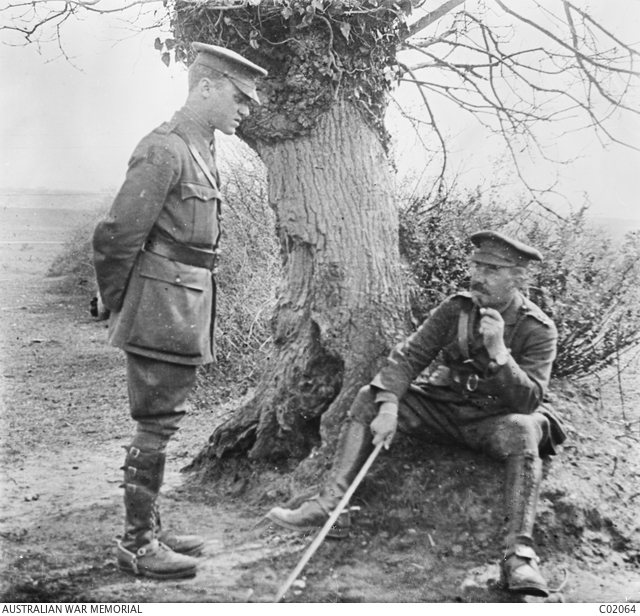
Informal portrait of two 61st Battalion officers at a camp in southern England. Identified left to right: Captain Arthur Havelock Hirst; Lieutenant Colonel William Kenneth Seaforth Mackenzie, DSO, Officer Commanding. Place made: United Kingdom: England, Dorset, Wareham, Date made: May 1917, Conflict First World War, 1914-1918 - courtesy Australian War Museum
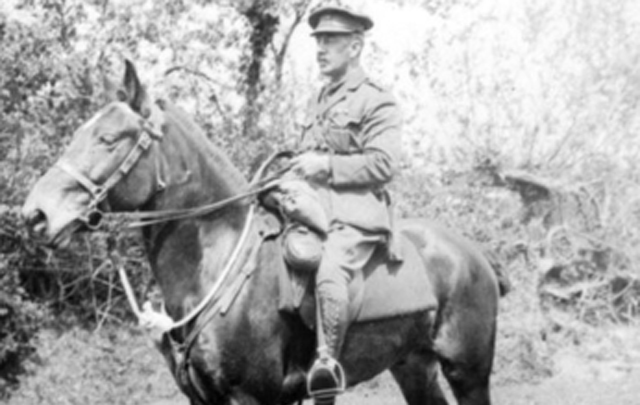
Colonel William Kenneth Seaforth Mackenzie, DSO, Officer Commanding Place made: United Kingdom: England, Dorset, Wareham, Date made: May 1917, Conflict First World War, 1914-1918 - courtesy Australian War Museum
John George Cousins also had a land holding at the south end of the Avalon valley
No. 18,217/ APPLICANTS:—John George Cousins, Amess Bissett Coleman, and Thomas Hardy, all Sydney. LAND: —County Cumberland, parish Narrabeen, shire Warringah, 96 acres 3 roods, on the road from Manly to Barrenjoey, being Block IV, South Division, Pittwater Estate, and part 1,200 acres (portion 20, parish), granted to John Joseph Therry; adjoining properties of F. Burne, estate late John Tomkins and A. Bowen, G. Crowley, and J M. Taylor. NOTICE UNDER REAL PROPERTY ACT. (1913, June 25). Government Gazette of the State of New South Wales (Sydney, NSW : 1901 - 2001), p. 3845. Retrieved from http://nla.gov.au/nla.news-article221596335
John George Cousins had a long association with the area. He was an investor in lands then brought under the Real Property Act for decades, with partners and mostly losing in these transactions, prior to being among partners buying up lots in the Avalon valley. He married a Mary Roberts in 1871. In 1884 and 1890 we find Mr. Cousins in Manly:
In the Supreme Court of New South Wales.
ECCLESIASTICAL JURISDICTION.
In the goods of Alfred Cousins, late of Manly, in the Colony of New South Wales, mercantile clerk, deceased, intestate.
NOTICE is hereby given that after the expiration of fourteen days from the publication hereof, application will be made to the Supreme Court of New South Wales, in its Ecclesiastical Jurisdiction, that letters of administration of the estate and effects of the abovenamed Alfred Cousins, who died at Manly aforesaid, on the 1st day of December, 1884, may be granted to John George Cousins, of Manly aforesaid, hotel-keeper, the father and next of kin of the deceased.—Dated this 24th day of November, 1885.
LOUIS FREDERICK DIXON, Proctor for the Applicant, 92, Pitt-street, Sydney. ECCLESIASTICAL JURISDICTION. (1885, November 27). New South Wales Government Gazette (Sydney, NSW : 1832 - 1900), p. 7682. Retrieved from http://nla.gov.au/nla.news-article223764472
Fire at Manly.
A fire broke out on Saturday afternoon (the origin of which is at present unknown) at the Steyne Hotel, Corso, Manly, licensee, John George Cousins. The fire was extinguished by the Manly Volunteer Brigade, but not before damage was done to the extent of £100. The contents are insured in several offices for £2500, and the premises in the Victoria Office for £5000. Fire at Manly. (1890, October 6). Evening News (Sydney, NSW : 1869 - 1931), p. 4. Retrieved from http://nla.gov.au/nla.news-article113742699
He also seemed to be involved in a few shady dealings and here we find Harley Mackenzie defending him:
Miniature Portraits
LOVELL, COUSINS, AND ANDREWS AGAIN ON TRIAL.
For the second time during the present sittings of the Darlinghurst Sessions, John Charles Lovell, John George Cousins, and David Andrews were, this morning, placed on trial, before Judge Doeker, and, a Jury of 12 on a charge of conspiring among themselves to cheat and defraud several persons of divers large sums of money, by passing off bogus miniature portraits as the work of old masters.
All the accused pleaded not guilty, and were defended— Lovell by Mr. Pickburn, instructed by Mr. F- Osborne (Messrs, Norton, Smith, and Company); Cousins, by Mr. J. C. Gannon and Mr. Mitchell, instructed by Mr. Harley Mackenzie (Messrs. Bowman and Mackenzie): and Andrews by Mr. Nugent Robertson, instructed by Mr. J, J. Jagelnjan, Mr. H, Harris prosecuted for the Crown. At the last trial the jury, after having been locked up all night, were discharged on the morning of the 15th instant. Particulars of the case have already been published at length in the 'Evening News.' (Proceeding.) Miniature Portraits. (1908, February 24). Evening News (Sydney, NSW : 1869 - 1931), p. 4. Retrieved from http://nla.gov.au/nla.news-article114105644
John George Cousins also passed away in 1916 and his wife had to apply for bankruptcy on his estate:
[Notice under Section-11 of the Bankruptcy Act, 1898.]
In the Supreme Court of New South Wales. (21,042)
IN BANKRUPTCY.
Re estate of the late John George Cousins (deceased), late of 278 George-street, Sydney, warehouseman.
NOTICE is hereby given that a Sequestration Order has this day been made against the abovenamed estate, on the petition of the executrix, Mary Cousins, and Mr. C. F. W. Lloyd appointed to be the Official Assignee.—Dated at Sydney, this 17th day of January, 1917.
F. H. SALUSBURY, Registrar in Bankruptcy. IN BANKRUPTCY. (1917, January 19). Government Gazette of the State of New South Wales (Sydney, NSW : 1901 - 2001), p. 413. Retrieved from http://nla.gov.au/nla.news-article226035031
The second subdivision of the Careel Ocean Beach Estates did not take place until 1922 and has some great photographs including in the pamphlets:
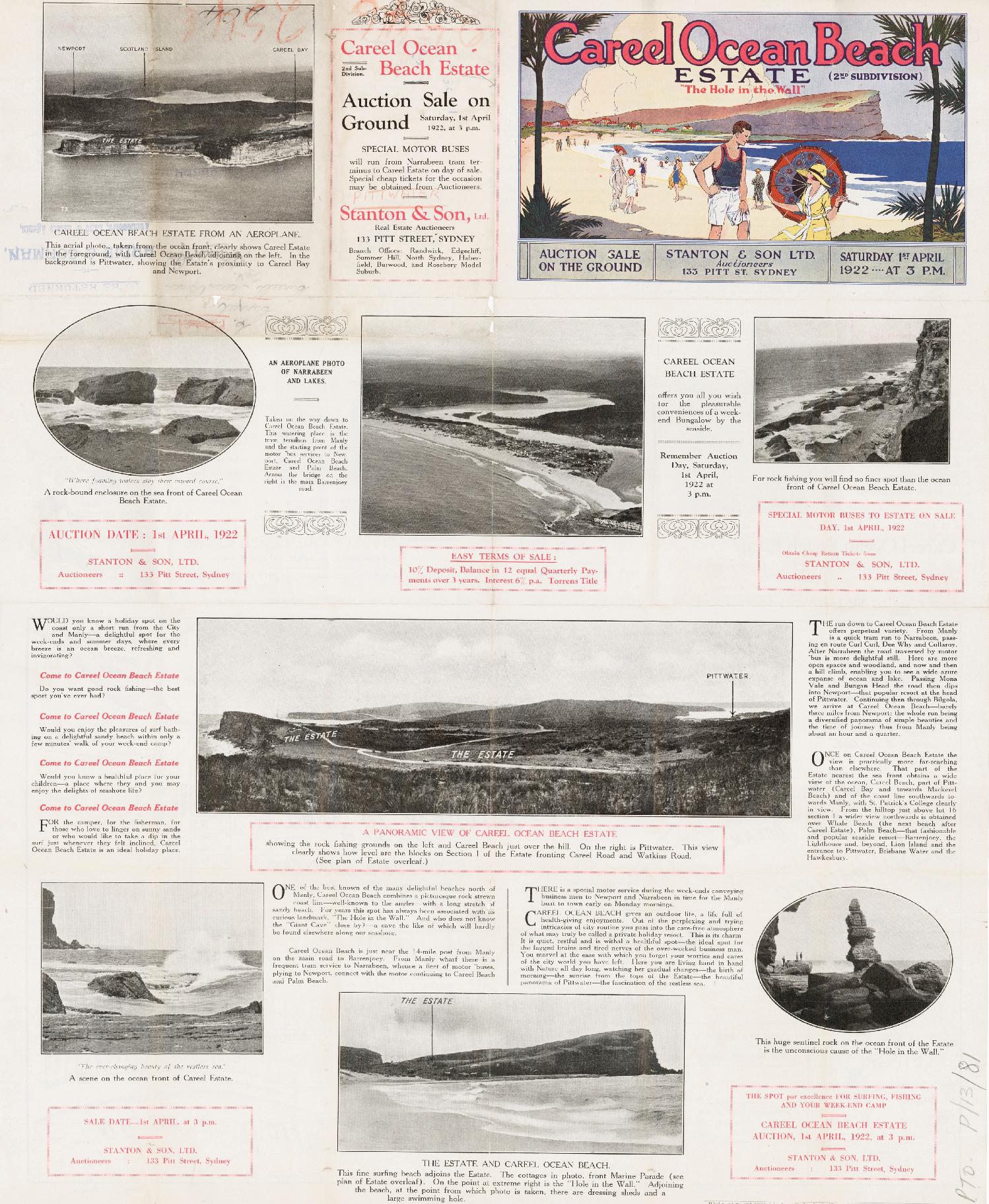
Careel Bay Ocean Estate - 'The Hole in the Wall' 2nd subdivision - April 1st, 1922 - Item c053460087, from Pittwater Subdivisions folder, courtesy State Library of NSW - and enlarged sections from to show images used:
.jpg?timestamp=1591761649648)
.jpg?timestamp=1591761719610)
AN AEROPLANE PHOTO OF NARRABEEN AND THE LAKES
.jpg?timestamp=1591762184594)
.jpg?timestamp=1591762223606)
.jpg?timestamp=1591762259417)
.jpg?timestamp=1591762290926)
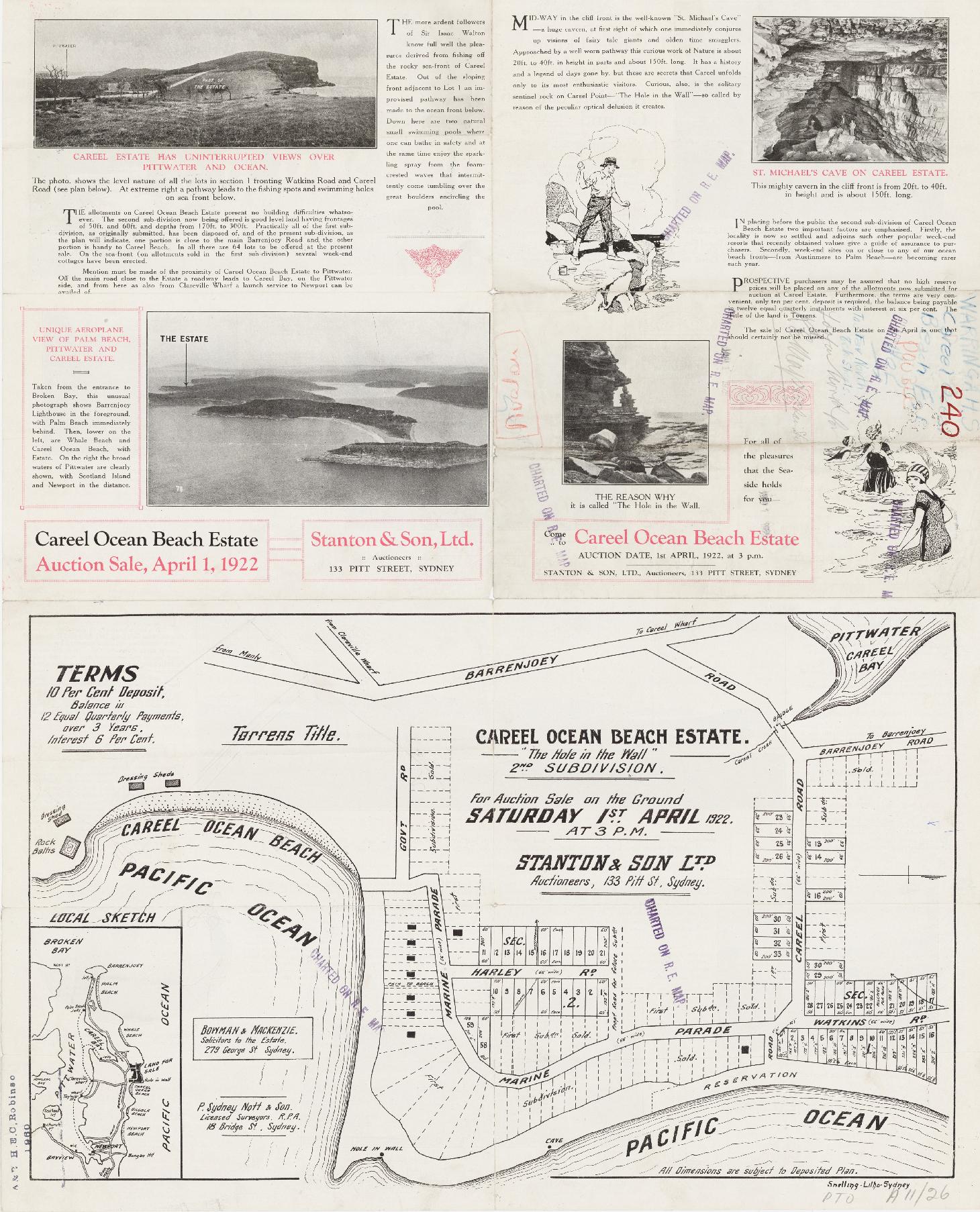
.jpg?timestamp=1591760559773)
.jpg?timestamp=1591760591087)
.jpg?timestamp=1591760618560)
.jpg?timestamp=1591760644425)
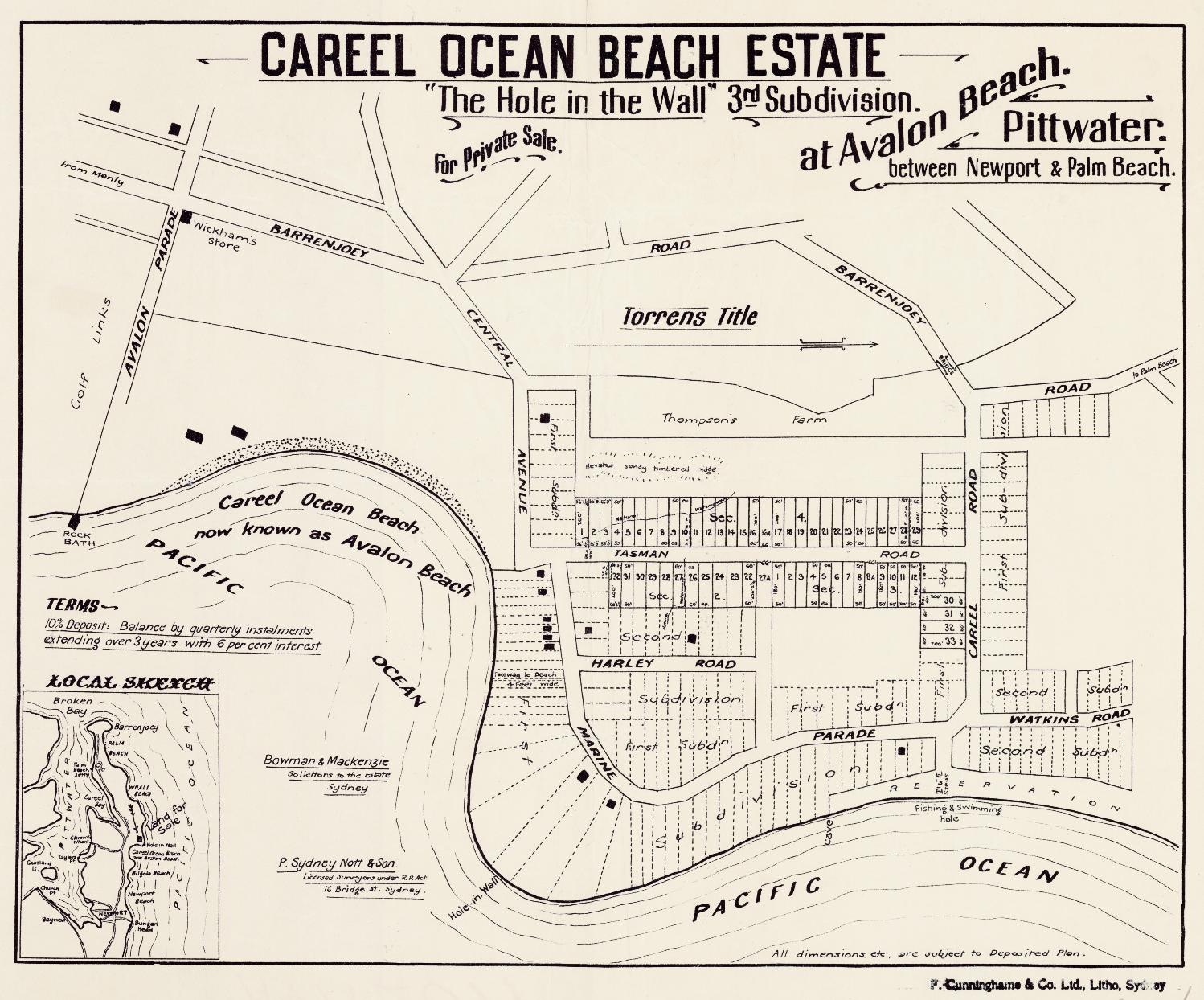
Careel Ocean Estate 3rd subdivision - Item c027560024 rom Pittwater Subdivisions folder, courtesy State Library of NSW
The subdivisions of the Careel Bay Ocean Estates at what we today call North Avalon Beach were interspersed with some at Careel Bay, commencing at the Whale Beach-Careel Head overlap in 1914. In 1914 a Dr. Herbert Nolan, one of the original Directors of the Barrenjoey Land Company, brought the almost 180 acres of land at the Careel Bay end of Whale Beach under the Real Property Act:
No. 19,218. APPLICANT :—Herbert Russell Nolan, Sydney. LAND:—County Cumberland, parish Narrabeen, shire Warringah, 179 acres 3 roods, on Careel Bay, at the South Head of Broken Bay, and on the road from Manly to Barrenjoey—lots 2 to 6 and blocks 1 and 2, north division, Pittwater Estate, and part 280 acres (portion 49, parish), granted to John Joseph Therry, exclusive of three roads each 1 chain wide, and land within the 100 feet reservation in the abovementioned grant the areas of which are not included in the above-mentioned area, 179 acres 3 roods ; adjoining properties of E. Trevor-Jones, H. Mackenzie, and Mrs. K. M. Roche
No. 19,248. APPLICANT .—Mabel Daisy Black, Annandale. LAND: County Cumberland, parish Narrabeen, shire Warringah,—8 acres 20 perches, at Pittwater, on Bay View road and a road 30 links wide,—being part 40 acres (portion 43. of parish), granted to George Weller; adjoining properties of F. J. S. Young, S. R. Mitchell, P. T. Taylor, Dr. J. Isbister, and G. Leslie. NOTICE UNDER REAL PROPERTY ACT. (1914, August 19). Government Gazette of the State of New South Wales (Sydney, NSW : 1901 - 2001), p. 5039. Retrieved from http://nla.gov.au/nla.news-article227674898
Dr. Herbert 'Russell' Nolan, known for performing the first appendectomy in Australia, served in the Boer War where he contracted typhoid fever, from which he never really recovered. He passed away in February 1915. His estate, when valued, showed the bulk of his assets were investments in real estate.
His passing may account for the delay between bringing these parcels of land under the Real Property Act and the first 'Whale Beach' subdivision at the Careel Head Road-Whale Beach Road end. Visit: Pittwater Roads II: Where the Streets Have Your Name - Whale Beach
It should also be noted that 'Careel Bay' on earlier maps, and these subdivisions through the 1910-20's, was described as stretching from the Dark Gully and MacKays Reserve at Palm Beach end of the Pittwater estuary down to what we today call Careel Bay.
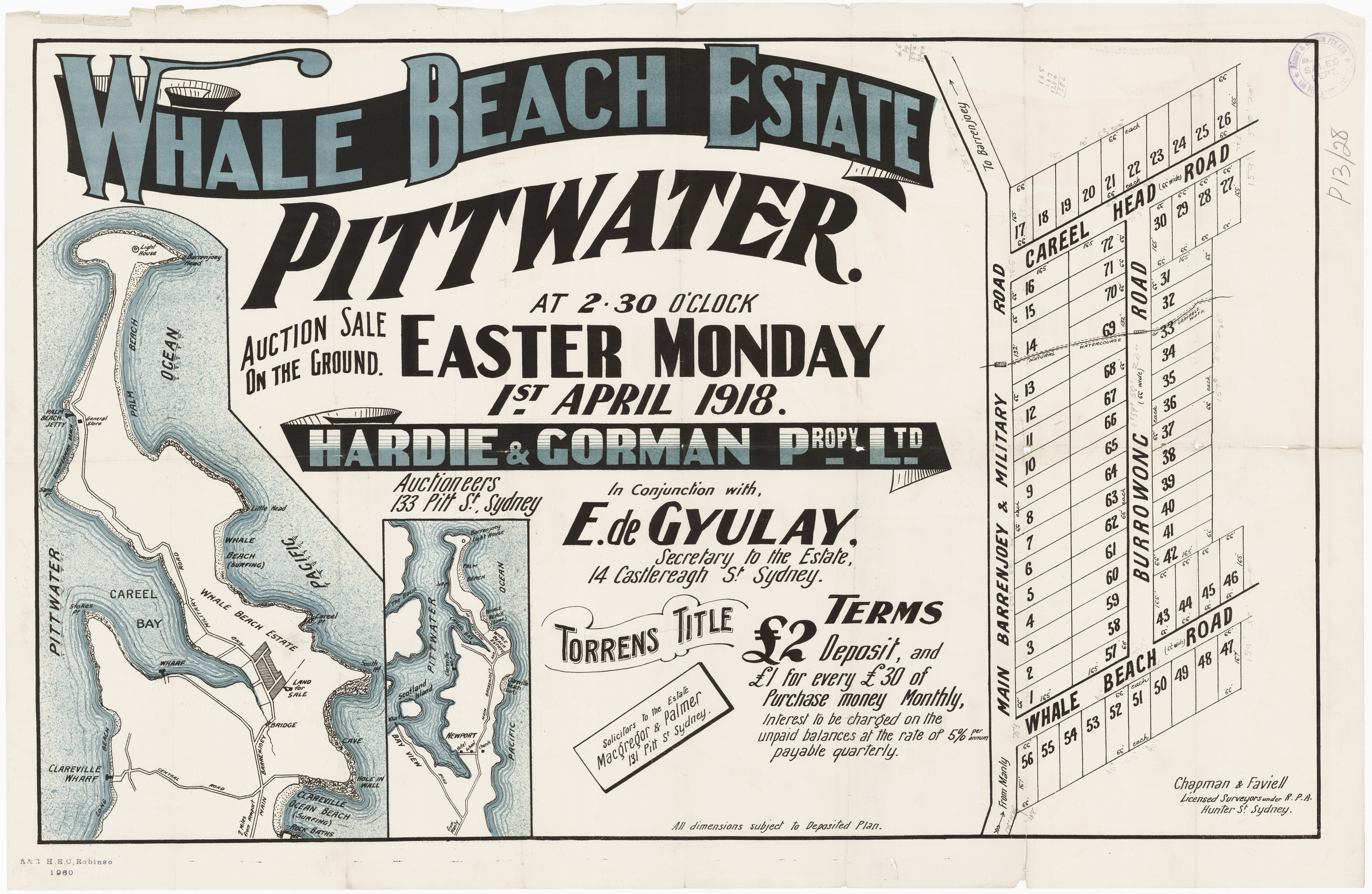
Whale Beach Estate 1918 April 1st c053460074, showing Careel Head Road, Burrowong Road (now spelled Burrawong) and Whale Beach Road - from and courtesy State Library of NSW Pittwater Subdivisions folder.
A burrawong is a large attractive palm-like evergreen cycad of New South Wales. Individual specimens take 10–20 years to mature and may live for up to 120 years. Also a name for the poisonous nut of the burrawang, which becomes edible after prolonged soaking.
PROPERTY SALES.
Hardie and Gorman Proprietary, Limited, in conjunction with Mr. E de Gyulay, conducted the opening sale of the Whale Beach Estate, Pittwater, yesterday afternoon, on the ground. There was a large attendance, and the sale was very successful, 52 allotments out of 72 being sold, at prices ranging from 6/6 to 12/ a foot. Total of sale, £1584/2/. PROPERTY SALES. (1918, April 2). The Sydney Morning Herald (NSW : 1842 - 1954), p. 9. Retrieved from http://nla.gov.au/nla.news-article15766139
A few days later a change in the sold £ total:
Messrs. Hardie and Gorman had a fairly busy week in their now rooms. They sold a pair of houses, Nundarra and Yarama, Moonbie-street, Summer Hill, for £1650; 52 allotments in the Whale Beach Estate, Pittwater, from 6s 6d to 12s per foot (£1574); REAL ESTATE. (1918, April 6). The Sydney Morning Herald (NSW : 1842 - 1954), p. 9. Retrieved from http://nla.gov.au/nla.news-article15770535
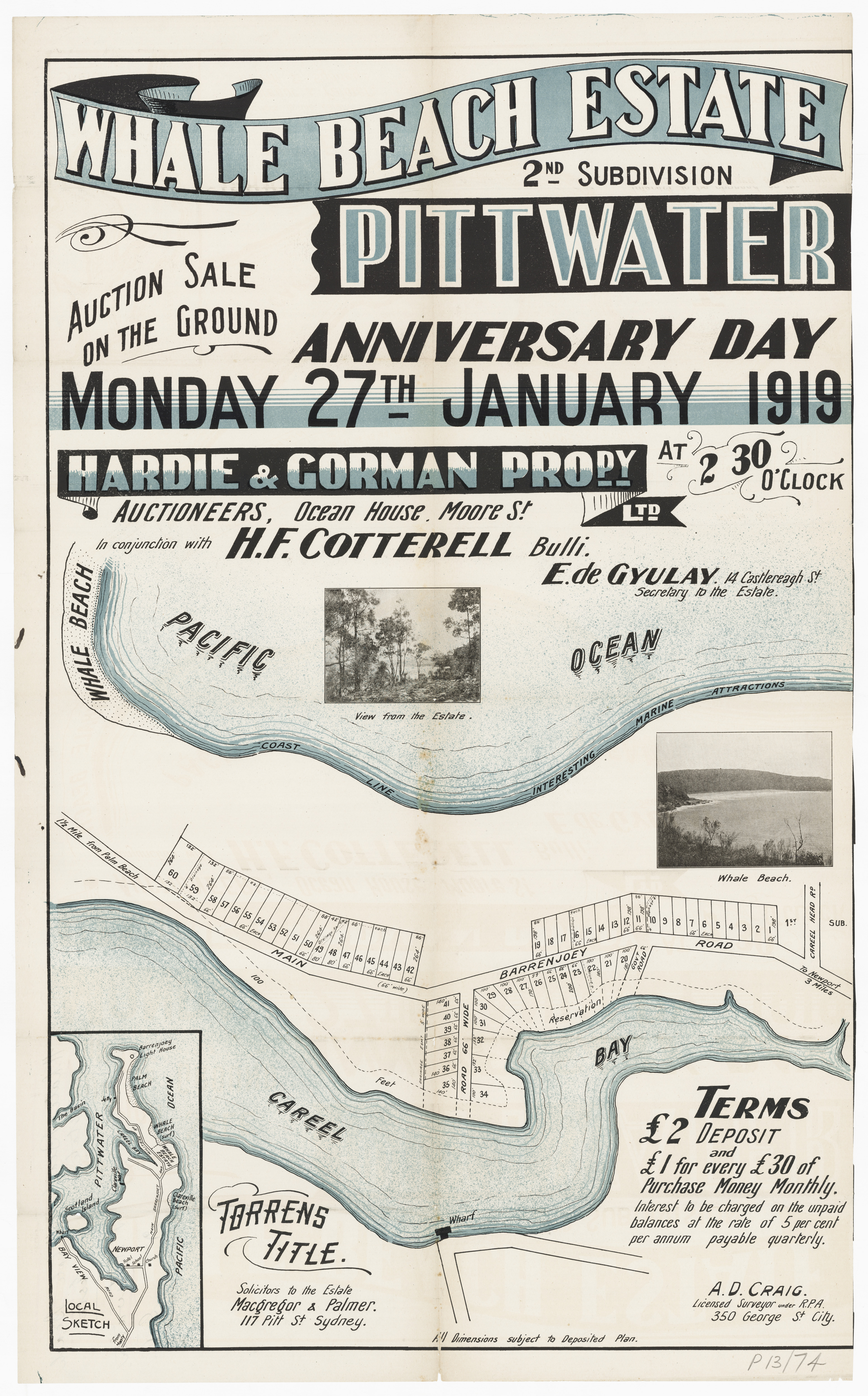
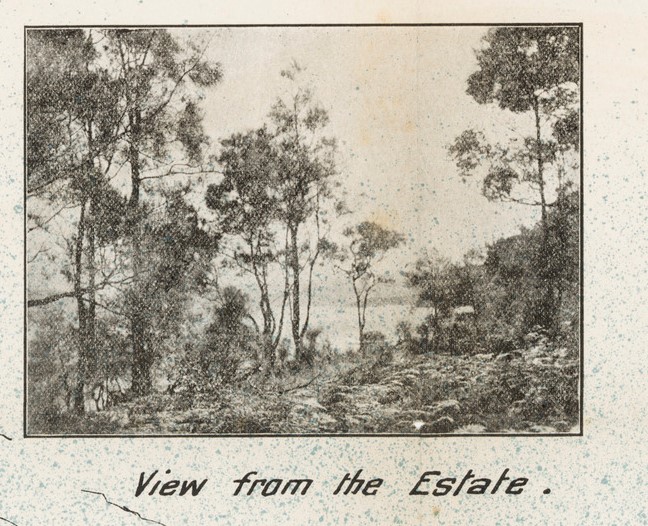
.jpg?timestamp=1572409030197)
Whale Beach Estate 1919 Item No.: c053460079 - showing Careel Head Road and Barrenjoey Road, from and courtesy State Library of NSW Pittwater Subdivisions folder
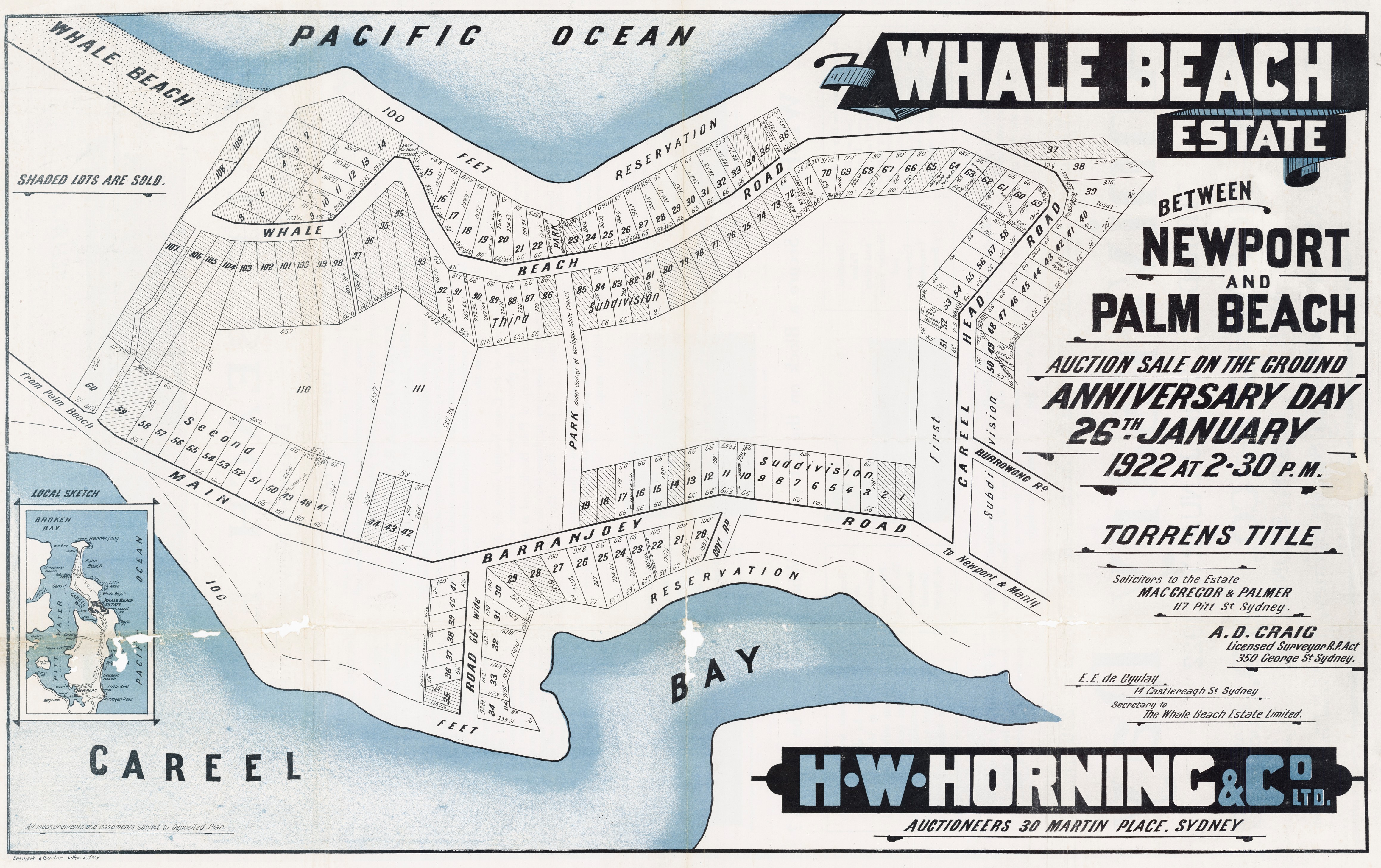
Whale Beach Estate January 26th, 1922, showing 2nd and 3rd subdivision - names Barranjoey Road - a 'Government Road' into where Careel Bay Playing Fileds now are with an 'a', Mr de Gyulay is still secretary but this is named as 'The Whale Beach Estate Limited' subdivision. Item No.: c053460088, from and courtesy State Library of NSW Pittwater Subdivisions folder.
APPLICATIONS having been made to bring the lands hereunder described under the provisions of the Real Property Act, Certificates of Indefensible Title will issue, unless Caveats been lodged in accordance with the Third Schedule to the said Act on or before THE 20TH SEPTEMBER, 1919: —
No. 20.950. APPLICANTS:—Emily Darvall, Moss Vale, and Florence Maud Callaghan, Sydney. LAND : — Shire Warringah, 8 acres 0 roods 24, perches,—lot 9 of the North Division of the Pittwater Estate, at the junction of the roads from Manly to Careel Bay, and to Barrenjoey, about 17 chains northerly from Central-road. NOTICE UNDER REAL PROPERTY ACT. (1919, August 8). Government Gazette of the State of New South Wales (Sydney, NSW : 1901 - 2001), p. 4425. Retrieved from http://nla.gov.au/nla.news-article222512530
Those also bringing acreage under the Real Property Act during those years were:
No. 20,282. APPLICANTS:—Percy Charles Lucas, Ingleburn; John Hector Lucas, Five Dock; and Edgar Lucas, Waverley. LAND:—County Cumberland, parish Narrabeen; shire Warringah, 12 acres 12 perches, on road from Manly to Barrenjoey, and on Central-road,—lots 10 and 11, North Division, Pittwater Estate, and part 1,200 acres (portion 20, parish), granted to John Joseph Therry; adjoining properties of Mrs. E. Darval, E. M. Callaghan, and Careel Ocean Beach Estate, Limited. NOTICE UNDER REAL PROPERTY ACT. (1916, December 29). Government Gazette of the State of New South Wales (Sydney, NSW : 1901 - 2001), p. 7818. Retrieved from http://nla.gov.au/nla.news-article225966054
No. 20,950. APPLICANTS.-Emily Darvall, Moss Vale, and Florence Maud Callaghan, Sydney. LAND; Shire Warringah, 8 acres 0 roods 24 1/2 perches-lot 9 of the North Division of the Pittwater Estate, at junction of the roads from Manly to Careel Bay, to Barrenjoey, about 17 1/2 chains northerly from Central Road. Advertising (1919, August 16). The Sydney Morning Herald (NSW : 1842 - 1954), p. 20. Retrieved from http://nla.gov.au/nla.news-article28096153
No. 22,054. APPLICANT:—Alfred Henry Delohery, Sydney. LAND:—Shire Warringah, on Careel Bay, at Stokes' Point, 2 acres 3 roods 26 perches, lots 3 and 4, section A, Stokes' Point subdivision. NOTICE UNDER REAL PROPERTY ACT. (1919, September 12). Government Gazette of the State of New South Wales (Sydney, NSW : 1901 - 2001), p. 5054. Retrieved from http://nla.gov.au/nla.news-article227335843
No. 22,830. APPLICANT:—Samuel Jamieson, Manly. LAND:—Shire Warringah, 20 acres 32 perches, lots 12, 13, 15, and 16 North Division Pittwater Estate, fronting Barrenjoey-road. NOTICE UNDER REAL PROPERTY ACT. (1921, March 18). Government Gazette of the State of New South Wales (Sydney, NSW : 1901 - 2001), p. 1786. Retrieved from http://nla.gov.au/nla.news-article220083436
Warringah Shire Council records state that on July 10th, 1922 they received correspondence regarding the Jamieson Estate and Resolved., - (Crs. Campbell, Sterland) That Messrs. Howard and Rogers be informed that the Council will approve of the sale of lots to existing roads in Jamieson Estate, Careel Bay, provided that the pegs of the lots fronting Barrenjoey Road which now stand on portion of the existing road, be moved back 6 feet from the water-table. Howard & Rogers was a Surveyors partnership between Harold Trotman Howard and John Noble Rogers. H T Howard was associated with Careel Bay from at least 1900, when he married the daughter of one of the 1881 land purchasers, Frederick Smith - more below.
While on September 4th, 1922, another instance of the council being asked to construct roads becomes evident in relation to the Jamieson Estate: Resolved, (Crs, Quirk, Hitchcock) That the Council agree to carry out the construction of the roads on Jamieson Estate, Careel Bay, to the approved specification, for the sum of £480'.
In the next months' Council Records, on October 3rd, 1922 Norman Gill letter of 26/ 9/22, is accepting Council's offer for construction of roads in Jamieson Estate, Careel Bay, forwarding £200 on account, and asking that the work be treated as an urgent matter. Resolved, - (Crs.s.. Quirk, Hewitt) That the money be accepted and the work be put in hand at once. And that Howard & Rogers 15/9/22 submitting amended plans of Jamieson Estate, in conformity with Council' s requirements it was Resolved, - (Crs. Campbell, Corkery) That the plans be approved, and that the Seal be affixed when the whole of the road construction money has been paid in.
The Gill family would continue to be associated with Careel Bay land sales for decades:
REAL PROPERTY ACT NOTICE.
Provisional Certificates of Title for the undermentioned lands will be issued after 20th July 1951:—
Vol. 3987 Fol. 2.3 George Norman Gill lot 14 D.P. 9685 Careel Bay. REAL PROPERTY ACT NOTICE. (1951, June 29). Government Gazette of the State of New South Wales (Sydney, NSW : 1901 - 2001), p. 1914. Retrieved from http://nla.gov.au/nla.news-article220110530
On November 20th, 1922 the Warringah Shire council received correspondence from H. Edwell and Norman Gill 8/11/22, stating their intention, subject to council's approval, of improving the existing road known as "Kevin Avenue" at Careel Bay, and asking that improvements be carried out at the junction of this street and Barrenjoey Road. It was Resolved, - (Crs. Campbell, Sterlend) That the Engineer furnish an estimate for carrying out the work, to next meeting.
On May 21st, 1923 it became apparent that No Tenders being received for Careel Bay road construction, it being resolved - (Crs. Hewitt, Hitchcock) That the Council go on with the work at the estimated cost of £42; provided that the promised contribution be forwarded.
The promised contribution was to come from those living there. Council records state that on June 18th, 1923 they received more news about the Careel Bay Road from Addison Parker, 9/6/23, re Careel Bay Road improvement, reporting that he has not as yet been able to collect all the contributions and holding Council responsible for condition of road: 'To stand over for the present' was the route taken by council.
By July 2nd, 1923 the Careel Bay Road (Vote): (Cr. Hewitt, Hitchcock) That the contribution by Addison Parker and others of £15 towards the improvement of Careel Bay Road be accepted, and the work be out in accordance with the specifications of which the tenders were recently advertised, and that the sum of £42 be voted for it.
No. 23.701. Reginald Lewis Dunshea, abt. 1r. 5 perches, at Careel Bay, and in Bay yiew rd., Pittwater. 20th Jan., 1922. REAL PROPERTY ACT. (1921, December 16). Government Gazette of the State of New South Wales (Sydney, NSW : 1901 - 2001), p. 7158. Retrieved from http://nla.gov.au/nla.news-article224623946
Harold Trotman Howard would help Warringah Shire Council out with another subdivision which appeared to encroach on Careel Bay Roads. In 1924 a Notice for a conversion of lands to be placed under the Real Property Act was advertised:
No. 24,765. Henry Brisbane Swan and Alfred George Crump, 8 a. 13 p., cor. Barrenjoey-rd. and George-st., 2 a. 2 r., in Queen's-av., on Careel Bay, and 3 a. 3r..25 p., in Riverview and Bay view rds, and Shore Brace, Warringah Shire, psh. Narrabeen, co.1 Cumberland. NOTICE UNDER REAL PROPERTY ACT. (1924, February 29). Government Gazette of the State of New South Wales (Sydney, NSW : 1901 - 2001), p. 1296. Retrieved from http://nla.gov.au/nla.news-article223595159
Both of these gentleman had served as Aldermen at Balmain Council in the years preceding this subdivision. Warringah Shire Council objected due to a road traversing the land apparently being subsumed into the sales, stating in the records of March 31st, 1924: R.P. Application, Careel Bay: Resolved, - (Crs. Rayner, Hitchcock) ''That the Council's Solicitors be instructed to lodge a Caveat against the 're application of H. B. Swan and Another, to bring certain land at Careel Bay under the provisions of the Real. Property Act, the Council being of the opinion that there is a road by user traversing the land. and that the application of H. B. Swan & Crump to bring land, which the Council deems to be a public highway, at Careel Bay, under the Real Property Act. Resolved, - (Crs. Campbell, McKillop) That Mr. Nott be engaged to make any survey or draw up any survey plan which may be necessary.''
While elsewhere in the valley on the same date Crs. Campbell, Hitchcock Resolved, that, as Recommended by the Engineer, an Approval be given to the relocating of the land reserved for a road in Avalon Estate No. 2. to give a grade of 1 in 8. (Cr. Hewitt voted against the motion.)
On October 27th, 1924 Warringah Shire Councillors went through current Legal Matters, and read a letter from the Council's Solicitors, J. L Maund and Co. Mclntosh reporting result of the case - R. McIntosh v. the Council, Claim namely, that £140 damages had been awarded against the Council was read and received. The second item was a letter from the Council’s Solicitors, re Swan and Crump's application to have land at Careel Bay brought under the Real Property Act, and advising that on account of the poorness of the evidence of the unobstructed use of the road; the Council do not proceed further, and it was resolved that the substance of the Solicitors' letter be communicated to Mr. H. T. Howard for an expression of his opinion, and if the case be set down for hearing before the next meeting of the Council, it be left with the President to say whether the Council shall continue the proceedings or not.
At the same time, and of interest was a letter from the Council's Solicitors, advising further in regard to the Manly Beach and Tile Co's excavations on a road at Beacon Hill. Wherein it was Resolved (Crs. Ellsworth McKillop) ''That steps be now taken to fix the levels of the road in a proper manner, and for that purpose the and Engineer prepare plans for full width road, or a 2-tray road, which ever he considers more advisable''. And finally Councils' Solicitors submitted Transmission Application and Assignment in regard to the dedication of Glasgow Park, Scotland Island, as a public reserve. Wherein was resolved, - (Crs. ? and Hitchcock) That this document be duly completed. For more on this visit The Tasmanian Countess and Marquise Of Scotland Island
On November 10th, 1924 Councils Records state that in regard to Swan and Crump's Real Property Application: ''The President reported on a conference in the office of the Council's Solicitors, Messrs. Maund and Co., between himself,. Mr. Maund and Mr. H. T. Howard the chief objector to the proposal. In view of the Solicitor's advice that there was little possibility of the Council winning the case, and as Mr. Howard practically agreed in this view, it was resolved, - (Crs. Hewitt, Hitchcock) That the withdrawal of the suit against the application be agreed to.''
An action in court was withdrawn:
SUIT FOR A DECLARATION.
Warringah Shire Council v Swan and another.
In connection with the suit of the Council of the Shire of Warringah against H. B. Swan and A. G. Crump, In which the plaintiffs sought for a declaration that portion of certain land fronting the waters of Careel Bay, in the Shire of Warringah, had been dedicated to the public as a public road, the case, by consent, was dismissed with costs. The defendants, who had sought to bring lands belonging to them at Careel Bay under the provisions of the Real Property Act, denied the dedication alleged by the plaintiffs.
Mr. Davidson (Instructed by Messrs. J. W. Maund and Co.) appeared for the plaintiffs; and Mr. Swan (instructed by Messrs. A. S. Bolton and Co.) for the defendants. IN EQUITY. (1924, December 6). The Sydney Morning Herald (NSW : 1842 - 1954), p. 14. Retrieved from http://nla.gov.au/nla.news-article16197915
And the sales of land went ahead
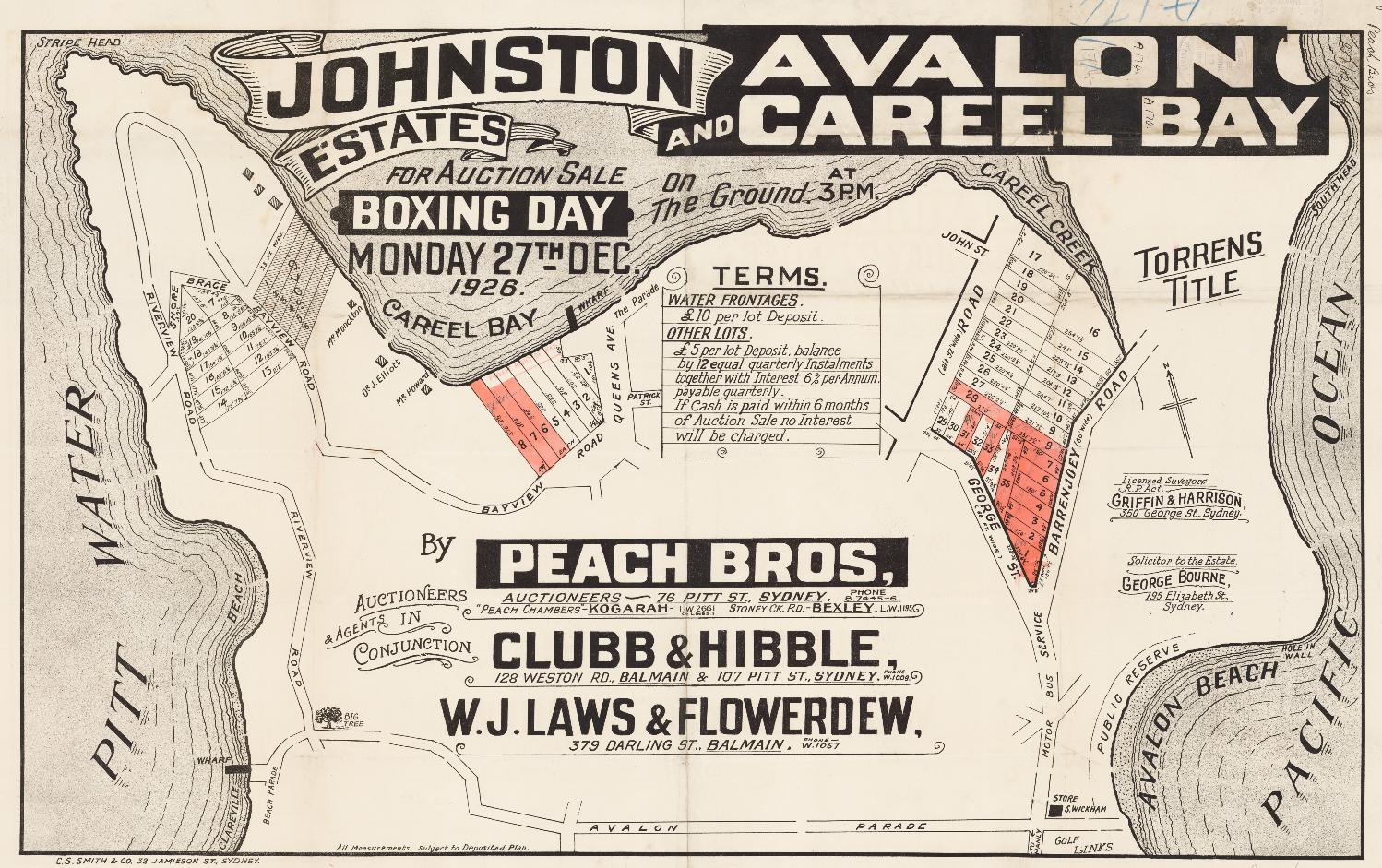
Johnston Estate 1926, showing Riverview road, Shore Brace, Bayview, Queens Avenue, Patrick Street, The Parade, George Street - and NEWLY formed Elvina Avenue Herbert J Fitzpatrick - (but no Lewis street as yet - Fitzpatrick Subdivisions - See Scotland Island Street Names) Item c027560023, Pittwater Subdivisions folders, courtesy State Library of NSW
AVALON-CAREEL
THREE ESTATES AT ONCE
Three separate estates at Avalon and Careel Bay are to be sold by Messrs. Peach Bros, (in conjunction with Clubb and Hibble, and Laws and Flowerdew), next Monday.
They are linked together by the title of Johnston Estates, but are separate, and strung across the Barrenjoey Peninsula, between Avalon and Pittwater. There are 14 allotments in the section situated on the narrow strip which juts Into Pittwater and terminates at Stripe Head. They overlook the broad sheet of water, and are Within 100 feet of it. The second wayside estate has actual water frontages to Careel Bay. There are eight of these, with big depths of nearly 400 feet, which gives them other frontages to Bayview-road and Queen's-avenue as well. The Avalon offering is situated slightly north of the beach, on a rising slope which gives wonderful views across Pittwater, as well as down the southern coastline. This is the bigger section, its 34 allotments having frontages of from 40 to over 100 feet. Deposits for water frontages are £10. per lot, and for others £5 per lot. AVALON-CAREEL (1926, December 24). The Sun (Sydney, NSW : 1910 - 1954), p. 2 (FINAL EXTRA). Retrieved from http://nla.gov.au/nla.news-article224119171
On the above you can see the placement of the homes of the Monckton, Elliott and Howard lands. Mr. Howard was married to a daughter of the same Frederick Smith who bought a farm lot and other land holdings in May 1881- specifically lots 5 and 6, section A, 3 acres 1 rood 21 perches and a Farm; lot 4, 65 acres 0 roods 32 perches, paying L247 15s 2d for the 65 acre farm
HOWARD — SMITH.— April 25th. at St. Augustine's Church, Neutral Bay, by the Rev. G. North Ash, Harold T. Howard, third son of W. H. Howard, of North Sydney, to Mary T. J. Smith, youngest daughter of Frederick Smith, of "Alma," Belmont Rd., Mosman. Family Notices (1900, May 12). The Daily Telegraph (Sydney, NSW : 1883 - 1930), p. 1. Retrieved from http://nla.gov.au/nla.news-article237306577

Frederick Smith, Careel Bay, Pittwater - REGISTRATION OF BRANDS ACT OF 1866. (1886, January 9). New South Wales Government Gazette (Sydney, NSW : 1832 - 1900), p. 171. Retrieved from http://nla.gov.au/nla.news-article221650296
When Frederick Smith passed away Mr. Howard was placed in charge of part of his Careel Bay land holdings:
ESTATE VALUED AT £17,159.
LATE FREDERICK SMITH'S WILL
The net value of the estate of the late Frederick Smith, who resided at Alma, Belmont-road, Mosman, has been sworn for probate purposes at £17,159. By his will dated October 26, 1904, testator appointed his sons Sidney, Arthur, and Frederick, and his daughter Frances, executors, executrix, and trustees of his estate.
He bequeathed the furniture, ornaments, plate, and effects at Alma to his daughter Frances, which furniture and effects were purchased by her with her own money. He also gave his pony phaeton, harness, and all other articles of a similar nature to his daughter Frances. The house occupied by his son Frederick in Chuter-street, North Sydney, testator left to Frederick upon trust to receive the benefits, rents, or profits from it until his death, when it goes to the children. If there are no children the house becomes part of testator's residuary estate. He left the property at the corner of Alexander and Atchison streets, North Sydney, upon trust to his son Francis, and the property in Glover-street upon trust to his son Arthur for life, both upon the same terms as that provided in the case of the be quest to the son Frederick.
He left certain property at Careel Bay, Pittwater, to his son-in-law, Harold Trotman Howard, absolutely, and the remainder of his Careel Bay property to all of testator's children as joint tenants.
He left £50 to the North Shore Hospital, an annuity of £200 to his daughter Frances, an annuity of £150 to his friend Rosalie Grigg, and an annuity of £50 to his daughter Isabella, now Isabella Reed. The residue of real and personal estate to be held in trust for the children after due provision has been made for the paying off of certain mortgages. In a codicil dated March 31, 1908, testator revoked his former provision In the matter, of the trustees, executors, and executrix, and appointed In their place his son-in-law, Harold Trotman Howard, in conjunction with testator's son Arthur and daughter Frances. He further provided that in the event of Rosalie Grigg predeceasing his daughter Frances the annuity of £150 should go to Frances, while the annulity of £50 payable to Isabella Reed is to go to the daughter May Howard in the event of the annuitant predeceasing May Howard. ESTATE VALUED AT £17,159. (1914, July 7). The Sun (Sydney, NSW : 1910 - 1954), p. 1 (FINAL EXTRA). Retrieved from http://nla.gov.au/nla.news-article229855290
LATE MR. FREDERICK SMITH.
Old North Sydney resident.
The lute Mr, Frederick Smith, who died at his residence, Belmont-road, Mosman, on Wednesday, was one of the oldest identities of North Sydney. He had reached his 83rd year, and the greater part of this long life was spent in that district, where, until recently, he was a familiar figure at most public gatherings. His interest in local office was shown in his participation in public duties. Prior to the amalgamation of the old municipalities of Victoria, St. Leonards, and East St. Leonards into the present North Sydney in 1890, he was Mayor and Alderman of Victoria, which was that area around M'Mahon's Point, Blue's Point, Lavender Bay, and Bay-road. In the united council, he sat for six years, then giving place to a younger man. He was one of the oldest Masons of the northern suburbs, having been Initiated into the mysteries of the Order about 50 years ago, and was associated with the first lodge established on the North Shore in 1867. He was also a foundation member of Lodge Samaritan, formed in 1874, subsequently occupying the chair. His interest in the craft was very keen, and fit the meeting of the latter lodge in April last, he was presented with a framed photograph of himself, to mark the members' appreciation of his services. As a member of the committee of the North Shore Hospital, he did good work, besides taking an interest in charitable movements generally. The funeral took, place at Gore-hill Cemetery yesterday afternoon, in the presence of a large and representative gathering. The burial service' was read by tile Rev. G, North Ash, and following It, extracts from the Masonic ritual were lead by Wor. Bro. Hall (Lodge Samaritan), accompanied by the usual riles of the Order. The chief mourners were:— Messrs. Frederick, Francis, Sidney, and Arthur Smith (sons), Howard (son-in-law), and amongst the others present were Ald. Anderson (Mayor of North Sydney), and other representatives of the council, Captain Green (representing the North Sydney Orphans), Wor. Bros. V. E. Neilly (W.U.), and F. S. Murco (secretary), and officers and brethren ot Lodge Samaritan, and representatives of St. Leonards. Mosman, Ku- ring-gal, Lawson, Empress of India, and other lodges. LATE MR. FREDERICK SMITH. (1914, May 15). The Daily Telegraph (Sydney, NSW : 1883 - 1930), p. 11. Retrieved from http://nla.gov.au/nla.news-article238801150
It is Mr. Howard, a Surveyor whose main address is at ''Lincoln'', Kenneth-street and Belcote-avenue, Longueville, who on August 26, 1918 has correspondence dated 8/8/18, is recorded in Warringah Shire Council records, on behalf of seven owners at Careel Bay, who is asking council to take steps to have an obstruction across old road way leading from Stokes Point to the main Careel Bay Road removed. This was Referred to the Engineer for report, and perhaps lends insight into his 1924 objections as well.
Warringah Shire Councils' Meeting of October 21st, 1918 records Russell C. Roxburgh, 17/10/18, re notice to W. H. Monckton to remove fence from road at Careel Bay and a notice to Dr. Elliott to remove fence from road at Careel Bay; Consideration was deferred-until next meeting.
On November 4th, 1918 Howard & Company, 22/10/18, are submitting a plan of a proposed subdivision of land at junction of Careel Bay Road and Barrenjoey Road. It was Resolved, on the motion of Councillor Atkin, seconded by Councillor Sturman, that the plan be approved.
In July 1926, Mr. Howard died, at a relatively young age:
HOWARD -July 27, 1926, at his residence, Lincoln, Kenneth street, Longueville, Harold Trotman, beloved husband of Mary Howard, aged 53 years By request no flowers.
HOWARD.-the Relatives and Friends of the late Mr. HAROLD TROTMAN HOWARD are informed that his Funeral will leave his leave residence, Lincoln, Kenneth street, Longueville, THIS WEDNESDAY, at 9.45 a.m., for Church of England Cemetery, Northern suburbs. Motor funeral. By request, no flowers. WOOD COFFILL LIMITED, Motor Funeral Directors.
HOWARD-MASONIC-The Members of LODGE LANE COVE, No 338, are requsted to attend the funeral of the late Bro. H. T. HOWARD: to leave his residence at 9.45 o'clock THIS MORNING. E.L. TRISTRAM W.M. E. H. THORNTON, Sec. ,
HOWARD.-MASONIC- The Members of the LANE COVE ROYAL ARCH CHAPTER, No 567, S.C. are requested to attend the Funeral of the late Comp H. T. HOWARD; to leave his residence at 9 45 o'clock THIS MORNING. R. H. WHITEHOUSE, M E Z, C PEARSON SHAW, Scribe E. Family Notices (1926, July 28). The Sydney Morning Herald (NSW : 1842 - 1954), p. 12. Retrieved from http://nla.gov.au/nla.news-article16309211
His wife then had to deal with:
Notice under Section 11 of the Bankruptcy Act, 1898. In the Supreme Court of New South Wales. (26,159)
IN BANKRUPTCY.
Re The Estate of Harold Trotman Howard, deceased, late of Lincoln, Kenneth-street and Belcote-avenue, Longueville, surveyor, and carried on business with John Noble Rogers, as Howard & Rogers, at Lom bard Chambers, 107 Pitt-street, Sydney.
NOTICE is hereby given that a Sequestration Order has this day been made against the abovenamed bankrupt, on the petition of the executrix of the will of Harold Trotman Howard, deceased, and Mr. C. F. W. Lloyd appointed to be the Official Assignee.—Dated at Sydney, this 11th day of January, 1927.
N. C. LOCKHART,
Registrar in Bankruptcy. IN BANKRUPTCY. (1927, January 14). Government Gazette of the State of New South Wales (Sydney, NSW : 1901 - 2001), p. 200. Retrieved from http://nla.gov.au/nla.news-article220227488
The Estate of HAROLD TROTMAN HOWARD (deceased), late of Longueville, and carried on business with John Noble Rogers as HOWARD and ROGERS, at Lombard Chambers. 107 Pitt St., Sydney, Surveyor (No. 261»9), a first account and plan of distribution, showing, payment of a dividend of elevenpence and five-sixteenths of a penny in the £ on all proved concurrent claims. Advertising (1927, September 19). The Daily Telegraph (Sydney, NSW : 1883 - 1930), p. 22. Retrieved from http://nla.gov.au/nla.news-article247931819
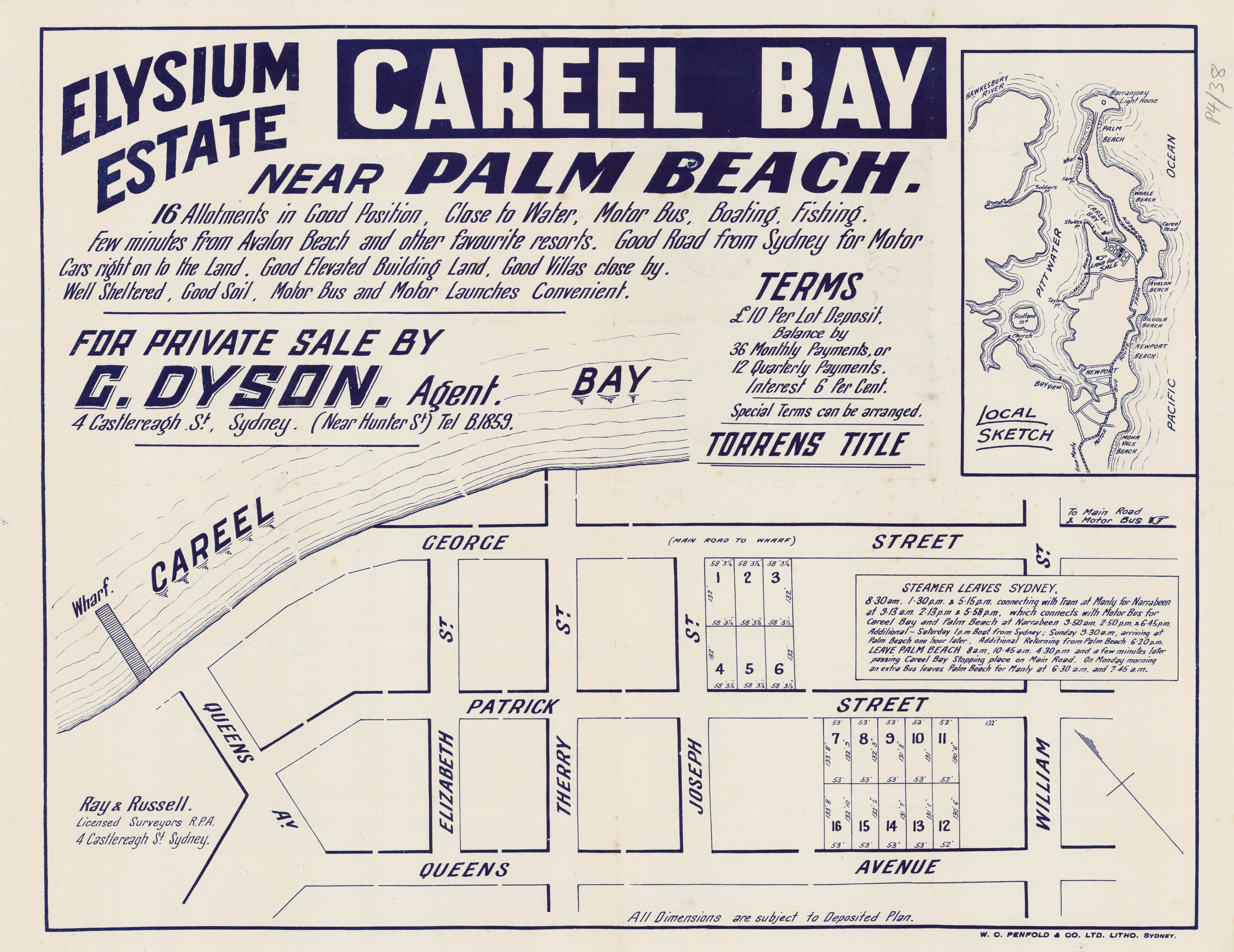
THE WORLD'S WANTS REAL ESTATE - HOMESITES FOR SALE CAREEL BAY, ELYSIUM ESTATE This Estate Is Just opened up. It Is situated In the midst of picturesque surroundings, and offers Ideal opportunities for home or week-end bungalow sites. Numerous Lots to Choose From torrens title. Surrounded by every facility, close to surf, booting, fishing, end within cosy distance of the famous Avondale Golf links. MOTOR 'BUS PASSES THE ESTATE. KEENLY PRICED BLOCKS, VERY EASY TERMS. BUT DIRECT FROM THE OWNER, AND SAVE MONET. A. C. McEWAN 308 ENMORE ROAD, ENMORE. . Right at the Tram Terminus. 'PHONE, L1708. 1 Please forward me, without obligation, full particulars of your Elysium Estate. NAME | ADDRESS .. .. .. J' I DATE .. .. .. .. .. Advertising (1928, December 2). The Sun (Sydney, NSW : 1910 - 1954), p. 24. Retrieved from http://nla.gov.au/nla.news-article223253467
The Phillipson land holdings underline 'Careel Bay' as stretching from McKay Reserve Palm Beach to Careel Bay surround by Careel Head on the east and Stokes Point on the west and Warringah Shire Councils' ethos of requiring reserves to be set aside and purchasing lots of land in some places to facilitate larger holdings for the community. Mary Constance Carruthers was born in 1896, in Perth, Australia, to Walter John Phillipson and Rose Ann Phillipson (nee McKenzie). Her father was a son of Jonas Moses Phillipson and Matilda Constance (Goldsmid) Phillipson, early settlers in Adelaide, South Australia, who also had vast land holdings.
Her father passed away in 1923: PHILLIPSON. — On the twenty-fifth (25th) January, at Domain road, South Yarra, Melbourne, Walter John, second son of the late J. M. and M. C. Phillipson. Family Notices (1923, January 27). The Register (Adelaide, SA : 1901 - 1929), p. 8. Retrieved from http://nla.gov.au/nla.news-article63831524
Her mother owned:
No. 25,430. Rose Ana Phillipson, 96 a. 3 r. 38 p., Block V, South Division, Pittwater Este., Shire Warringah. NOTICE UNDER REAL PROPERTY ACT. (1924, May 30). Government Gazette of the State of New South Wales (Sydney, NSW : 1901 - 2001), p. 2547. Retrieved from http://nla.gov.au/nla.news-article219978762
Later that year Mary was married to a son of a NSW Premier:
WEDDINGS.
CARRUTHERS-PHILLIPSON.
The marriage of Miss Mary Constance Phillipson, only daughter of Mrs. Phillipson, of Kinnell, Elizabeth Bay, and the late W. J. Phillipson, of Perth, Western Australia, to Dr. Douglas Gordon Carruthers, son of Sir Joseph and Lady Carruthers, Waverley, was celebrated by Rev. J. P. .S. Russell at St. James' Church, King-street, on Tuesday evening. The bridal gown was of white silk morocain and georgette, with borderings of white fur. She wore a tulle veil, encircled with orange blossom, and her bouquet was of white blooms. The bridesmaids were Miss Sybil Scharre, in rose pink georgette, and Miss Alice Carruthers, in rose pink crepe romaine. They carried posies of delphiniums, forget-me-nots, and white sweet pea, tied with blue tulle. Mr. J. B. Carruthers was best man, and Messrs. W. A. Carruthers and Eric Hull groomsmen. A reception was afterwards held at the Ambassadors, where Mrs. Phillipson, wearing a gown of black morocain, received the guests. Lady Carruthers wore a frock of mole morocain, and hat of the same shade. Dr. and Mrs. Carruthers left by the Makura for a honeymoon trip to Canada and U.S.A. Family Notices (1924, November 21). The Sydney Morning Herald (NSW : 1842 - 1954), p. 5. Retrieved from http://nla.gov.au/nla.news-article16170017
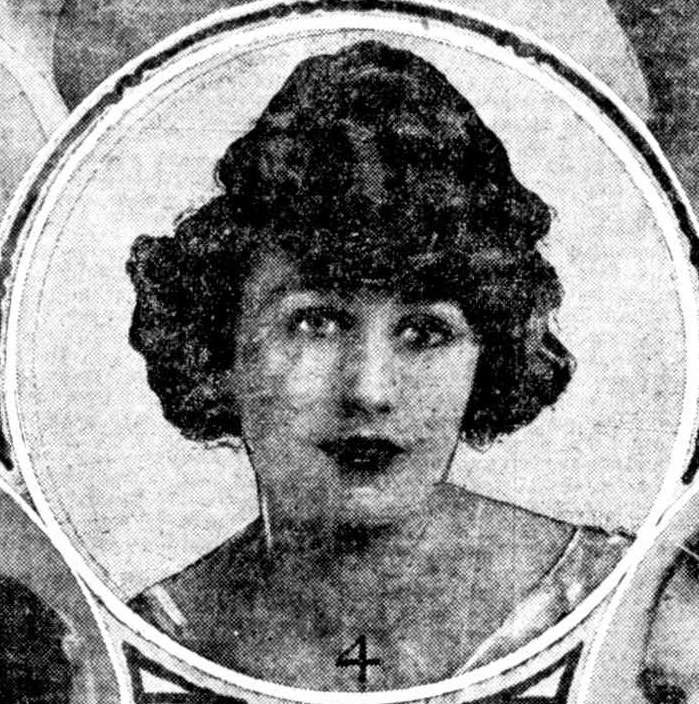
(4) Mrs. Douglas Carruthers (Miss Phillipson), who was married on Tuesday evening. (Monte Luke.) Society (1924, November 23). Sunday Times (Sydney, NSW : 1895 - 1930), p. 6 (Social and Magazine Section). Retrieved from http://nla.gov.au/nla.news-article128152518
That same year Warringah Shire Council records state that on September 29th, 1924 an S. C. Calderwood, 11/9/24, is complaining of the delay in dealing with James Young’s proposed subdivision between Barrenjoey Road and Careel Bay, and asking the Council to agree to the subdivision of the higher portion of the land, and that James Young, per correspondence dated 8/9/24 is making a similar request, and offering to sell the subject land to the Council for park purposes Resolved, - (Crs. Campbell, Hewitt) That the Works Committee inspect the land and give consideration to the matter of the proposed park.
The complaint may refer to this item from the year before:
8A. H. Wolstenholme, 13/9/24 and 23/9/24. one of the Liquidators of the Barrenjoey Co. Ltd., advising that Lot 84 Beach and the residue of Lot 93, Palm Beach Estate would probably be dedicated to the Council on condition that the palm trees be preserved, and no bathing sheds be erected on the former lot- Resolved, • (Crs. Hewitt, Hitchcock) That the Council accept the two lots under the conditions mentioned, and Mr Wolstenholme be informed that the other matters referred to in his letters will receive the Council's attention, in due course. That a copy of the Engineer's report on the cost of widening the steep angle in Pacific Road, Palm Beach at the first angle from Palm Beach Road be forwarded to Palm Beach Lands, and they be informed that the Council will proceed with the work, upon receipt of their cheque for £27/10/-, which is half the estimated cost, 14, . Resolved, - (Crs. Hewitt, Hitchcock)MacGregor and Palmer on behalf of J. Young 24/11/23, submitting plan of proposed Subdivision of land in Careel Head Road, Whale Beach Estate.
James Young was one of the original Directors of the Barranjoey Land Company, a relative of Mr. Wolstenholme, who was in turn a son of Maybanke Anderson. He was a barrister by profession, served as President of Ku-ring-gai Council at one time. More under References and Notes.
The Minutes of the Warringah Shire Council Meeting of 27th October,1924 state ''The President verbally reported having interviewed Mr. James Young and submitted a letter from Mr. Young, offering to sell his 10 ¾ acres at Careel Bay fronting Barrenjoey Road for £700 on terms, namely, £50 deposit, and the balance in annual instalments of £100 each with interest at 6 ½ % on unpaid purchase money. It was resolved, - (Crs. Hewitt, Hitchcock) That the offer be accepted and the terms approved, but that the President endeavour to arrange for a smaller deposit. ''
By November 10th, 1924 a report regarding Careel Ocean Beach Estate Subdivision is being referred to the Works Committee, and the subdividers are to be asked what provision they are making for recreation area's at North Avalon. Bangalley Reserve, comprising Careel Head in old terminology, and North Avalon Headland Reserve includes lands reserved under the County of Cumberland Planning Scheme in the 1950's and subsequent open space contributions from subdivisions in the area.
The adjacent land was subdivided in 1914 as part of "Careel Ocean Beach Estate". It is presumed that the three large blocks of land that comprise the bulk of the reserve's bushland were dedicated as open space during this and subsequent subdivisions.
At the same time the President reports on the Careel Bay Park purchase from James Young and an interview he had with Mr. James Young in regard to the purchase, for public recreation purposes of that gentleman's 10 ½ acres adjoining Barrenjoey road at Careel Bay, and it was resolved that the terms arranged with Mr. Young by the President be continued, namely ''That the Council pay a deposit of £10; £60 on 1st May next, and the balance of the £700 by 14 equal half-yearly installments of £90, the first to be paid on 1st May, 1926 with interest at 6 ½ % to be paid on unpaid-balances of purchase money.''
In 1925:
NEW COMPANIES.
The following new companies have been registered in New South Wales:
City Securities, Limited. — Capital, £50,000 in £1 shares. Objects are to buy, sell, lease or otherwise deal in land, buildings and other property. First directors are T. J. Martin, Rose A. Phillipson, Mary C. Carruthers, and T. A. Thomson. Registered office Sydney, Registered March 7. NEW COMPANIES. (1925, March 10). Daily Commercial News and Shipping List (Sydney, NSW : 1891 - 1954), p. 4. Retrieved from http://nla.gov.au/nla.news-article159952523
A few years later, on September 13th, 1926 Council records that a letter from James Young, dated 3.9.26, offering ten or twelve Lots adjacent to the land at Careel Bay, which the Council acquired from him for a park, at £1 per foot on five years' terms, with interest at 6 per cent, was read. It was Resolved, (Crs. Simpson, Hope) ''That if he will sell the land with not less than 500 feet frontage for £500, on satisfactory terms, the Council agree to purchase it, and it be left with the President to negotiate with him in regard to the terms.''
On October 11th, 1926 Council Records regarding the Careel Bay Park Extension note that a F. T. Jeffery, 30.9.26, is offering to sell twelve lots in Palm Beach Extension Estate, as an addition to Careel Bay Park Reserve and that Miss C. Phillipson (Mrs. Carruthers) has written in correspondence dated 8.10.26 about the purchase of her land at Careel Bay, and asking for a Deposit of £25, whereon it was Resolved,that a deposit of £25 be paid.
A fortnight later, on the 26th of October, 1926, the Careel Bay Park Extension arises again with the recommendation to purchase Lots 60, 80A, 81A and 82 to 89, for £600 Cash, for the purpose of extending the Careel Bay Park, be adopted, provided the two sold lots, namely Lots. 80B and 81B be also acquired.
F. T Jeffery is an Estate agent involved in selling The Boulevarde Estate in conjunction with Hardie and Gorman along the main road and shop sites at Newport in 1929 and the Hollywood Estate at the same place later on. A son is born at Newport in 1928 and named 'Gerald'.:
CLAIMS OF PITTWATER.
Mr. F. T. Jeffery, secretary of the Warringah Direct Transport League and president of the Newport Progress Association, stated last night that local interests would suggest to the authorities that Pittwater should be chosen for the flying-boat base. Various local organisations had approved the proposal.
Pittwater, Mr. Jeffery stated, was an Ideal site. From Bayview to Barrenjoey was six miles, with an average width of water of one mile. Between Newport and Church Point there was a run of two miles, and the flat country extending to Mona Vale offered no obstacles to machines climbing up from the water. Moreover, the site was well protected from winds. CLAIMS OF PITTWATER. (1937, July 9). The Sydney Morning Herald (NSW : 1842 - 1954), p. 11. Retrieved from http://nla.gov.au/nla.news-article17391717
Mr. Jeffery went on with his campaign for green spaces locally:
Newport Progress
"Taxpayer's" letter ("Sun,' Mar. 4), protesting against the proposed resumption of allotments on the Woolcott Estate, Newport, calls for an immediate reply. Warringah Shire Council is acting in this matter following a petition signed by 275 Newport residents for the resumption of the land which is badly needed as a general sports ground, a playing field for school children and a site for a community centre. Newport is a rapidly growing centre, but because of bad planning in the early days it has no adequate recreational area. School children have no playing field apart from the sloping school grounds which are rapidly becoming built upon and school attendance has doubled in the past seven years. The land in question, is largely inferior and a considerable area is swampy, and this is under embargo for building by the Board of Health The proper draining and reclamation of this area would, in itself, be sufficient reason for the proposed resumption.
F. T. Jeffery, president, Newport Progress Association. Newport Progress (1946, March 7). The Sun (Sydney, NSW : 1910 - 1954), p. 4 (LATE FINAL EXTRA). Retrieved from http://nla.gov.au/nla.news-article228788828
You can read more about the Careel Bay Reserves and Playing Fields in: Careel Bay Playing Fields Reserve - Including Hitchcock Park: Birds, Boots & Beauty
NEWPORT Whale Beach fronting Careel Head road -Vacant Land Lots 36 to 41, Phillipson's Estate, each about 56ft x 165ft TORRENS TITLE. Also Lots 23 to 20, fronting Whale Beach-road each about 50ft X 100ft «in, Lot 27 having a frontage of about 110 feet TORRENS TITLE. Under instructions from Mortgagee … Advertising (1930, November 27). The Sydney Morning Herald (NSW : 1842 - 1954), p. 3. Retrieved from http://nla.gov.au/nla.news-article16733641
FORTHCOMING AUCTION SALES.
Richardson and Wrench, Ltd., will include in their list for Friday, June 2, the following properties: ....Careel Head, Rayner road, off Whale Beach-road, vacant land, lots 110, 111, and 112. Phillipson's subdivision: Careel Bay, fronting Barrenjoey-road near Whale Beach-road, lot 102, Phillipson's sub-division; REAL ESTATE. (1933, May 27). The Sydney Morning Herald (NSW : 1842 - 1954), p. 8. Retrieved from http://nla.gov.au/nla.news-article16985206
PHILLIPSON.—March 5, 1935, at 589 New South Head-road, Rose Bay, Rose Anna Phillipson, mother of Mrs. D. G. Carruthers in her 63rd year. Family Notices (1935, March 6). The Sydney Morning Herald (NSW : 1842 - 1954), p. 12. Retrieved from http://nla.gov.au/nla.news-article17143373
PHILLIPSON.--The Funeral of the late ROSE ANA PHILLIPSON, of Rose Bay, took place privately in Church of England Cemetery, South Head, YESTERDAY, 6th March, 1935. CHARLES KINSELA, Motor Funeral Director, Oxford-street, Taylor-square, Darlinghurst. Phones, FL4136-7-8. Family Notices (1935, March 7). The Sydney Morning Herald (NSW : 1842 - 1954), p. 9. Retrieved from http://nla.gov.au/nla.news-article28016921
Rose ‘Ana’ had extensive holdings at Blacktown and the Blue Mountains as well, with many Rates Notices showing up with her name, in conjunction with others, for decades after she passed away. Her daughter also turns up with more land holdings at Careel Bay-Whale Beach about to be sold due to unpaid Rates:
OVERDUE RATES.—Shire of Warringah.—Land to be Sold for Default.—The following persons are required to take notice that the Council of the Shire of Warringah has applied to the Public Trustee to sell the land specified below against their names, of which they appear to be the owners or in which they appear to be interested for overdue rates, amounting to the sums mentioned in each case, and that in default of payment forthwith to the Public Trustee of the said rates and all interest charges and expenses in connection with the said applications and proceedings by the Public Trustee, the raid land will be offered for sale at public auction by Messrs. Weight & Yonge, Auctioneers, of Dee Why, in conjunction with Beach Estates Pty. Limited, at 2.30 p.m. on Saturday, 1st September, 1951, at Glendowie Hall, The Strand, Dec Why, on behalf of the Public Trustee:—
Mary Constance Carruthers, of Sydney, and Jack Kenny, of Narrabeen; overdue rates, £54 17s. 9d.; land, lot 52, d.p. 11,900, Barrenjoey-road, Careel Bay. OVERDUE RATES.—SHIRE OF WARRINGAH.—Land to be Sold (1951, June 29). Government Gazette of the State of New South Wales (Sydney, NSW : 1901 - 2001), p. 1919. Retrieved from http://nla.gov.au/nla.news-article220110458
Mary passed away on September 11 1972, at age 76, her address given as 4 St Mervyns Avenue, Point Piper in her Probate Notice. Her husband, Douglas Gordon Carruthers, is named the executor of the will.
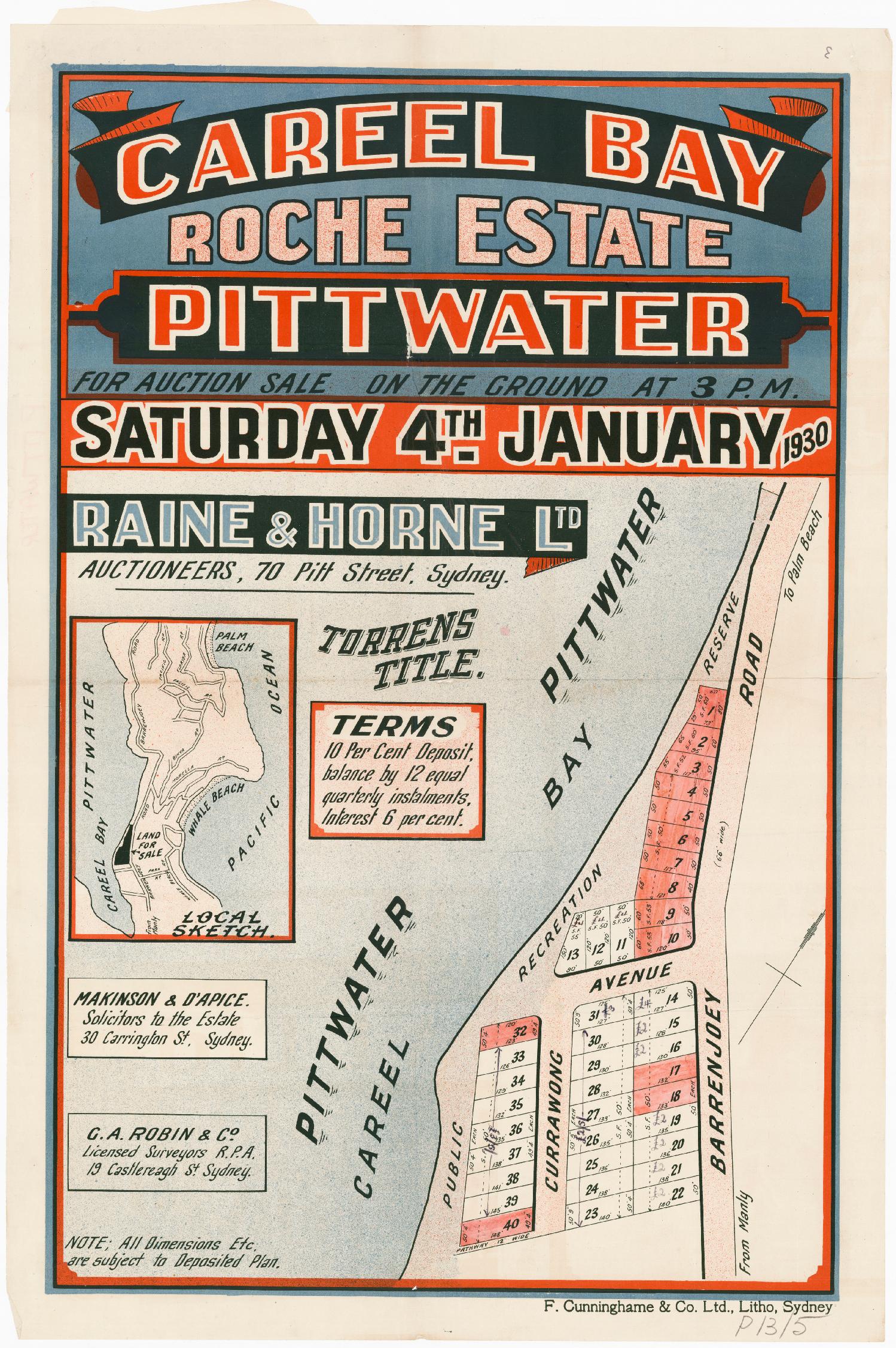
REAL ESTATE ON PITTWATER - CAREEL BAY SITES MAIN ROAD FRONTS
Situated between the main Barrenjoey-road and the waters of Careel Bay, the Roche Estate, Pittwater, will be sold by auction on the ground to-morrow by Messrs. Raine and Horne. Many of the allotments have frontages to the main road, as well as to the recreation reserve, which fringes the bay. Most are about 50 feet wide, with depths of from 120 to 140 feet. The estate Is on the narrow neck of the peninsula almost opposite Whale Beach, and commands views over a wide stretch of Pittwater It is handily placed for yachtsmen who cruise on this broad sheet of water, for moorings could be laid directly In front of these homesites. Terms of sale will be 10 per cent, deposit. and the balance in three years. REAL ESTATE (1930, January 3). The Sun (Sydney, NSW : 1910 - 1954), p. 7 (CRICKET STUMPS). Retrieved from http://nla.gov.au/nla.news-article226025936
Warringah Shire Council Minutes of Meetings record that on December 3rd 1927 Plans and specifications of Mrs Roches' proposed subdivision of Mrs Roche's property in Barrenjoey. Rd, Careel Bay were submitted and referred to the Engineer. On September 3rd 1928 amended plans by Scott & Scott were approved subject to the roads being constructed, and a turning point being made at the dead-end of the road.
Warringah records show that on February 10th, 1930, as recommended by the Engineer, the road work on Roche's Estate, Careel Bay, be finally passed as satisfactory. By June of the same year G.A.Robin & Co. 20/6/30, were submitting, for affixing of Council's Seal, the Deposited Plan of Roche's Subdivision, Careel Bay. The Council Resolved that the Seal be affixed upon the Engineer certifying the permanent marks.
While all this was going on it seems one proprietor was making use of the land for those streaming north for Summer holidays as on December 30th, 1929 a Mr. M Wicks was asking permission to erect a portable stand for trading on Roche's Estate, Careel Bay - owner's permission has been given. Mr.Wick's application to erect an immovable stand on Roche's Estate, Careel Bay was granted during the Council's pleasure on the motion of Cr.Parr , seconded by C.Austin.
Katherine Roche was the youngest daughter of John and Honorah Collins, married June 12th, 1847, known by many as the 'father of Pittwater'. Her eldest son, John Roche, was known as 'the soul of Pittwater' as well as 'father of the Pittwater Regatta’.
Whiffs From Pittwater - JOHNNY ROCHE celebrated his twenty-third year of office as secretary of Pittwater Regatta on Saturday, but there was a whisper round Newport and Bayview after the termination of the carnival that the 'soul of the district' will not be a candidate for the office next year. Johnnie's burdens have been mounting up in recent years and he feels that it is up to somebody else to take up the work of running a gigantic aquatic gala. Whiffs From Pittwater. (1929, December 31). Sydney Sportsman (Surry Hills, NSW : 1900 - 1954), p. 13. Retrieved from http://nla.gov.au/nla.news-article166465144
This lady had to make hard decisions, run a small empire and look after young children when widowed as well as cope with one of the earliest confirmed cases of polio in Pittwater. Records indicate one of the two sons of her elder sister Ellen may also have been inflicted.
Katherine should also be credited with the fact that we have a Bayview recreation area, which those who came after her times may not be aware of. Her generosity, a nature that was intrinsic in succeeding generations of Collins and Roches, proved a dedication to giving to and doing for others even during your own testing times was part of these families nature.
Warringah Shire Councils policy of acquiring land, or requiring lands to be dedicated for open space for recreation and reserves of bushland was also a major part of ensuring these pockets of green and places for wildlife were set aside and it is to this that we owe those spaces we still have today.
Katherine was the daughter of two people from Cork, Ireland - a coastal part of Erin where sailing, rowing, fishing or being part of a landscape that meets the seascape is part of life. The valley of Avalon could have reminded the Collins family of home and as Jeremiah Collins, father of John, had been evicted from his holding of 50 acres on the ESTATE OF PIERCE NAGLE, ANNAKISSY in 1839, a way to keep themselves independent of such experiences would have made Katherine's father determined to own land here.
Interestingly Pierce Nagle was the nephew of Nano Nagle(christened Honora), founder of the Presentation Order of Nuns, a forerunner of schools for the poor, and a name which would be given to Katherine's youngest daughter.
‘In the midst of life we are in death' was sadly illustrated in the case of Mr. John Collins, of Pittwater, on Friday night, the 20th inst. Mr. Collins came up the Sunday before to attend the sale of the Pittwater estate, which took place on the 16th inst., his 66th birthday. From Monday to Friday he was making arrangements with a contractor for the erection of a cottage on one of his farms. Returning from Sydney on Friday evening by the half past 5 boat he fell overboard at Lavender Bay wharf, through, it is supposed, the bumping of the steamer against the piles. Owing to the noise of the engine the accident was not observed on the instant, and some short time had elapsed before Captain Butler, who has saved scores of lives from drowning, plunged in to the rescue. He soon brought Mr. Collins on board and proceeded with his steamer to Milson's Point, when he placed him in a cab which conveyed him to his brother-in-law's (Mr. Connolly), the Union Inn. Father Kennedy, S.J., and Dr. V. Browne were immediately in attendance, and both had strong hopes of his recovery until about 1 o'clock at night, when capillary bronchitis supervened. The deceased gentleman was an old colonist, having emigrated from Cork with his parents about 50 years ago. He was well known and widely respected, not only in Pittwater, where he was regarded as a patriarch, and where he resided for upwards of forty years, but also in the North Shore and in Sydney. He was a man of sterling principle, so fond of the right that he would not do wrong deliberately for a kingdom. He had a great contempt for the worldliness, avarice, and selfishness so characteristic of the present times, his own character being the very antipodes of these. On Monday morning a Requiem Mass for the repose of his soul was celebrated by Father Kennedy in the church of St. Mary Star of the Sea. The respect in which Mr. Collins was held was testified by the numbers of all classes who attended his funeral, which was the largest of any private funeral that has taken place here for the last twenty years. He leaves a widow, four sons, and a daughter, all, except one of the sons, living in Pittwater. May his soul rest in peace. ST. LEONARDS. (1881, May 28). Freeman's Journal (Sydney, NSW : 1850 - 1932), p. 10. Retrieved from http://nla.gov.au/nla.news-article115457523
The Collins stayed in Pittwater, now land-owners at Careel Bay. On 8 September 1881 Honorah Collins purchased from Therry’s estate the 80 acre grant at Bayview, next to Winnyjimmy Swamp, for £80, which was the market value of the land at the time. [LTO Book 229 No. 144] Honorah and her daughter Katherine lived at Bayview, Katherine taking on the duties of Post Mistress to the growing Bayview area on 21 August 1882. - PROFILES OF THE PIONEERS IN MANLY, WARRINGAH AND PITTWATER by Shelagh Champion, OAM, B.A.(Lib.Sc.) and George Champion, OAM, Dip.Ed.Admin. Revised 2013.
Soon afterwards Katherine married:
ROCHE—COLLINS.—April 18, at the residence of the bride's mother, Rockvale, by the Rev. Dean Hanly, James Joseph, youngest son of John Roche, Esq., County Cork, Ireland, to Katherine M., youngest daughter of the late John Collins, Esq., of Pittwater. Family Notices. (1883, May 24). The Sydney Morning Herald(NSW : 1842 - 1954), p. 1. Retrieved from http://nla.gov.au/nla.news-article13535436
They had six children: John (born 1884 - October 15, 1936) Elizabeth Ellen ( February 5th 1886 - 8 Apr 1979) Mary Honorah (Born 1888 - 26 Jul 1979) Katherine Agnes T (born 1889 - 13 Jul 1976) Nano E (1892- 29 Sep 1979) Francis Michael G (Born 1895).
Katherine's mum passed away and James lost his brother in the same year:
ROCHE -March 21,1897, John Roche, Q.C., of Summerville, Cross-avenue, Dublin, late Co. Court Judge for Down, eldest son of the late John Roche, Co. Cork, and brother of J. J. Roche, Bayview P.O., Pittwater. Family Notices. (1897, May 22). The Sydney Morning Herald(NSW : 1842 - 1954), p. 1. Retrieved from http://nla.gov.au/nla.news-article14121702
ROCHE.—In loving memory of John Roche, Q.C., who died at his residence, Summerville, Dublin, 23rd March, 1897, late County Judge for Down, eldest brother of J. J. Roche, Bayview, Pittwater. R.I.P. Family Notices. (1899, March 23). The Sydney Morning Herald(NSW : 1842 - 1954), p. 1. Retrieved from http://nla.gov.au/nla.news-article14205814
DEATH OF MRS. COLLINS. Full of years spent worthily, Mrs. Honora Collins relict of the late John Collins, died on the 20th instant the residence of her son-in-law, Mr. J. J. Roche, Bay View, Pittwater. For more than half a century she had lived at Pittwater, and no family was better known or more highly respected than the Collins family of Careel Bay. Mr. and Mrs. Collins were natives of the County Cork, whence they emigrated 60 years ago. Soon after their arrival in the colony they settled on Father Therry's grant at Pittwater, where Mr. Collins engaged in grazing and farming. The district has always been a great health resort. Many an invalid from Sydney recruited his health at the hospitable homestead of the Collins family. The cottage was flanked by two hills, named Mount St. Joseph and Mount St. Mary by Mr. Collins. It is told of him that he would allow none of his sick guests to leave until he saw that they were completely 'on their legs,' his test for which was a given time to ascend and descend these hills before breakfast. The remains of the deceased lady were brought on the 21st from Bay View to St. Mary's, North Sydney, where Masses were said for the repose of her soul. The funeral took place at Chatswood Cemetery, the family burial-place, the same day. The chief mourners were Mr. J. Collins, of the Harbours and Rivers Department; Mr. P. Collins (sons); Mr. J. J. Roche, son in-law; Messrs. J. T. and E. P. Swanson, nephews. Among others present were Mrs. Black, of Barrenjoey Customs Station, Mrs. Midden, Mrs. Roche, Mrs. Earl, Mrs. Robertson, Mrs. F. Collins, Mrs. P. Collins, Messrs. D. J. Glacken, M'Teague, J. Wall, J. Crowley, H. Coyle, J. Macintosh, and Boulton. The Rev. Father Dowling, of St. Patrick's College, Manly, attended Mrs. Collins during her last illness, and officiated at the grave. May her soul rest in peace. DEATH OF MRS. COLLINS. (1897, October 30). Freeman's Journal (Sydney, NSW : 1850 - 1932), p. 16. Retrieved from http://nla.gov.au/nla.news-article115471628
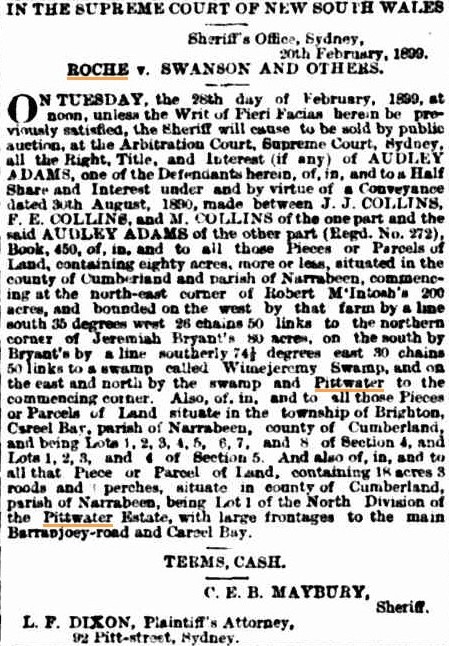 Audley Adams tries selling property out from under Katherine. Imagine finding this in the paper!
Audley Adams tries selling property out from under Katherine. Imagine finding this in the paper!SWANSON. — At her father's residence, Pittwater, on the 6th instant, Ellen, the beloved wife of Charles Swanson, Esq., and eldest daughter of John Collins, Esq.,aged 26. Requiescat in pace. Family Notices. (1874, October 10). Freeman's Journal(Sydney, NSW : 1850 - 1932), p. 8. Retrieved from http://nla.gov.au/nla.news-article11547820
SWANSON — On April 7th, at Forbes, Charles John Swanson, son-in-law of John Collins, Pittwater, aged 39 years. Requiescat in pace. Family Notices. (1878, April 20). Freeman's Journal (Sydney, NSW : 1850 - 1932), p. 12. Retrieved from http://nla.gov.au/nla.news-article111098081
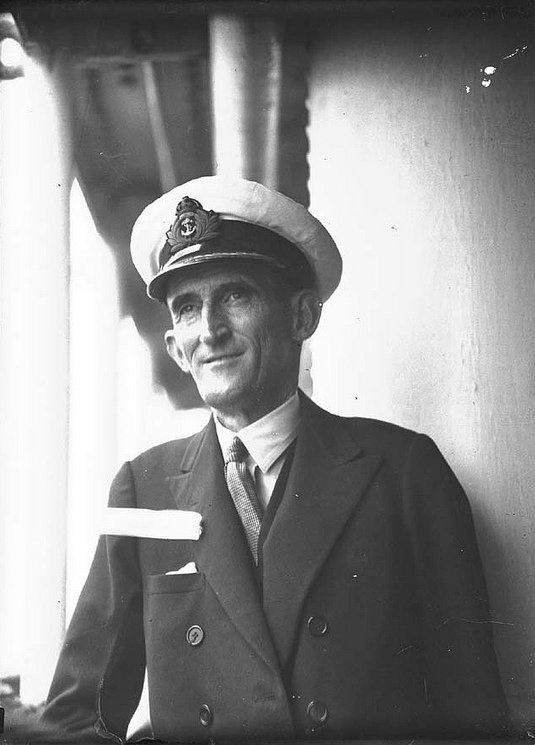 AN APPRECIATION. The 'Late' John Roche. (BY. R.S.S.)
AN APPRECIATION. The 'Late' John Roche. (BY. R.S.S.)
In the experience of everybody, we come across personalities which attract us, for reasons which often. are somewhat hard to define-or, on the contrary, for outstanding qualities, which those who run may read, or, indeed, for some special act of public usefulness, or private unselfishness.
From whatever reason, or from whatever combination of them, John Roche, who died last week, was certainly one of those rare souls, who unconsciously, and without effort, gained among his fellows, their affection and confidence. It was Just his cheerfulness, his placid courage, his elan, and fine conduct of life, which, in his case, had been, in many ways, no easy one, '
Roche was brought up, from his earliest years, on a property on the estuary of the Hawkesbury, owned by his family at Bay View. We all, in our hearts, cherish some spot of this attractive, if difficult world, which we call home, and to which, as poets so often remind us, our wandering thoughts return. John Roche's mind, I do believe, was never far divorced from his beloved Broken Bay. He knew and loved every arm of its far-flung waterways, and he used to dwell with pride on the lush and often exotic vegetation that hid itself, and flourished, in sheltered spots round the creeks of that delectable region.
It followed that he not only liked the trees and fruits of his native bushland, but it was the sea that mostly called him, and so fishing and boats and yachts, or indeed anything that would carry him on the face of the waters, gave him a joy which never paled-a Joy happily shared by many of us who have escaped the devastating malady of golf or other things even less laudable!
But, apart from the prominent positions he has held in the yachting world, and which, Indeed, have been very useful, Important, and unselfish ones in all ways, and about which others are very much more competent to speak than I am-it is rather concerning his character as a man that I would wish to add my little offering to his name and fame.
It was probably known to all who knew him intimately, that from his childhood, he suffered from the after-results of that tragic malady of early life, Infantile paralysis. Most men would have wilted under such a handicap. Not so John Roche-neither in deed, manner, nor word did lie allow his disabilities to alter his way of life.
Nor did he ever pour out useless complaints against fate regarding his own great physical drawbacks. Far otherwise was his way, for he always carried a high heart, with a happy smile, and a wholesome speech to sweeten the day's greeting.
I might write much, and with more detail, of this line man's fine record, but it is not necessary, for of those who read tills small eloge of mine, who knew him, they could themselves tell much more of things Indicative of his life-long courage in the face of many difficult, days. We part indeed from "a very gallant gentleman," and a fine sportsman. AN APPRECIATION. (1936, October 20). The Sydney Morning Herald (NSW : 1842 - 1954), p. 10. Retrieved from http://nla.gov.au/nla.news-article17268893
Left: Portrait of a Mr John Roche courtesy ANMM, Object no. 00024319.
When speaking with Peter Verrills years ago for his Profile, he too contracted polio while living at Careel Bay - fortunately Peter recovered from his battle with this disease and went on to have wonderful children who have, in turn, had wonderful children themselves - all great contributors to the Pittwater community over generations.
Although his official education states John Roche was an engineer there is also records showing he worked in real Estate in the area, and possibly looked after his mothers' interests. Soon after he passed council is trying to get her to catch up with Rates payments for various properties in her name, some showing that she inherited her brothers' Careel Bay land holdings.
Through the Collins-Roche families there is well over 100 years of connection to this place.
The Same Careel Bay Reserve Area in June 2020
Still providing estuary shoreline access:
Further Subdivisions subdivisions
CAREEL BAY-PITTWATER.
LOT- 7. OCEAN BEACH ESTATE, No. 1, about 66 feet 3 Inches to the main road-depths about 151 feet and 157 feet TORRENS.
R. N. HENDERSON and CO., 88 Pitt-street.
Solicitors to the Estate.
HARDIE and GORMAN PROPRIETARY. LIMITED will offer the above In their rooms.
Ocean House. 36 Martin-place, at 11 a.m., on
WEDNESDAY. 17th FEBRUARY.- 1932. Advertising (1932, January 23). The Sydney Morning Herald (NSW : 1842 - 1954), p. 19. Retrieved from http://nla.gov.au/nla.news-article16835787
FORTHCOMING AUCTIONS.
Hardie and Gorman Proprietary, Limited, announce that their next indoor sale will be held in the rooms on Wednesday, February 17, when a list will be submitted, including: Careel House, water-frontage home, at Palm Beach; cottage, …Main-road, Careel Bay; subdivision of 30 2/4 acres, …REAL ESTATE. (1932, January 30). The Sydney Morning Herald (NSW : 1842 - 1954), p. 11. Retrieved from http://nla.gov.au/nla.news-article16837462
Burrawong Subdivision
We have been favoured with instructions to offer for sale the Burrawong Subdivision comprising ten beautiful Building Blocks with absolute Deep water Frontages, situated in a unique position on the North eastern Shore of Stokes Point being the southern extremity of Careel Bay with a north easterly aspect looking towards Palm Beach and commanding an uninterrupted view of the Pittwater and Broken Bay. All the lots being offered for Sale are protected from the severe westerly and southerly winds and the temperature is 10 to 15 degree milder In summer than In Sydney and much warmer during the winter months. It Is one of the very few deep water frontages available In Pittwater directly facing the north east.
The name of the Estate is taken from the lovely Burrawong Palms growing In profusion on the slopes amongst stately gum trees. These deep water frontages are most attractive to boating men and yachtsmen on account, of the shelter afforded from treacherous weather there being almost perfect anchorages adjoining the Estate.
PLANS BOOKLET AND PRICE LIST
NAME
ADDRESS
TO SOLE SELLING AGENTS
J.T. STAPLETON and CO LTD
133 Pitt street Sydney Phone B7B96 12 lines)
LOCAL OFFICES AVALON and PALM BEACH. Phone Y9155. Advertising (1935, December 11). The Sydney Morning Herald (NSW : 1842 - 1954), p. 23. Retrieved June 4, 2020, from http://nla.gov.au/nla.news-article17235144
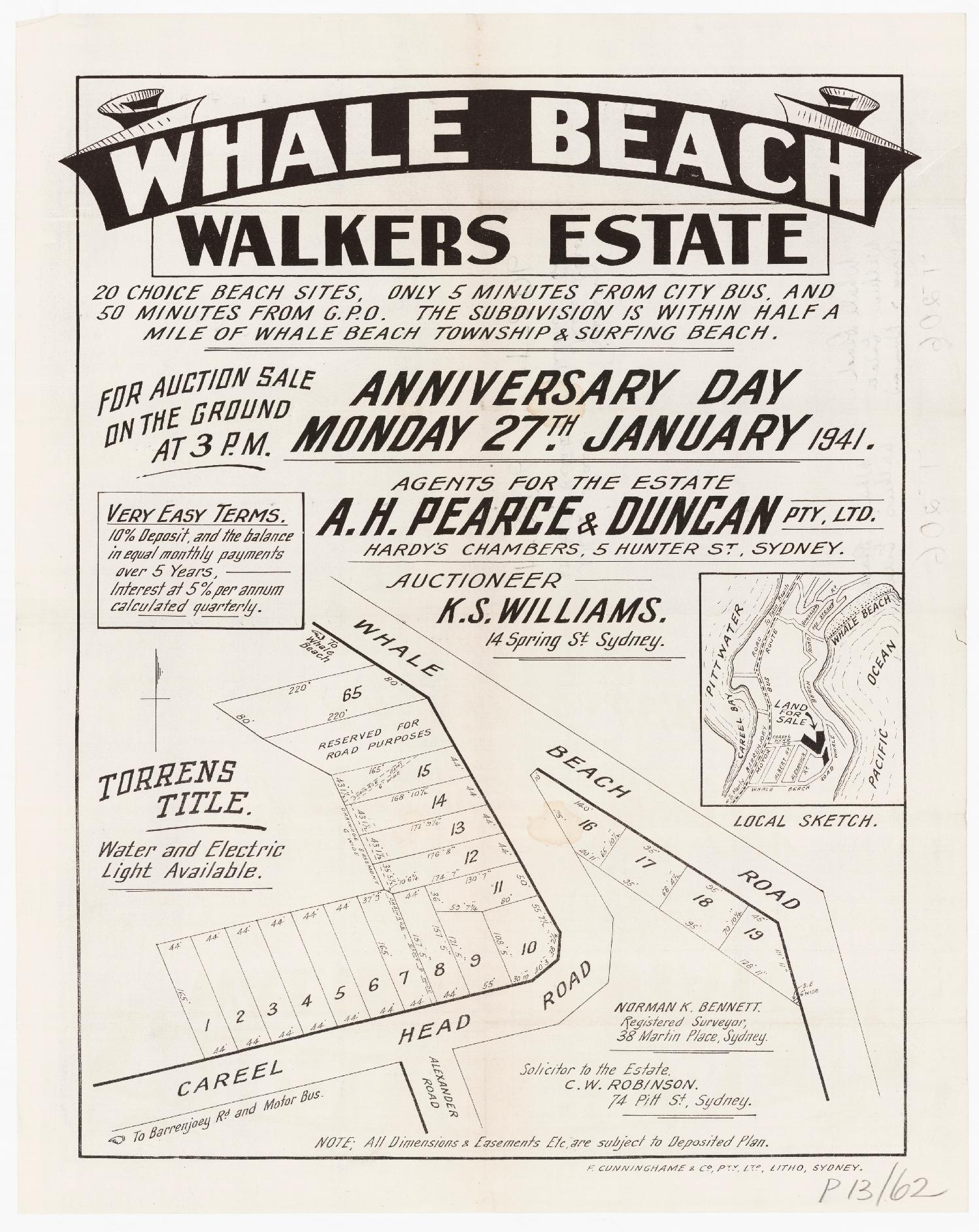
Walkers Estate 1941, showing Alexander Road Item c053460066
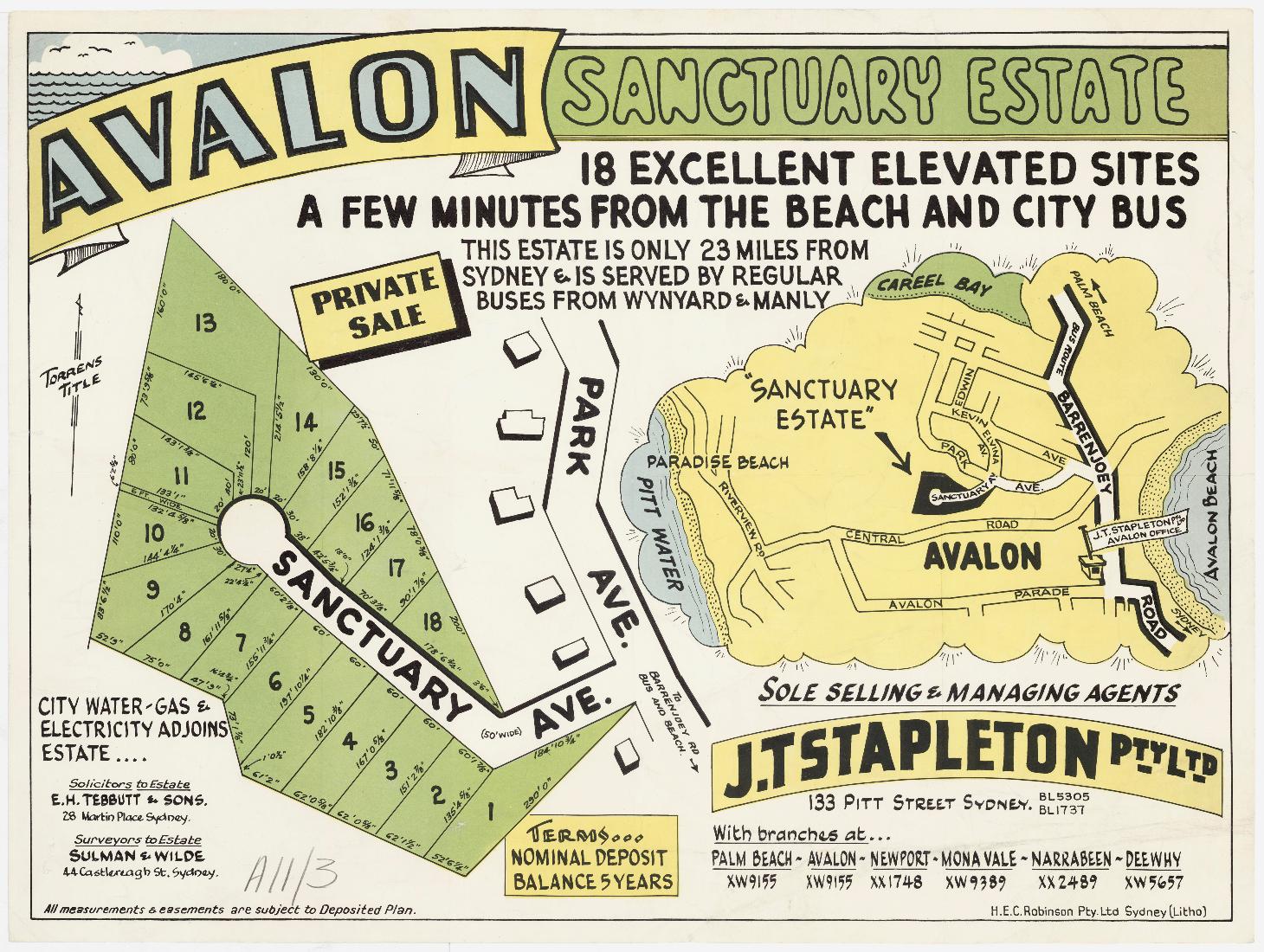
Sanctuary Avenue estate Item c027560003

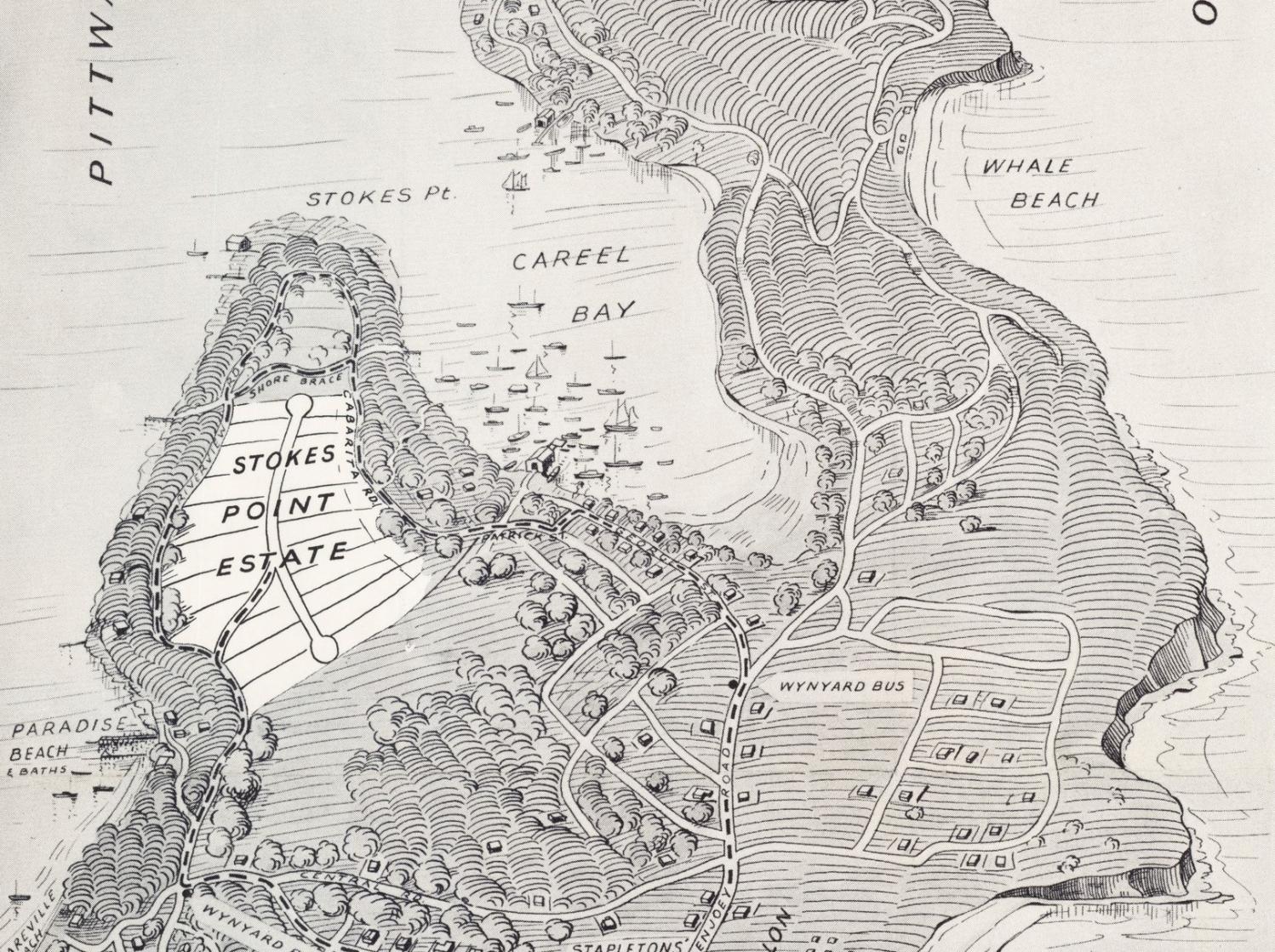
Stokes Point Estate, 1952 Item c053460052, Pittwater Subdivisions folders, courtesy State Library of NSW
CAREEL BAY PITTWATER
STOKES POINT ESTATE
75 blocks unparalleled beauty 23 miles from Sydney now available.
Magnificent views every block. Essential services. Ideal retreat among trees. Very close Pittwater Facliaties tor yachting bathing etc Inquire now. Terms available from £250 per block
SOLE AGENTS
J T STAPLETON PTY LTD
AVALON BEACH XW9155
Open Dally Incl Sat and Sun. Advertising (1952, December 27). The Sydney Morning Herald (NSW : 1842 - 1954), p. 16. Retrieved from http://nla.gov.au/nla.news-article18296488
This advertisement gives an idea of the prices being asked by 1950 as well as the sale of 4 acres owned by Charles Cole and Roy Hammond at Narrabeen for unpaid rates - both these gentlemen have an association with Careel Bay, one with the subdivision of lands and the other with the Jones dairy, of around 100 cows.
AVALON BEACH.
AVALON PDE, 4 acres and garage, £ 3000.
ALBERT ROAD. 40 c 161. £350.
ALEXANDER ST, 40 x l«, £350.
BAREENA RD. 50 X 150. £225.
BINBDRRA ROAD. 45 x 228. £125.
CAREEL ROAD, 96 X 200. £300.
CENTRAL ROAD. 50 X 150. £265,
CAREEL READ RD. cor. block. £275.
DRESS CIRCLE RD. 66 X 215. £ 500.
EDWIN AVENUE, 40 X 150. £ 225.
ETTY ALE STREET. 44 x 140. £ 275.
HILLTOP ROAD, 64 X 150. £650.
KEVIN AVENUE. 50 X 130. £225.
MARINE PARADE, 40 X 350. £300.
PALMGROVE RD. ear. block. £275.
PATRICE ST. 56 x 180. *2?0.
RIVERVIEW RD. water front. £ 1200.
THE SERPENTINE, 50 x 150. £450.
THERRY ST, 56 X 132. £ 175.
URARA ROAD. 51 X 200. £350.
Many others to choose from.
J. T. STAPLETON PTY. LTD.
AVALON BEACH.
XW9155. _ .
(Open daily Including Sat. and Sun.)
SALE OF LAND FOR UNPAID RATES
UNDER INSTRUCTIONS FROM PUBLIC TRUSTEE ON BEHALF OF THE COUNCIL OF THE SHIRE OF WARRINGAH.
NARRABEEN HEIGHTS.
Adjacent to Elanora and Monash Country Golf Club.
1. CHARLES ALBERT COLES and ROY JOHN CHARLES HAMMOND. Part Lot 1, D.P 12115. App. 2061t 9ln to Lane Cove Road, by depths of app. 216tt on one side, 9911 5'¿ In along Powder Works Rd. and a rear line of app. 240ft 9iin. Area 1acre 6rd 3.. perches. Vacant Land.
2. CHARLES ALBERT COLES and ROY JOHN CHARLES HAMMOND. Lots 14 and 15. D.P. 12115. Approx. 200ft to Lane Cove Rd. by a depth of app. 500ft, and a rear Ilse of app. 200ft. Area 2 acs. 1 rd. 7 ps. Vacant Land
3 CHARLES ALBERT COLES and ROY JOHN CHARLES HAMMOND. Lots 16 and 17. D.P. 12115. App. 200ft to Lane Cove Rd. by depths of app. 421ft on one side and 500ft along Manor Rd. Area 2 acs. 0 rd. 225 ps.
All Blocks have magnificent ocean views and frontages to tarred roads.
THE ABOVE PROPERTY WILL BE OFFERED AT PUBLIC AUCTION BY ROBEY, HANSON & STRONG PTY. LTD. IN THE ROOMS. 33 THE CORSO. MANLY. AT 11 A.M. ON SATURDAY MORNING, 13th MAY, 1950. Advertising (1950, April 22). The Sydney Morning Herald (NSW : 1842 - 1954), p. 26. Retrieved from http://nla.gov.au/nla.news-article27575724
HAMMOND— RUSSELL.
A Wedding was solemnised at St. Andrew's Presbyterian Church, Narrabeen, on Wednesday afternoon, the contracting parties being Eunice, elder daughter of Mr. J. S and the late Mrs. Russell, of 'Hillcest,' Pittwater-road, Narrabeen, and Roy, eldest son of Mr. and Mrs. C. Hammond, of Young. The Rev. Hugh Paton, assisted by Rev. C. J. Mackay, officiated.
The bride, who was given away by her father, was dressed in a dainty frock of cashmere de sole and lace, with tulle veil, and carried a shower bouquet. She was attended by her sister, Miss Jessie Russell, who wore mauve georgette, beaded in white, and carried a bouquet of yellow carnations and narcissus with mauve streamers. Mr. Clarrie Chasher was best man. The bridegroom's gift to the bride was a solitaire diamond ring, and to the bridesmaid a diamond initialled wristlet watch.
Mr. Parry was' at the organ, and while the register was being signed, Mrs. Parry sang 'Beloved, it is morn.' The church was beautifully decorated by friends of the bride. During the ceremony, the Rev. Hugh Paton presented the bride -with a beautifully bound bible, — being the first to be married in the church.
The reception was held at Twight's Hall, Narrabeen, which was decorated in the colours of the 39th battalion in which the bridegroom and best man served during the war. About 70 guests (relatives of the bride and bridegroom and & few very intimate friends, included among whom were Mr. and Mrs. B. Miller and Mr. R. Allen, of Young) were received by Mrs. Thomas Russell, aunt of the bride, who was gowned in a beaded frock of black crepe-de-chine and carried a posy of mauve lilac. Mr. and Mrs. Hammond left by car for the South Coast, where the honey moon is being spent, the bride travelling in a grey jersey silk frock with black hat and black cloak. Wedding. (1922, October 26). The Grenfell Record and Lachlan District Advertiser (NSW : 1876 - 1951), p. 2. Retrieved from http://nla.gov.au/nla.news-article112988692
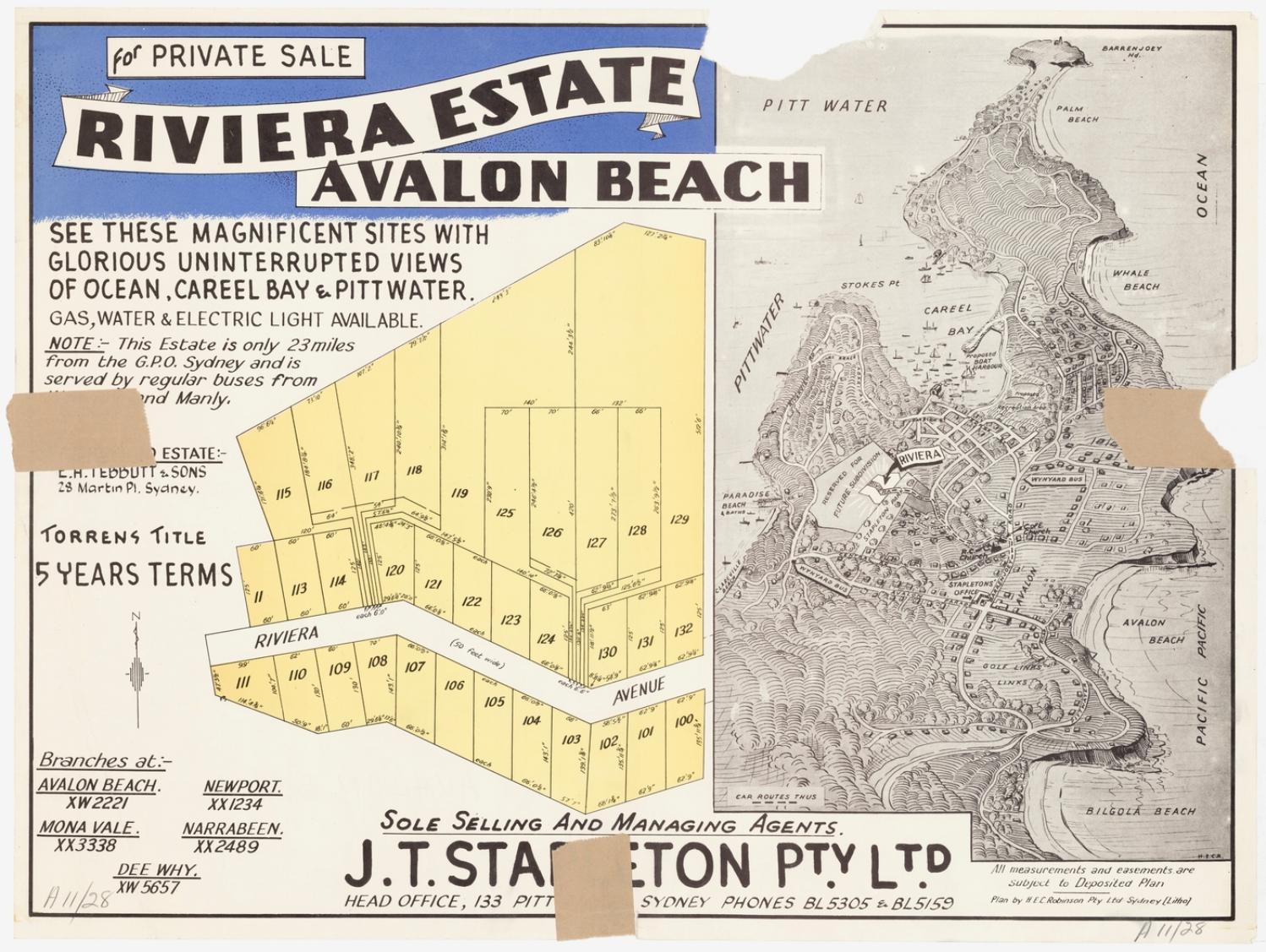
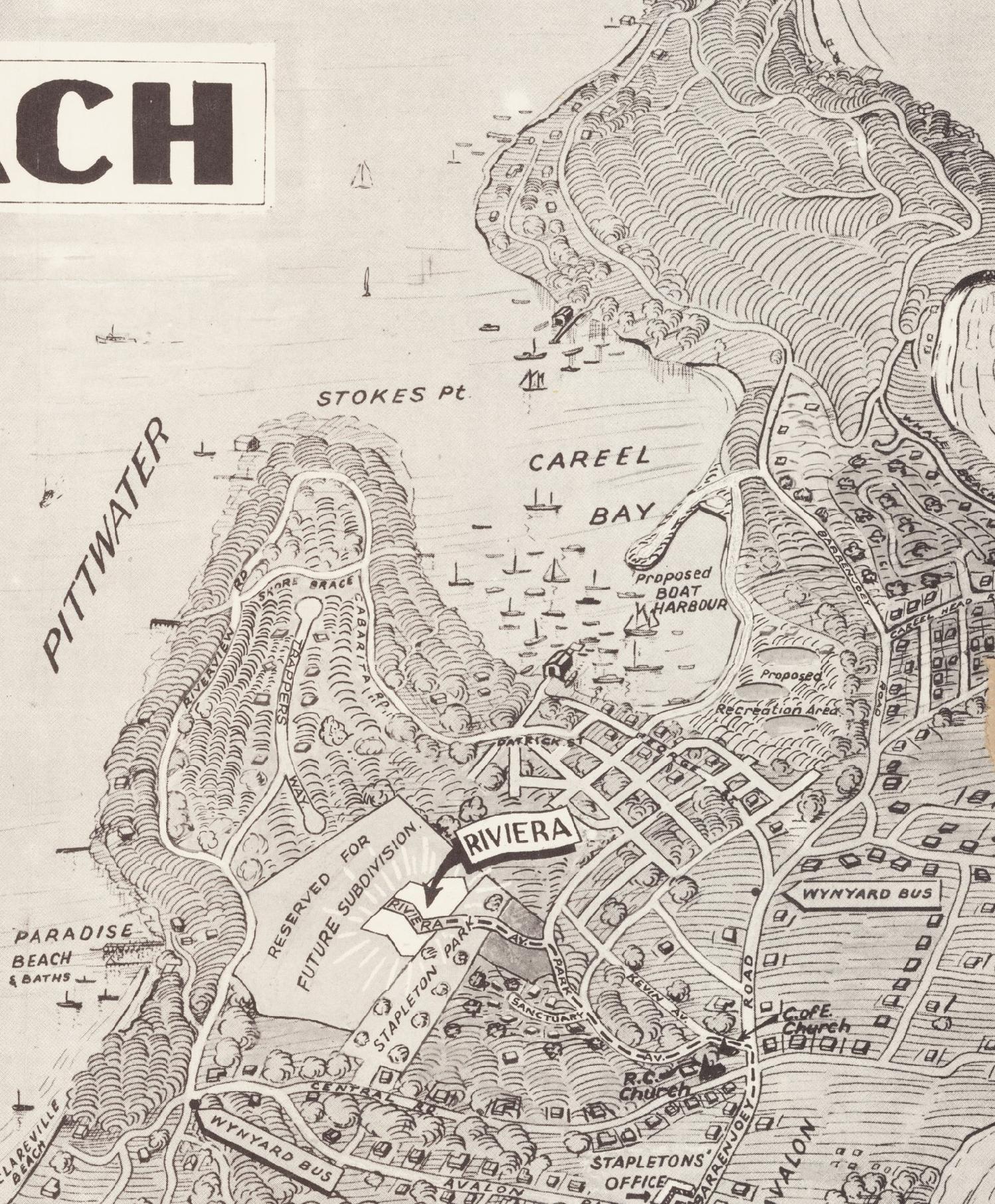
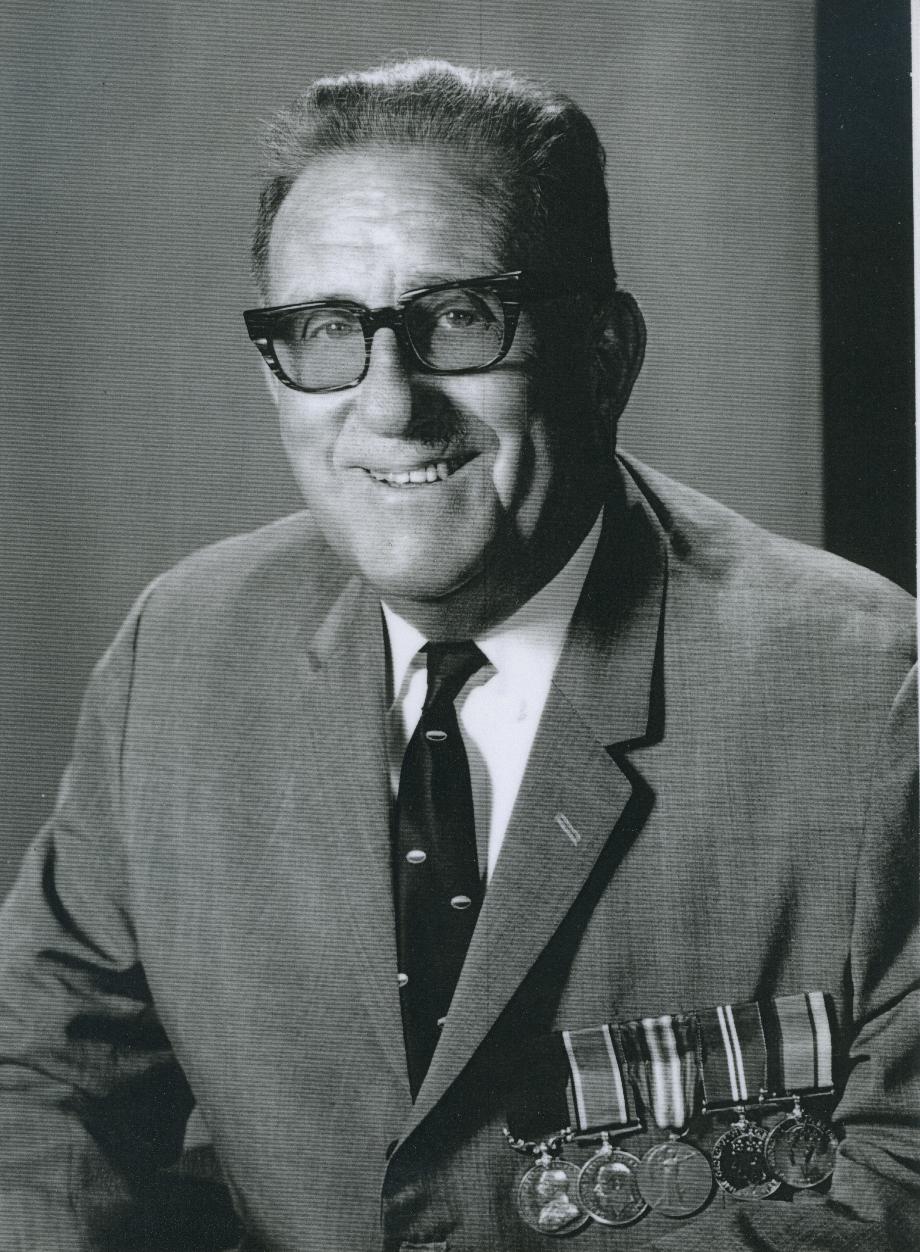
J. T. Stapleton, ABHS photo - courtesy ABHS and Stapleton family.
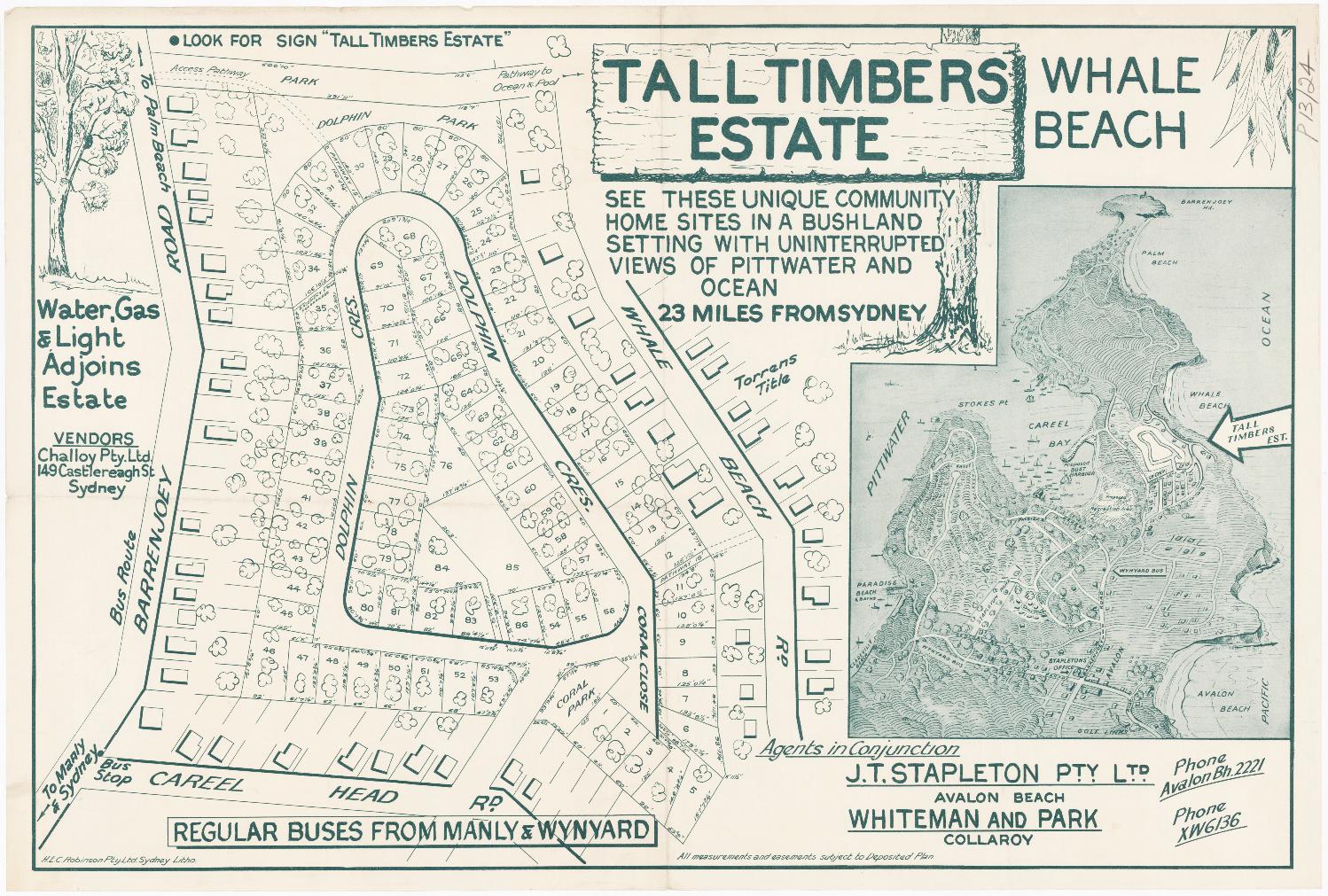
Tall Timbers Estate Whale Beach - Careel Head, Item c053460025, from Pittwater Subdivisions Folder, courtesy State Library of NSW - shows 'Coral Park' and 'Dolphin Park'- Bangalley Reserve and North Avalon Headland Reserve includes lands reserved under the County of Cumberland Planning Scheme in the 1950's and subsequent open space contributions from subdivisions in the area.
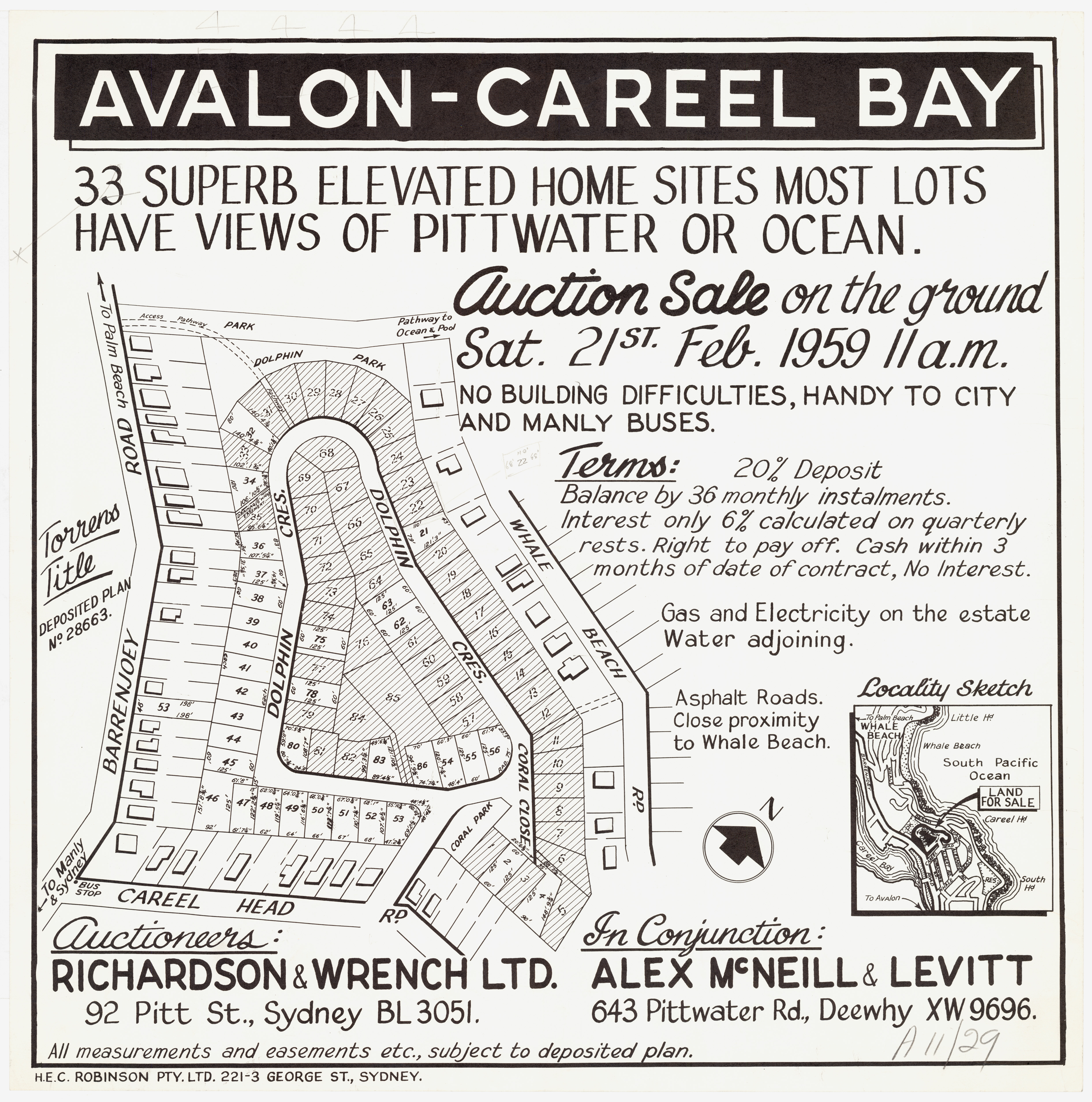
Dolphin Crescent 1959 Careel, Item c027560032 - from Pittwater Subdivisions folder - courtesy State Library of NSW
Careel Bay area: roads + more Real Property Act changes
Albert Road -
Alexander Road -
Bangalley Way - near Bangalley Head Reserve- Bangalley Head: Aboriginal name for the 'Bastard Mahogany Tree' (Eucalyptus botryoides) which grows in this area. An example of this tree further south:
THE AMATEUR GARDENER
MONA VALE'S WONDER MAN Abundant Tropical Growths
(By "Redgum")
Seven years ago Harry Frederick Was foreman engineer in one of the city shops. To-day he is on the land, out Mona Vale way. He is one of Nature's happy optimists, who have faith in themselves, and are not afraid to soil their hands. | But unlike many of those who have during the last few years taken to tickling the soil for a living, he cut in on a good partnership in the begin-ning, and did not trust either to Pro-vidence or the promises of man. He know good land when he saw It. The average man seems not to give any thought to soil values or to the water question. Any old country will do while the fever Is raging. The Frede-rick patch Is one of the best areas of coastal scrub country within the metropolitan area. It is all washed-down : alluvial and concentrated loaf mould. I I am not concerned with the actual depth of the topsoil. The timber standing on the wood lot outside the belt of sweet corn which marks the northern cultivation boundary is evidence enough for me. Ironbark, messmate, turpentine, stringy, white-barked molaluca, and bangalley, with cabbage trees and palms on the fringe of the watercourse, all straight and clean, with plenty of light scrub, where the leeches and mosquitoes fore-gather, and take toll of every intruder, make the soil matter safe. There Is more land within the fences than will ever be worked by one pair of hands.
That is my opinion of Frederick's lot. The owner takes quite a different view. He is of opinion that by In-creasing his horse-power and machinery the whole five acres can be got under. Still, time will tell. Quite enough has been done to date to give the owner heart to push along.
JUST WHERE IT IS
You know the hill on the north side of Brock's? Half-way up the rise a finger-post is marked "The Crescent." One turns in there and pushes over the bit of a climb to tho junctlon of the pretty bush track locally known as Maidenhair-lane.. You cannot go astray if you take the narrow way on the right. The craftsman, though within a few hundred yards of a much-travelled highway, Is almost right out of the world. Only once In a while does any one visit him. When he becomes better known he may not have so much tome to do his gardening. A long line of clean passion vines stand in the foreground of the picture. Much green fruit is in evidence. In the light, rich country this popular line Is almost disease-proof. There is room for more passion vines on the hold ing. Behind the vines stand bananas — short, stocky specimens, quite unlike the tall, straggly plantains so well known along the coast line. The broad leaves and stubby stems surprised me. So did the big bunches of fruit. I had forgotten that my friend, Professor Tearne, who lives hard by, had told me that this sub-tropical fruit was one of the features of the gar-den. All I remembered was that some-thing rather out of the common was being done in the village. The bananas' are splendld. In all, there must be quite a hundred clumps. Some are older than others, and are carrying big bunches of nice chubby green fruit. When I was there all the full grown stock had been sold off for the Christmas trade. Still I did taste one or two ripe fruits that were taken off a bunch which had been reserved for a friend. There was nothing wrong with the flavor of the fruit.
BANANAS PAY
Mr. Frederick tells me the bunches average 14 dozen bananas, for which he receives 7d or so a dozen. There Is never any trouble in marketing the crop. Many of the larger clumps are carrying five and six big stools or stems. Each stem will set and ripen one bunch during the summer season. With four or five bunches a year rather a tidy return Is being taken off that coastal banana patch. Both Cavendish and the short, stubby, sugar banana are being grown. The plants are not more than three yards apart. All the rows are well mulched with cornstalks grown last season. The mulching saves a lot , of moisture. Deep, well-drained land lets a lot of water run away. Mulching and surface stirring help to keep the conditions right. So far there has not been any dam-age from frost. With the sea so close and a big wind-break on the south and east, troubles will be few and far between. Only those who choose impossible places have their good work undone by the wind. Tomatoes are doing rather well this year. The mid-season lines have done splendidly to date. Light, rich land suits this popular vegetable.
BLUE MANHATTAN
One would expect potatoes to thrive. I saw a line lot of Manhattan, one of the blue sorts dug for sale. Not a pennyworth of manure had been dust-ed with the drills. Later on, when some of the plant food has gone, Mr. Frederick must use a scattering of bone dust or one of the chemical fertilisers which the exports put together for those who would succeed with kitchen truck. Some of the right kind makes a won-derful difference. I am quite certain that it is penny wise and pound foolish to try and save money on plant foods. One of Chatswood's girl gardeners proved this very conclusively recently. She grew carrots both with and with-out fertilisers. The roots which had no special feeding were runts, while the others were big, plump and brittle. However rich the land, a little of the extra special will add greatly to your gains. Rock and water melons, strawberries, loganberries, lettuce, beets, onlons, cabbage, beans and peas are doing, or have done, excellently. Creswells is the best sea-line strawberry. New York cabbage Is the quickest worker among the lettuce tried to date. I saw salable heads that were not more than four weeks old. It will be hard to beat that performance. There was no mulching of manure to be seen, nor did I hear anything about quickening the plant action with nitrate of soda in solution. The Mona Vale worker has no time for coddling any of his plants. They must do well on their own account to be of any service to him.
GOOD CITRUS STOCK
Lemons, mandarins and oranges, too, have made a very fine showing. Every leaf Is glossy and very green. Wax scale or whitehouse have no chance. The trees grow fast and are strong enough to throw off any trouble that comes along. Navels and Navelencia are the best oranges for the district. The rich conditions underfoot make their fight easy. What a place this would be for winter sweet peas! Mr. Frederick could do wonders with a batch of early flowers. The land Is quite correct, and the northern aspect just the thing. I think he should try his hand with a quarter acre, patch of the best peas, procurable. In the winter season there is always room for big sweet blossoms of this wonderful flower. Good quality peas have a value of their own. Tho pineapple patch pleased me much. It Is the largest bed I have seen. I might also say that the plants are in better growth than any others which have come under my notice. Altogether there are over 350 plants growing. Most of the fruits are still small, but by the time they are yellow and ready for market the things will be heavy enough to please even a Brisbane man, who knows the taste and look of a high-quality pine.
LOTS OF MULCHING
I was delighted with the care and attention which Mr. Frederick Is giving to his pines. He has every row mulch-ed with six or seven inches of rough bush leaves and mould. Tons of refuse must have been drawn in from the scrublands outside the clearing; How-ever, big pines are worth money. A man who has to take his living off the land cannot afford to throw away any chances. ' Other pines will be planted out as soon as space can be found. The line Is working fine. Mona Vale scrub country gives the plants room for free action. Japanese plum trees, early apples, figs, peaches, nectarines and apricots fill In a pretty orchard block. All the trees are clean and big. But the fruit crop this year is small. There will . not be any return to boast about. How- | ever, next year the plums should again pay for their keep. There is a lot of young fruit wood in evidence. Bush flowers like boronia, native rose, flannels, waratahs and Christmas bush have not been overlooked. Mr. Frederick has a warm heart for these wildings. Indeed, I am of opinion he should put In a long line of Redbush for sale at Christmas tome. It will pay better than any of the Japanese plums or peaches, and take less watching— except during December, when the flowers are adding to their color, and so many people are searching the country a armful of cheap decoration.
WARATAH AND SWEET CORN
The waratahs grow like sweet corn. This year stems are already over the five foot mark, and are still making. Dahlias and cosmos are also strong features. I saw quite a crowd of an old scarlet decorative here and there round the house. Unfortunately, there is now no woman's hand to make use of these beauties. The gardener Is a lonely workman. His trees and his vegetables and a grandchild or two who visit the ranch with their parents now and again at the week-end are all he has. The war robbed him of a son. But I must not forgot the crowning glory of a big concrete water tank and a pumping plant, which Mr. Frederick has completed all off his own bat to make the water supply sure. The tank Is 20 foot high, perched on four big ironbark timbers. Only an expert engineer could have set that water-holder in position. He cut away half of two straight trees and set others in place. Block and tackle, with wind-lass arid guy ropes, did the thing well. Then a small dam was built near the creek-side, and an engine-house and pump fixed to do the work of forcing the water uphill Into the big white tank. A cast-off fire engine plant provides the necessary power. Many of us have seen that same old engine snorting and roaring to some purpose at one of the big city fires. Now it is bedded firmly in an iron shanty, and is fed with wood by one who takes just as much care of the brass work and the pressure gauges as if it were still on show in the old place in Bathurst street. Even the whistle still remains. THE AMATEUR GARDENER (1921, December 31). The Sun (Sydney, NSW : 1910 - 1954), p. 7 (FINAL SPORTING). Retrieved from http://nla.gov.au/nla.news-article223484830
PITTWATER COUNCIL
Roads Act 1993, Section 162 (1)
Naming of Public Road — Bangalley Way, Avalon
NOTICE is hereby given that Pittwater Council has, pursuant to section 162 (1) of the Roads Act, named that section of road as described:
Description Name
That section of split road on Bangalley Way.
Barrenjoey Road, Avalon, (adjacent to properties numbered 650-658).
Authorised by a Council resolution of 8th September, 1997. A. GORDON, General Manager, Pittwater Council, P.O. Box 882, Mona Vale, N.S.W. 2103. PITTWATER COUNCIL (1998, April 24).Government Gazette of the State of New South Wales (Sydney, NSW : 1901 - 2001), p. 3020. Retrieved from http://nla.gov.au/nla.news-article231972577
Bareena Road - an Aboriginal word reputed by various internet sources to mean 'view on the side of a hill' or 'summit'
Barrenjoey Road - 'liitle joey' - possibly referring to the wallabies that were once everywhere here
Bilga Avenue - Aboriginal word meaning “bee's nest.”
Bilkurra Avenue - Aboriginal word for the Narrow-leaved Box Tree
Bilwara Avenue
Burrawong Road - aboriginal name for the Zamia Palm
Burrendong Place - is an Aboriginal word for 'koala'.
Buyuma Place
Cabarita Road - Cabarita is an Aboriginal word meaning 'by the water'. It was renamed from Bay View road in 1939:
SHIRE OF WARRINGAH,
Names of Roads.
NOTICE is hereby given that the Council has, in accordance with the provisions of section 249 (a), Local Government Act, 1919, and of Ordinance No. 30 thereunder, and with the approval of the Minister for Works and Local Government, given the undermentioned names to the roads described* hereunder:—
Situation, Old Name and New Name.
At Careel Bay, Pittwater, parish of Narrabeen—Bayview-road—Cabarita-road.
In Ocean Beach Estate, Avalon (deposited plan No.9,151), parish of Narrabeen — Seaview-avenue— Elouera-road.
Connecting Ralston-road and Pacific-road, Palm Beach, as shown on deposited plan No. 13,780—Unnamed— Ebor-road.
In Brocks' Estate, Mona Vale, deposited plan 6,195—Rickard-road—Orana-road.
In *Warriewood Estate, Warriewood (deposited plan5,464), parish of Narrabeen—Seaview-street—Elimatta-road.
At Mona Vale, running easterly from Barrenjoey-road(Newport-road) to the Pacific Ocean—Allen-street——Golf-avenue.
At Deewhy West, running north-easterly and northerly from the junction of Fisher-road and Lynwood-avenue along the western boundaries of portions 647, 646, 1,290, 643, 642 and 641, parish Manly Cove —Unnamed—Campbell-avenue.
At Manly Vale, parish Manly Cove, running easterly from Condamine-street to Stuart-road—Dalley-street —Koorala-street.
At South Curl Curl, parish Manly Cove, in Foamcrest Estate (deposited plan 6,260)—The Sands—Stewart avenue.
At South Curl Curl, parish Manly Cove, in Foamcrest Estate (deposited plan 6,260)—-The Waves—Travers-road. j At Manly Vale, parish Manly Cove—Osborne-road—Campbell-parade. r At Belrose, running westerly from Secondary Road No. (2,023, westerly along the southern boundaries of : portions 1,667, 1,670, parish Manly Cove—Unnamed—Everton-road.
R. G. JAMIESON, Shire Clerk.
Shire Hall, Brookvale, 26th June, 1939. SHIRE OF WARRINGAH. (1939, June 30). Government Gazette of the State of New South Wales (Sydney, NSW : 1901 - 2001), p. 3373. Retrieved from http://nla.gov.au/nla.news-article225078398
Cannes Drive
Capua Place
Careel Bay Crescent - 'Careel' is held by some to mean 'careen' from cleaning boats and that this was done in Careel Bay from earliest times - others state that it is the name of an aboriginal who camped here
Careel Head Road
Catalina Crescent
Catalpa Avenue
Coolawin Road
Coonanga Road
Coral Close - Coral trees grow over and adjacent to this park
Crane Lodge Place - place where cranes lodge - influenced by shorebirds at Careel Bay
Dolphin Crescent - backs onto Dolphin Bay at Whale Beach
Elizabeth Street
Elouera Road - an Aboriginal word meaning 'a pleasant place'.
Elvina Avenue - Herbert Fitzpatrick tribute to the lady through who he met his wife
George Street -
Gunyah Place - an aboriginal hut or shelter
Harley Road - named for Harley Usill Mackenzie
John Street - from John Joseph Therry
Joseph Street - from John Joseph Therry
Katandra Close
Kevin Avenue
Koala Place
Lewis Street
Nandina Terrace
Neweena Place
North Avalon Road - originally called ''Careel Road'' as part of the Careel Ocean Beach estates
Paradise Avenue
Patrick Street - educated at St Patrick’s, Carlow, Therry was ordained in 1815, and this may be a reference to that place where he began his way here
Riverview Road - view of the river (Pittwater estuary)
Riviera Avenue - because those who bought here were going to be living in a place alike the other named so! Marketing!!
Sanctuary Avenue - see above
Shore Brace - noun. a number or system of shores for steadying or supporting a wall, a ship in drydock - may refer to the bracing shore breezes you will feel across your face when living here
Therry Street - from John Joseph Therry
Toorak Place
Trentwood Park
Urara Road - meaning of “Serene; beautiful”
Wanawong Road - an Aboriginal word meaning "Side of hill"
Wandearah Avenue
Wandeen Road - aboriginal word meaning ''running creek''
Watkins Road
Whale Beach Road
William Street -
Native Names for Property
"New Reader": (1) Adina, good; Mama, flowing water; Allambie, a quiet place; Allara, day; Allawah, I camp here; Attunga, high place; Allungra, the sun; Baanya, camp; Banool, hill; Banoon, sweet water; Banyandah, home on the waters; Baranball, towards the east; Berakee, place of stone; Barega, win; Bareena, plant like a ti-tree; Balrina, summit: Baringa, light; Barkoola, tow; Barranduna, bush myrtle; Bimbil, box trees; Bindaree, river; Birubi, southern cross; Booral, big, high, large; Brinawa, place where rock lilies grow; Bringa, sunset; Bucaan, running stream; Bulwarra, pelican; Bundilla, meeting of waters; Bunyana, good or sweet; Caloola, an old battle field; Carawatha, place of pines; Carbethon, cheerful; Carcolla, gum trees; Carranya, sand hill; Chepana, coast, seashore; Coorong, Moreton Bay pine; Cooyong, Bandicoot; Curbarra, plenty; Currawarra, pine tree; Curringa, black duck; Currong, silver wattle; Elanora, home by the sea; Elimatta, my home; Elouera, pleasant place; Eurobin, big lagoon; Girrahween, place of flowers; Coonda, star; Goreen, wind; Gooyong, a camp; Illira, shelter hut; Illoura, pleasant place; Iluka, near the sea; Immarna, camp; Karuah, native plum tree; Kiata, summer; Koonda, the sun, day; Keoringle, happy home; Kjarrara, south; Kowari, far; Kumboorah, east; Kuringal, in the bush; Kurrung, a creek; Kurrara, place of opossums; Kyeema, dawn; Kyalla, north; Lowanna, beauty; Lumeah, here I rest; Maroopna, deep water, or water-hole; Merrigal, place of many dogs; Milleara, to set at a distance; Miowera, emu; Mirrabooka, southern cross; Miolong, tide coming in; Moora, a camp; Moorilla, stone; Moorillah, pebbly ridge; Mumong, sky; Myoora, a camp; Myuna, clear water; Nairana, eagle; Narweenda, fine day; Neerini, high, elevated; Noogaleek, mine, belonging to me; Nyora, native cherry; Oceana, fuel; Oorong, camp; Panamuna, ocean; Tarrarara, bend of a river; Tocumwal, deep hole; Toolangatta, many currajong trees; Trawalla, much rain, wild water; Turumbol, rainbow; Urella, eaglehawk; Wallung, stone; Waree, wind; Warella, canoe; Warrah, honeysuckle; Weabra, camp; Weerona, resting place; Wilga, a tree like the willow; Wiralie, black cockatoo; Woorarra, mountainous place; Wyralla, black and red cockatoo; Yarrallah, camp; Yarrabin, white gum tree. Native Names for Property (1948, December 17). The Land (Sydney, NSW : 1911 - 1954), p. 31. Retrieved from http://nla.gov.au/nla.news-article105818456
Real Property Act: further subdivisions
NB: a Rood is an English unit of area equal to one quarter of an acre or 10,890 square feet (1,012 m2). 1 rood (rd) = 40 perches (p) Imperial measurement. 1 acre = 4 roods Imperial measurement. 1 hectare (ha) = 10,000 sq. metres (m2) Metric measurement.
No. 20,282. APPLICANTS:—Percy Charles Lucas, Ingleburn; John Hector Lucas, Five Dock; and Edgar Lucas, Waverley. LAND:—County Cumberland, parish Narrabeen; shire Warringah, 12 acres 12 perches, on road from Manly to Barrenjoey, and on Central-road,—lots 10 and 11, North Division, Pittwater Estate, and part 1,200 acres (portion 20, parish), granted to John Joseph Therry; adjoining properties of Mrs. E. Darval, E. M. Callaghan, and Careel Ocean Beach Estate, Limited. NOTICE UNDER REAL PROPERTY ACT. (1916, December 29). Government Gazette of the State of New South Wales (Sydney, NSW : 1901 - 2001), p. 7818. Retrieved from http://nla.gov.au/nla.news-article225966054
No. 20,950. APPLICANTS.-Emily Darvall, Moss Vale, and Florence Maud Callaghan, Sydney. LAND; Shire Warringah, 8 acres 0 roods 24 1/2 perches-lot 9 of the North Division of the Pittwater Estate, at junction of the roads from Manly to Careel Bay, to Barrenjoey, about 17 1/2 chains northerly from Central Road. Advertising (1919, August 16). The Sydney Morning Herald (NSW : 1842 - 1954), p. 20. Retrieved from http://nla.gov.au/nla.news-article28096153
No. 22,054. APPLICANT:—Alfred Henry Delohery, Sydney. LAND:—Shire Warringah, on Careel Bay, at Stokes' Point, 2 acres 3 roods 26 perches, lots 3 and 4, section A, Stokes' Point subdivision. NOTICE UNDER REAL PROPERTY ACT. (1919, September 12). Government Gazette of the State of New South Wales (Sydney, NSW : 1901 - 2001), p. 5054. Retrieved from http://nla.gov.au/nla.news-article227335843
No. 22,830. APPLICANT:—Samuel Jamieson, Manly. LAND:—Shire Warringah, 20 acres 32 perches, lots 12, 13, 15, and 16 North Division Pittwater Estate, fronting Barrenjoey-road. NOTICE UNDER REAL PROPERTY ACT. (1921, March 18). Government Gazette of the State of New South Wales (Sydney, NSW : 1901 - 2001), p. 1786. Retrieved from http://nla.gov.au/nla.news-article220083436
No. 23.701. Reginald Lewis Dunshea, abt. 1r. 5 perches, at Careel Bay, and in Bay yiew rd., Pittwater. 20th Jan., 1922. REAL PROPERTY ACT. (1921, December 16). Government Gazette of the State of New South Wales (Sydney, NSW : 1901 - 2001), p. 7158. Retrieved from http://nla.gov.au/nla.news-article224623946
No. 29636 Katherine Mary Roche 6 a. 38 ½ p. pts. secs. 4 and 5 and lot 7 sec. 8 Brighton Village Est. and lot 8 sec. E. Stokers Point Est. George, Therry, Patrick, Elizabeth, Queen's and Joseph Sts. Pittwater. REAL PROPERTY ACT NOTICES. (1949, July 1). Government Gazette of the State of New South Wales (Sydney, NSW : 1901 - 2001), p. 1851. Retrieved from http://nla.gov.au/nla.news-article224754756
No. 36,092. Louis Forster, 2 a. 2 r. 20 p., lots 1 to 5 incl., sec. VI, village of Brighton, in George, Joseph and Therry sts., and on Careel Bay, Pittwater. NOTICE UNDER REAL PROPERTY ACT. (1947, May 16). Government Gazette of the State of New South Wales (Sydney, NSW : 1901 - 2001), p. 1152. Retrieved from http://nla.gov.au/nla.news-article224768760
REAL PROPERTY ACT NOTICE.
Provisional Certificates of Title for the undermentioned lands will be issued after 20th July 1951:—
Vol. 3987 Fol. 2.3 George Norman Gill lot 14 D.P. 9685 Careel Bay. REAL PROPERTY ACT NOTICE. (1951, June 29). Government Gazette of the State of New South Wales (Sydney, NSW : 1901 - 2001), p. 1914. Retrieved from http://nla.gov.au/nla.news-article220110530
REAL PROPERTY ACT NOTICE..
Applications have been made to bring the undermentioned lands under the Real Property Act. Plans may be inspected and caveats lodged at the Land Titles Office Sydney until 13th August 1954:—
No. 38487 Valerie May Relton 1 r. 31 p. lots 1 and 8 M.P.S. (O.S.) 8984 Elizabeth, George and Patrick Sts. Careel Bay. REAL PROPERTY ACT NOTICE. (1954, July 9). Government Gazette of the State of New South Wales (Sydney, NSW : 1901 - 2001), p. 2005. Retrieved from http://nla.gov.au/nla.news-article220291316
REAL PROPERTY ACT NOTICE
Applications have been made to bring the undermentioned lands under the Real Property Act. Plans may be inspected and caveats lodged at the Land Titles Office Sydney until the respective dates mentioned:—
5th December 1958.
No. 40432 William James Meek 3 a. 1 r. p. lots 4 and 7 sec. E of Stokes Point Est. Therry St. Careel Bay. REAL PROPERTY ACT NOTICE (1958, October 31). Government Gazette of the State of New South Wales (Sydney, NSW : 1901 - 2001), p. 3329. Retrieved from http://nla.gov.au/nla.news-article220265305
REAL PROPERTY ACT NOTICE
APPLICATIONS have been made to bring the undermentioned lands under the Real Property Act. Plans may be inspected and caveats lodged at the Land Title Office, Sydney, until:— 3rd February, 1961
No. 41472 George McPhee and Elsie May McPhee 1 r. 25 ½ p. lot 1 of a resubdivision of lot 6 and part of lot 5 Sec. A Stokes Point Estate cnr. Cabarita Rd. and Shore Brace Careel Bay. REAL PROPERTY ACT NOTICE (1960, December 30). Government Gazette of the State of New South Wales (Sydney, NSW : 1901 - 2001), p. 4136. Retrieved from http://nla.gov.au/nla.news-article220319836
No. 42754 Avalon Heights Estate Pty. Limited 3 ac. 14 per. part of lot V North Division of the Pittwater Est. in the vicinity of Therry and Riviera Sts. Avalon. REAL PROPERTY ACT NOTICE (1963, July 26). Government Gazette of the State of New South Wales (Sydney, NSW : 1901 - 2001), p. 2141. Retrieved from http://nla.gov.au/nla.news-article220334894
REAL PROPERTY ACT NOTICE APPLICATIONS have been made to bring the undermentioned lands under the Real Property Act. Plans may be inspected at the Land Titles Office, Sydney. Caveats may be lodged at that office until 4 p.m. on the respective dates mentioned.
17th March, 1967
No. 45171 Gwendoline Eugenie Wellings Smith 1 r. 01 p. lot 1 in D.P. 230551 being lot 4 in Regd Plan 1600 Patrick St Careel Bay. REAL PROPERTY ACT NOTICE (1967, February 10). Government Gazette of the State of New South Wales (Sydney, NSW : 1901 - 2001), p. 417. Retrieved from http://nla.gov.au/nla.news-article220338504
No. 48298 Edward Bruce Allan 1 rd 6 p. lot 9 in D.P. 237854 Queens Ave and Patrick St Careel Bay. REAL PROPERTY ACT NOTICE (1971, August 20). Government Gazette of the State of New South Wales (Sydney, NSW : 1901 - 2001), p. 3185. Retrieved from http://nla.gov.au/nla.news-article220134327
SURVEY CO-ORDINATION ACT, 1949—PROCLAMATION.
DECLARING- AN AREA TO BE A PROCLAIMED SURVEY AREA FOR THE PURPOSES OF THE ABOVE MENTIONED ACT.
New South Wales, to wit.
J. NORTHCOTT,
(L.S.)
Governor.
By His Excellency Sir John Northcott, Knight Commander of the Most Distinguished Order of St. Michael and St. George, Knight Commander of the Royal Victorian Order, Companion of the Most Honourable Order of the Bath, Lieutenant-General on the Retired List of the Australian Military Forces, Governor of the State of New South Wales and its Dependencies in the Commonwealth of Australia.
IN pursuance of the provisions of subsection (2) of section 11 of the Survey Co-ordination Act, 1949, I, Sir John Northcott, Governor of the State of New South Wales and its Dependencies and the Commonwealth of Australia, with the advice of the Executive Council, DO, by this my Proclamation, DECLARE the area described in the Schedule hereto to be a proclaimed survey area for the purposes of the Survey Co-ordination Act, 1949.
Signed and sealed at Sydney, this 9th day of December, one thousand nine hundred and fifty-four!
By His Excellency's Command,
F. H. HAWKINS, Minister for Lands. GOD SAVE THE QUEEN!
Schedule.
Metropolitan Land District, Warringah Shire, county Cumberland, parish Narrabeen, an area of about 36 acres at Careel Bay, Pittwater, indicated on diagram hereunder. Recorded plan No. 57. (S.C. 1953-203)
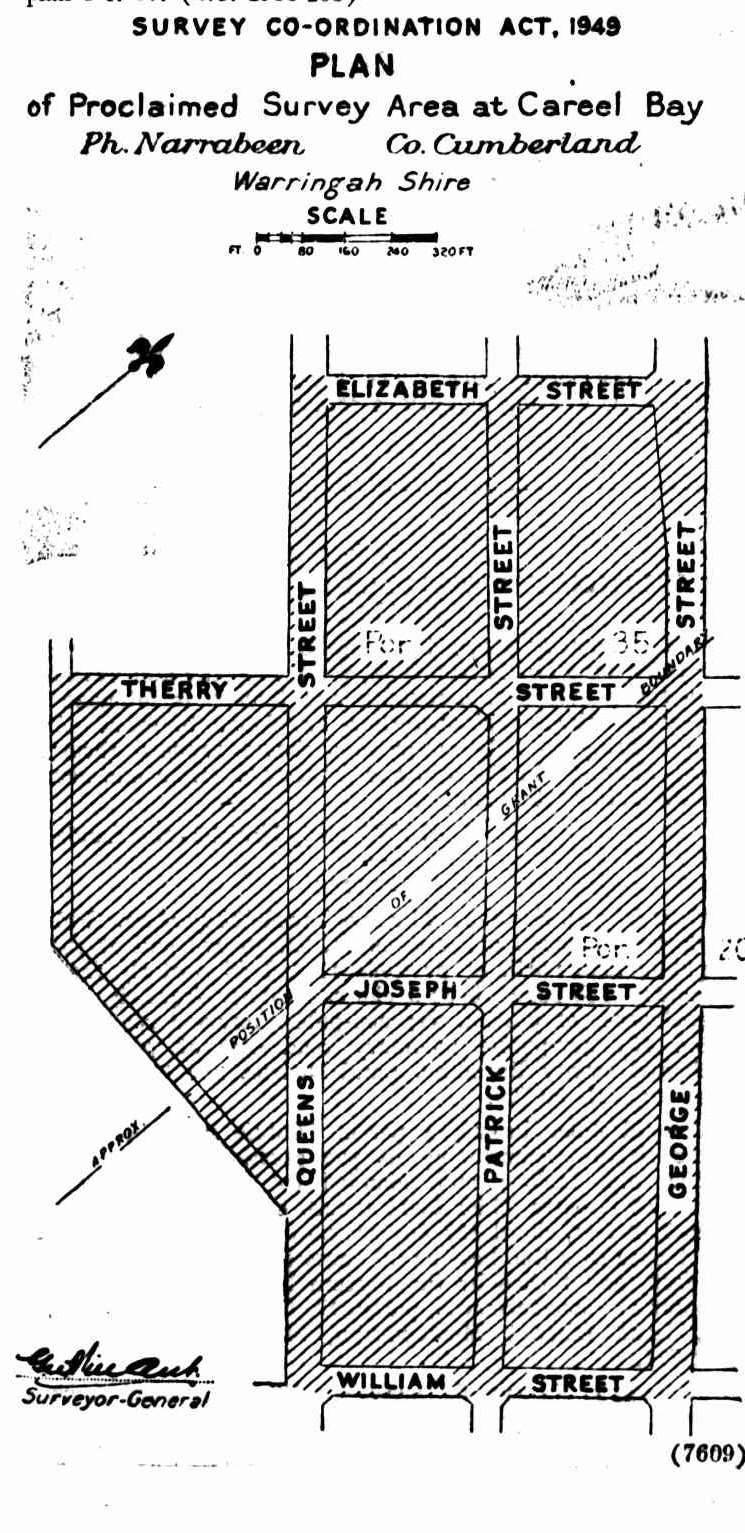
SURVEY CO-ORDINATION ACT, 1949.—PROCLAMATION. (1954, December 10). Government Gazette of the State of New South Wales (Sydney, NSW : 1901 - 2001), p. 3781. Retrieved from http://nla.gov.au/nla.news-article220241750
Department of Public Health, 11
Sydney, 24th July, 1959.
PUBLIC HEALTH ACT, 1902-1952 (SECTION 55)
Unhealthy Building Land at Careel Bay, Shire of Warringah, Area No. 673
THE Board of Health have reported that, after due inquiry, they are of the opinion that it would be prejudicial to health if certain land situated in the Shire of Warringah, described in Schedule hereunder, were built upon in its present condition.
The Board of Health have further reported that in order to render such land fit to be built upon it is necessary that:
1. The surface of the land be raised with clean soil or sand at the shore of Careel Bay to a level of five feet standard datum, rising therefrom on an even grade of one foot in two hundred feet.
2. The whole of the work be carried out to the satisfaction of the Board of Health.
Now, therefore, in pursuance of the power and authority vested in me by section 55 (1) of the Public Health Act, 1902-1952, I hereby declare that such land shall not be built upon until the measures above referred to, which are also specified in a document deposited in the office of ,the Local Authority (the Council of the Shire of Warringah) and open td> the inspection of any person, have been complied with, or until this notice has been revoked by me.
W. SHEAHAN, Minister for Health.
Schedule
All that piece of land situated at Careel Bay, in the Shire of Warringah, parish of Narrabeen, Metropolitan Land District: Commencing at a point on the shore of Careel Bay being the north-western corner of lot B in M.P.S. (O.S.) 10,987; bounded on the north by a line generally easterly along the shore of Careel Bay to the north-western alignment of William-street; thence south-westerly by part of that alignment to its intersection with the north-eastern alignment of John-street; thence north-westerly by part of that alignment to its intersection with the north-eastern prolongation of the south-eastern boundary of lot 11, section 10, of the village of Brighton; thence southwesterly by that prolongation and part of that boundary of a distance of 110 feet; thence south-westerly to the south-western corner of lot 12, section 10, of the village of Brighton; thence north-westerly by the south-western boundaries of lots 13 and 14, to the south-eastern alignment of Joseph-street; thence westerly by lines to the eastern corner of lot 9, the eastern corner of lot 6, and the western corner of lot 4 in deposited plan No. 25,088; thence north-westerly by a line to a point on the north-western alignment of Therry-street, distant 60 feet north-east of the north-eastern alignment of George-street; thence north-westerly by a line to a point on the northwestern boundary of lot 6, section 3, of the village of Brighton, distant 30 feet north-east of north-eastern alignment of George-street; thence south-westerly by part of the northwestern boundary of lot 6 to the north-eastern alignment of George-street; thence north-westerly by part of that alignment to the south-western corner of lot B in M.P.S. (O.S.) 10,987; thence north-easterly by the north-western boundary of that lot to the point of commencement. PUBLIC HEALTH ACT, 1902-1952 (SECTION 55) (1959, July 24). Government Gazette of the State of New South Wales (Sydney, NSW : 1901 - 2001), p. 2233. Retrieved from http://nla.gov.au/nla.news-article219940943
PUBLIC HEALTH ACT, 1902 (SECTION 55)
Area. No. 835
Unhealthy Building Land at Careel Bay
THE Health Commission has reported that after due inquiry it is of the opinion that it would be prejudicial to health if certain land situated in the Shire of Warringah and described in the Schedule hereunder were built upon in its present condition.
The Health Commission has further reported that in order to render such land fit to be built upon, it is necessary that the whole of the garbage that has been deposited on the land shall be assimilated to the satisfaction of the Health Commission or the area shall otherwise be treated in a manner approved by the Health Commission.
Now, therefore, in pursuance of the power and authority vested in me by section 55 (1) of the Public Health Act, 1902, I hereby declare that such land shall not be built upon until the measures referred to, which are also specified in a document accompanied by a plan of the area deposited in the office of the Local Authority (The Council of the Shire of Warringah) and open to the inspection of any person, have been complied with or until this notice has been revoked by me.
JOHN M. MASON, for Minister for Health.
Schedule
All that piece or parcel of land situated in the Shire of Warringah, Parish of Narrabeen, County of Cumberland: Commencing at the intersection of the western side of Barrenjoey Road with the prolongation of the southeastern boundary of lot 120 in Deposited Plan 17189, bounded thence on part of the south by a line bearing 288 degrees 15 minutes distant 76 metres, bounded thence on part of the southwest, part of the west and part of the northwest by lines bearing 320 degrees 45 minutes for 89 metres, 333 degrees 20 minutes for 222 metres, 323 degrees 30 minutes for 94 metres, 313 degrees 45 minutes for 197 metres, 42 degrees 30 minutes for 57 metres, thence again on the remainder of the southwest, south and west by lines bearing 301 degrees 00 minutes for 111 metres, 245 degrees 20 minutes for 159 metres, 347 degrees 00 minutes for 64 metres, thence bounded on the northwest by a line to the southwestern corner of lot 88 in Deposited Plan 11909, thence by a line to the southwestern corner of lot 84 in said Deposited Plan 11909, again by a line to the northeastern corner of lot 80 in aforementioned Deposited Plan 11909, thence bounded on the north, northeast, and east by the southern, southwestern and western sides of Barrenjoey Road to the point of commencement. PUBLIC HEALTH ACT, 1902 (SECTION 55) (1975, July 18). Government Gazette of the State of New South Wales (Sydney, NSW : 1901 - 2001), p. 2827. Retrieved from http://nla.gov.au/nla.news-article220188752

EB Studios (Sydney, N.S.W.). (1917). Panorama of Palm Beach, New South Wales, 11 Retrieved from http://nla.gov.au/nla.obj-162487775 - and sections from to show Careel Bay saltmarsh detail - photo was taken from what we today call Mackay Rsereve
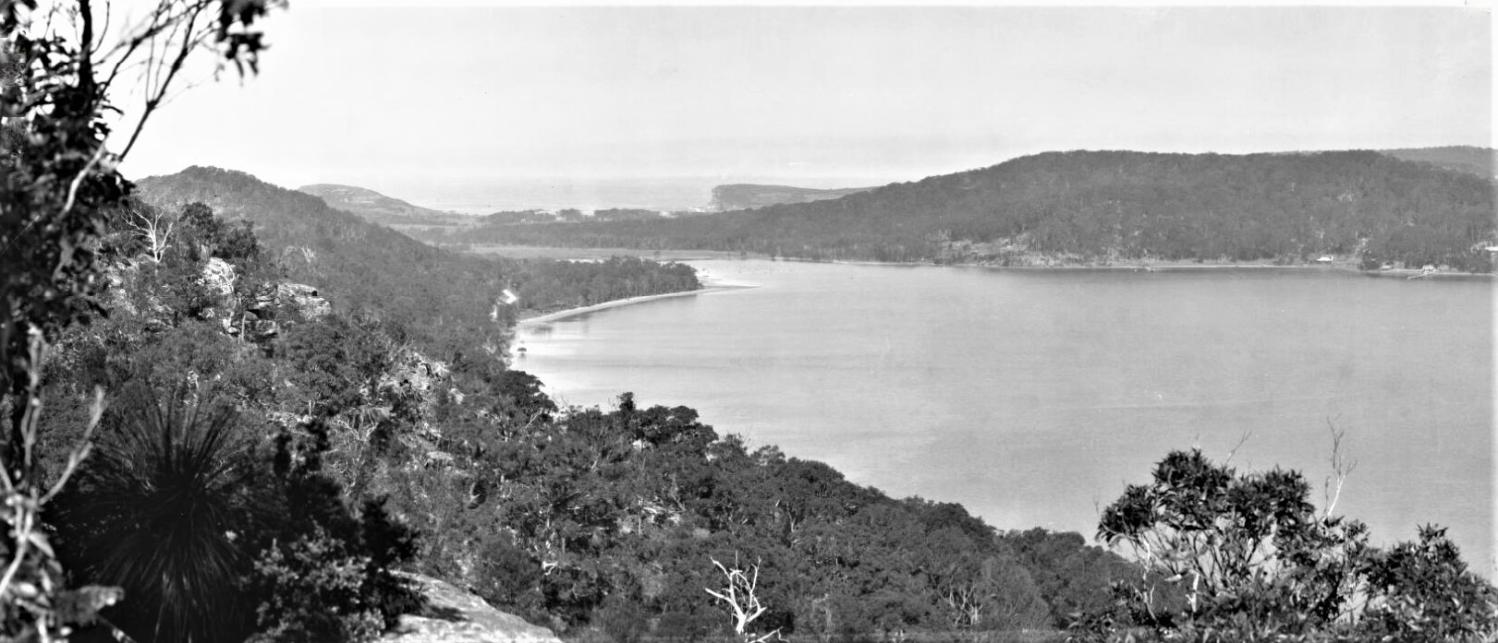
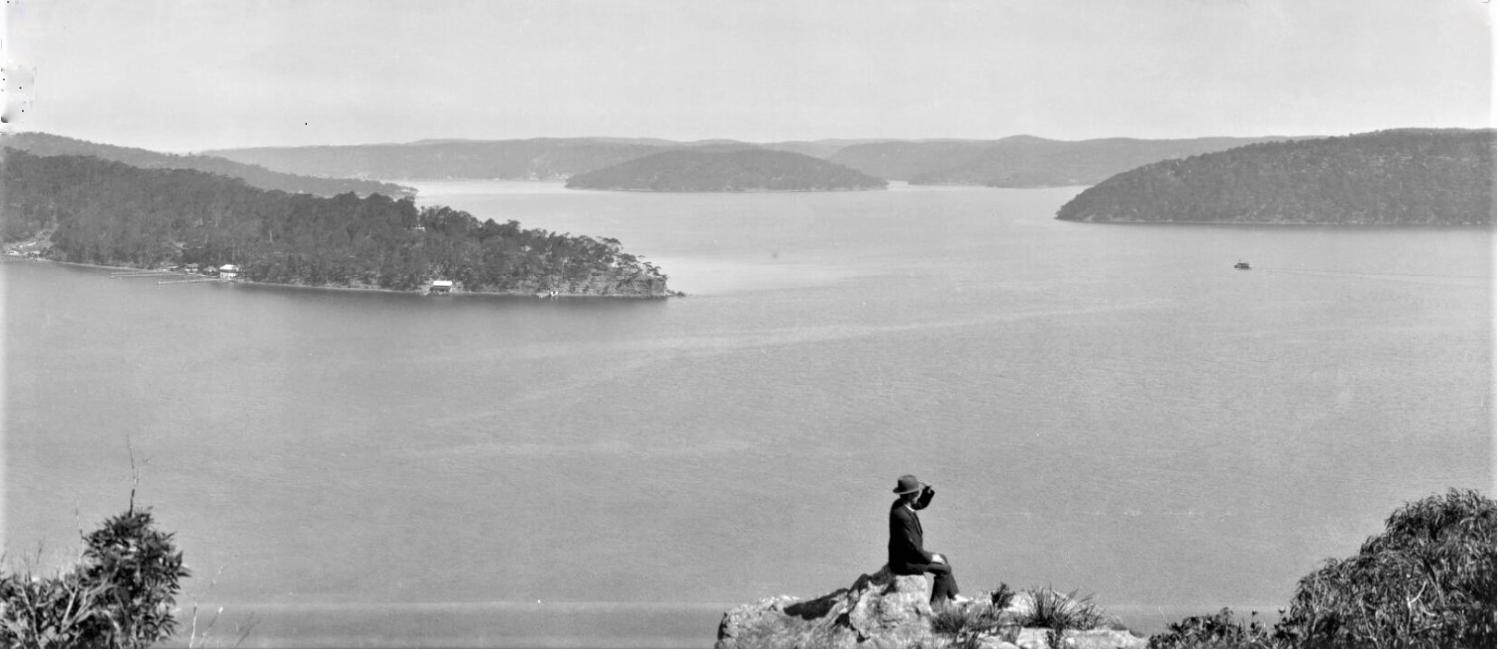
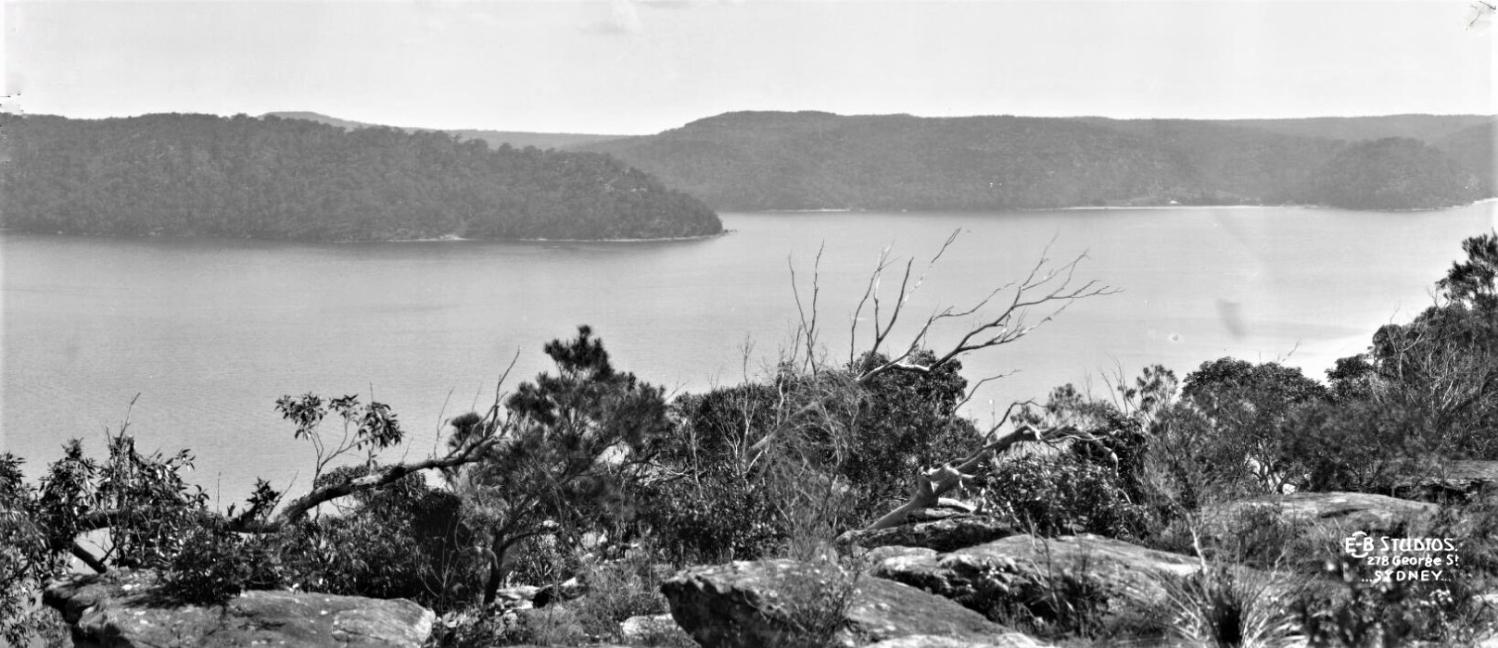
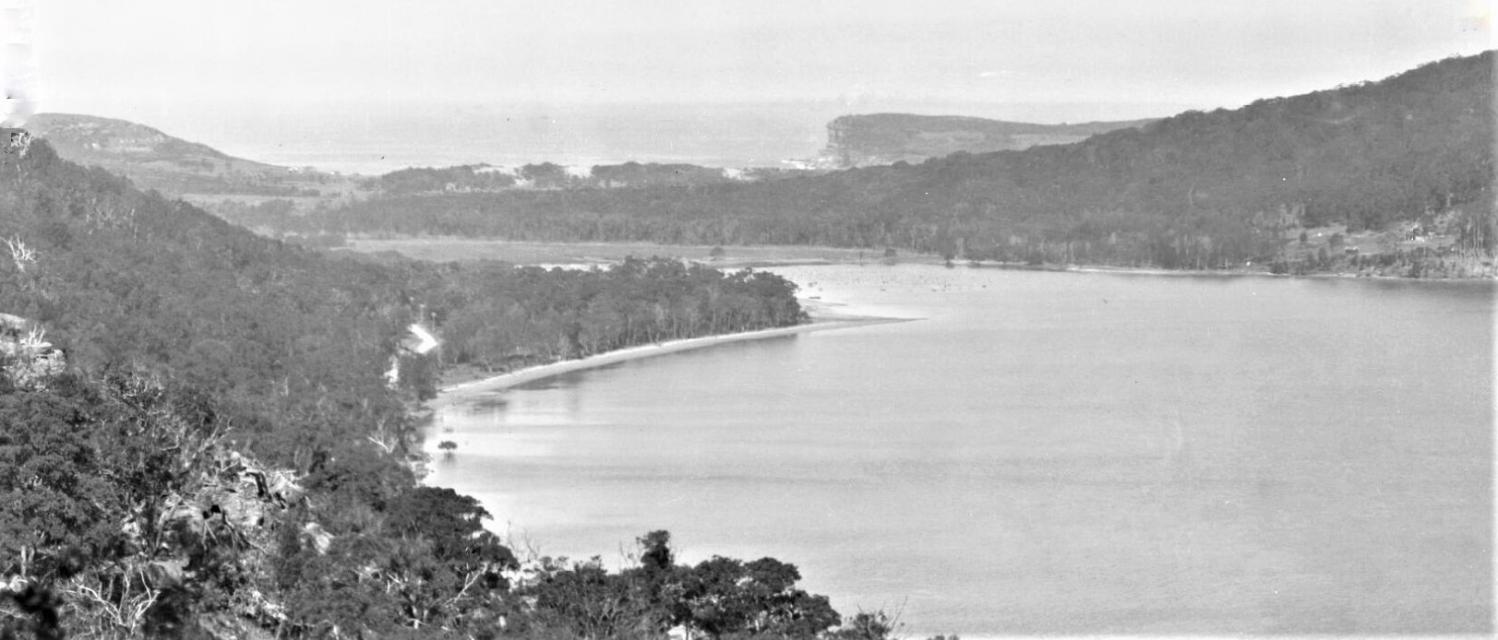
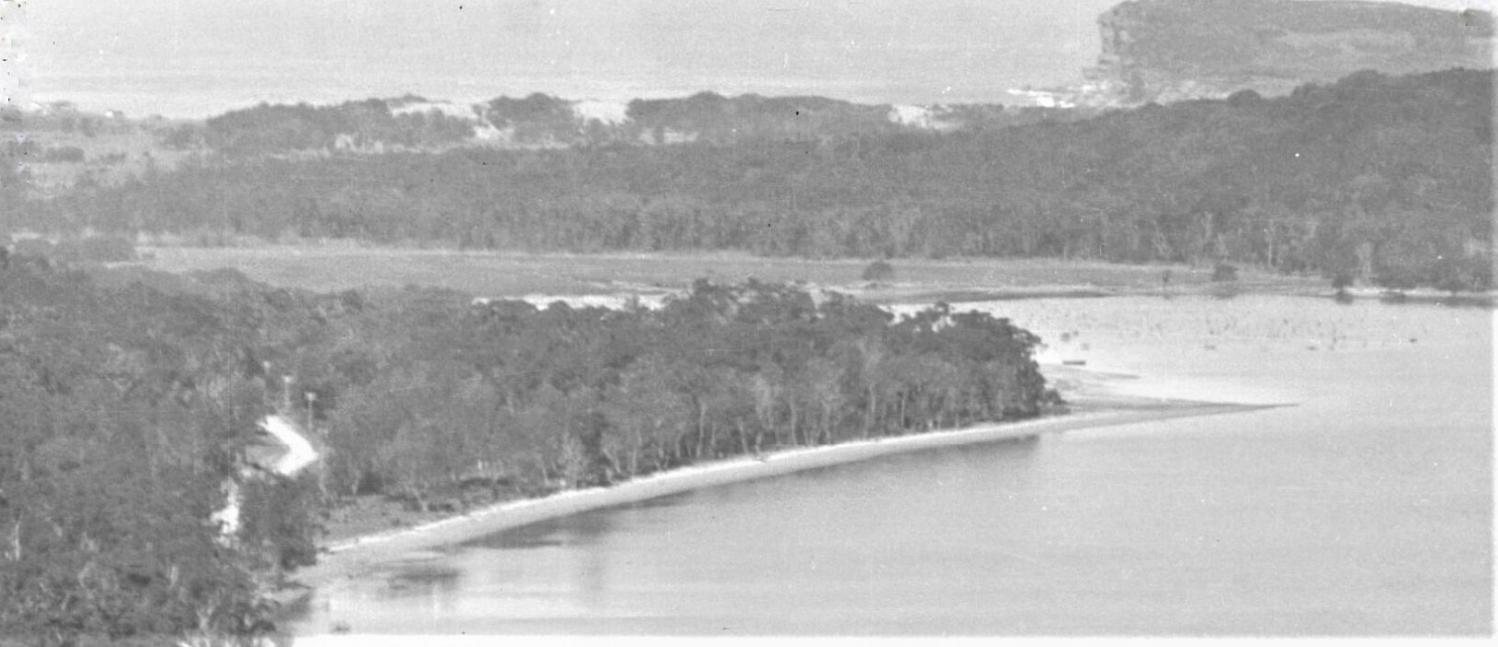
References And Extras
- Trove - National Library of Australia
- Champion, Shelagh and George, OAMs - Profiles of the Pittwater Pioneers, Revised version. 2013.
- Roads In Pittwater: The Barrenjoey Road
- Archpriest JJ Therry
- John Collins of Avalon
- Katherine Roche of Bayview
- Careel Bay Jetty-Wharf-Boatshed
- Early Pittwater Paddlers, Oarsmen, Rowers and Scullers: The Green Family
- Careel House
- George Mulhall First Champion of Australia in Rowing - First Light-Keeper at Barranjuey Headland
- The Collaroy Paddle Steamer: New Ephemera Added To Public Accessible Records - Her Connections To Pittwater
- Sir Herbert Henry Schlink
- Margaret Mulvey (Lady Schlink)
- Pittwater Roads II: Where the Streets Have Your Name - Clareville
- Pittwater Roads II: Where the Streets Have Your Name - Avalon Beach
Also Available:
- Pittwater Roads II: Where the Streets Have Your name - Scotland Island
- Pittwater Roads II: Where the Streets Have Your Name - Newport Beach
- Pittwater Roads II: Where the Streets Have Your Name - Clareville
- Pittwater Roads II: Where the Streets Have Your Name - Avalon Beach
- Pittwater Roads II: Where the Streets Have Your Name - Warriewood
- Pittwater Roads II: Where the Streets Have Your Name - Elanora Heights, Green Hills and Ingleside
- Pittwater Roads II: Where the Streets Have Your Name - Mona Vale
- Pittwater Roads II: Where the Streets Have Your Name - Bungan
- Pittwater Roads II: Where the Streets Have Your Name - Bilgola
- Pittwater Roads II: Where the Streets Have Your Name - Coaster's Retreat and The Basin
- Pittwater Roads II: Where the Streets Have Your Name - Great Mackerel Beach
- Pittwater Roads II: Where the Streets Have Your Name - Whale Beach
- Pittwater Roads II: Where the Streets Have Your Name - Palm Beach
- Roads In Pittwater: The Bay View Road
- Roads In Pittwater - The Barrenjoey Road
- Motor Car Tours To And In Pittwater Show Us The Way This Place Once Was
- Roads To Pittwater: The Wakehurst Parkway Along Old Oxford Falls Track
- Roads To Pittwater: The Pittwater Road
- Roads To Pittwater: The Sandspit Punt and Spit Bridge
- Roads To Pittwater: The Mona Vale Road
- My Holiday by Charles de Boos – 1861
Henry Gasking Careel Bay:
TUESDAY.—Before Mr. Justice Dowling and the usual Commission. Michael Toole was indicted for a burglary in the dwelling-house of Henry Gasking, situated at Creele Bay, Pittwater, on the 13th January.
Henry Gasking—I live at Creele Bay; I was at home on the 13th of January my wife and a man named Woodford were in the house; I shut the house up, and we all went to bed early; about two o'clock in the morning the prisoner broke the hut door clean open, and the first thing he said was, " now for your onions, light your lamp or I'll blow your brains out immediately ;"he said this to Woodford ; the prisoner had a musket in his hand; Woodford said," give me a bit of straw to light the lamp;" Woodford lit it; prisoner then came into my bed-room; I said, "now are you "coming on me the second time, after robbing me before ?" he said, " you won't relieve any person ;" I said, " I do as far' as I can;" 'he replied, " you will not even relieve the sick person about the house ;"I Said I would if he came, as far as my circumstances would let me; he then said,' I will have it ;" and kneeling down opened my box, from which he took a sheet, and laid it on his gun ; he then took out another, and a piece of print; in the meantime, Woodford, who was in the next room, gave me a signal to get hold of the gun ; I immediately jumped out of bed and got hold of the gun; Woodford then- came to my assistance ; I was holding the gun as fast as I could, and struggling with the prisoner, while Woodford was beating him with a frying-pan handle ;prisoner by this time had dragged me to the foot of my bed. He got me down to that degree that I felt the grasp of the gun slacking; prisoner then sung out to a person outside, " come in, come in, "but whom I did not see; he then put his foot on my breast, and with a knife, or some other sharp instrument, cut me across the face [witness here pointed to the cut, which extended from the ear to the mouth;] it was deep, and very near through my cheek; I said to Woodford," Harry, he has cut me, take care of his knife ;" at the same time prisoner stretched across his arm, and cut him also slightly on the cheek ; I found prisoner began to get weak ; I said.to my wife, " shut .the door, "she replied, " Harry, the .staple is out of the door ;" I told her to put the chair behind the door; she went and stood behind it; all of a sudden the prisoner let the gun go out of his hand, and pushed open the door, knocking my wife down ; I said" take care, I'll shoot him;" but on presenting the piece I found the pan full of blood, and the flint had fallen out; I began to get weak from the loss of blood; I gave information about four days afterwards ; I am 65 years of age.; I have been in the country 39 years; the first time I saw the prisoner was on the 30th Nov. last, which time he also robbed me.
Cross-examined-I swear the prisoner is the person who robbed me both times.
Margaret Gasking-I am 65 years of age, and reside with my husband at Cockle-bay. The witness corroborated her husband's testimony, and pointed out the prisoner as the man. Henry Woodford~-This witness corroborated the whole of the circumstances described by the foregoing witnesses; but when called upon to point out the prisoner, pointed to another man who was awaiting to take his trial, but afterwards corrected himself, and swore to the prisoner,
Robert Melville—I apprehended the prisoner at the Narrabine Lagoon, at the house of Sullivan; I think it was on the 13th February ; he was secreted in a room where there was some wheat; I broke open the door, when prisoner jumped up with an axe in his hand; I told him If lie did not surrender I would fire ; a native fired at him and wounded him in the elbow ; he was then taken. [Musket produced.] This is the musket given me by Grasking; it contained several pieces of brass, and a square piece of iron land a charge of powder. This was the case for the prosecution. The learned Judge then summed up, and the Jury without a moment's hesitation found the prisoner guilty. The prisoner was then called up for judgment, and the learned Judge passed the awful sentence of the law upon him, warning him that he had but a few days to live, and advising him, when he returned to his cell, to pay attention to the Minister of religion who would attend on him, for on this side the grave he could have no hope.
Domestic Intelligence. (1830, May 19). The Sydney Monitor(NSW : 1828 - 1838), p. 2 Edition: AFTERNOON. Retrieved from http://nla.gov.au/nla.news-article32073620
DEATH OF MRS. COLLINS. Full of years spent worthily, Mrs. Honora Collins relict of the late John Collins, died on the 20th instant the residence of her son-in-law, Mr. J. J. Roche, Bay View, Pittwater. For more than half a century she had lived at Pittwater, and no family was better known or more highly respected than the Collins family of Careel Bay. Mr. and Mrs. Collins were natives of the County Cork, whence they emigrated 60 years ago. Soon after their arrival in the colony they settled on Father Therry's grant at Pittwater, where Mr. Collins engaged in grazing and farming. The district has always been a great health resort. Many an invalid from Sydney recruited his health at the hospitable homestead of the Collins family. The cottage was flanked by two hills, named Mount St. Joseph and Mount St. Mary by Mr. Collins.
It is told of him that he would allow none of his sick guests to leave until he saw that they were completely 'on their legs,' his test for which was a given time to ascend and descend these hills before breakfast. The remains of the deceased lady were brought on the 21st from Bay View to St. Mary's, North Sydney, where Masses were said for the repose of her soul. The funeral took place at Chatswood Cemetery, the family burial-place, the same day.
The chief mourners were Mr. J. Collins, of the Harbours and Rivers Department; Mr. P. Collins (sons); Mr. J. J. Roche, son in-law; Messrs. J. T. and E. P. Swanson, nephews. Among others present were Mrs. Black, of Barrenjoey Customs Station, Mrs. Midden, Mrs. Roche, Mrs. Earl, Mrs. Robertson, Mrs. F. Collins, Mrs. P. Collins, Messrs. D. J. Glacken, M'Teague, J.Wall, J. Crowley, H. Coyle, J. Macintosh, and Boulton. The Rev. Father Dowling, of St. Patrick's College, Manly, attended Mrs. Collins during her last illness, and officiated at the grave. May her soul rest in peace. DEATH OF MRS. COLLINS. (1897, October 30). Freeman's Journal (Sydney, NSW : 1850 - 1932), p. 16. Retrieved from http://nla.gov.au/nla.news-article115471628
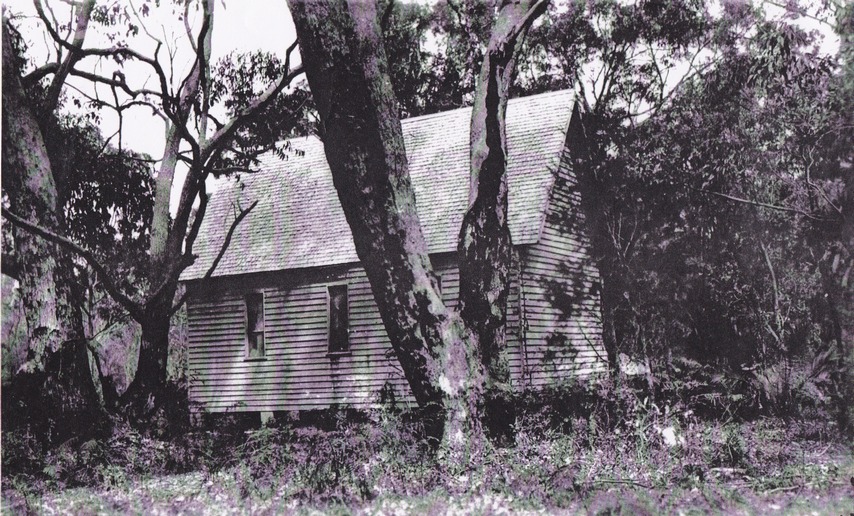
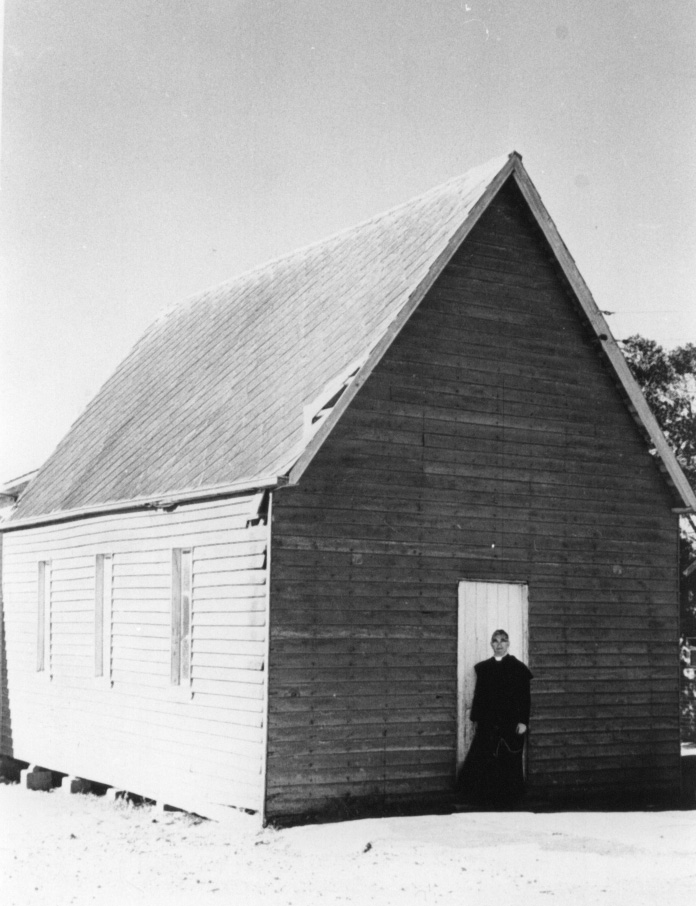
Extract from My Holiday by Charles de Boos:
Following the road, we mounted and crossed the range which terminates in the bluff headland, at the base of which I had been so completely drenched on the proceeding day, and then followed a gradually descending track which wound round the hill side into a deep indentation of the land, until it came down to the level of the sandy ridges which bordered the beach, and then dived into a thickly wooded dell, which though so close to the borders of the seam was one tangled mass of vegetation. It was in fact the embouchure of a long gulley, that, separating two extensive and lofty spurs from the main range was so far sheltered by each from the cutting breezes of ocean, as to allow of the growth of every description of plant in we same profusion as in the gullies I have previously described. Through the midst of it ran a tolerably broad sheet of water, the ordinary brooklet of clear, bright, and sparkling water having been transformed by the late rains into a miniature torrent, turgid and bellowing and carrying down before it small boughs and debris from the hills above, in humble imitation of larger streams. By the aid of a fallen tree we managed to cross the stream dry footed, but it was only by breaking down and walking over the branches of the bangolas and by taking advantage of such tufts of grass or such dead timber as offered that we could manage to cross the centre of the gully which the brook had covered with a mimic inundation.
Once through this jungle of a gully, and we had a gently rising road, creeping steadily up the face of the range, by easy graduation until at last it had gained the crest. Then we had a monotonous walk along the top of the ridge, in full view of the vast Pacific to our right, whose waves were now beating almost lazily along the beach at our feet and whose waters had barely swell enough on them to keel over the tiny fleet of coasters that had put out from different ports of shelter on the coast with the first slant of the favouring wind, and were now lying almost motionless, with scarce wind enough to lift their sails. To the left, the hills, covered with the low close scrub common to our coast ranges, bounded our view, the inland ridges, with their heavily timbered sides being hidden from our sight.Suddenly, however, the road took a curve round to the left, crossed a knoll of the range, and then swept down, in some fifty different tracks, on to a broad swampy plain, or flat, which seemed to us to be inundated, for we could see the water sparkling and glistening in the sun over its whole face. I pulled up short here.
" It won't do to go down there, Tom," said I.
"Oh, but we must," he replied. "This is the Priest's Flat, and there, where you see those shears erected, with the two tents alongside of them, is where they are boring for coal. We must go and report progress."
I looked ruefully at Nat, who made no reply, but, grinning viciously, bent down and turned up his trousers to the knees.
“Do you think there are any leeches there ?” I asked. Nat's trousers were instantly turned down again, and this time he didn't grin,
"Oh, no," Tom answered, "there's too much water there for them, and not enough shelter.
I was easier in my mind, though I had my misgivings; but as these Antipodean leeches seemed to be ruled by laws, and to have amongst themselves habits and customs totally at variance with those of leeches in civilised communities, possibly Tom might be correct; so, tucking up my trousers, I prepared to descend. And, after all, when we got down to the flat it was not so bad as it had appeared to us from the hill. The ground was somewhat honeycombed and the water lay in pools, between which however, we managed to find sufficient footing without actually walking in water.
Arrived at the tents, warning of our approach was given by a solitary dejected bark, ending in a melancholy and prolonged howl, from some unseen dog, that was evidently too broken down and low-spirited to repeat the challenge and it was only after we had approached the shears, and had commenced our examination of the boring, which, to tell truth, none of us could make head or tail of, that a tall sailor looking man, who appeared as if he had but just that instant been uncoiled full-rigged from between the blankets, came out to the entrance of one of the tents, and regarded us with an air of blank and sleepy astonishment. Just after him followed his watchful canine guardian, whose short bark and long ululation had effected his master's awakening, but so far behind as not to be within kicking distance; his cowering watchful look, and his tail hard down between his legs, evidently saying as plain as could be said, " I don't know whether I have done right, so I must stand by for squalls."
It took a good deal to waken up our friend to a full sense of the information we required from him, and it was only by the casual mention of Farrell's name that he was brought to his full mental perceptions. A grin spread over his countenance when we said where we had just come from.
“Did you go candling with him ?" he asked. We explained how it was that we had not done so.'
“Oh, isn't it prime fun !" He was fast getting lively.
He had been of the party the night before our arrival, had got wet through, had disported himself like a grampus in the pool, and had got home with an exulted notion of the sport. Of course we did not undeceive him; but having now got him up to the proper communicative pitch, we proceeded to worm out of him, by dint of much questioning, and much labour in bringing him back to the subject in hand for he would insist upon darting off from it at a tangent to give us collateral evidence upon matters in which we had not the slightest interest-all that he knew of the boring.
From the information thus acquired, as well as from enquiries subsequently made, I learnt that the spot now being bored was about the centre of a very fine property of some 1200 acres in area, granted many years ago to the Rev. Father Therry, and extending across the Barranjuee peninsula from the shores of the Atlantic to those of Creel Bay; the one being its eastern, the other its western boundary. Hence the plain had been christened the Priest's Flat. It had been for some time surmised, taking into account the dip of the coal basin, which crops up to the north at Newcastle, and to the south at Wollongong, that at this spot, which lies so near the northern cropping point, the coal seam might be struck at such a medium depth as would allow of payable working. Somewhere about twelve months ago, the reverend proprietor determined upon trying the experiment, and he has continued perseveringly at the work in spite of every discouragement that has beset him; and certainly he has had in this matter to bear up against contrarieties sufficient to have wearied out the majority of ordinary persons.
At no time have the men employed ever injured themselves by hard work, for the testimony of the natives goes to show that they hung it on most amazingly, and when obliged to do something for their money, rather than sink deeper they would break the auger. On another, occasion, an overseer that was employed bolted with the month's pay of the men, and, not satisfied with that, took also the reverend father's horse, though this was subsequently recovered, but only after paying a pretty Bullish sum for stabling expenses. Just as we visited the spot the 'works were again at a stand-still by the breakage of the apparatus, and the newly-appointed overseer was away in Sydney getting it repaired, whilst the hands were scattered hither and thither. They had at that time got to a depth of 186 feet, but had come upon no indications of coal, if we except the passage of the auger through a 6-inch pipe of coal at a depth of 123 feet. (Since these articles were commenced, I have learnt that the boring has reached a depth of 220 feet), when the work was suddenly brought to a close by the breaking of the auger, and, what was worse, by the cutting portion of it being left firmly embedded in the rock that was then being pierced.
Whilst upon this subject, it may-not be out of place to mention that I visited, though somewhat subsequently to the time now alluded to, the bluff headland almost in an easterly line with the boring, and named by the reverend proprietor St. Michael's Head; and there, at about eight feet above high water mark, and quite open to view, is a thin seam, or, as miners term it, pipe of coal, scarcely an inch in thickness. On examination I found also that very much of the shale, both above and below the seam, bore carboniferous indications-leaves, ferns, &c, being distinctly traceable on the face of the cleavages. Another great discouragement that must have operated very strongly upon the rev. owner has been the expense that the work has entailed on him, in consequence of the bungling inexperience and roguery of the persons who have, until lately, been entrusted with it. On this point I speak only on hearsay, and my information is consequently liable to correction ; but I was told with an air of authority that the cost of sinking had, up to that time, reached very nearly £800, being at the rate of rather more than £4 per foot, whilst the time occupied in sinking had been over nine months, or about twenty feet per month not a foot per diem ! If this was not enough to put an extinguisher upon ordinary enterprise, I can't conceive anything that would be. Under the present management I am informed that the work promises to progress more favourably.
We were not very long in pumping perfectly dry the maritime-looking individual who had charge of the works pro tem ; and, by the way, I would here ask how it is that nearly all the males we have encountered in our tracks have so decidedly nautical an appearance? Can it be that, like the islands in the Pacific have been said to have been, this particular portion of the territory of New South Wales has been peopled by the sole survivors of awful wrecks, by men supposed by anxious friends to have been drowned years ago, and who now turn up mysteriously in this unknown land? or, are the inhabitants of the Peninsula like the Arabs on the African coast, and do they seize and treat as slaves the shipwrecked mariners that are cast amongst them by the Pacific, in its un-pacific moods? or have they fled to these wilds to escape the too fond and anxious enquiries, through the water police, of disappointed shipmasters or deluded agents ? The question is one that perhaps some future Australian physiologist may be tempted to solve.
We parted with our friend with but scant ceremony, he turning on his heel and walking into his tent when we told him, "that was all;" whilst we shouldered our loads and walked ahead. Pushing along the edge of the flat, we crossed the foot of the hill we had not long previously descended, and, passing along an inner one of well-grassed sandbanks, that formed the landmost barrier against any encroachment of the waves, we came after a walk of half a mile to a paddock fence, through a slip panel of which the road evidently ran. Entering the paddock we found the upper part overgrown with young timber, principally wattles, that had sprang up since the cultivation of the toil had been discontinued, whilst about half-way across it we encountered a beautiful stream of running water, bright and clear as crystal, and crossed by a very rustic, and at the same time, very dilapidated-looking bridge. Nat was in the van at the moment, and I was astonished to see him, when he reached the brook, throw down his load and descend the bank to the water. Arrived there, he began hastily selecting some of the darkest leaves of a plant which I now observed grew very thickly on the margin of, and even in the water.
"What's the row ?" said I.
" Watercresses," replied he. "Stunning!"
" I'm there," cried Tom; whilst I made no answer, but slipped my shoulders out of my load, and commenced an attack upon this favourite pungent water plant. We amused ourselves for some five minutes over them, and then, filling our billy with the choicest stems we could find, once more made tracks.
After crossing the creek, we came in sight of a homestead, small but neat, having evidently been only recently whitewashed. The paddock was now clear of all undergrowth, and, as a goodly cluster of large trees, the remnants of the former occupants of the soil, had been left standing round the house, it had an exceedingly pretty and picturesque appearance, its white sides gleaming out markedly from amongst the bright green of the shrubs around it, and the dark and sombre verdure of the forest monarchs that overshadowed it.
"This," said Tom, "is Tom Collins, and he's the man that will show us the cave."
“The cave ?" asked I. "What cave ?".
" You'll see," he answered, "a rum 'un; such a one as you won't find anywhere else within a day's ride of Sydney, I can tell you."
Here was a surprise indeed. I had never, during the whole of my lengthened sojourn in Sydney, heard of this cave, and I don't believe that fifty persons in the metropolis are to this day cognisant of its existence; thus, with a feeling something near akin to that of a first discoverer, I hastened up to Collins domicile.
(To be continued.)
MY HOLIDAY. (1861, August 26). The Sydney Morning Herald (NSW : 1842 - 1954), p. 3. Retrieved from http://nla.gov.au/nla.news-article13059581
MY HOLIDAY
[CONTINUED.]
(From the Sydney Mail, August 31.)
A tap at the door brought out the mistress of the house, accompanied by her brood of little ones, all fat, chubby, and rosy faced, bearing on their countenances the imprimatur of good health. Having mentioned our errand, we were invited to enter, and we found the interior of the domicile even more neat, and white, and bright, than the exterior, for it was the very beau ideal of cleanliness, and care. The tin-ware which hung from the shelves was polished till it shone like silver, whilst the shelves themselves being of deal, were scoured almost to whiteness. The floor, though an earthern one, was swept so clean that it more resembled a single large slab of stone than what it really was; and the fire in the huge bush fireplace was nicely kept in the centre, each side being swept as carefully as the floor itself had been. The hut had been recently whitewashed throughout, and the whole had such a light and cleanly air as strongly to remind me of some of the farmhouses it has been my lot to visit in the mother country, where, perchance, some notable housewife would take such a pride in polishing that even to the iron hoops of the churn, the piggins or the milk coolers would be burnished up till they resembled steel.
Unfortunately our man, Tom Collins, who knew all about the cave, and who was, in fact, its first discoverer, was absent from home; his brother, however, would very willingly guide us to the spot, so said Mrs. Collins, and waiting the arrival of her brother-in-law, she brought forth a huge jug of milk, from which she desired us to help ourselves; and if Tom and Nat didn't do so to a pretty considerable extent, they made a very good attempt at it, that's all. I verily believe that they would have had impudence enough to have asked for another quart, had not the arrival of Collins frer turned their attention to another quarter. He at once expressed his willingness to conduct us, and furnished himself with a piece of candle, the interior part of the cave being so dark as to require a light for guidance amongst the fallen rocks that encumber it.
He led us off in a straight line from the front of the house to the sea, to a spot where the high wall of rock which is here presented to the waves sinks rather slightly, and a little to the north of the well-known rock, "The Hole in the Wall." Bringing us to the edge of the cliff, he pointed to a bit of a track, down which there had evidently been some slipping and shuffling. This went down for about five feet, and then we could see no more. All beyond that appeared to us, from where we stood, to be blank space; and I had a kind of faint idea that, like Farrell's candleing, this was some more of the peninsularies' fun, and that they let themselves slip down here, shot out into space, and chanced the rest. Tom looked at the track and turned pale. Nat inspected it, and turned up the bottoms of his trousers, a sure sign with him of determination, and about equivalent to the turning up of the coat cuffs by the school boy when he has made up his mind to dare some bigger boy to combat. I have already said what my feelings were, but in the position I occupied, as leader and originator of the expedition, it was necessary that I should set an example of decision, if not of courage. There was a small ledge or platform about three feet down on which the whole four of us could have stood easily ; so down on to this I leaped, with something of the same kind of feeling as Marcus Curtius must have had when he took his leap that everybody has heard so much about. Nat followed very readily, but Tom still hung fire.
"It's only just a little bit that's awkward," said Collins, "after that there's as good walking as there is up above."
But Tom was not to be tempted, and that "little bit" struck terror even to my heart, though I was determined upon prosecuting my discovery to the utmost. From the ledge on which we stood, we could only see just two or three feet' of downright slippery descent, and beyond that nothing but the black rocks two hundred feet below, and the crested waves breaking on them in white foam.
"Follow me," said Collins, as griping a projecting point of rock, he slid down the track, dislodging the stones and pebbles, and sending them rattling down upon the rocks below in a regular shower. In another second he had disappeared, and I heard no smash, no cry of torture, so taking heart of grace, I laid hold of the point of rock - oh, if I didn't hold it tight - slipped down the path, shot round a corner, almost breaking my spine with the twist, found my feet laid hold of by somebody, who placed them firmly upon a stone, and then, looking round, perceived that the worst was really over, and that now there was a good plain track running down to the rocks.
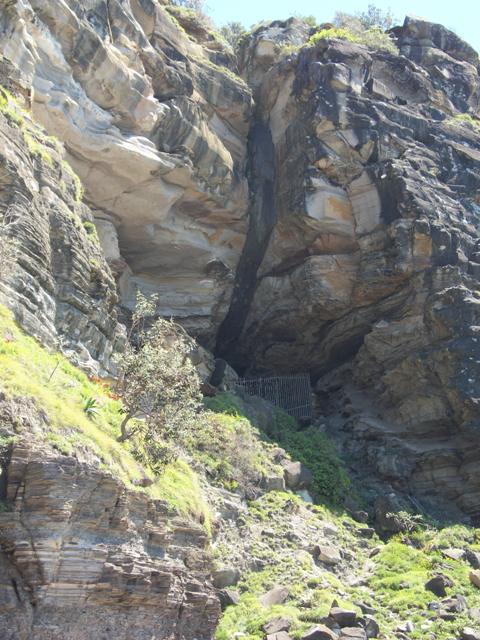 My admiration, however, was somewhat marred by a pair of thick boots which, cocking rapidly down from above, struck me somewhat rudely over the head, and as Nat's feet happened to be in them, and, as wanting the guiding hands that had placed me on the friendly rock, they were thrown wildly about, the blows were rather more than I had calculated upon. Nat soon got his footing, and then began to abuse me for getting in his way instead of apologising for his carelessness. We now shouted to Tom that we were all right and bade him follow. As he saw that the thing was done so easily, he hardly liked to jib, so he sang out to us to wait for him, as he was coming. We looked upwards for him with some anxiety, and in the course of a couple of minutes we had a full view of "the boots." They and they alone stopped in sight for a full minute, and we began to fear that Tom had caught somewhere, when suddenly down came the boots and Tom too, all in a lump, sliding down on the hunkers' after the same fashion as I have seen children slither down a slanting board. He had taken the notion that if instead of griping the cliff as we had done, he stooped down in the way I have described he could guide and check his progress with hands and feet. Here he made a woeful mistake, for the breaks in the descent were too heavy, and poor Tom came jumping down kangaroo fashion, bumping and thumping against the rocks, and so completely done up, that if Collins hadn't caught hold of him, he would certainly have gone bumping and thumping to the bottom.
My admiration, however, was somewhat marred by a pair of thick boots which, cocking rapidly down from above, struck me somewhat rudely over the head, and as Nat's feet happened to be in them, and, as wanting the guiding hands that had placed me on the friendly rock, they were thrown wildly about, the blows were rather more than I had calculated upon. Nat soon got his footing, and then began to abuse me for getting in his way instead of apologising for his carelessness. We now shouted to Tom that we were all right and bade him follow. As he saw that the thing was done so easily, he hardly liked to jib, so he sang out to us to wait for him, as he was coming. We looked upwards for him with some anxiety, and in the course of a couple of minutes we had a full view of "the boots." They and they alone stopped in sight for a full minute, and we began to fear that Tom had caught somewhere, when suddenly down came the boots and Tom too, all in a lump, sliding down on the hunkers' after the same fashion as I have seen children slither down a slanting board. He had taken the notion that if instead of griping the cliff as we had done, he stooped down in the way I have described he could guide and check his progress with hands and feet. Here he made a woeful mistake, for the breaks in the descent were too heavy, and poor Tom came jumping down kangaroo fashion, bumping and thumping against the rocks, and so completely done up, that if Collins hadn't caught hold of him, he would certainly have gone bumping and thumping to the bottom.
We now descended to the rocks by a comparatively easy path, and passing along to the southward of the point whence we had started, we followed the rocks round a small projecting headland, on the south eastern face of which the cave is situated.
It is about eighty feet above high water mark, and about twice that distance from the summit of the headland. When we had mounted to it, and stood at its entrance, we found that a kind of bank or platform had been formed in front of it, covered with coarse grass and with an extensive growth of wild parsley, that seemed to flourish here in great luxuriance. The entrance forms a kind of rude irregular gothic arch, about twenty or five-and-twenty feet high in the centre, - the interior of the cave, that is, its first compartment, being about twice that height, in consequence rather of the descent of the flooring of the cavern than of the rising of its roof. It has evidently at some former period been considerably deeper than it now is, as vast masses of rock that have fallen from the roof above lay strewn about, and heaped upon each other, particularly in the centre, to be gradually, but surely, covered by the fine sand that drifts in with every southerly breeze through the entrance, and also by the guano, if such it may be termed, deposited here by the myriads of bats that make this cavern their home.
The first thing that strikes the visitor on entering is a long flaw or rent in the sandstone which is here the prevailing rock. This flaw runs along the centre of the whole length of the roof of the cavern, being about three feet in width, and in a perpendicular position, and is filled up with a highly ferruginous sandstone, sounding particularly hard and metallic when struck.
At about eighty feet from the mouth, the floor is covered with immense boulders of stone that have fallen from the roof of the cavern, and almost block up the way to the second compartment. A great part of these has fallen during the bad weather of the last year or two, a continuous rain, followed by a thunderstorm, being sure to bring down some one or more of the huge projecting masses that bulge out from the roof, and threaten to fall at the smallest provocation.
Passing round this heap of debris, we now light our candle, for the mass of wreck so far shuts out the light of day as to render artificial light necessary. We now find ourselves in what may he termed the second compartment, which has a more regularly arched and compact appearance than the first, though it is somewhat smaller, being about twenty feet in height and the same width across, whilst the first is at least forty feet high and as many feet in width. Here we can more clearly perceive the ferruginous character of the interloping seam or flaw that has doubtless been the primary cause of this peculiar formation. The drippings from this perpendicular inset between the native rocks hang down in long rust-coloured pendants of oxide of iron, whilst the rocks on either side are formed in regular horizontal layers, the edges of the different strata, and in fact every protruding point of this part of the cave being covered with a white efflorescence from the phosphate of lime that has gathered on them ; whilst here and there other emanations from the rocks have settled in small chrystals upon its face, and reflect back the rays of the candle in all the gorgeous colours of the prism.
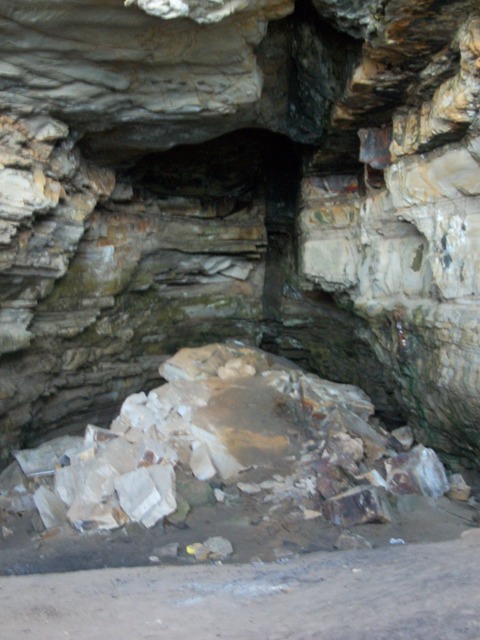 This compartment is the favourite resort of the bats and birds, the lighting of the candle creating a regular commotion amongst the denizens of the place. That they have occupied it for many long years possibly for centuries, is probable from the fact that in rooting among the sand and guano that cover the floor to an unknown depth, Collins informed me that he had met with large masses of an ammoniacal salt, that it must have taken the simple laboratory of nature very many years to bring to the state in which it is found.
This compartment is the favourite resort of the bats and birds, the lighting of the candle creating a regular commotion amongst the denizens of the place. That they have occupied it for many long years possibly for centuries, is probable from the fact that in rooting among the sand and guano that cover the floor to an unknown depth, Collins informed me that he had met with large masses of an ammoniacal salt, that it must have taken the simple laboratory of nature very many years to bring to the state in which it is found.
Somewhere about ninety feet from the heap which I take as forming the boundary between the first and second compartment the cavern narrows very considerably, and we enter by a passage about wide enough to admit four persons abreast into the last chamber of this extraordinary place. As the sides come closer together, so also does the roof descend, and a tall man would here be able, by a good stretch of his arms, to touch the top; and so it runs in for another twenty or thirty feet, sides and top gradually collapsing, until at last there is but the width of the flaw, and scarcely height sufficient for a man to sit down. Here the iron percolations prevail, as in the second compartment those of the lime are most abundant ; and we strike against the interjected seam, and, by dint of much labour and perseverance, chip off from it a piece of rock which has all the appearance of being actually iron in a rude state of preparation. We also see portions of it lying in long seams upon the sandstone rock it has divided, and which appear burnt and charred as though it had been subjected to powerful electric action. We also look back now to the way by which we have entered, and just over the heap of rubbish and natural ruins that impede our sight, we mark the bright light of day, which, from the distance we are placed at, is chastened and subdued almost to a twilight. Everything seems solemn and suppressed; all outward sound is shut out, and there is not even a drip from the roof above to break the pervading stillness. We speak in our ordinary tone, but our voices, crushed down by the massiveness around, sound as if we were conversing in whispers. We are in no grand echoing hall, the work of mans' hands that sycophantly sends back the compliments that are given to his skill. We see before us the work of the Great Architect of the Universe, who labours not by the hand, but employs the meanest and the humblest instruments to do His bidding, and who, with the drop of water or the grain of sand, hollows out mighty caverns, or builds up giant mountains. Nature seems to acknowledge the Almighty presence, and to stand silent and awestruck as she watches the never ceasing work.
Something like these thoughts passed through my mind as I sat at the extremity of the cavern and looked out towards its entrance, a distance of over two hundred feet, and I could see that my companions were also somewhat similarly affected. We consequently retraced our steps with feelings very much sobered from those with which we had entered. Having collected a few specimens from the rocks around, we beat a retreat, and it was like coming into another world when we had emerged from the cave, and the hoarse roar of the waves beating upon the rocks, the songs of the birds, and the numerous and inexplicable sounds of nature and of life, struck vividly upon ears fresh from the oppressive stillness of the cave. We journeyed for some distance round amongst the vast heaps of rocks, on which the waves were breaking lazily though unceasingly, until we had reached St. Michael's Head, where the narrow seam of coal, alluded to in my last, was shown to me, together with the strata of carboniferous shale lying above and below it.
When we had seen all that was to be seen here-abouts, we retraced our steps, the point at which we had descended being the only one by which an ascent could be effected ; and no sooner were we on the back track than we missed Tom. Enquiries were mutually made, and then it was remembered that none of us had seen him since leaving the cavern. I was uneasy. I was fearful that he had fallen down some of the immense crevices that yawned between the vast masses of stone that we had had to traverse on our way; and on our retreat I peered down these as I passed them with a kind of nervous dread on each occasion that I should see his crushed and mangled body lying inanimate at the bottom. We didn't find him in any of these, but just as we were mounting the track up to the first slippery point of descent, we heard Spanker's bark, and looking in that direction saw Tom stalking along the rocks half a mile away, looking for the pathway that he had passed.
A cooey from us showed him his mistake and he was not long in rejoining us, whilst Spanker was so elated that he made a spring up the ascending path in the exuberance of his spirits, but happening to jump rather short, and not being gifted with hands to secure a hold, he came rolling back amongst us, and nearly sent us toppling off the narrow pathway, which we were mounting in Indian file, something after the manner in which children knock down the long files of suppositious soldiers represented by bent cards. By dint of some little muscular exertion, and some pushing and pulling at each other, the ascent was successfully accomplished, and we once more stood upon terra firma, for the vast boulders of rock over which our way had been made was certainly not entitled to that designation. Tom was so elated at finding himself once more safe and sound from an adventure over which, from the very first, as he afterwards confessed, he had had the most painful misgivings, that he fired at and killed the first bird that came across him, the victim in this instance being an unfortunate gill-mocker, who had attracted Tom's attention by several times telling him to " Go back," a piece of advice that, in Tom's then state of mind, must have savoured strongly of sarcasm.
Having thanked Collins for his kindness and attention, we once more pushed ahead, the road now leading us across a long level piece of country that intervened betweeen the sea and the waters of Creel Bay, until it brought us down to the margin of the latter. Arrived here, we had before us as pretty a marine picture as ever painter sketched, and as directly opposite to the one we had but so recently left as could be well conceived. The flat level land had here narrowed to some sixty rods in width, being backed by a heavily wooded range, the base of which was here and there encumbered by large masses of rock, from which the incumbent soil had been washed, and which now protruded in huge boulders, or lay out bare and detached from their native beds. On the margin of the bay were three little whitewashed slab huts with bark roofs, the passion- ate squalling of an infant that proceeded from one of them would have given evidence of their being inha- bited, even if we had not seen two or three barelegged and barefooted children peering at us round the corner of the house.
Through the narrow belt of low swamp oaks that edged the margin of the bay, the clear smooth waters of Creel glistened in the sun, as the gentle breeze swept over its face and slightly ruffled its surface. On the sands, midway between the shore and the retreating water, for it was nearly low tide, two boys were busied collecting shells, by filling an old basket with the sand, and then agitating it in a water-hole, made for the purpose, until the sand was washed away, and nothing was left but the shells that had been mingled with it. These, when washed clean, were thrown into a boat that lay down helplessly on its side close to them. Out on the waters of the bay, floated a smart little cutter, which, though probably only a shell boat, looked from the clear atmosphere, and perhaps also from the fact that she was the only vessel in view, smart and dapper as a yacht, the red shirt and striped cap of the one man on board, adding still farther to the picturesque appearance of the vessel. Behind her again stretched out the waters of the bay, until they encountered the ranges of the other side, which coming down in many a ridge and gully, and forming many a deep indentation or projecting point, gave a gorgeous variety of tints and lights to a background that under a less brilliant sun or less pure atmosphere would have been sombre and monotonous.

Manly to Broken Bay. (1893, November 11). Australian Town and Country Journal (NSW : 1870 - 1907), p. 19. Retrieved fromhttp://nla.gov.au/nla.news-article71191632
We halted here just long enough to admire the scene, and to have a shot at one of a number of blue cranes, that were stalking about most consequentially and at the same time most warily upon the sands. It was only by dint of a good deal of manoeuvring and dodging that Nat was enabled to get even within possible shooting distance of the rearmost of the lot; and after all, when he fired, he didn't kill his bird. He however succeeded in frightening it, and not only it but all its companions, for they one and all took to flight with a wild cry. But if he had in one quarter caused a fright and a cry he had in another caused a fright and quietness for the report of the gun had stilled the squalling in the hut so effectually that it was not resumed, so long at least as we remained within hearing.
The track, a mere bridle path, now led along the flat, then across a dank luxuriant gully, down which a little stream roared and brattled and foamed with as much fuss and bother as would have been sufficient for a volume of water twenty times its quantity; afterwards,up a wet sloppy hill from which the water exuded in every direction, round the point of the range, down a correspondingly wet and sloppy descent on the other side; and then on to another flat the very counterpart of the one we had just quitted. Another luxuriant and overgrown gully, another wet hill teeming with springs, and then we come down, upon a somewhat broader flat, at the extremity of which we see two tents a short distance apart that we at once recognise, from the description we had received of them, as being the Chinamen's place.
(To be continued.)
MY HOLIDAY. (1861, September 2). The Sydney Morning Herald (NSW : 1842 - 1954), p. 3. Retrieved from http://nla.gov.au/nla.news-article13057913
In the Supreme Court of New South Wales. (26,693)
BANKRUPTCY.
Re Joseph Thomson, of Careel Bay, between Avalon and Palm Beach, contractor.
NOTICE is hereby given that the First Meeting of creditors in the above matter will be held at the Office of the Official Assignee^ 47 Elizabeth-street, Sydney, on the 17th day of October, 1927, at 10 a.m., or as soon after as the course of business will permit. .To entitle creditor to vote thereat, his proof must be lodged with the Registrar in Bankruptcy, Elizabeth-street, Sydney, not later than the 13th day of October, 1927.
- N, C. LOCKHART,
Registrar in Bankruptcy. Official Assignee—-"William Harrington Palmer. IN BANKRUPTCY. (1927, September 30). Government Gazette of the State of New South Wales (Sydney, NSW : 1901 - 2001), p. 4774. Retrieved from http://nla.gov.au/nla.news-article219954427
Careel Bay—Blk. dairy premises, Albert & Burra Wong Rd.—W. H. Jones, Barrenjoey Rd., Careel Bay, Owner; £1170. BUILDINGS & WORKS APPROVED (1941, November 26). Construction (Sydney, NSW : 1938 - 1954), p. 3. Retrieved from http://nla.gov.au/nla.news-article222862494
Convalescing after three months In Randwick Military Hospital is Lieut. Bill Scott Fell, who is at the moment staying at Ambleside, in Careel Bay. With him are his mother, Mrs. Bain Scott Fell, and his sister, Mrs. Owen Hepworth. Talk of the Town (1941, November 27). The Daily Telegraph (Sydney, NSW : 1931 - 1954), p. 10. Retrieved from http://nla.gov.au/nla.news-article248709295
Sydney, 9th November. 1945.
OBJECTIONS TO SPECIAL PURCHASE.
IT is hereby notified that an application has been lodged for the purchase of an area particularised below. Any objections should be accompanied by a deposit of £10 and lodged with Acting Metropolitan District Surveyor, Sydney, on or before 7th December, 1945.
H. II. GUEST, Under-Secretary for Lands. Land District—Metropolitan; Shire—Warringah.
Parish Narrabeen, county Cumberland; Special Purchase 4435, for an area of about 4 perches below high-water mark of Careel Bay, fronting lot 6, d.p. 17,704, comprised in Certificate of Title, volume 5,451, folio 229. Applicant, Olive Turtle. S. 45-11,524. OBJECTIONS TO SPECIAL PURCHASE. (1945, November 23). Government Gazette of the State of New South Wales (Sydney, NSW : 1901 - 2001), p. 2209. Retrieved from http://nla.gov.au/nla.news-article222032788
Chief Secretary's Department, Sydney, 26th March, 1954.
TENDERS from oyster farmers addressed to the Under Secretary, Chief Secretary's Department, and endorsed "Tender for Spat at Pittwater" will be received until noon on the 21st May, 1954, for the exclusive right to collect oyster spat from Careel Bay, Pittwater, south-east of a line drawn north-easterly from the most eastern foreshore corner of Oyster Farm No. 43-147 at Careel Bay.
Each tender must be accompanied by a deposit representing the premium offered.
In the event of tenders of equal amounts being received, acceptance will be by lot. The highest or any tender will not necessarily be accepted.
Tender forms are obtainable from the Chief Secretary's Department, Sydney, or from the District Fisheries Inspectors. (2225} C. A. KELLY, Chief Secretary. Government Gazette Tenders and Contracts (1954, March 26). Government Gazette of the State of New South Wales (Sydney, NSW : 1901 - 2001), p. 969. Retrieved from http://nla.gov.au/nla.news-article220290919
AVALON BEACH, THE RIVIERA OF N.S.W.
THE AVALON ESTATE,
Comprising 350 CHOICE LOTS. IN 10 SUBDIVISIONS, ls THE BEST INVESTMENT OFFERING TO-DAY.
Sole Selling Agents:
A. J. SMALL and CO., 28 Martin-place. Advertising (1936, May 16). The Sydney Morning Herald (NSW : 1842 - 1954), p. 26. Retrieved from http://nla.gov.au/nla.news-article27992862
LAND FOR SALE.
AVALON, From £225.
NEWPORT, From £050.
PALM BEACH, From £280.
NORTH AVALON, From £200.
WHALE BEACH, From £400.
PITTWATER! From £395.
ALAN COLES PTY. LTD., 173 Pitt st. BL 2633. Avalon Office open weekend. XW0234. Advertising (1950, July 1). The Sydney Morning Herald (NSW : 1842 - 1954), p. 27. Retrieved from http://nla.gov.au/nla.news-article27573352
LIQUOR ACT 1912
PART IIIA
Take Notice that I LEONID EPTON of 77-79 Avalon Parade, Avalon have given Notice to the Clerk of the Licensing Court at Sydney within the Metropolitan Licensing District of My intention to apply to the said Court on the Twentieth day of December 1954 for the Grant to me of a Permit to Sell Light Wines and Malted Liquors in a Restaurant known as Riviera Colo Restaurant and situated at Blocks 4 and 5 Avalon Parade, Avalon within the said District
Signed by me at Sydney this 29th November 1954, L EPTON. Advertising (1954, November 30). The Sydney Morning Herald (NSW : 1842 - 1954), p. 22. Retrieved from http://nla.gov.au/nla.news-article18451514
James Young Family - Notes
Stormy Petrel
SUDDEN DEATH
 Mr. James Young
Mr. James Young
Mr. James Young, known as the 'Stormy Petrel" of the legal profession, died suddenly at 4.3U a.m. oa Thursday of blood pressure.
From October 29, 1903, till December 19, 1928, he had practised as a barrister, but on the latter date, at his own request, he was disbarred by the Full Court in order to permit of his practising as a solicitor. He then became "associated with the legal firm of J. W. Abigail and Company, and as late as Wednesday night was in confcrence with Mr. S. Mack, K.C., respecting a big case in which Mr. Young was the solicitor.
Mr. Young practised principally in the Criminal Jurisdiction of the Supreme Court, and had been identified with many leading criminal cases. His advocacy was of an intensely robust style which often brought him into sharp conflict with presiding judges.
Several years ago he was president of the Kuring-gai Shire Council, having manifested, a keen interest in the problems of local government.
He was known to both branches of the legal profession as "Jimmy," and although he fought with vigour and determination in court, he was never aggressive outside.
Mr.Young was a married man with three children, and lived in Eastern-road, Turramurra. "STORMY PETREL" (1930, March 27). The Sun (Sydney, NSW : 1910 - 1954), p. 15. Retrieved from http://nla.gov.au/nla.news-article223713593
YOUNG.—March 27, at Yothanee, Turramurra, James, eldest son of the late R. A. Young, of West Maitland, and Mrs. A. A. Young, of Woollahra, aged 50 years.
YOUNG.—March 27, 1930, at his residence, Yothahnee, Eastern-road, Turramurra, James Young, LL.B., beloved husband of Sylvia Young and son of the late R. A. Young, of Maitland
YOUNG -The Funeral of the late Mr JAMES YOUNG L. L. B. will leave his late residence, Yothahnee, Eastern road, Turramurra, THIS FRIDAY at 9.45 a.m. for the Crematorium Rookwood. By road. Motor funeral arriving Crematorium 11 a.m. Family Notices (1930, March 28). The Sydney Morning Herald (NSW : 1842 - 1954), p. 9. Retrieved from http://nla.gov.au/nla.news-article16637500
Marriage: 2437/1907 YOUNG JAMES ROWE SYLVIA U G ST LEONARDS
YOUNG — ROWE. — January 3, at St. John's Church, North Sydney, by the Rev. H. Vindin, James Young to Sylvia Ursula Codolphin Rowe. Family Notices (1907, January 16). The Sydney Mail and New South Wales Advertiser (NSW : 1871 - 1912), p. 185. Retrieved from http://nla.gov.au/nla.news-article165388071
MARRIAGE,
YOUNG — ROWE. — January 3rd, at St. John's Church, North Sydney, by the Rev. H. Vindin, James Young, barrister-at-law, eldest son of the late Richard Alexander Young, solicitor, West Maitland, to Sylvia, daughter of the late Colonol Rowe, of Mona, Darling Point, Sydney. Family Notices (1907, January 19). The Maitland Weekly Mercury (NSW : 1894 - 1931), p. 1. Retrieved from http://nla.gov.au/nla.news-article126787431
Visit: Pittwater Roads II: Where The Streets Have Your Name - Great Mackerel Beach and VP Day 2019: Anthony Thomas Ruskin Rowe, Spitfire Pilot (1919 To 1943) - Defence of Darwin
Children:
YOUNG RONALD R 26777/1911 JAMES SYLVIA U CHATSWOOD
YOUNG SYLVIA B 19812/1915 JAMES SYLVIA U CHATSWOOD
YOUNG JAMES Wolstenholme 13311/1909 JAMES SYLVIA U G CHATSWOOD
His parents, please note that Richard Alexander Young was also a barrister and served as a crown Prosecutor prior to retirement from the Bar, and his mothers name was Agnes Ann:
Marriage:
3062/1875 YOUNG RICHARD ALEXANDER WOLSTENHOLME AGNES ANN MAITLAND
Children:
YOUNG UNNAMED 14779/1877 RICHARD ALEXANDER AGNES AMAITLAND
YOUNG JAMES 16641/1879 RICHARD ALEXANDER AGNES AMAITLAND
YOUNG RICHARD 17687/1880 RICHARD ALEXANDER AGNES AMAITLAND
YOUNG EDGAR HAROLD 20883/1882 RICHARD A AGNES ANN WEST MAITLAND
YOUNG NELLIE 25722/1886 RICHARD AGNES A WEST MAITLAND
MRS. R. A. YOUNG, MAYORESS OF WEST MAITLAND.
IT is with much gratification that we are able to reproduce the portrait of Mrs. R. A. Young, the popular Mayoress of the important provincial town of West Maitland.
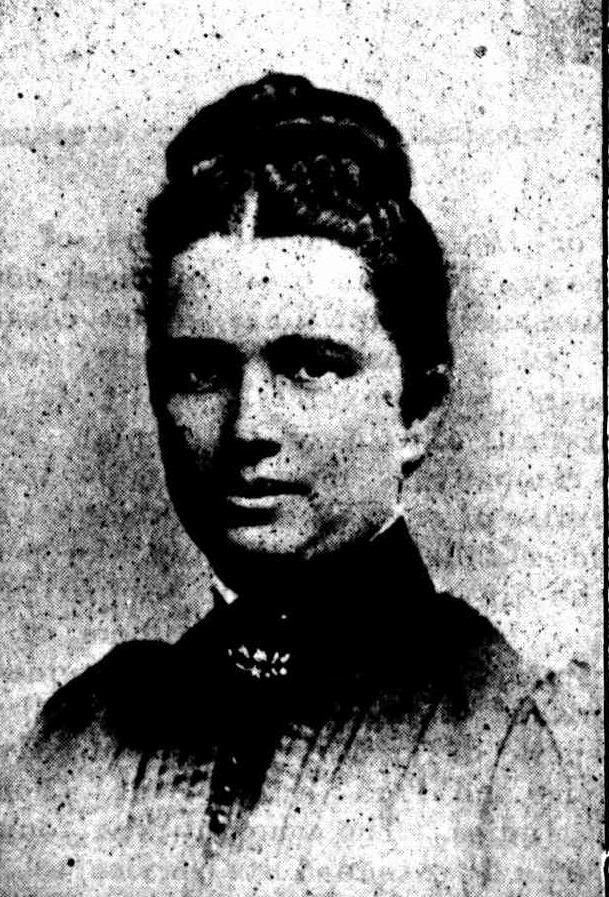
Mrs. R. A. Young, Mayoress of West Maitland.
Mrs. Young is the second daughter of the late Mr. Alderman Wolstenholme, J.P., who for many years served on the Council, and also as Mayor of the Borough, a gentleman highly respected and esteemed, and of most philanthropic character, which his daughter has evidently inherited. With excusable pride, Mrs. Young is able to speak of receiving her education at a ladies' school conducted by the late Mrs. Liddell, whose memory is held in profound veneration by her pupils.
Mrs. Young has devoted much of her time to assisting and attending to the poor, aged, and infirm. She is President of the Maitland Benevolent Asylum, an active member of the committees of the Maitland. Clothing Society, the Pierce Memorial Nurses' Home, the Maitland Nursing Society, the local Chinese Mission, and the Boys' Brigade, and has just been elected vice-President of the Band of Mercy. MRS. R. A. YOUNG, MAYORESS OF WEST MAITLAND. (1891, October 10). Illustrated Sydney News (NSW : 1881 - 1894), p. 6. Retrieved from http://nla.gov.au/nla.news-article63617220
THE LATE R. A. YOUNG, ESQ
Mayor of West Maitland.
It is seldom that the death of any man evokes such tributes of respect and admiration as those which characterised the obsequies of the late Richard A. Young, Esq., to whose sudden death we referred jast week. His funeral was attended by all the Friendly Societies and the volunteer forces of the town, by the Aldermen of the Borough, the legal profession, the bishops and clergy of all denominations, and citizens and residents of the district for many miles around. The funeral procession was estimated to be about two miles in length, and was witnessed by thousands of sorrowing spectators. The services at the church were conducted by the Revs. J. E. Carruthers, C. E. James, and T. Parker, and at the grave the Rev. J. Benvie (Presbyterian) and the Bishop of Newcastle also took part.
In place of any obituary notice, we reprint from the Maitland Mercury, the address delivered over Mr. Young's remains at the church by the Rev. J. E. Carruthers. The church was suitably and beautifully draped, and the choir assisted by the sympathetic rendering of a couple of hyms during the service.
Mr. Carruthers said: — Fellow Citizens, and Christian Friends, — We meet to-day under the shadow of a great calamity. Death, always solemn and tragic, has singled out for its stroke one whom of all others the town could least afford to spare, and whose removal is mourned as an irreparable public loss. We may well say today The beauty of Israel is slain upon thy high places ; how are the mighty fallen !' ' Death is come up into our windows, and is entered into our palaces and we bow beneath a visitation' that is as solemn and mysterious as' it was' unexpected,' and say : ' I was dumb, I opened not my mouth, because Thou didst it.' 'Who could have imagined on Sabbath last, that the pageant of that afternoon, in which the Mayor bore so conspicuous and able a part, would have been so soon succeeded by another of the character that lias brought us together to day. Then, apparently in the full glow of health ; rich in the respect and confidence of an entire community ; speaking out strong and sympathetic words in ^ support of the public charities of the town now cold and silent in death — his course run, his work done, and his mantle to be taken up by others. How true it is : in the midst of life we are in death. With mournful emphasis the old lesson is repeated : Therefore, be ye also ready. The boast of heraldry, the pomp of power, And all that beauty, all . that wealth e'er- . gave, Alike await the inevitable hour, The paths of glory lead but to the grave.
The concourse of to-day bears eloquent testimony to the public appreciation of a life that was singularly unselfish and successful. Richard Alexander Young was a native of the place ; a man of ability, of indomitable energy, and of inflexible principle. Diligent and conscientious in the prosecution of his own business, and successful therein beyond most men ; he was yet always ready to give time and thought and service to any and every movement, that tended to the good of the community at large. The perplexed found him at all times a wise and safe counsellor, and the poor a ready and generous helper. His purse was as open as his sympathies were wide, and the extent of his beneficence and usefulness it is impossible to estimate. One is reluctant on such an occasion to intrude in the slightest degree into the sacredness of the domestic circle, but we may be pardoned for saying that the basis of Richard Young's public usefulness was his pure and happy private life. He was seen to advantage in the home circle. There the best | qualities of the man found exercise and outflow. An affectionate husband, a kind and indulgent father, a generous and entertaining host, he found in his home life his purest earthly happiness, and a constant inspiration to the service of his fellow men What we shall do without him in our church I cannot tell.
He occupied an important position as one of our most responsible office-bearers. He was exemplary as a regular attendant at the public services of the Sanctuary ; and by his counsels, his influence, and his support, was a tower of strength to the church to which he belonged. His public work and worth cannot be adequately described on this occasion. He has often said in public that he loved the town and district in which his whole life had been spent, and that it was his pride and joy to do what he could to advance its interests. These, as you know* were no idle words. No call of public duty was ever addressed to him in vain. His time and substance were placed without stint at the service of every worthy cause. The charities of the town will miss in him one of their chief supporters. The work^the noble, arduous work — he did in connection with the last great effort of flood relief, will not soon be forgotten.
As Mayor of the Borough — -an office he held continuously for four years — he discharged the duties of chief citizen with dignity and thoroughness, and was a . representative on great occasions of whom the town was justly proud. ' He was a man, take him for all and all, we shall not look upon his like again.' Yes, a man, every inch him ; best loved by those who knew him best', most honoured by those who had most to do with him. His death is a public loss. His removal brings to every citizen a sense as of a personal bereavement. And it is in no strained sense that we apply to him words that will be familiar to some of you:—
He is gone who seemed so great — Gone, but nothing can bereave him Of the force he made his own Being here, and we believe him Something far advanced in.State, And that he wears a truer crown Than any wreath that man can weave him. Speak no more of his renown, Lay your earthly fancies down, And in the vast Cathedral leave him. God accept him, Chsist receive him, Amen.
On the following Sunday evening an impressive memorial service was held in the West Maitland Wesleyan Church. The building was crowded to its utmost capacity, and it is estimated there were fully 1000 persons present. The Mayor (newly elected), and Aldermen of the Borough attended in a body, and all classes and all denominations were largely represented. During the course of his sermon, Mr. Carruthers quoted testimonies borne to Mr. Young's personal worth and valuable public services, by the Bishop of Newcastle, the Vicar-General of the Roman Catholic Church, the pastor of the Congregational Church, and the Revs. J. Spence, C. Stead, Dr. Sellors, and G. Lane. The text was very appropriately found in Acts xiii. 36, ' And David, after he had served his own generation by the will of God, fell asleep.' THE LATE R. A. YOUNG, ESQ. (1893, September 16). The Methodist (Sydney, NSW : 1892 - 1954), p. 4. Retrieved from http://nla.gov.au/nla.news-article155401033
NSW BDM's: YOUNG RICHARD A 8844/1893 Parents: JAMES ALICE W - registered at: WEST MAITLAND
James Wolstenholme
James Wolstenholme was James' Young maternal grandfather:
In the Supreme Court of New South Wales.
ECCLESIASTICAL JURISDICTION.
In the will and codicil of James Wolstenholme, late of West Maitland, in the Colony of New South Wales, timber merchant and storekeeper, deceased.
NOTICE is hereby given, that after the expiration of fourteen days from the publication hereof, application will be made to this Honorable Court, in its Ecclesiastical Jurisdiction, that probate of the last will and testament and codicil of the abovenamed deceased, who died on the 2nd day of July instant, may be granted to Richard Alexander Young, of West Maitland aforesaid, solicitor, the sole executor in the said will and codicil named.—Dated the 6th day of July, a.d. 1886.
H. A. YOUNG, Proctor for Applicant, By his Agent,— West Maitland.
W. J. FERGUSSON, Castlereagh-street, Sydney. ECCLESIASTICAL JURISDICTION. (1886, July 9). New South Wales Government Gazette (Sydney, NSW : 1832 - 1900), p. 4595. Retrieved from http://nla.gov.au/nla.news-article222751859
H.A. Young is Richard Youngs' brother. Died: 6223/1899 YOUNG HENRY A Parents: JAMES ALICE WEST MAITLAND
Married: 5605/1883 YOUNG HENRY A ANDERSON SARAH WEST MAITLAND
YOUNG—ANDERSON.—November 8, at the residence of the bride's parents, by the Rev. James Benvie, M.A., Henry Arthur Young, of West Maitland, solicitor, second surviving son of the late James Young, of Oakhampton, West Maitland, to Sarah, second daughter of Samuel Anderson, Forest Hill, West Maitland. Family Notices (1883, November 12). The Sydney Morning Herald (NSW : 1842 - 1954), p. 1. Retrieved from http://nla.gov.au/nla.news-article13557176
Children:
YOUNG ARTHUR W K 24261/1884 HENRY ARTHUR SARAH WEST MAITLAND
YOUNG HEDLEY G 25000/1885 HENRY A SARAH WEST MAITLAND
YOUNG ERNEST V 26529/1887 HENRY A SARAH WEST MAITLAND
YOUNG MILDRED N M 26114/1889 HENRY A SARAH WEST MAITLAND
YOUNG CLARENCE W 20945/1891 HENRY A SARAH WEST MAITLAND
?: YOUNG FLORENCE A 17383/1893 HENRY A SARAH HUNTER
A monument erected by his friends commemorates Mr James Wolstenholme, a prominent member of the community who was known for his acts of charity. The memorial was originally unveiled at the corner of High and Church Streets and then moved to a site near the railway station before being relocated to Maitland Park in 1992.
''The handsome memorial erected at the intersection of High and Church streets, to perpetuate the memory of the late Mr. James Wolstenholme, who in life proved himself a most valued and respected townsman, and was responsible for many acts of charity towards those who were in need of assistance, was publicly unveiled this afternoon by the Mayor (Alderman William McLauchlin) in the presence of many townspeople. Amongst those present, in addition to the Mayor, were the Mayoress (Mrs. McLauchlin) Major Nicholson, M.L.A., Aldermen Fry, Russell, and Ribee, Messrs. J. W. Birkenhead (treasurer to the movement), W. J. Enright, R. Logan, O. K. Young, W. C. Quinton, Thos. Judge, Harold Browne, W. H. Abbott, (Dungog), Lieut. Colonel Markwell, W. J. Saunders (town clerk), James and Ray Wolstenholme, R. Young, and the employees of James Wolstenholme, Ltd. Apologies were received for the absence of Aldermen Mannall, Fletcher, and Jas. H. F. Waller, and Messrs. Chas. Earp, Alfred Beckett, and F. Head.
The Mayor said the ceremony that afternoon brought forth sad recollections. They would remember that on September 28, 1910 news was received in Maitland of the decease of one of their most prominent townsmen, the late Mr. James Wolstenholme. The news came as a shock to the community. Although not a public man, still he at all times took a deep interest in everything that was going on, and his worth was marked by his open-hearted generosity and his willingness at all times to assist in the various movements associated with the progress and advancement of the district. He also liberally assisted all charitable movements. His friends, therefore, thought it fitting and proper that some monument should be erected to his memory to recognise the work he had done.
The Mayor, just before performing the unveiling, said it was with feelings of regret, regret that there was any necessity that it should be done but pleasure to think that the friends of the late Mr. Wolstenholme had thought fit to erect such a handsome memorial as that in such a conspicuous place. It was both ornamental and useful to remind them of the uncertainty of life, and that they should all be prepared.
The memorial, which consists of a drinking fountain, of Carrara white marble, supplants the big lamp which previously illuminated the corner. A solid concrete foundation has been laid, upon which the base of Ravensfield flagging rests. The design of the memorial is handsome and unique, consisting of a circular basin carved on graceful lines, from which rises a plain polished column. At the base of the column two swans have been cut in an artistic manner, the designing being very beautiful. The necks are gracefully curved, while the open wings, skilfully cut, meet around the column. On the top of the column a powerful gas lamp has been erected. The memorial was cut in Italy, and erected by Mr. Thomas Browne, through whom the fountain was procured. It bears the following inscription: “Memorial erected by friends of the late James Wolstenholme, 1912.” - Newcastle Morning Herald and Miners' Advocate (NSW), 23 January 1913.
Maybanke Selfe married the eldest son of James Wolstenholme, Edmund Kay. Visit: The NSW Women's Legal Status Bill 1918: How The 'Petticoat Interference In Government' Came Of Age - A 100 Years Celebration Of Women Alike Our Own Maybanke Selfe-Wolstenholme-Anderson
Phillipson Family - a few insights
N O T I C E . We have been appointed attorneys to manage the affairs of JONAS MOSES PHILLIPSON, Esq., during his absence from this province. CHAS. & J. F. BECK. Adelaide, Oct. 16, 1845. Advertising (1845, October 17). South Australian (Adelaide, SA : 1844 - 1851), p. 2. Retrieved from http://nla.gov.au/nla.news-article71603020
On the 20th May, at St. Pancras Church, London, by the Rev. F. J. Stamforth, J. M. Phillipson, Esq., of Adelaide, South Australia, to Matilda Constance, eldest daughter of Sampson Goldsmith, Esq., of Mecklenburgh-square. Family Notices (1846, October 31). Adelaide Observer (SA : 1843 - 1904), p. 4. Retrieved from http://nla.gov.au/nla.news-article158923373
In Family 92 Years
Parts of town acres 102 and 103 in Adelaide have been in the possession of the same. family more than 92 years. I doubt that there are many other town acres which have not changed hands in that period. This freehold has a frontage to Grenfell street beginning at Sturt Arcade Hotel and extending to the eastern alignment of Hindmarsh Buildings, and it has a depth reaching to Gay's Arcade. At one time the land covered by the hotel and the building next to it were in the estate which was conveyed on May 19, 1846, by Sampson Goldsmid, then living in England, to Jonas Moses Phillipson, the consideration being his intended marriage to Matilda Constance Goldsmid and 5/ of lawful money.
The freehold is still owned by the descendants of Mr. and Mrs. Phillipson. Mr. Phillipson was a Jew and he arrived in this country by the Eden on June 24, 1838. On the same ship was Mr. Philip Levi. Both became prominent pastoralists, and were original members of Adelaide Club, which was established on August 4, 1838, at a meeting held in the Turf, now Park side Hotel.
Jewish Names Perpetuated
THE names of several Jews prominent in the early days of the State are perpetuated in Adelaide. Montefiore Hill derives its name from Jacob Montefiore, one of the 11 colonisation commissioners. A brother, Mr. J. B. Montefiore, was one of the original trustees of the Savings Bank. A branch of the family had a wool business in New South Wales, and Mr. Dalgety, founder of the firm of Dalgety & Co.. began his career with them. Mr. Gabriel Bennett was the founder of Bennett & Fisher. While he was president of the Hebrew Congregation the foundation stone of the synagogue was laid on July.7. 1870. He was secretary of the SA.J.C. in 1873. - The founders of Gollin & Co. were Jews. St. Peter's College derives much re venue through the benefaction of a Jew, Benjamin Mendes da Costa. He left the college 15 country sections, and the equivalent of six town acres in Adelaide; some of it in Rundle street, near the Arcade. Passing By (1938, August 30). News (Adelaide, SA : 1923 - 1954), p. 6. Retrieved from http://nla.gov.au/nla.news-article132023016
Another account states Jonas walked as part of a party from Sydney to Adelaide across land in 1840 with Mr. Montefiore and others.
Jonas Moses Phillipson (merchant East terrace; owned the Arcade acre), SOUTH AUSTRALIAN ALMANACK FOR 1839. (1926, December 25). The Register (Adelaide, SA : 1901 - 1929), p. 7. Retrieved from http://nla.gov.au/nla.news-article54830740
PERSONAL
Death of Mrs. Phillipson. Mrs. Matilda Constance Phillipson, whose death is announced, was the widow of the late Mr. J. M. Phillipson and eldest daughter of the late Mr. Sampson Goldsmith, of Mecklenbery square, London. The deceased lady, who was an old colonist, arrived in South Australia with her husband' in the forties. Her first home was at Glenelg. Mrs. Phillipson has left three sons and three daughters, who are settled in South Australia. PERSONAL (1904, November 3). Evening Journal (Adelaide, SA : 1869 - 1912), p. 1. Retrieved from http://nla.gov.au/nla.news-article200829206
A glance at the list shows such names as Walter John Phillipson, who left W.A. early in 1900 and has never returned since, and Thomas Creer, who shook the dust of the Murchison off his feet a good two years ago. I could mention half a dozen I others, but it would serve no useful purpose. Surely the Crown Law Department could delete their names from the roll of magistrates." The TIMES reckons Walter James might venture that far. It is a crying scandal that the roster of justices is not rigorously revised every year. At present, for all practical purposes, it is just about as useful and reliable as a ten-year-old "Year Book." … ORNAMENTAL JAY PEAS. (1904, February 7). Sunday Times (Perth, WA : 1902 - 1954), p. 10. Retrieved from http://nla.gov.au/nla.news-article57189781
Sir Joseph Hector McNeil Carruthers KCMG (21 December 1857 – 10 December 1932) was an Australian politician who served as Premier of New South Wales from 1904 to 1907. Carruthers is perhaps best remembered for founding the Liberal and Reform Association, the forerunner to the modern Liberal Party of Australia (New South Wales Division). Zachary Gorman has argued that Carruthers played a central role in re-orientating Australian liberalism to sit on the centre-right of the political divide, influencing political developments at both the Federal and State level. According to Percival Serle, few premiers of New South Wales succeeded in doing so much distinguished work. Early in his career, Henry Parkes, recognised Carruthers' untiring energy and ability, acknowledged that if Carruthers' comparatively frail body had allowed him, he might have done even more remarkable work for his own state or for the Commonwealth.
Though he never entered Federal politics, Carruthers was one of the most important politicians of his era. He played a central role in Federation, set up NSW's system of local government and in later years led the fight against the abolition of the Legislative Council. In this way, he directly influenced the composition of all three tiers of government. Carruthers was a successful Premier, laying a pattern of how liberal governments would operate. Most importantly, the LRA largely endures in the modern NSW Liberal Party.
Articled to A. H. McCulloch, he was admitted as a solicitor on 28 June 1879 and soon made investment in land a sideline. On 10 December at St James's Anglican Church, he married Louise Marion, daughter of William Roberts, solicitor. They divorced in 1895 in an undefended suit and he was granted custody of the children. Carruthers continued as secretary for lands until July 1899, when he became treasurer.
The new parliament met in the same month as Carruthers' son Jack died. To private grief, he added frustrations from the Federation movement, having to defend himself and Reid against charges of tergiversation. He was not prominent in the second referendum campaign, which culminated on 20 July 1899 in the acceptance of the constitution. Labor withdrew its support for Reid in September and (Sir) William Lyne became premier. Some historians state Carruthers did not enter Federal politics in 1901 because on January 15th 1898 he had married Alice Burnett, aged 21, and enjoyed his new family life, and also because his solicitor's practice kept him in Sydney.
Carruthers had many interests. In his younger days he played both cricket and football for his university (University of Sydney (B.A., 1876; M.A., 1878), and in later years became a leading bowler. He was chairman of the New South Wales Cricket Association and the Board of Associated Race Clubs; a trustee of the art gallery, and a member of the university senate. For 21 years, he represented the district where the spot of Captain James Cook landing in Australia was located. Through his efforts, a large area there was set aside as a national park around the close of the century. In 1908, he wrote a letter to The Times which led to the erection of a statue of Captain Cook in London, and on his suggestion, the territorial government of Hawaii later dedicated to the public the land surrounding the bay where Cook was killed. He also came to the conclusion that Cook's name required vindicating in some areas, and in 1930, John Murray published for him his Captain James Cook, R.N. One Hundred and fifty years after. He was a friend of Frederick Earle Winchcombe, who was the founding President of the Wildlife Preservation Society of Australia. Carruthers followed Winchcombe as President of the Society in 1911, serving only one term of office.
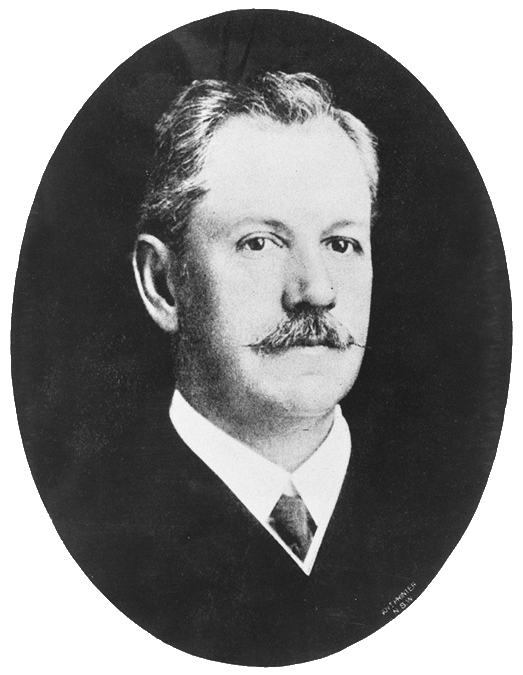
Sir Carruthers circa 1904.
He died on 10 December 1932 at Waverley, survived by his wife, three sons and four daughters. He was buried in South Head cemetery after a funeral service at All Saints Anglican Church, Woollahra. His estate was valued for probate at £19,490. This Obituary ran in a Queensland newspaper:
Sir Joseph Carruthers.
SYDNEY, December 11.
After a long illness Sir Joseph Carruthers, scholar and statesman, and former Premier of New South Wales, died on Saturday morning, at the age of 75 years.
The late Sir Joseph Carruthers was born at Kiama, in 1857, and was educated at the Goulburn High School and the Sydney University. Graduating with honours from the University, he entered the legal profession in 1878. At the same time he took part in politics as a Liberal member of the New South Wales Legislative Assembly, and in 1889 was made Minister for Education. Going out of office two years later, he returned as Minister for Lands in 1894, when New South Wales was beginning to recover from a severe financial crisis, m which several banks stopped payment. Aft;r he had served for a few months ns Colonial Treasurer In 1899 his Gov-ernment was defeated, and he became Leader of the Opposition. Returned 'o power again in 1904, he was Premier and State Treasurer until 1907. A year later he was made a life member of the legislative Council, and was Knighted. From 1922 to 1925 he was Vice-President of the Executive Council.
Sir Joseph is survived by Lady Carruthers and the following family: Mrs. Kenneth M'Intyre, Miss Alice Carruthers (Sydney), Mrs. Paul Hirst (St. Helens, Tasmania), Miss Peg. Carruthers (Sydney), Mr. Joseph Burnet Carruthers, Dr. Douglas Gordon Carruthers, and Mr. Wallace Alexander Carruthers (Sydney). Sir Joseph Carruthers. (1932, December 12). The Brisbane Courier (Qld. : 1864 - 1933), p. 13. Retrieved from http://nla.gov.au/nla.news-article22031198
